Early Los Angeles Historical Buildings (1800s)
Historical Photos of Early Los Angeles |
.jpg) |
|
| (1886)* - Exterior view of Ralphs Bros. Grocers, located on the southwest corner of 6th and Spring Streets in 1886. A horse-and-carriage is parked in the unpaved street. |
Historical Notes This was known as "Georgetown Corner." The photo was taken shortly after this two-story brick building was built. Next door on Spring Street is the New York Bakery. George A. Ralphs is leaning on a stack of boxes, and Walter B. Ralphs is in shirt sleeves (He died in 1954 at age 99). The original address of Ralphs was 501-503 South Spring, with New York Bakery at 505. Under the new street numbering system adopted about 1890, the address for Ralphs changed to 601-603, and for the Bakery 605 South Spring. Later the Hayward Hotel was built in this location. |
* * * * * |
Bellevue Terrace Hotel
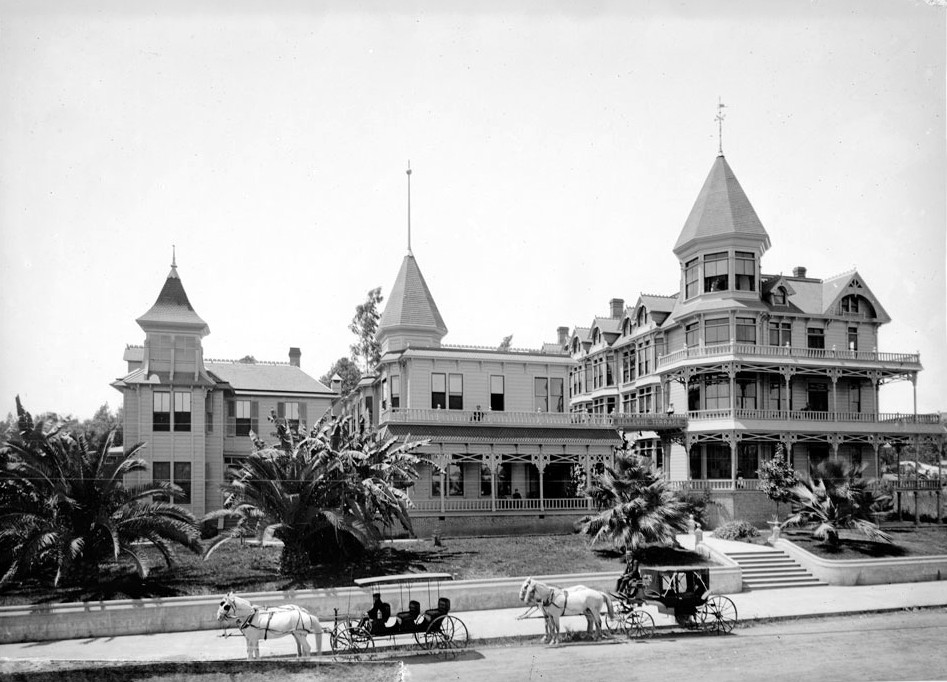 |
|
| (ca. 1890)* - Bellevue Terrace Hotel on the northwest corner of Figueroa and 6th Streets. Two horse-drawn carriages are stopped at the curb. The site is now occupied by the Jonathan Club. |
Historical Notes Built in 1884 on what was then the northwest corner of Pearl Street and Bellevue Terrace (renamed Figueroa and 6th in 1897), the Bellevue Terrace Hotel quickly became one of Los Angeles’ premier Victorian-era hotels. In 1892, Edward L. Doheny and his family stayed here; while watching fuel-laden wagons pass by, Doheny conceived the idea to drill for oil—an insight that sparked Southern California’s oil boom. The hotel remained in operation until the early 1920s, when it was demolished to make way for the Jonathan Club. |
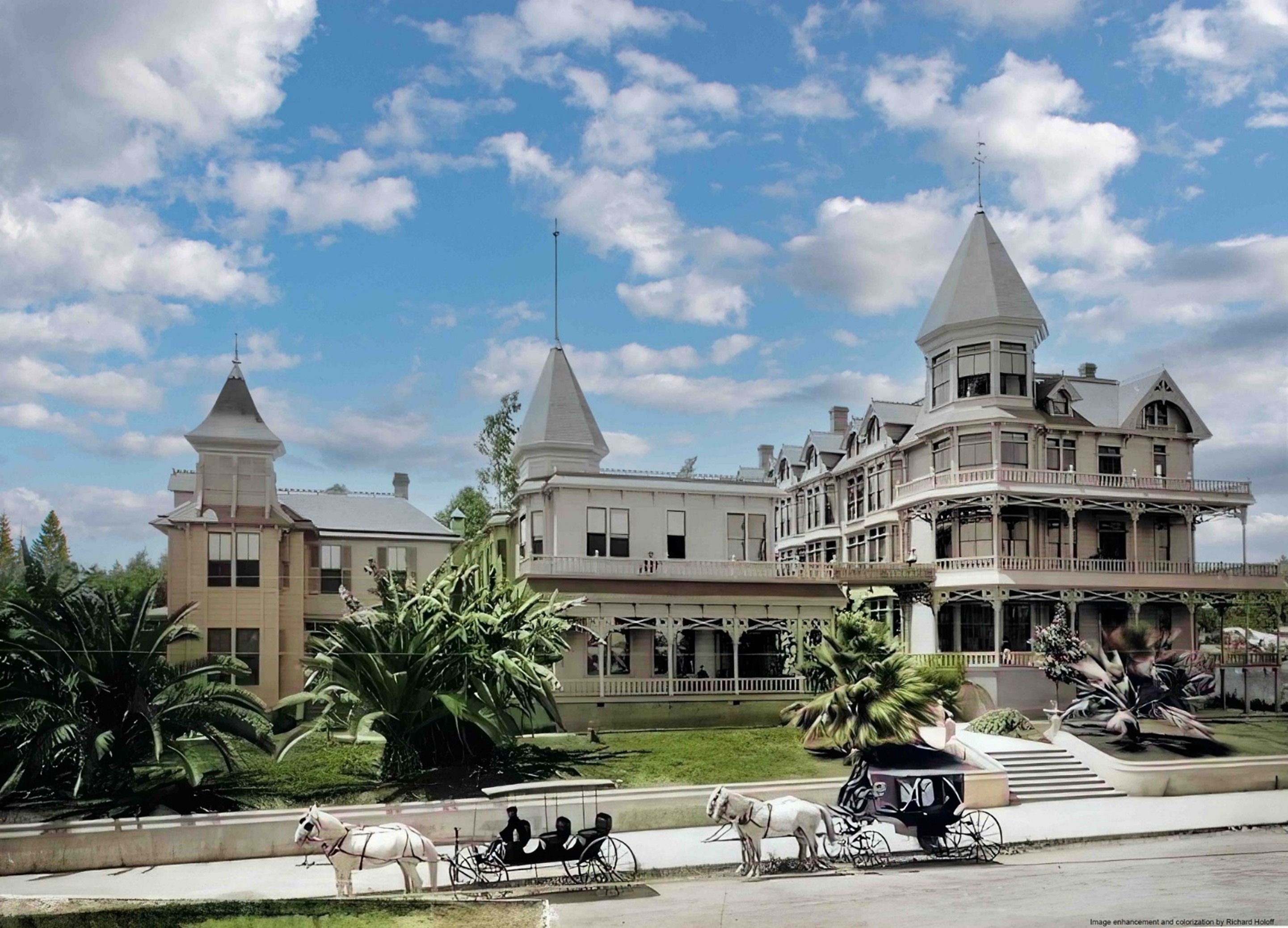 |
|
| (ca. 1890)* - Colorized view of the Bellevue Terrace Hotel at the northwest corner of Figueroa and 6th Streets. The ornate Victorian architecture, including turrets and wraparound verandas, reflected the elegance of the era. Image enhancement and colorization by Richard Holoff. |
Historical Notes Located on what was originally Pearl Street and Bellevue Terrace, the hotel catered to affluent visitors and served as a fashionable social hub in late-19th-century Los Angeles. Its prime location along a major streetcar route and its lush landscaping made it a popular subject for photographers and illustrators. |
 |
|
| (1890)* - Looking south toward the Bellevue Terrace Hotel on the northwest corner of Figueroa and 6th Streets. A boy sits on the steps leading to the entrance. Photo by C. C. Pierce. |
Historical Notes In the 1890s, this intersection was still in transition from a mixed residential-hospitality area to a fully urbanized commercial zone. The paved sidewalk along the front contrasts with the still-unpaved side street—reflecting the gradual modernization of downtown Los Angeles. At the time, the streets were known as Pearl and Bellevue Terrace. |
 |
|
| (ca. 1890)* - Bellevue Terrace Hotel on the northwest corner of Figueroa and what would later be named 6th Street. Young trees partially obscure the lower floors; the sidewalk is paved only along the front, while the side street is unpaved and lined with hitching posts. |
Historical Notes This photograph captures a moment when Los Angeles’s central district still had rural elements. The hotel’s corner location at Pearl and Bellevue Terrace (later Figueroa and 6th) gave it both prominence and easy access for travelers arriving from the west. |
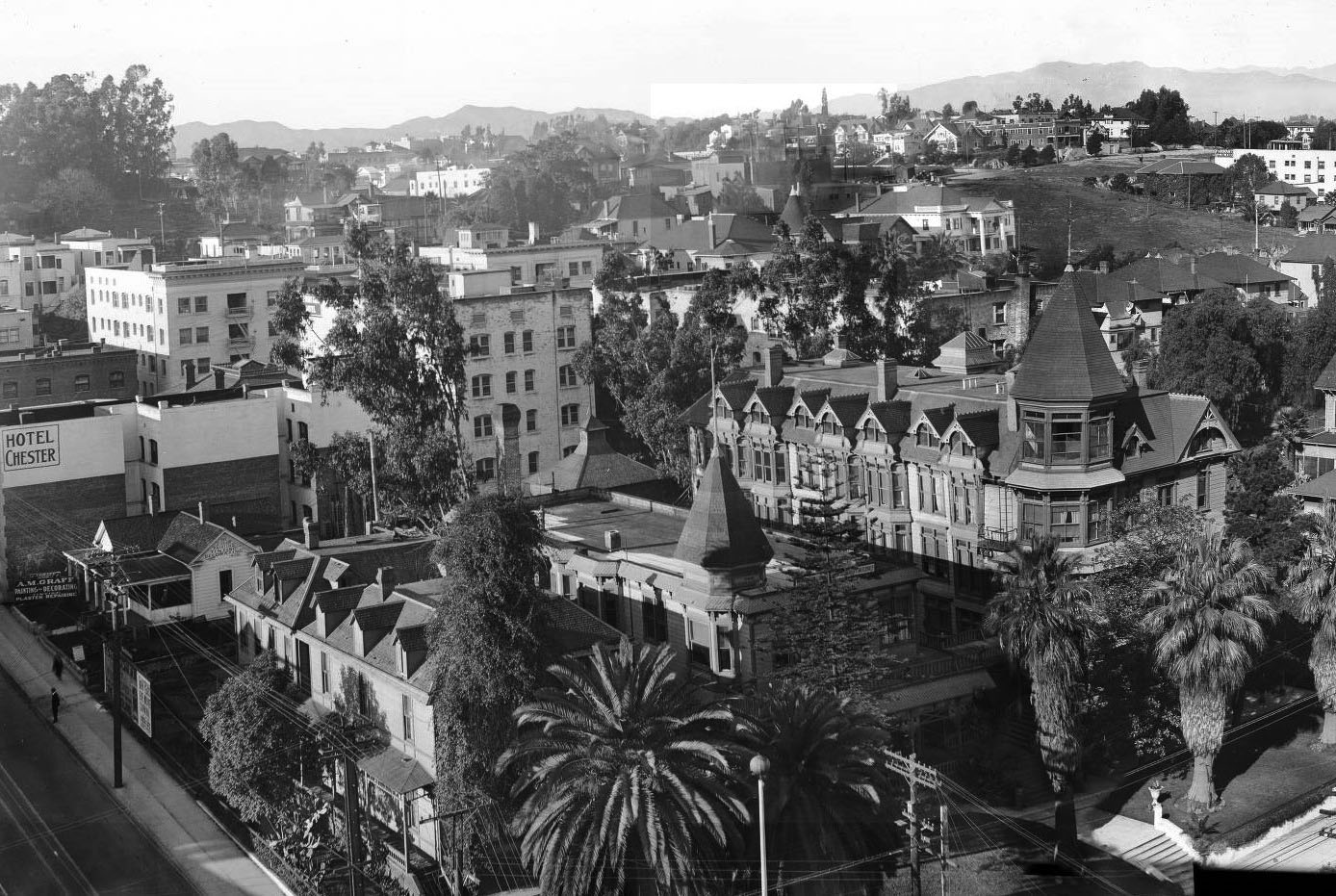 |
|
| (ca. 1916)* – Closer view of the Bellevue Terrace Hotel with 6th Street seen at lower left. |
Historical Notes In 1924, the Jonathan Club would be built on the NW corner of Figueroa and Sixth streets, where the Bellevue Terrace Hotel stood since circa 1890. |
 |
|
| (2024)* - The Jonathan Club, built in 1925, now occupies the northwest corner of Figueroa and 6th Streets, the former site of the Bellevue Terrace Hotel. |
Historical Notes Designed by Charles F. Whittlesey in the Renaissance Revival style, the Jonathan Club has served as a private social club on this site for nearly a century. It directly replaced the Bellevue Terrace Hotel, making this corner home to only two major buildings in over 140 years. |
Then and Now
 |
|
| (1890 vs. 2024)* - The northwest corner of Figueroa and 6th Streets, shown in 1890 with the Bellevue Terrace Hotel and in 2024 with the Jonathan Club. Photo comparison by Jack Feldman. |
Historical Notes From the Victorian elegance of the Bellevue Terrace Hotel to the enduring presence of the Jonathan Club, this corner’s history reflects downtown Los Angeles’s transformation—while remarkably maintaining continuous use as a prominent hospitality and social site. |
* * * * * |
Boston Dry Goods Store
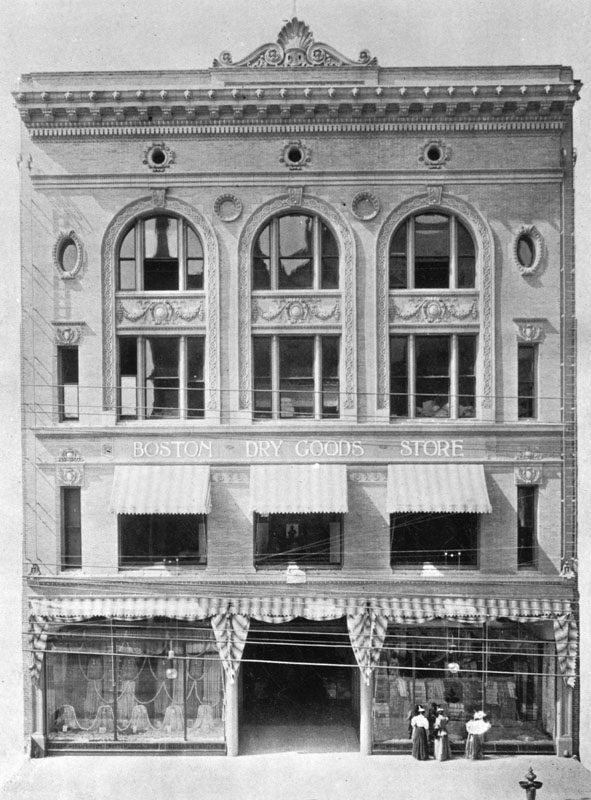 |
|
| (1880s)* - View of the front of the Boston Dry Goods Store. Three women are window-shopping in front of the large display window. The Boston Store was first started at Spring and Temple Street in 1883 by J.W. Robinson. |
Historical Notes The “Boston Dry Goods Store” began business in February of 1883 at the corner of N. Spring and Temple Streets. Joseph Winchester Robinson advertised that his establishment was characterized by “fine stocks and refined ‘Boston’ service.” The arrival of railroads spurred the enormous and long-lived growth of Southern California, and Robinson’s store brought eastern goods and their attendant sophistication to a willing (and growing) public; in 1887 the store was forced to move to larger quarters at 69-73 N. Spring Street. After returning from a trip back east in 1891, Robinson became ill and passed away in his home at the age of 45. His father, H.W. Robinson came to Los Angeles for the funeral and to look after the business founded by his late son. Remaining under family control, the store was renamed J.W. Robinson Co. (but continued to trade as the “Boston Dry Goods Store” until after the turn of the century) and moved in 1896 to 239 S. Broadway, “opposite City Hall.” In the early days of the twentieth century, the Los Angeles area grew and grew, especially with the arrival of the film industry. The store, which “catered to the most exclusive trade” according to the Los Angeles Times in 1911, expanded into adjacent properties, but it became apparent to management that the South Broadway location could not handle the store’s growth into the future. Accordingly, land was acquired along Seventh Street between Grand and Hope streets where a new store was built in 1915.^#* |
* * * * * |
H. Newmark & Co. Building
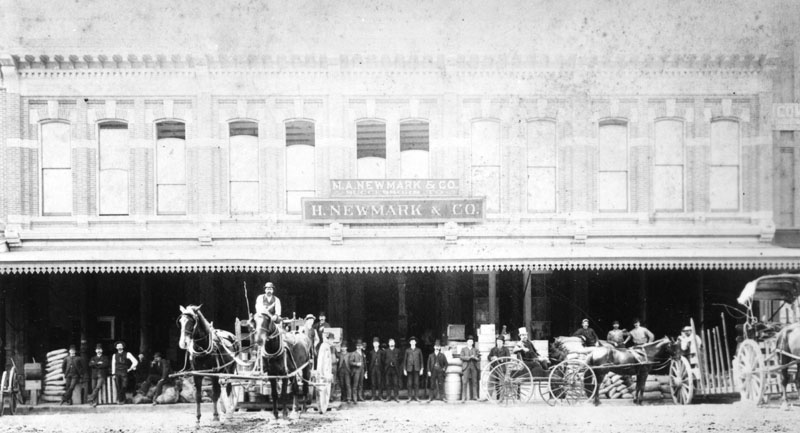 |
|
| (1886)* - People, horses and buggies lined up in front of H. Newmark & Co. in the Amestoy Block in 1886. |
Historical Notes Harris Newmark emigrated to the United States in 1853 from Löbau in Province of Saxony (now Saxony, in eastern Germany) and settled in Los Angeles. After working in partnership with his brother, he eventually established his own wholesale grocery business, H. Newmark and Company, in 1865, with headquarters on Spring Street. He went on to invest in real estate, holding large tracts in the San Gabriel Valley. In 1875 he sold eight thousand acres of what was then the Santa Anita Rancho to rancher E.J. “Lucky” Baldwin. In May 1899, Newmark subdivided the tract (approx. 15,000 acres) owned by himself and his nephew, after contracting with William Mulholland to design and construct a suitable water system for the new settlement. A piece of this tract adjacent to the tracks of the San Pedro, Los Angeles & Salt Lake Railroad was developed into a town site called Newmark. The remaining land was subdivided into 5-acre lots suitable for small-scale agriculture. The entire settlement, including the Newmark town site, was given the name Montebello. When the town incorporated in 1920, Montebello replaced Newmark as the new city's name. Newmark was one of the founders of the Los Angeles Public Library, was a charter member of the Los Angeles Chamber of Commerce, and was one of the organizers of the Board of Trade, which helped bring railroad service to California. He was the president of Congregation B'nai B'rith in 1887 (he inherited the title from his uncle and father-in-law Joseph Newmark) and a founder of the Jewish Orphans Home. Newmark was also instrumental in the establishment of the Southwest Museum, which is now part of the Autry National Center. He and other Newmarks were leaders of the local Odd Fellows and were Masons.^* |
* * * * * |
Nadeau Hotel
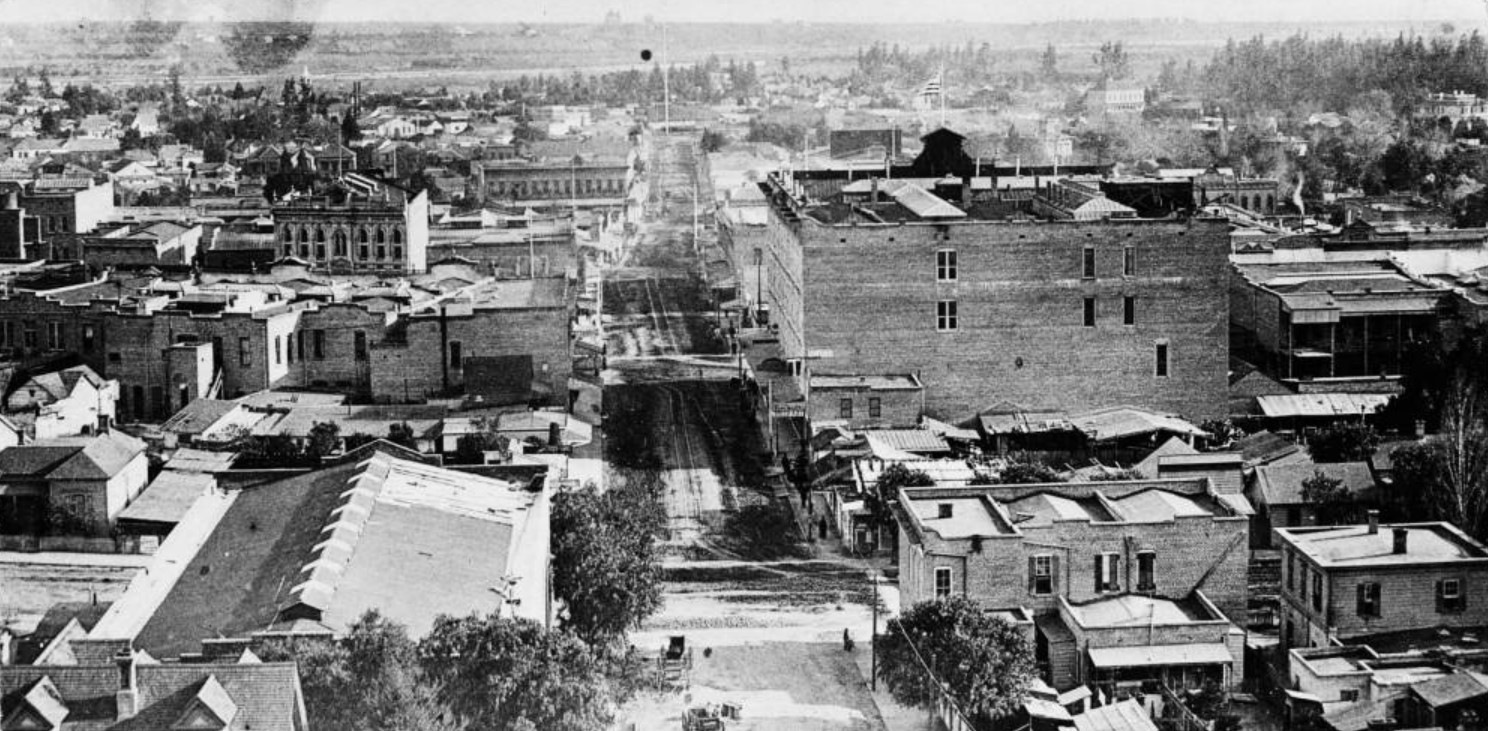 |
|
| (1884)^^* - Panoramic view looking east on First Street from Hill Street, showing the 4-story Nadeau Hotel located on the southwest corner of First and Spring streets. |
Historical Notes Remi Nadeau was a French Canadian pioneer who arrived in Los Angeles in 1861 driving a team of oxen. During the silver-mining excitement in the Cerro Gordo region of Inyo County his teamster operation brought tons of silver to Southern California and hauled back food and supplies to the miners. By 1873 he operated 80 such teams. In 1882, Remi Nadeau built the Nadeau Hotel on the corner of 1st and Spring streets. It was Los Angeles's first four-story structure and the first building with an elevator. The hotel was designed by Morgan & Walls.**## |
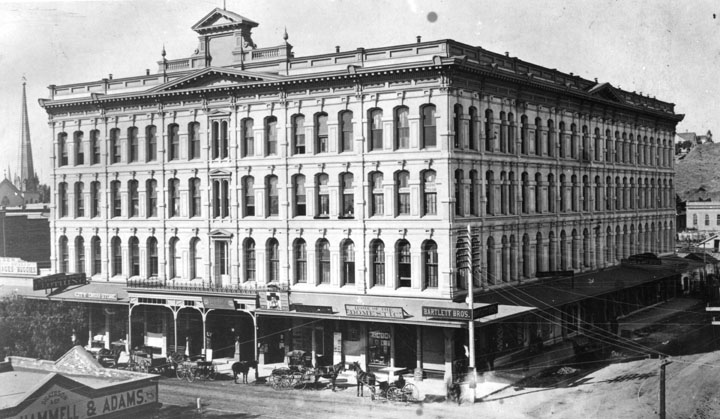 |
|
| (1886)* - View of the Nadeau Hotel on the southwest corner of Spring and 1st streets. A row of horses & carriages is lined up on the street in front. A tall narrow church spire can be seen in the background on the far left. |
Historical Notes Remi Nadeau opened the hotel in 1882 with a grand ball attended by the Southland's elite. He bought the site in 1872 for the 'un-heard' of sum of $20,000. The Nadeau boasted of the first electric elevator to be installed in Los Angeles. Some of the guests at the hotel have included: Anna Held, General Nelson A. Miles, Lillian Russell, and John L. Sullivan (one-time heavyweight champion.^^* |
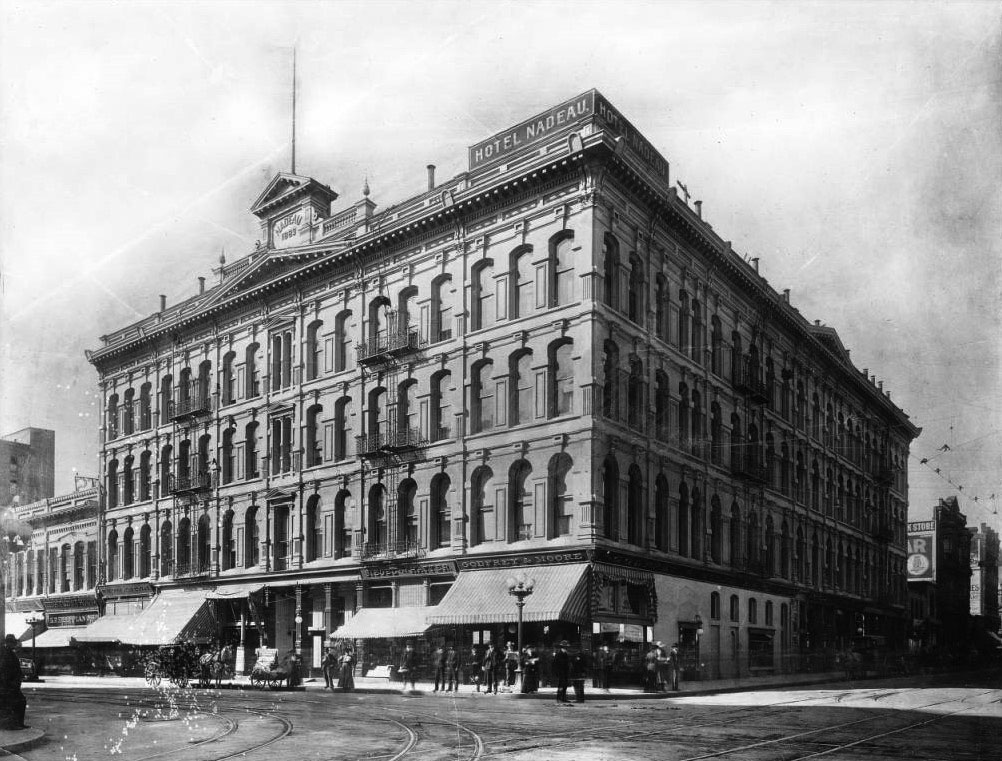 |
|
| (ca. 1905)^^* - View showing the Nadeau Hotel on the southwest corner of Spring Street and First Street. The four-story hotel features arched windows all throughout the building on the second floor and up. In the center of the building facing the street on the left are small decorative pediments above each floor from the second floor and up. At the top, above all the other small pediments, is a larger and wider pediment. Further above it is yet another pediment where underneath it displays "Nadeau 1883." The first floor consists mostly of shops. Some stores have striped cloth awnings covering their window fronts. At the corner of the hotel, on top of the roof, is a corner sign that reads "Hotel Nadeua." |
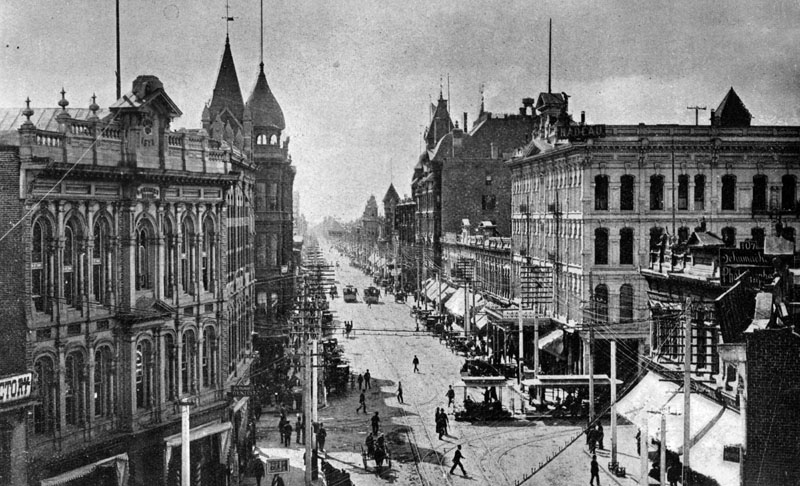 |
|
| (1889)* - View looking south on Spring Street at 1st. Pacific Railway Company’s new streetcars are now seen on the road. The 4-story Nadeau Hotel stands on the southwest corner of Spring and 1st behind the streetcar. |
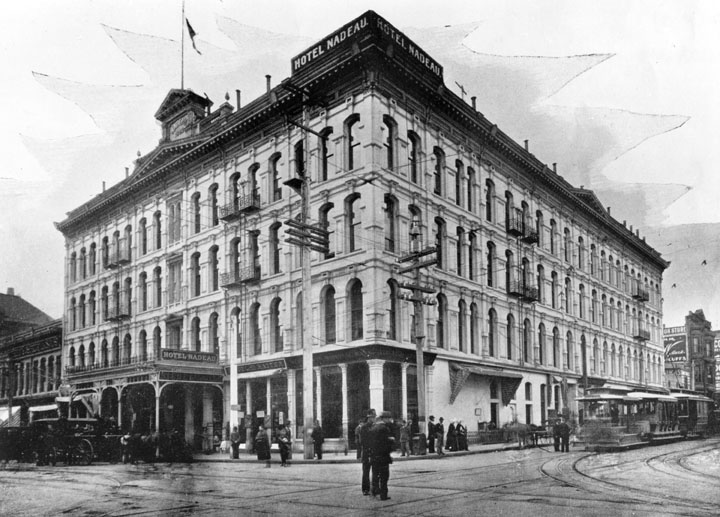 |
|
| (1897)* - The Hotel Nadeau, showing the entire corner at 1st and Spring Streets, the present site of the Los Angeles Times. The hotel was built in 1882 as the first 4-story building in L.A. A paved street now visible. Horses, carriages, cars and trolleys, along with people are now visible. A sign giving the name of the hotel sets on the corner of the roof. The hotel advertises that it is heated by F.E. Brown's hot air furnace, and testimonials are available. Architects, Morgan & Walls. |
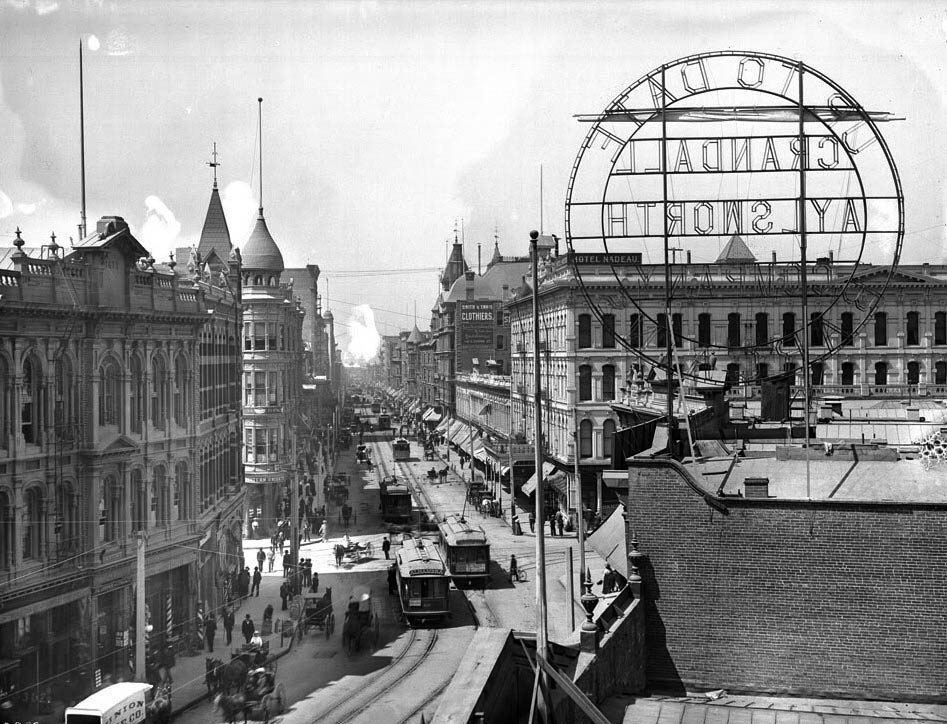 |
|
| (ca. 1904)^^* - Intersection of Spring Street and First Street looking south. The Nadeau Hotel is visible at right behind the large circular sign that reads: "Up to date bargains, Crandall Aylsworth Company". |
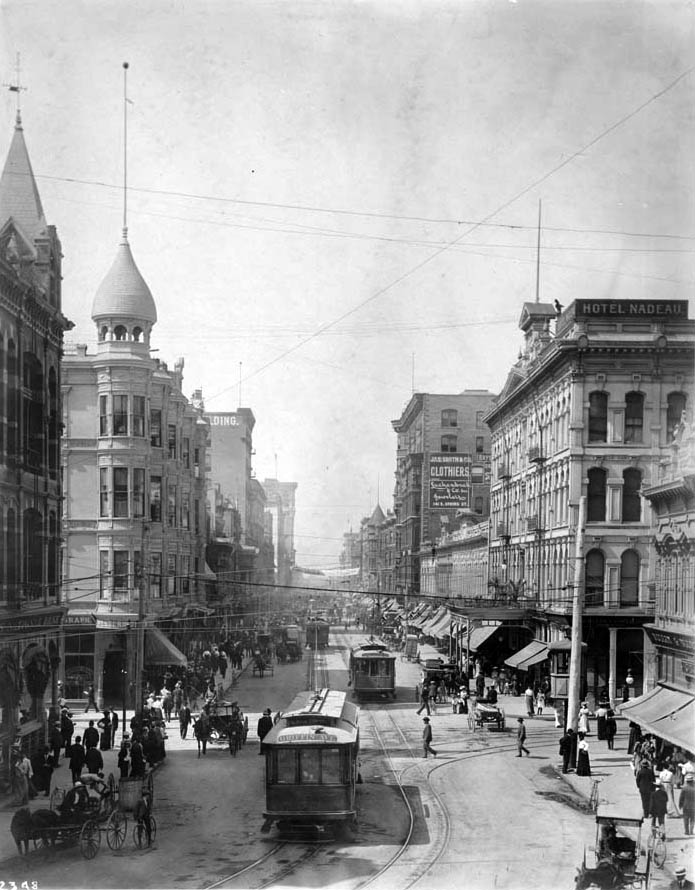 |
|
| (ca. 1905)* - View of Spring Street at 1st, looking south. The Nadeau Hotel appears on the right on the southwest corner of Spring and 1st streets. Spring St. was then the center of the city's financial activities. Electric cable cars share the street with horse-drawn wagons. |
Historical Notes The Nadeau Hotel stood on the southwest corner of 1st and Spring Streets until 1932, when it was demolished to make room for the current Los Angeles Times Building. |
* * * * * |
Central Saloon
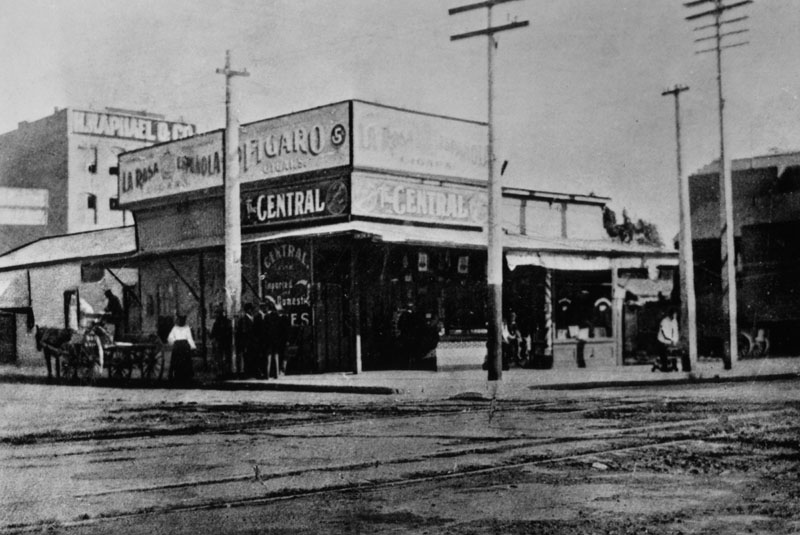 |
|
| (1886)* - An early picture of the southeast corner of Spring and 5th St. when the building was occupied by Central Saloon. |
* * * * * |
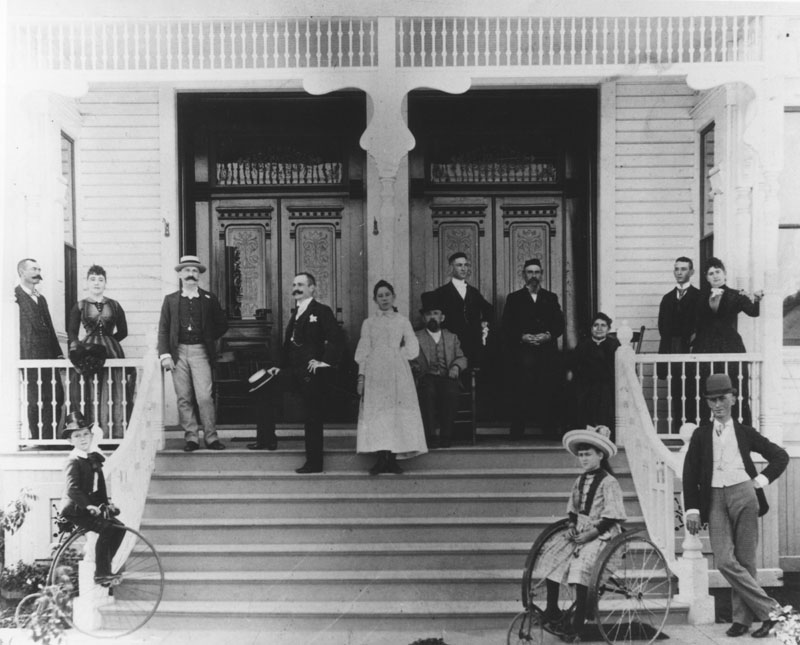 |
|
| (ca. 1886)* - Family in front of home circa 1886. Note the two styles of bicycles used by the children. |
* * * * * |
Los Angeles Times Building – 1st Location (Temple & New High, 1881–1886)
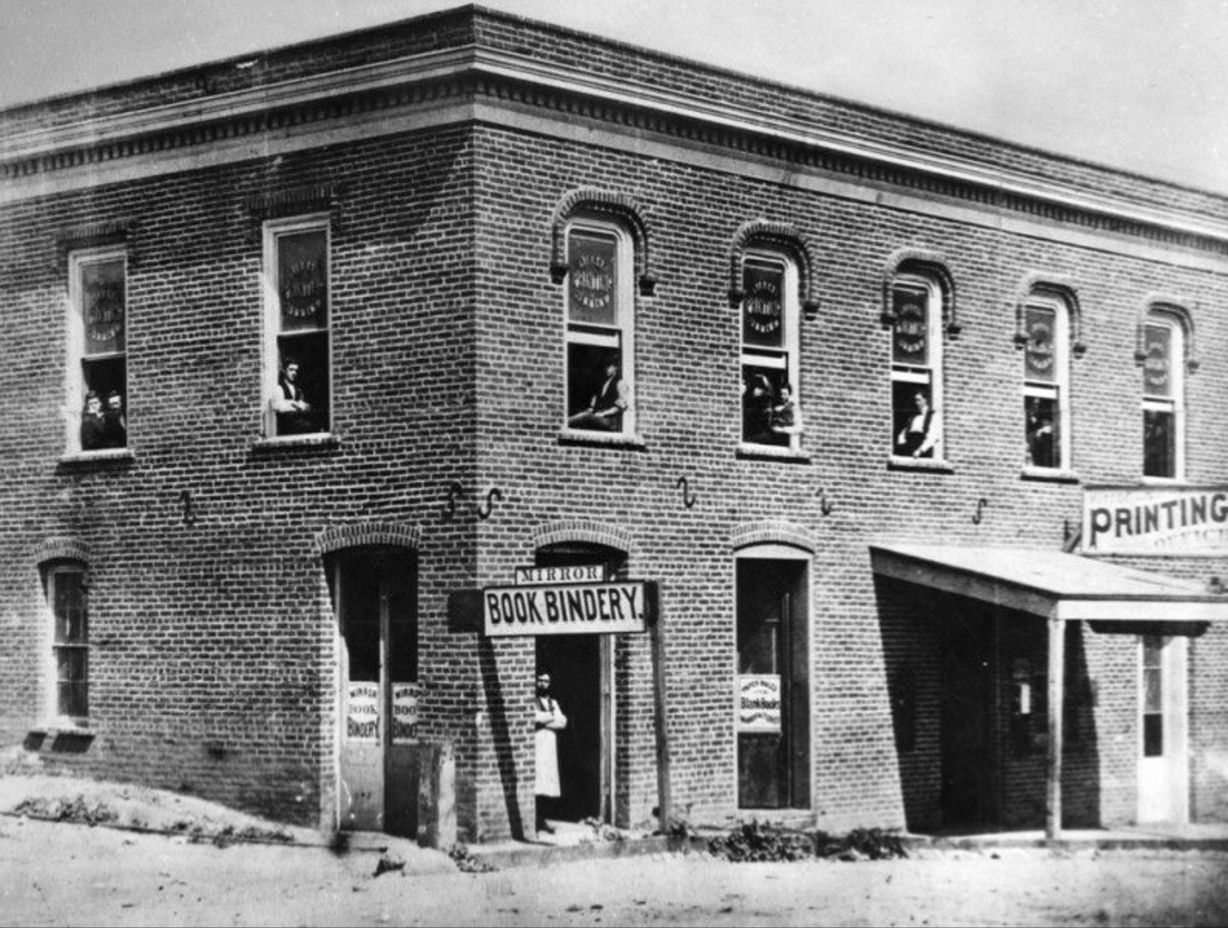 |
|
| (ca. 1885)* – The first home of the Los Angeles Times was a modest brick building at Temple and New High Streets, where the paper operated from 1881 to 1886 before moving to 1st and Broadway. |
Historical Notes The Los Angeles Times began on December 4, 1881 as the Los Angeles Daily Times. Its first office was a small brick structure at Temple and New High Streets, near today’s Civic Center. Early publishers Nathan Cole Jr. and Thomas Gardiner struggled financially, relying on borrowed presses at the Mirror Company. In 1882, Harrison Gray Otis became editor. A Civil War veteran and staunch Republican, Otis gave the paper its conservative, pro-business voice, promoting real estate development, boosterism, and civic growth. This first building was modest and unremarkable, yet it was here that the Times began its transformation into a powerhouse of influence. By 1886, the paper had outgrown its quarters and moved to a new home at 1st and Broadway. |
* * * * * |
Los Angeles Times Building – 2nd Location (1st & Broadway, 1886–1910)
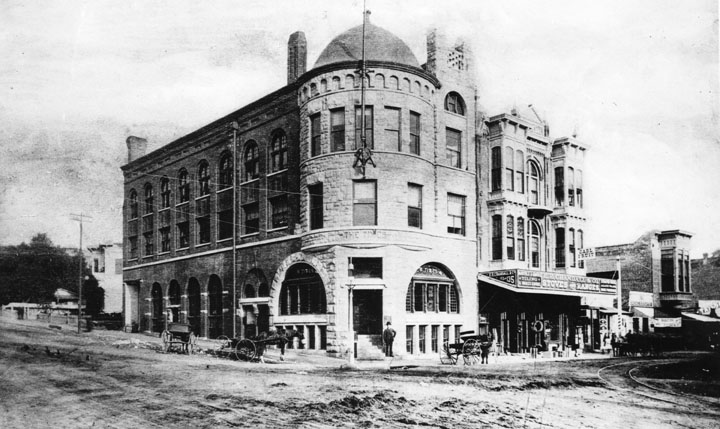 |
|
| (ca. 1887)* – Exterior view of the Los Angeles Times Building on the northeast corner of 1st and Broadway. The building next door, at right, briefly housed the Los Angeles Chamber of Commerce (1889–1890). |
Historical Notes Completed in 1886/87, this Romanesque Revival landmark—nicknamed “The Fortress”—projected permanence and authority. Its brick and granite facade reflected the Times’ growing influence under Otis. The Chamber of Commerce next door illustrates how the paper was at the center of the city’s booming business community during the land rush of the 1880s. Horse-drawn wagons and pedestrians on the dirt road highlight a city still on the edge of modernization. |
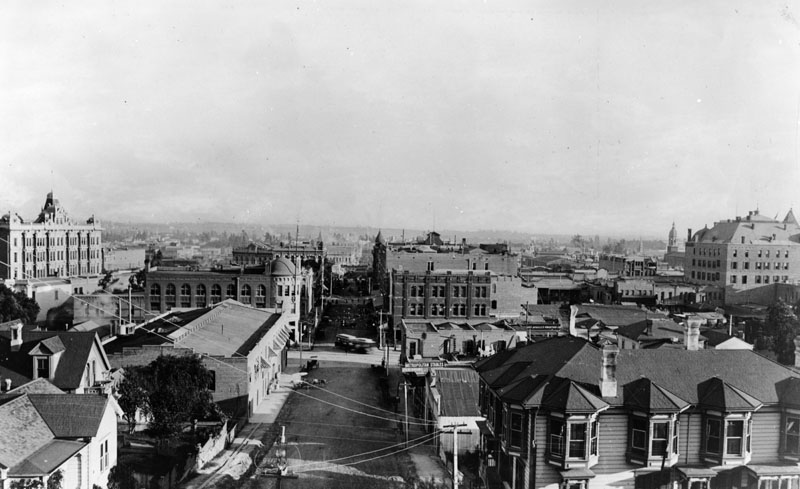 |
|
| (ca. 1888)* - Panoramic view looking east on an unpaved 1st Street from near Hill Street. The Times Building anchors the center on the northeast corner of 1st and Broadway. |
Historical Notes This wide view captures Los Angeles in transition—dirt roads, scattered trees, and low-rise structures alongside ambitious civic buildings. The Times Building stood as a modern symbol for a city whose population had surged with the arrival of the railroads. Under Otis, the paper promoted Los Angeles as a place of opportunity, fueling migration and investment that soon transformed these dusty streets into paved boulevards. |
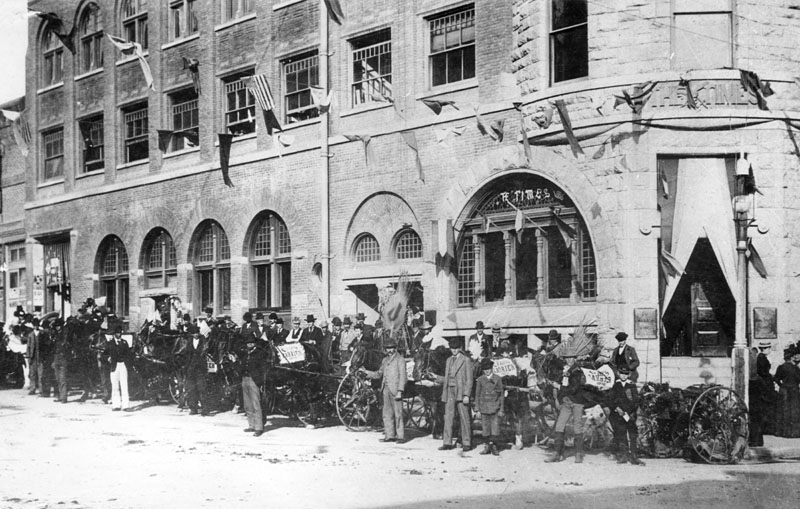 |
|
| (ca. 1887)* - Young carriers of the Los Angeles Times gathered outside the building on 1st and Broadway. |
Historical Notes Here, newsboys—the lifeblood of circulation—pose proudly with their bundles. They would hawk headlines on street corners or deliver by bicycle, making the paper visible in every neighborhood. Behind them looms the Times Building, fortress-like and imposing. These boys were the face of the paper on the street, shouting Otis’ bold editorials that promoted growth but antagonized organized labor. |
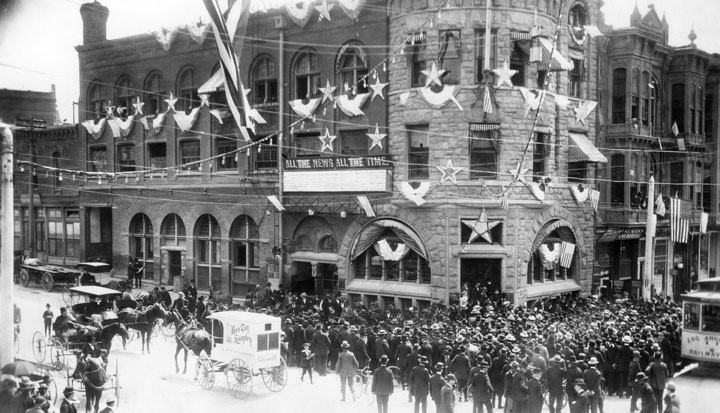 |
|
| (1890s)* - The Times Building decorated with flags and bunting; a large crowd is gathered at the entrance. Wagons and a streetcar pass by. |
Historical Notes Patriotic displays like this were common for holidays or civic rallies. The flags and bunting underscored the Times’ role as both a news outlet and a booster of civic pride. By the 1890s, electric streetcars were joining horse-drawn wagons on Broadway, showing the city’s modernization. Inside, Otis’ editorials pushed a strong anti-union line, aligning with the city’s business elite and cementing Los Angeles’ reputation as an “open-shop” town. |
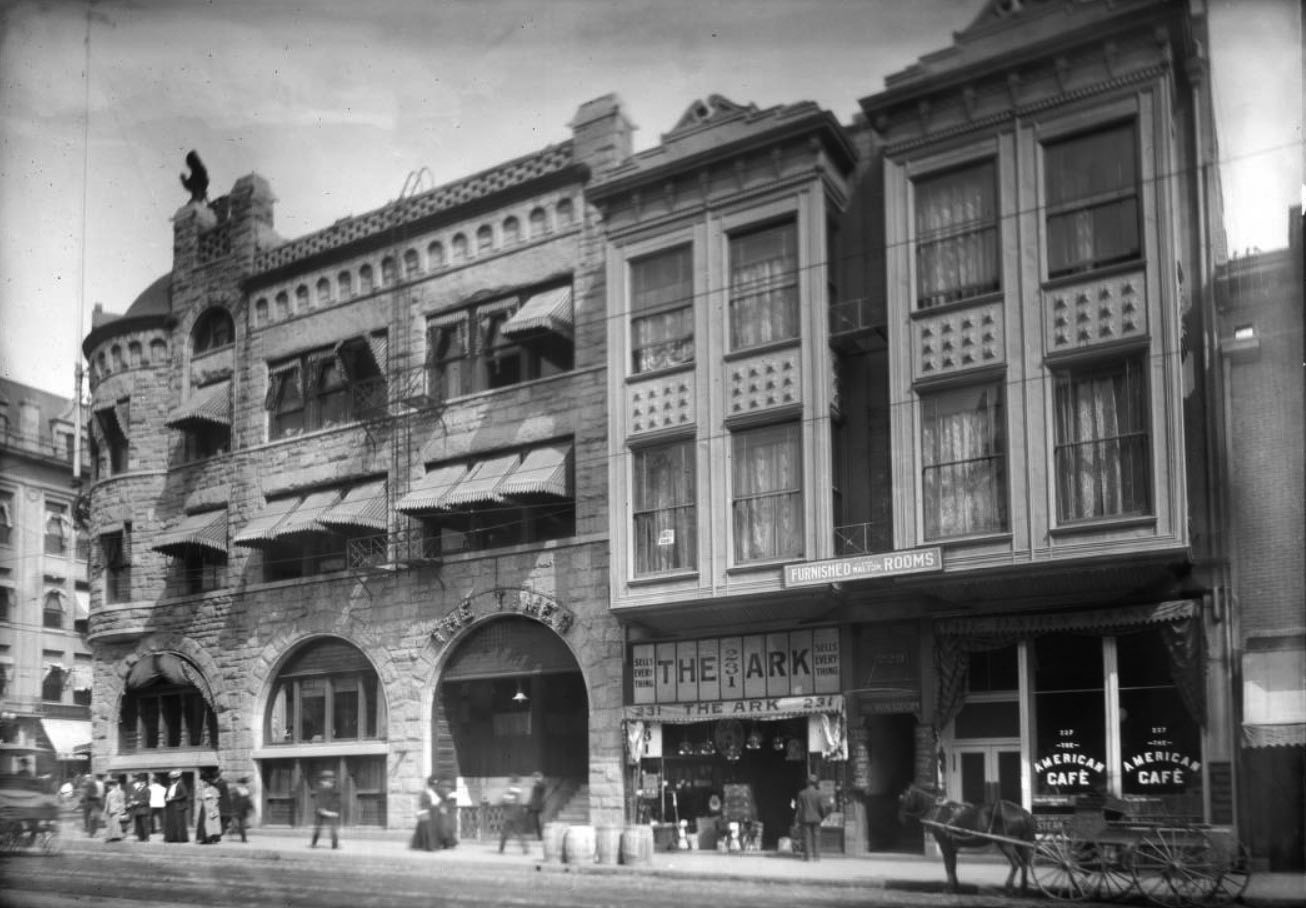 |
|
| (ca. 1905)* - North side of 1st Street with the three-story Times Building. Signs for “Furnished Rooms,” “The Ark,” and “The American Café” are visible next door. |
Historical Notes This image shows the Times surrounded by everyday businesses—boarding houses, shops, and cafes—reflecting Broadway’s bustling mix of commerce and daily life. The paper had become a fixture of the block. By now, the Times had expanded with a new wing designed by architect John Krempel (1903). Yet the city’s growing labor tensions made the building’s nickname, “The Fortress,” feel ominous: conflict with unions was escalating toward tragedy. |
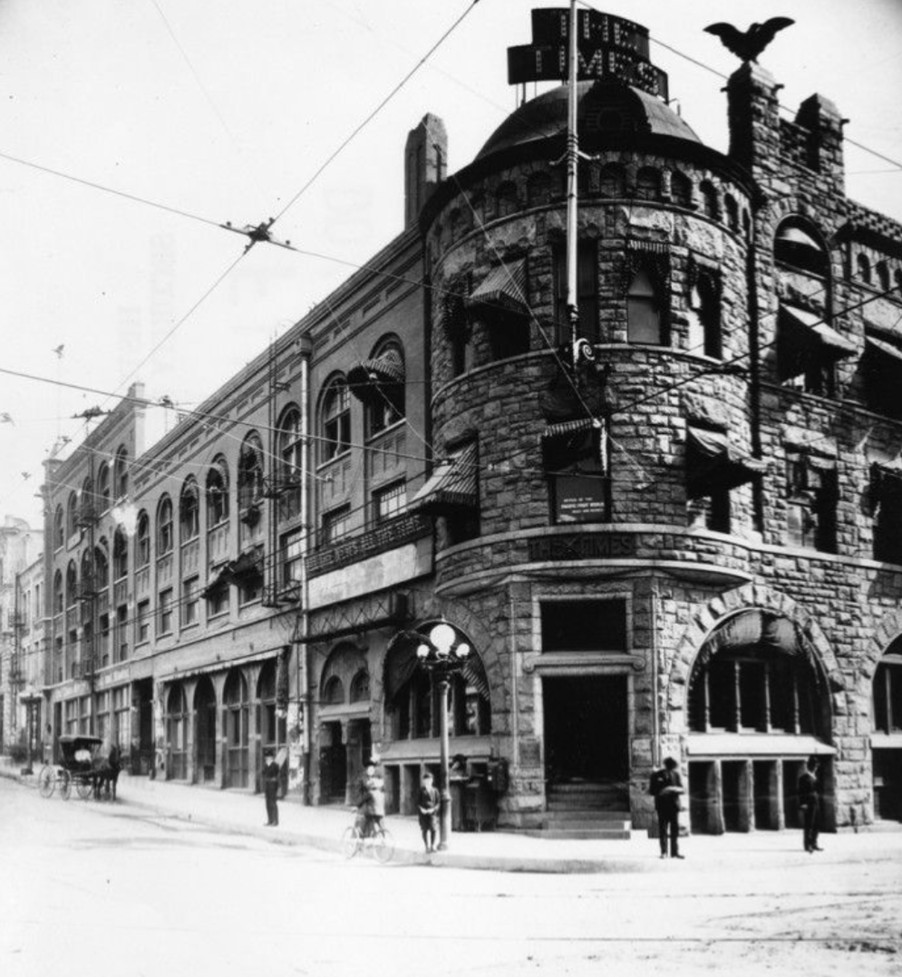 |
|
| (ca. 1905)* - The Times’ second home at 1st and Broadway, where it had operated since 1886, shown before its destruction in 1910. The first Times office had been at Temple and New High. |
Historical Notes This view captures the building at its height, with ornate detailing and a solid presence. Inside, massive presses printed thousands of papers daily. On the outside, however, union resentment of the paper’s fierce anti-labor stance was mounting. Within a few years, this proud structure would be the target of the most infamous act of labor violence in U.S. history. |
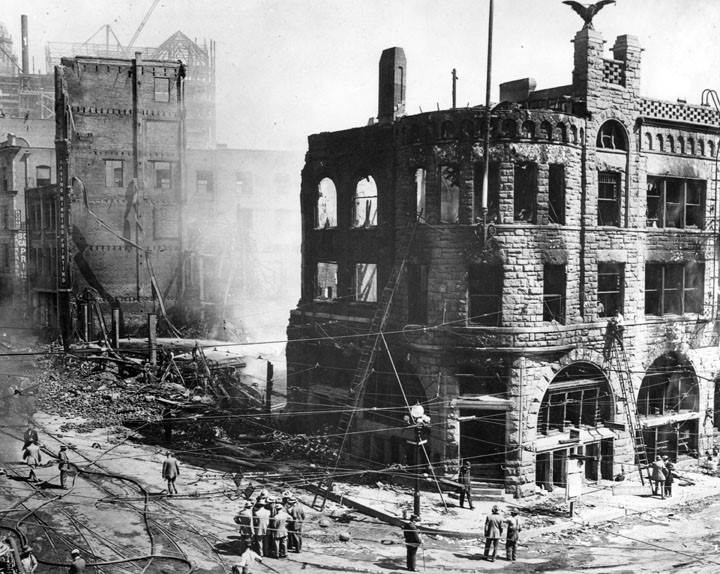 |
|
| (1910)* - Ruins of the Los Angeles Times Building after the October 1 bombing. |
Historical Notes At 1:07 a.m., a bomb exploded in “Ink Alley” behind the Times Building. The blast triggered gas and ink fires, collapsing walls and floors. Twenty-one workers were killed, many trapped in the flames. The attack, carried out by union brothers James B. and John J. McNamara, was condemned as the “crime of the century.” The devastation symbolized the bitter divide between labor and business in early Los Angeles. |
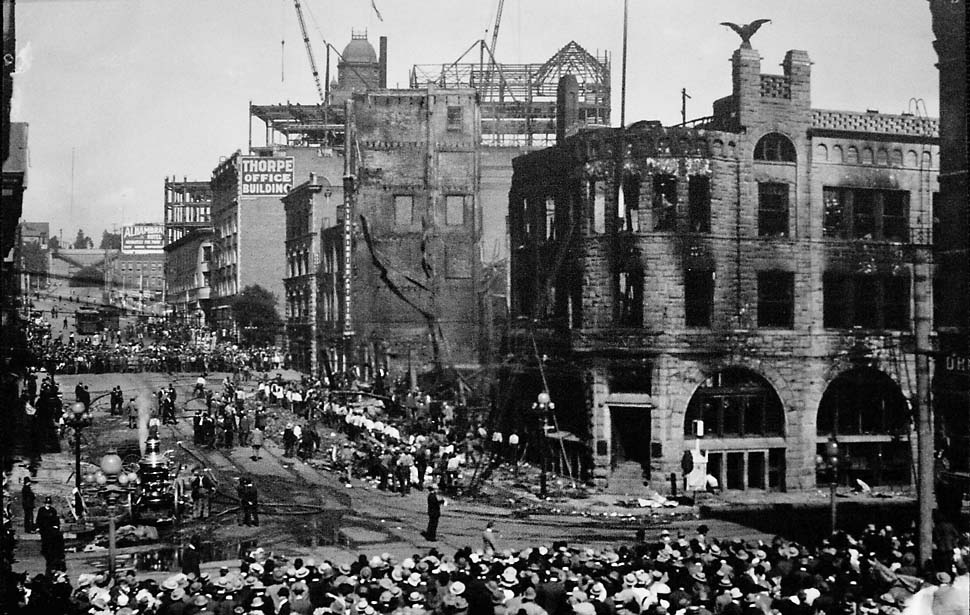 |
|
| (1910)* - Panoramic view showing the aftermath of the bombing. |
Historical Notes This sweeping image reveals the full scale of the destruction. Smoke still lingers as crowds gather around the ruins. The case drew national attention: famed attorney Clarence Darrow, representing labor, arranged a plea deal—James McNamara received life, John got 15 years. The Times vowed to rebuild, framing the attack as proof of its mission to stand against union militancy. |
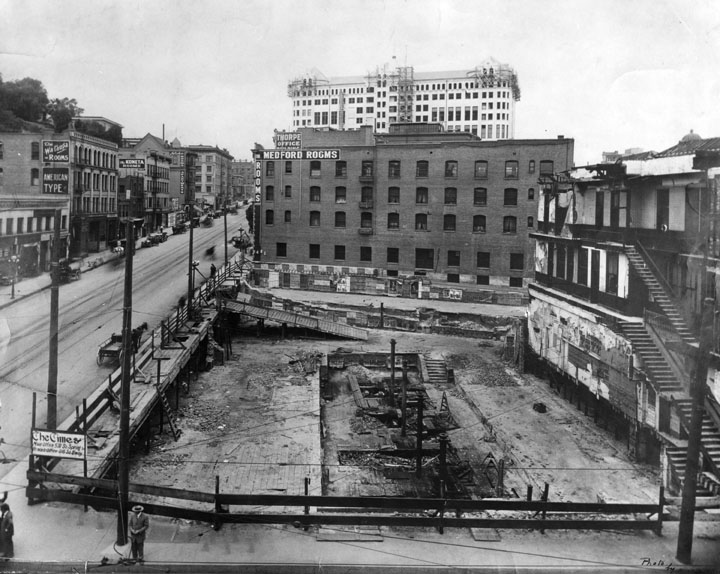 |
|
| (ca. 1911)* - Cleared site at the northeast corner of 1st and Broadway after the bombing. |
Historical Notes The lot where “The Fortress” once stood was quickly cleared. On the bombing’s first anniversary in October 1911, the Times laid a cornerstone for a new building on the same site. This third Times Building, with its castle-like tower, opened in 1912 and stood until the 1930s. The cleared site shown here marked both a literal and symbolic end to an era. |
Then and Now
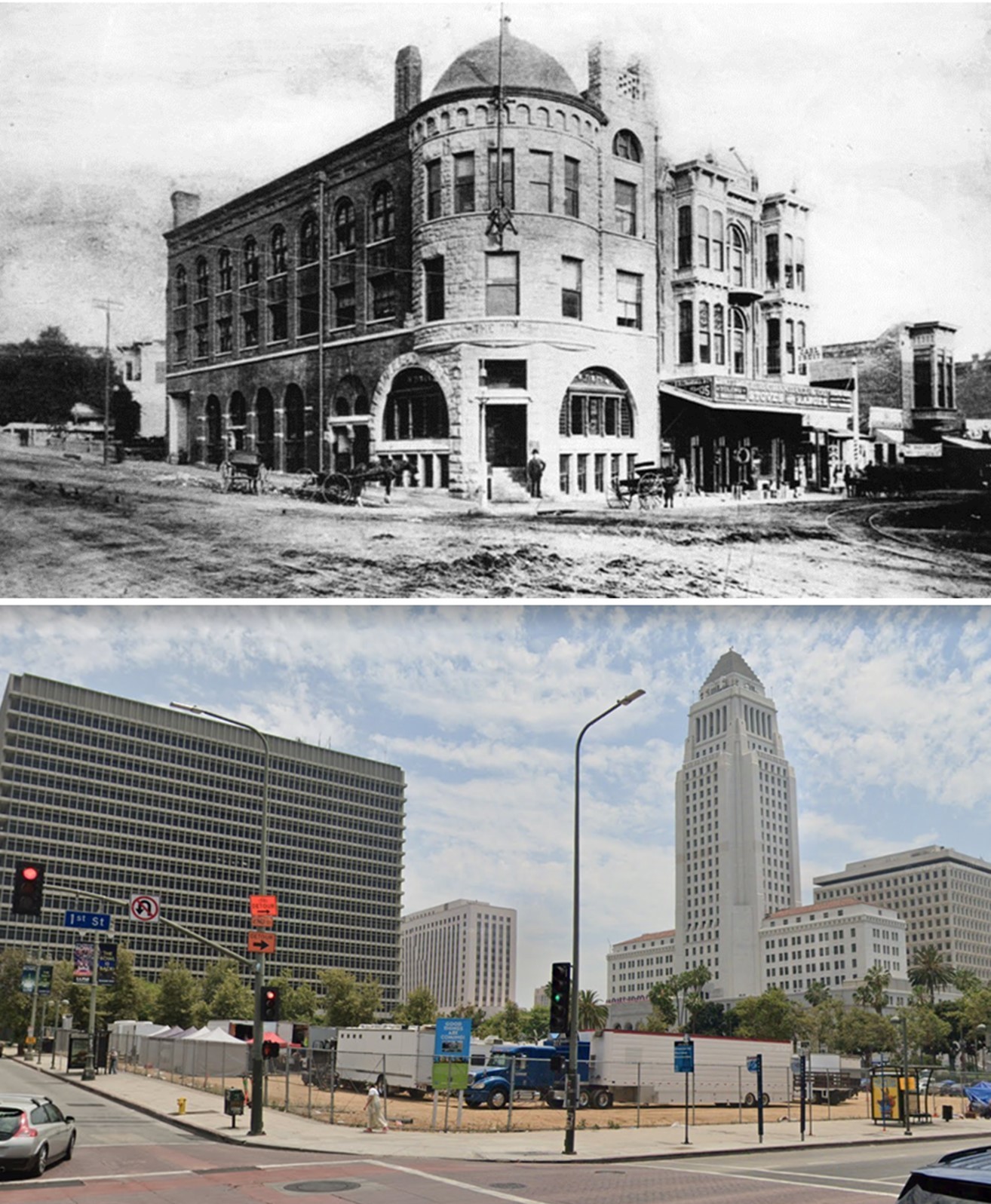 |
|
| (1887 vs 2021)* – Looking at the northeast corner of Broadway and 1st Street. Once the site of the ornate second Times Building, today it remains an empty lot. Photo comparison by Jack Feldman. |
Historical Notes The contrast is striking: the bustling 1887 street scene—with its carriages and landmark architecture—versus today’s vacant parcel. After the bombing, two successive Times buildings rose here, but by the late 20th century the site was cleared again. Long proposed as the “First & Broadway Civic Center Park,” it remains empty as of 2024, a quiet reminder of the explosive history that once shook Los Angeles. |
* * * * * |
LA Times Building (3rd Building, 1912–1935)
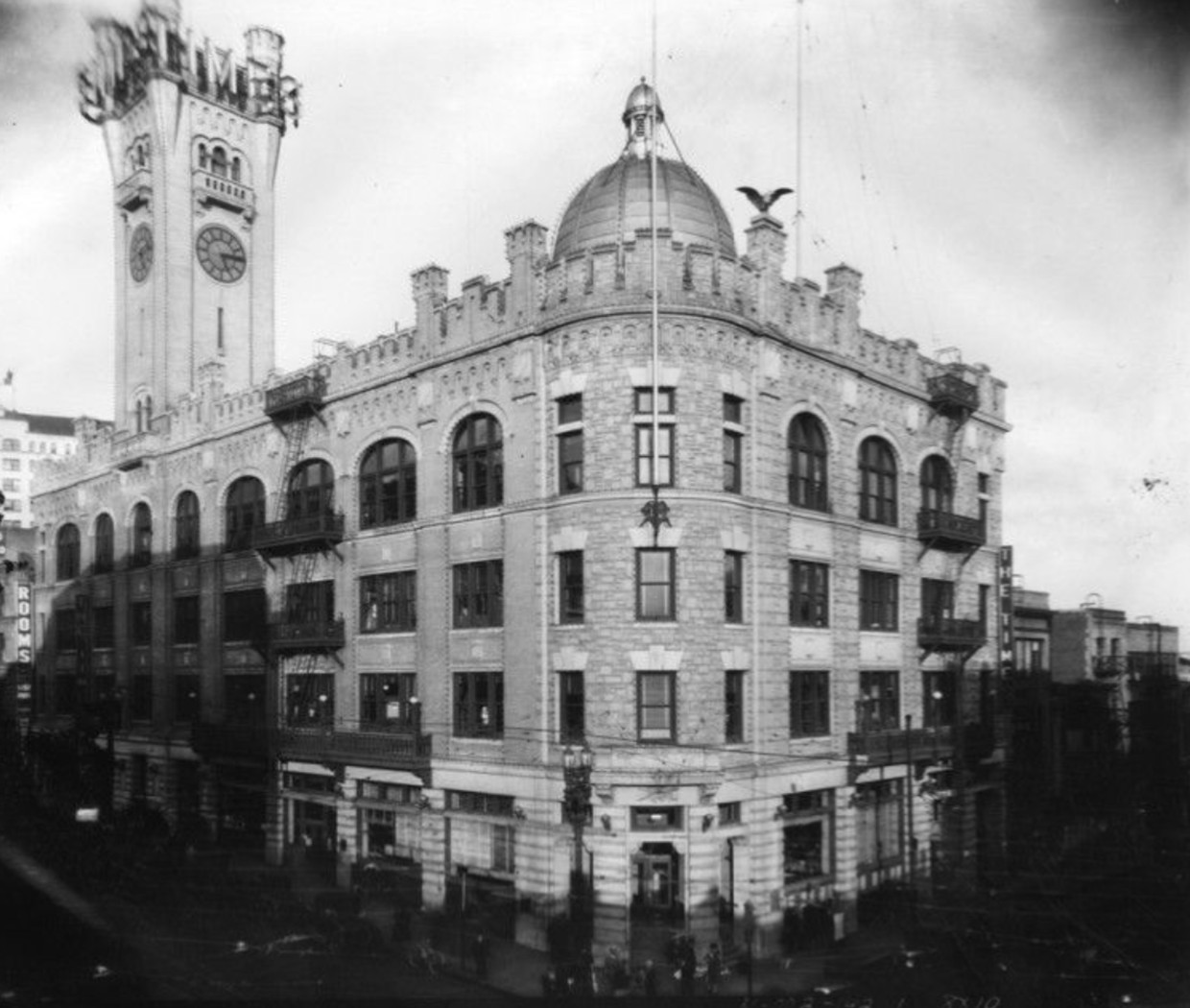 |
|
| (ca. 1912)* - View of the new Times Building shortly after it was rebuilt. Note the new castle-like clock tower. |
Historical Notes The third Times Building opened on October 1, 1912, exactly two years after the 1910 bombing destroyed the previous one. Its large stone walls and clock tower were meant to show strength and recovery. This building served as Times headquarters until 1935 and was torn down in 1937–38. |
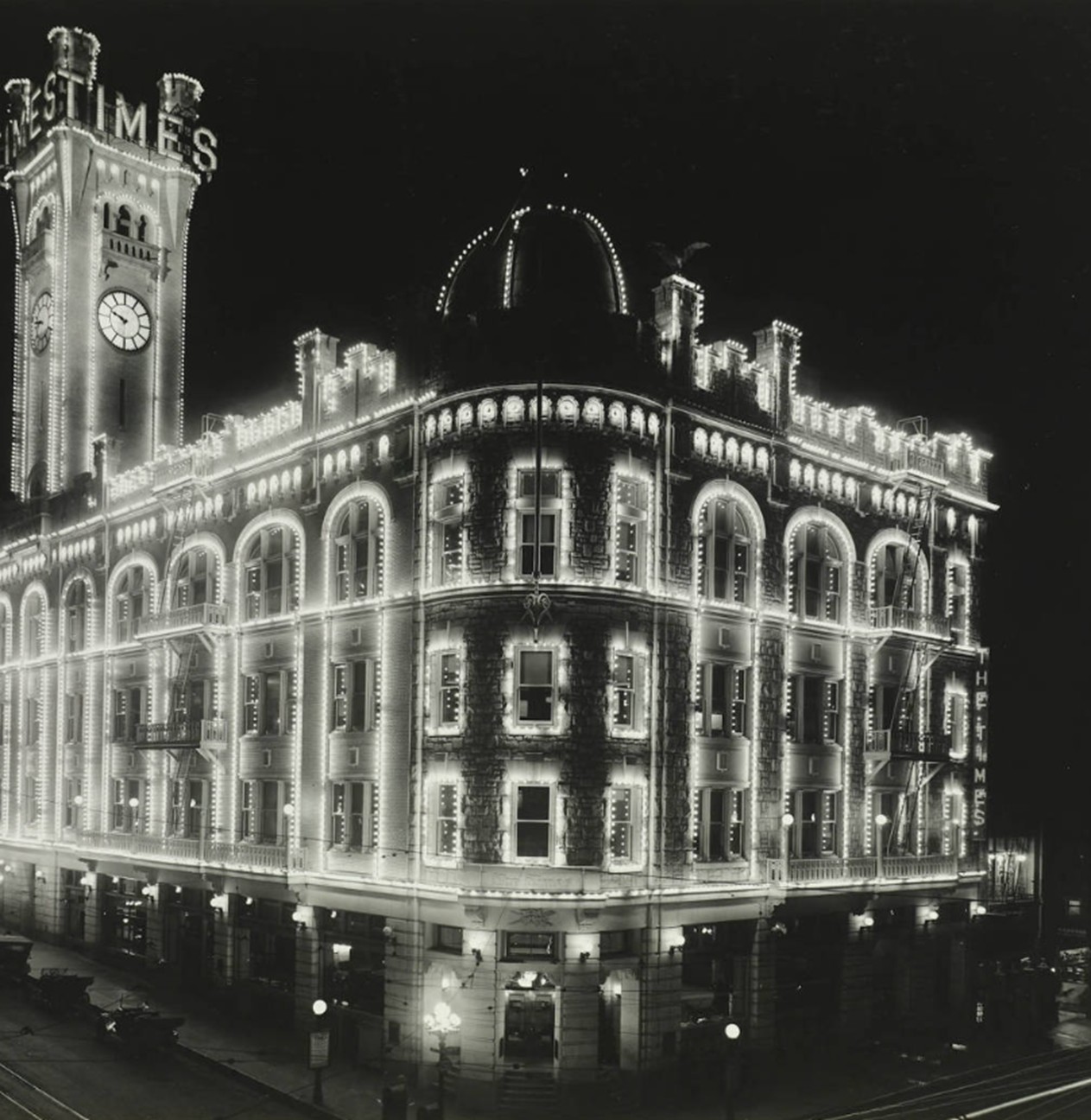 |
|
| (ca. 1912)* – The newly constructed Times Building lit up with decorative lights. |
Historical Notes In the early 1900s, lighting a building at night was a symbol of pride and progress. The clock tower became a landmark for evening events downtown. |
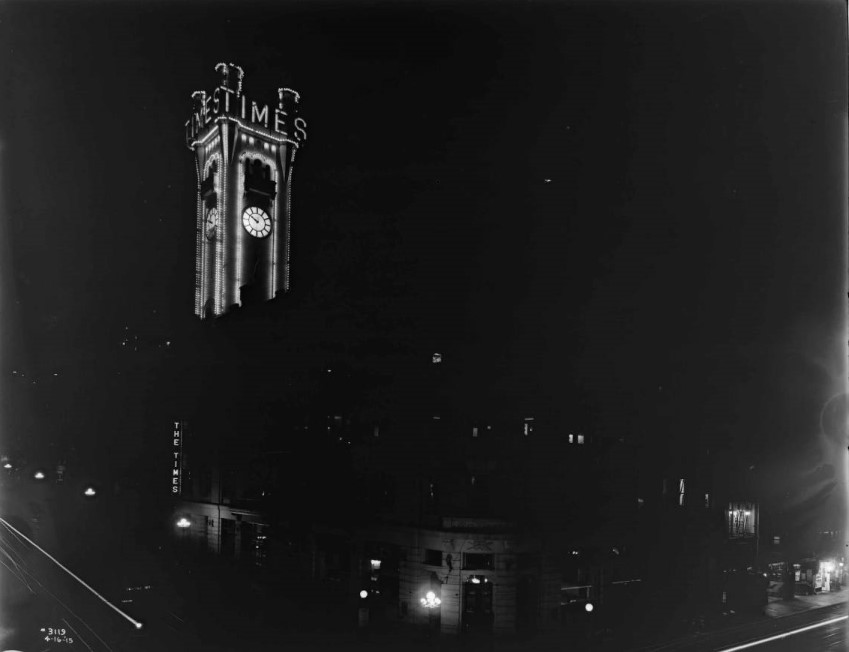 |
|
| (1915)* – Night view showing the illuminated clock tower of the LA Times Building. Photo Date: April 16, 1915 |
Historical Notes The Times often lit up the tower for holidays and special occasions. At night it was one of the brightest and most recognized features of downtown. |
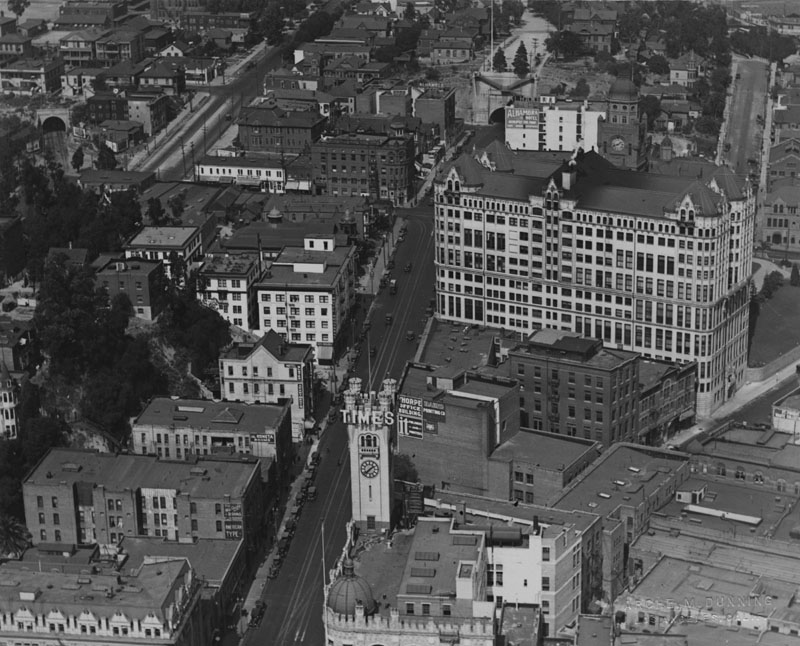 |
|
| (ca. 1925)* - Civic Center view looking north from 1st & Broadway. The Times Building is in the foreground. Behind it are the Hall of Records, the old County Courthouse, and the Broadway Tunnel. |
Historical Notes This photo shows the Civic Center of the 1920s, when Broadway was lined with government and newspaper buildings. The Broadway Tunnel, dug through Fort Moore Hill in 1901, carried cars north until it was closed in 1949. |
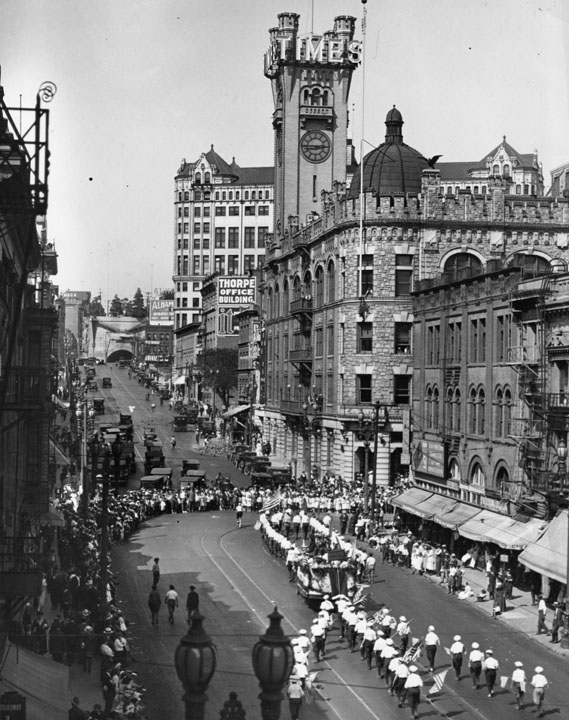 |
|
| (1920s)* - A parade on Broadway turns east onto 1st Street. The Times Building stands on the NE corner, with the Broadway Tunnel in the distance. |
Historical Notes Parades often went past the Times corner. The tower gave the corner a strong presence, making it a natural gathering spot for crowds. |
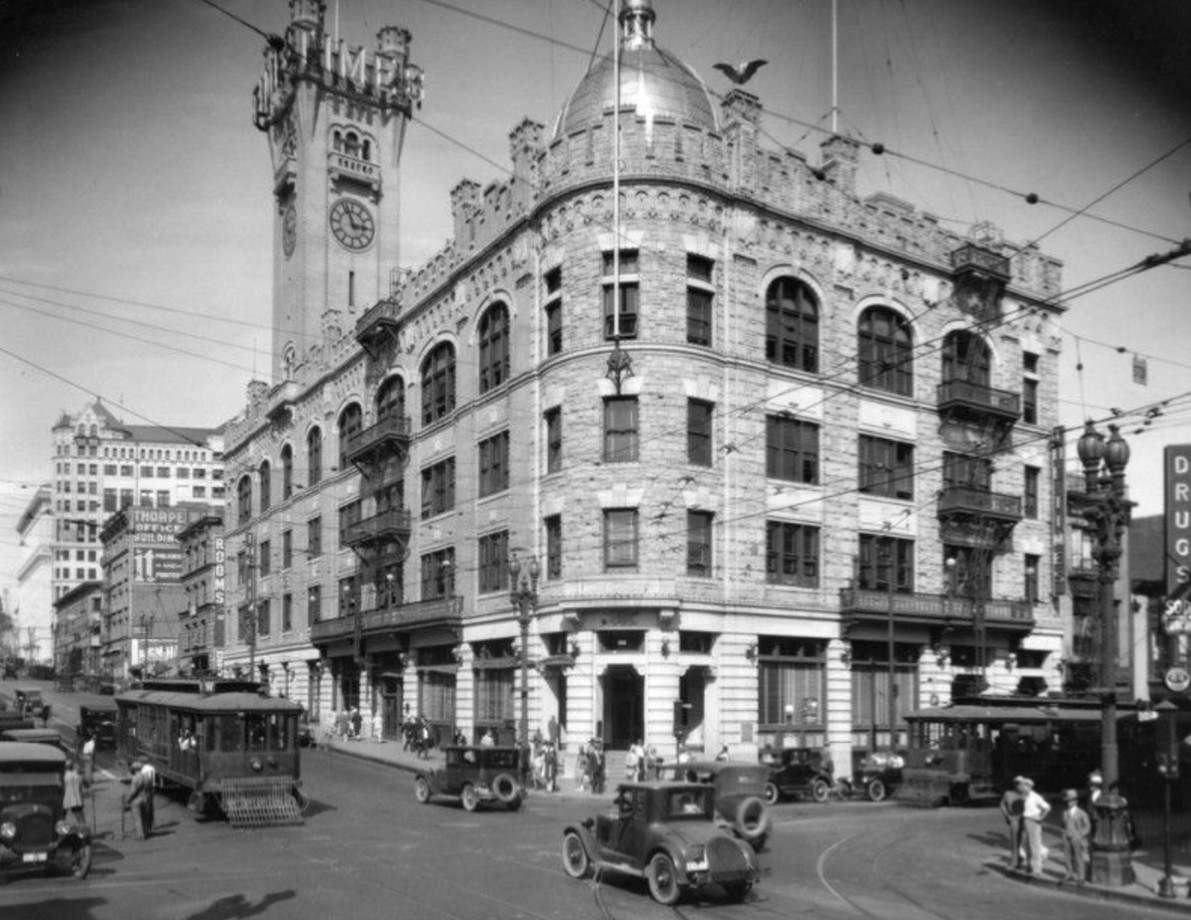 |
|
| (1926)* - Streetcars, cars, and pedestrians crowd the busy intersection at 1st & Broadway. The Times Building stands on the NE corner. |
Historical Notes By the 1920s, the area mixed cars, streetcars, and thousands of pedestrians every day. The Times was part of a lively block that included shops and cafes. |
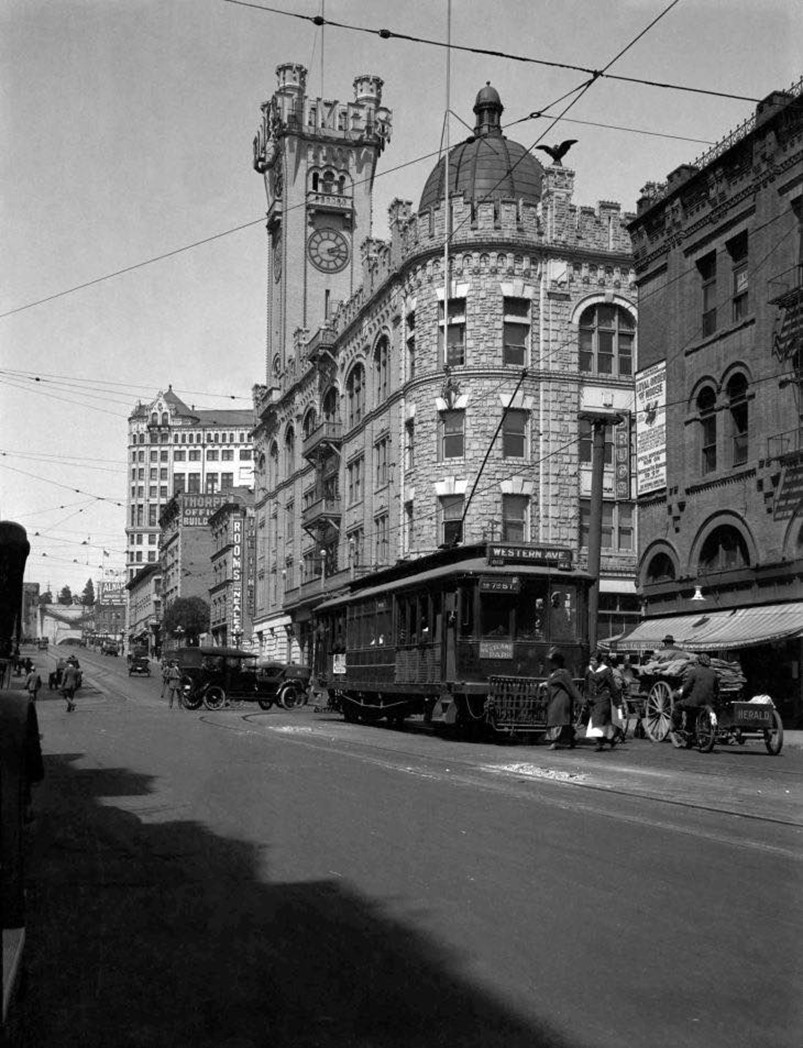 |
|
| (1920s)* – Looking north on Broadway just south of 1st Street. A bicyclist delivers newspapers as a Pacific Electric car heads north. The Times Building is on the NE corner. |
Historical Notes In this era, newspapers were delivered by bike, wagon, and streetcar. The Times Building shows how important newspapers were to city life. |
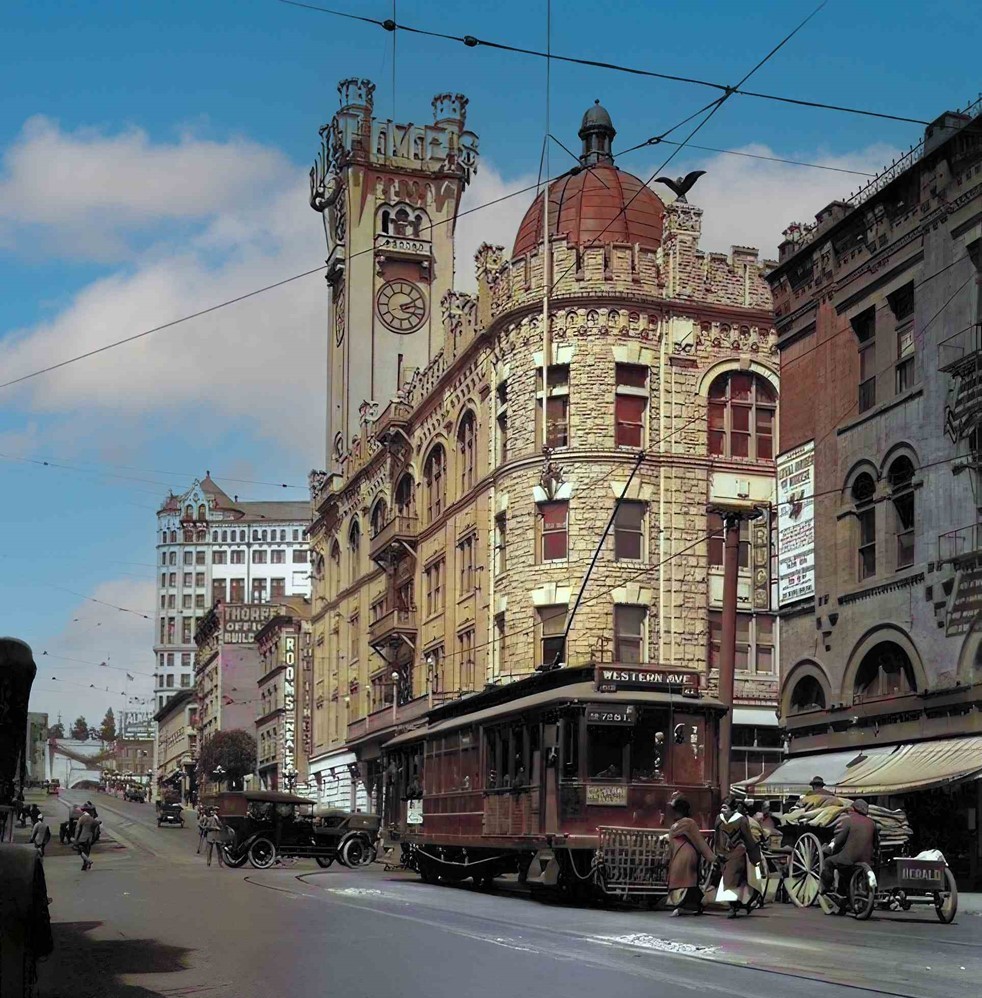 |
|
| (1920s)* – Looking north on Broadway toward 1st Street with the ornate Los Angeles Times building seen on the NE corner. Photo Source: Homestead Museum; AI image enhancement and colorization by Richard Holoff |
* * * * * |
Los Angeles Times Building (4th Building, 1935–2018)
 |
|
| (1934)* - Construction site for the new Times Building at 1st & Spring. A sign reads “New Home of Los Angeles Times – largest newspaper in the West.” |
Historical Notes Publisher Harry Chandler built this new headquarters during the Great Depression to show the paper’s power and stability. Designed by Gordon B. Kaufmann in the Art Deco style, it opened in 1935. |
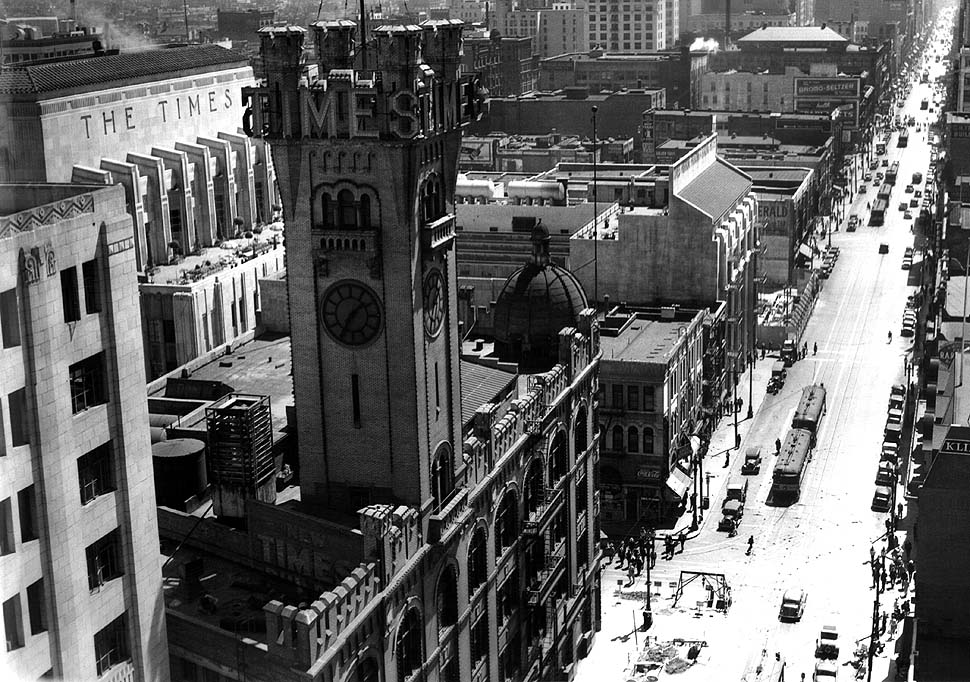 |
|
| (1934)* - View looking south on Broadway at 1st Street. The older Times Building (NE corner of 1st & Broadway) still stands while the new Times Building rises at 1st & Spring. |
Historical Notes For a short time, both Times buildings stood across from each other. The new headquarters became the centerpiece of Times Mirror Square, which later expanded in 1948 and 1973. |
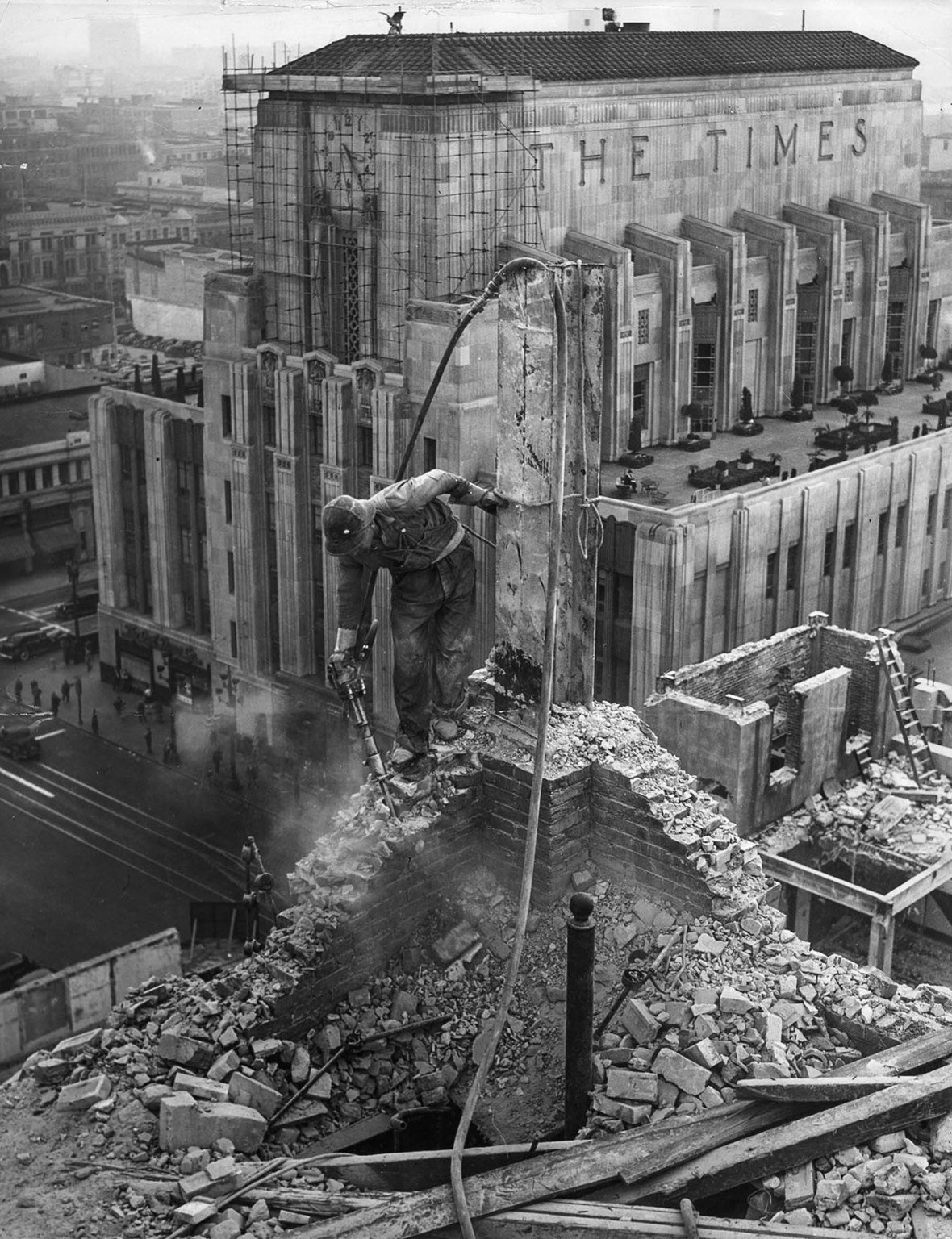 |
|
| (1937)* - The new Times Building rises across 1st Street while a worker demolishes the old Times Building at the NE corner of 1st & Broadway. |
Historical Notes The old Times tower was torn down in 1937–38. The new Art Deco headquarters featured the famous “Globe Lobby” with murals by Hugo Ballin and a giant globe of the world. In 1937, it won a gold medal at the Paris Exposition. In 2016, the 1935 Times Complex was sold to Vancouver’s Onni Group, even as the Times continued leasing space. The paper moved to El Segundo in 2018. Today, the site sits empty. Plans under consideration include reusing parts of the complex for mixed‑use—offices, residences, shops—while preserving its historic Art Deco features. Click HERE to see more Early Views of the 4th Times Building |
* * * * * |
Fire Station (Spring and 9th Streets)
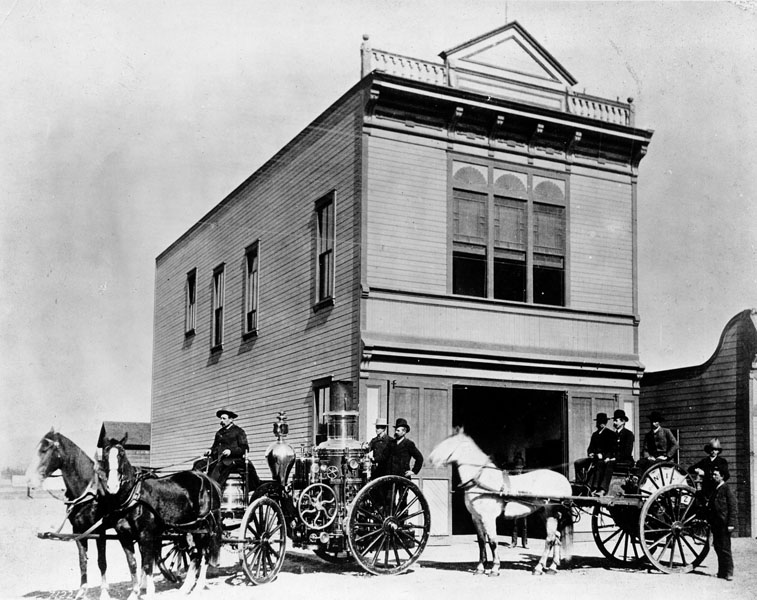 |
|
| (1887)* - Horse-drawn fire engine and cart in front of Los Angeles fire station house at southwest corner of 9th and Spring streets. Notice all the men above are in street clothes. The firehouses were staffed by volunteers until the end of 1887. |
Historical Notes In December 1885, the City Council considered the merits of a fully paid Department and moved to finance and control the first fully paid, official Los Angeles Fire Department (LAFD). In February 1886, the LAFD officially went into service with four fire stations. It took until 1887 for the City’s LAFD to establish its own fire station, Engine Company No. 1, the Old Plaza Firehouse. Click HERE to see more on the Old Plaza Firehouse in Early Plaza of Los Angeles. |
* * * * * |
H. D. Alfonso & Co. Grocery
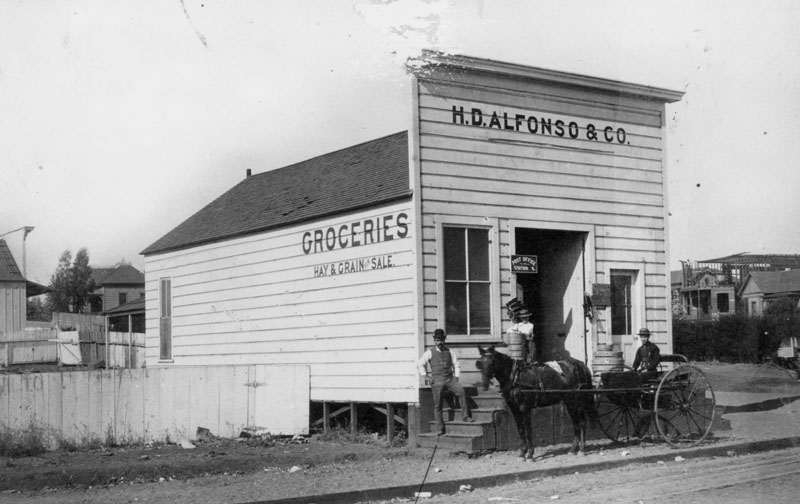 |
|
| (1887)* - View showing thef H. D. Alfonso & Co. grocery and feed store located at the corner of Temple and Main. The unattached one-story wooden frame building has steps leading to the entrance. A sign at the door indicates that the premise is authorized to be a post office station. A man and boy pose on the steps and a man in a horse and buggy are in front. On the side of the building is painted: "Groceries, Hay and Grain for sale". A house is being constructed in the background. |
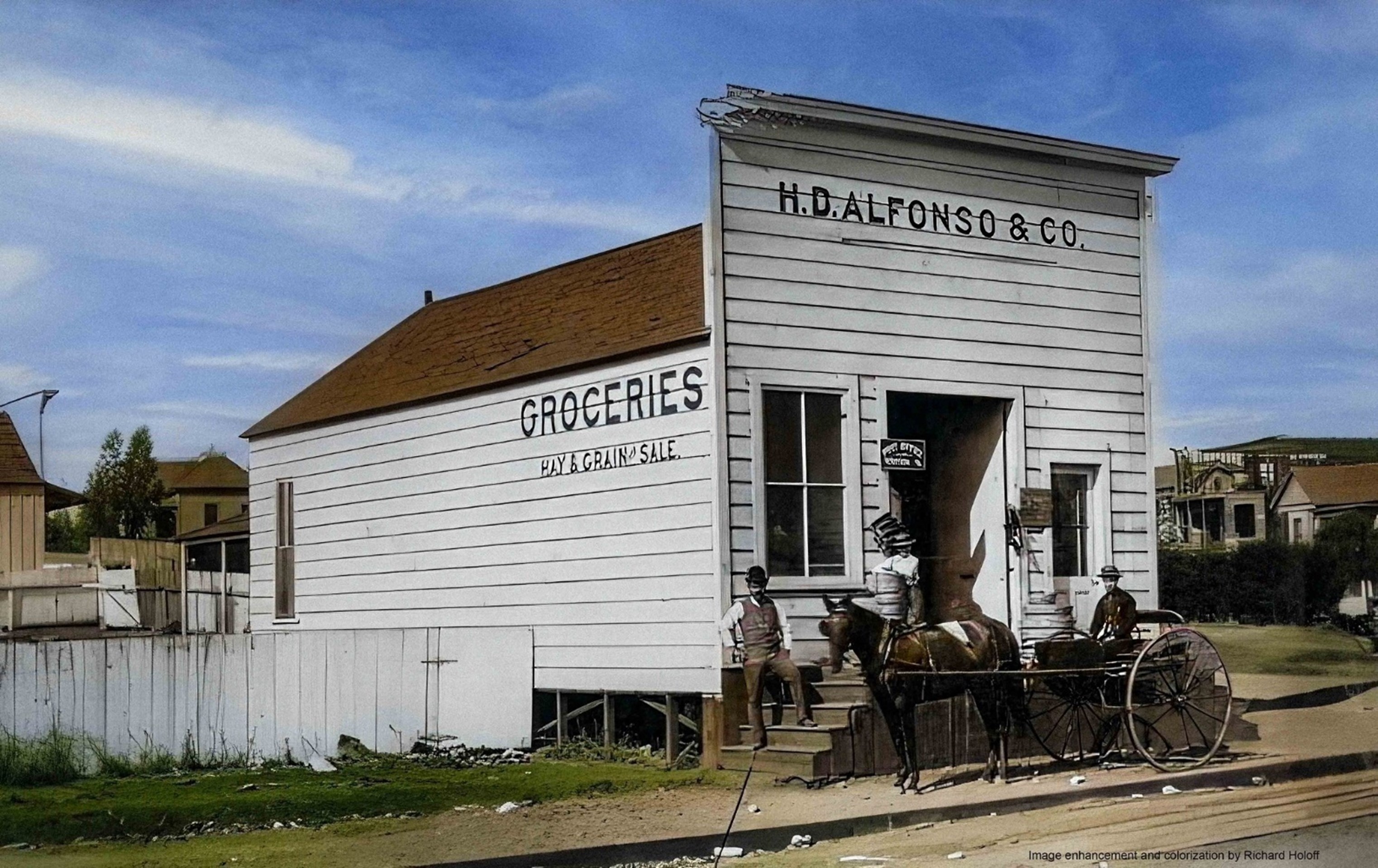 |
|
| (1887)* - View showing thef H. D. Alfonso & Co. grocery and feed store located at the corner of Temple and Main. The unattached one-story wooden frame building has steps leading to the entrance. A sign at the door indicates that the premise is authorized to be a post office station. A man and boy pose on the steps and a man in a horse and buggy are in front. On the side of the building is painted: "Groceries, Hay and Grain for sale". A house is being constructed in the background. Image enhancement and colorization by Richard Holoff. |
* * * * * |
Burbank Block
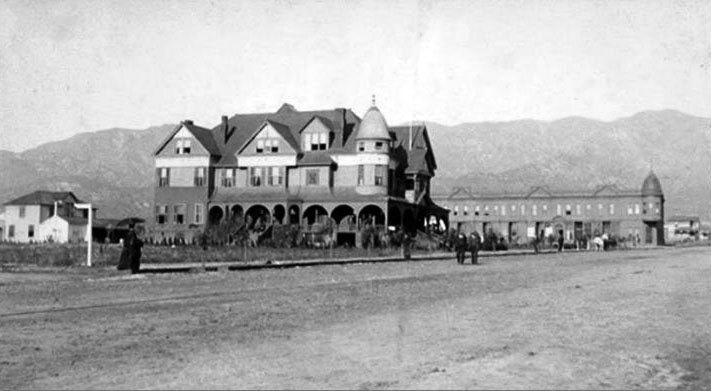 |
|
| (1887)^*^^ - View of the Burbank Villa Hotel looking north on Olive Avenue. It was built by Dr. David Burbank and his son-in-law John W. Griffin. Behind it and to the right is the Burbank Block. |
Historical Notes At the time the American Civil War broke out Dr. David Burbank established his profession as a dentist in Pueblo de Los Angeles. In 1867, he purchased Rancho La Providencia from David W. Alexander and Francis Mellus, and he purchased the western portion of the Rancho San Rafael (4,603 acres) from Jonathan R. Scott. Dr. Burbank's property reached nearly 9,200 acres at a cost of $9,000. He eventually became known as one of the largest and most successful sheep raisers in southern California, resulting in him stopping his practice of dentistry and investing heavily in real estate in Los Angeles.^* The Burbank Villa Hotel cost $30,000 to build and was later renamed the Santa Rosa Hotel which was a popular place for weddings and galas. The hotel was remodeled into apartments in the 1920's and by 1927 was torn down and later replaced by the Downtown Burbank Station (Bob Hope) Post Office.^*^^ |
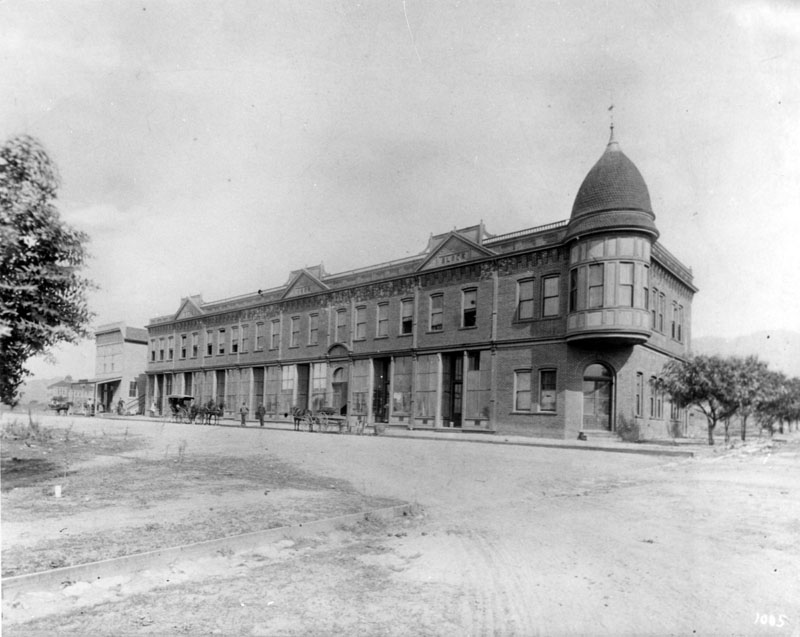 |
|
| (1895)* - Exterior view of the Burbank Block (Brick Block), the first brick building in town located at San Fernando Road and Olive Avenue. Horse-drawn carriages are parked alongside of the building. |
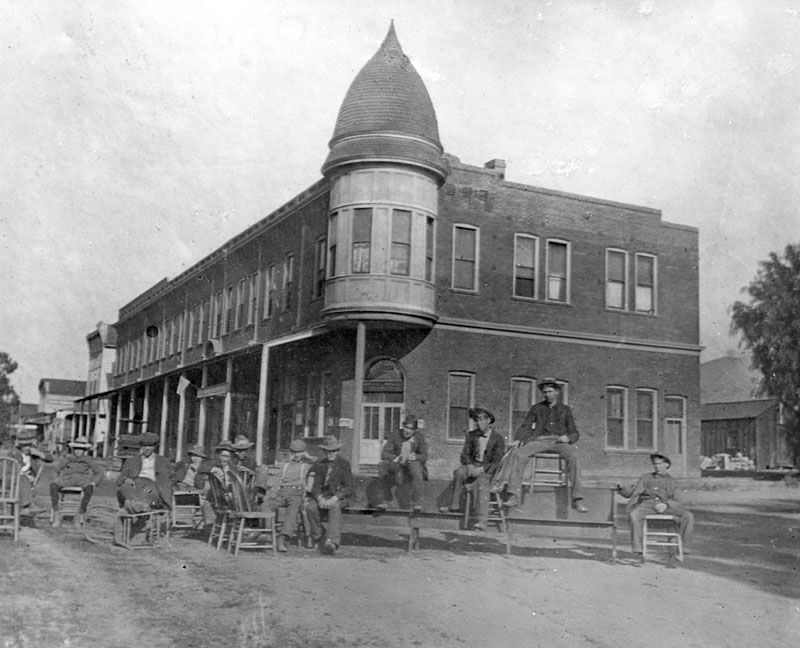 |
|
| (1889)* - Group photo of several men sitting in front of the Burbank Block. The Burbank Block was the first brick building in town, located on San Fernando Road (now Golden Mall) and Olive Avenue in Burbank. The Brick Block was erected during 1887 by the Provedencia Land & Water Co. for the newly planted town of Burbank. |
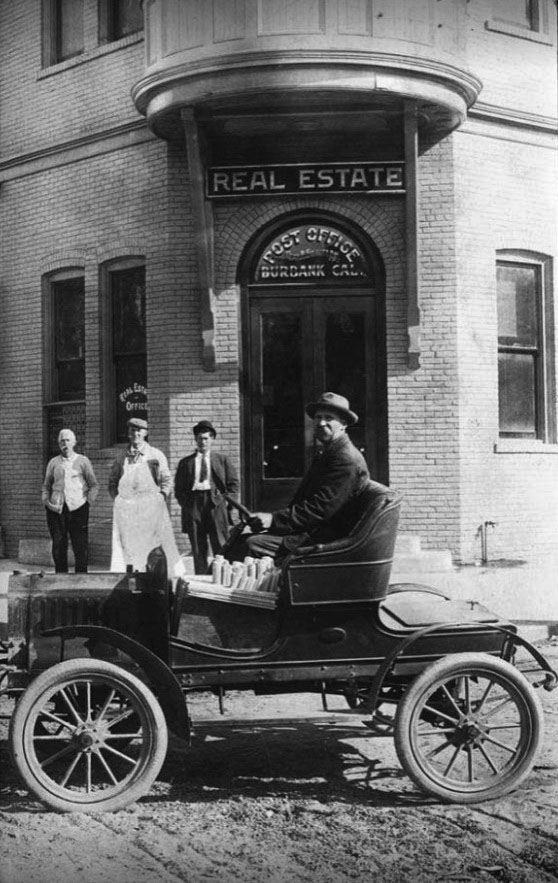 |
|
| (1911)^.^ – Four men pose for the camera in front of the Burbank Post Office located in the Brick Block Building. Sign over the doorway also reads “Real Estate”. Note the early model car has the steering wheel on the right.. |
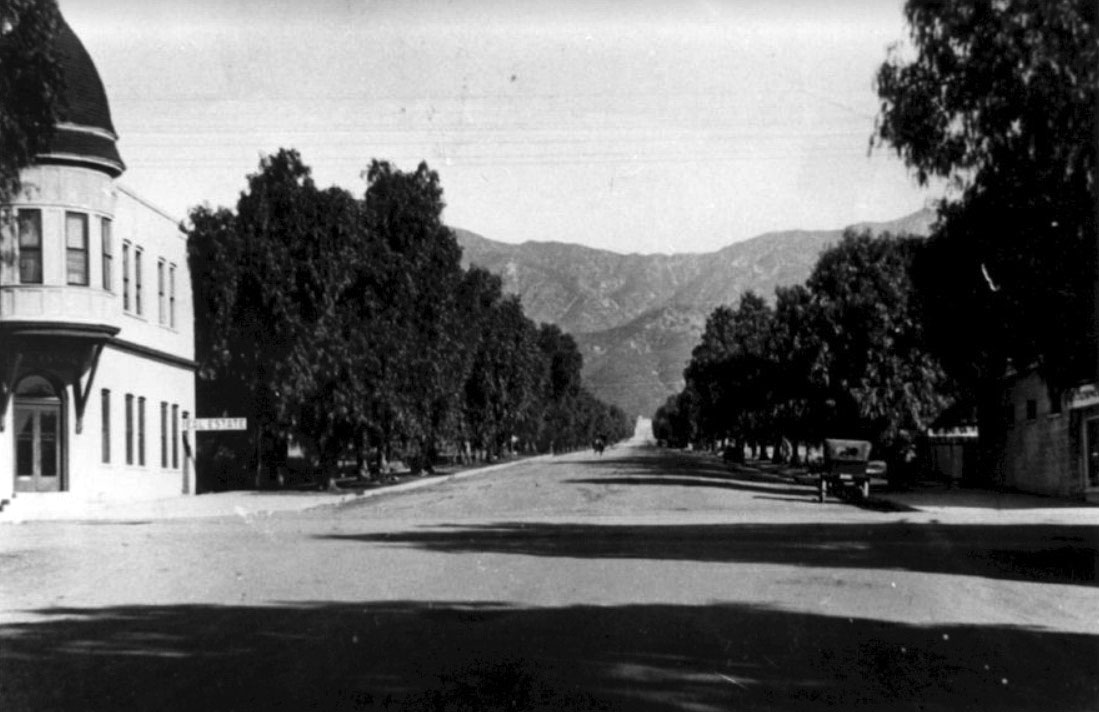 |
|
| (ca. 1915)^.^ - View looking north on Olive Avenue from San Fernando Road towards the Verdugo Mountains with the Brick Block Building seen on the left. |
* * * * * |
Early Compton
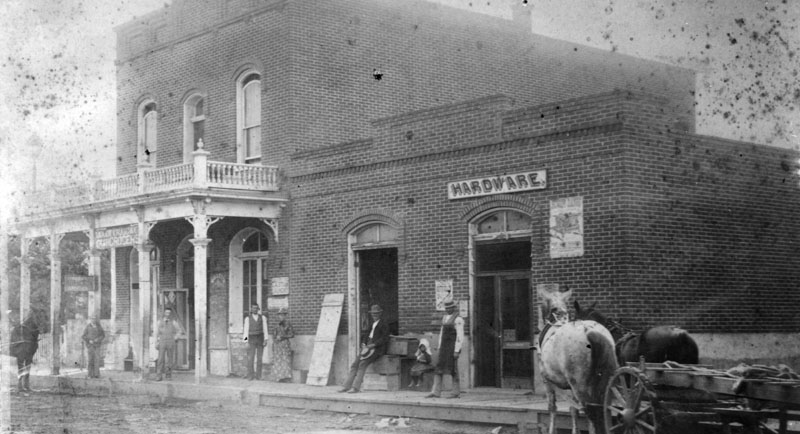 |
|
| (1887)* - This business block in Compton includes a hardware and grocer. A horse-drawn cart can be seen at right. Shop owners are standing in front of the brick building housing various businesses, posing for the camera. |
Historical Notes In 1867, Griffith Dickenson Compton led a group of thirty pioneers to the area. These families had traveled by wagon train south from Stockton, California in search of ways to earn a living other than in the rapid exhaustion of gold fields. Originally named Gibsonville, after one of the tract owners, it was later called Comptonville. However, to avoid confusion with the Comptonville located in Yuba County, the name was shortened to Compton. Griffith D. Compton donated his land to incorporate and create the city of Compton in 1889, but he did stipulate that a certain acreage be zoned solely for agriculture and named Richland Farms. In January 1888, a petition supporting the incorporation of Compton was forwarded to the Los Angeles County Board of Supervisors, who in turn forwarded the petition to the State Legislature. On May 11, 1888 the city of Compton was incorporated, it had a total population of 500 people. The first City Council meeting was held on May 14, 1888.^* Click HERE to see more Early Views of Compton. |
* * * * * |
Wolfskill Ranch
 |
|
| (ca. 1880)^ - Full frame lithograph photo of the orange and lemon groves on the Wolfskill Ranch, residence of William Wolfskill. The Los Angeles and Independence Railroad Station can be seen in the background. The Southern Pacific Arcade Station would be built on the Wolfskill Ranch in 1888. |
Historical Notes William Wolfskill, a native of Kentucky, came to California in 1831 and settled in Los Angeles in 1836, where he soon met and married Magdalena Lugo, daughter of Jose Ygnacio Lugo. In March 1838, Wolfskill purchased a 100-acre lot bounded by 3rd to 9th streets and San Pedro to Alameda streets, which he named Wolfskill Ranch, and built a large adobe (known as "Wolfskill Adobe") located at 239 Alameda, between 3rd and 4th streets. In 1839 Wolfskill became a major grape producer when he planted the first vineyard of table grapes in California. Two years later, in 1841, he planted his first 2-acre plot of citrus behind his adobe, between 4th and 6th streets east of Alameda. In a short period of time, Wolfskill's farm had increased to 28-acres of planted citrus with over 2,500 orange trees. By 1862 he owned 3/4 of all the orange trees in California and was the biggest orange grower in the United States - for which he is considered the father of early California citrus industry. In 1865, Wolfskill purchased Rancho Santa Anita, where he planted eucalyptus seeds that he had imported from Australia. The eucalyptus trees, which still stand today, were the first of their kind in California.* |
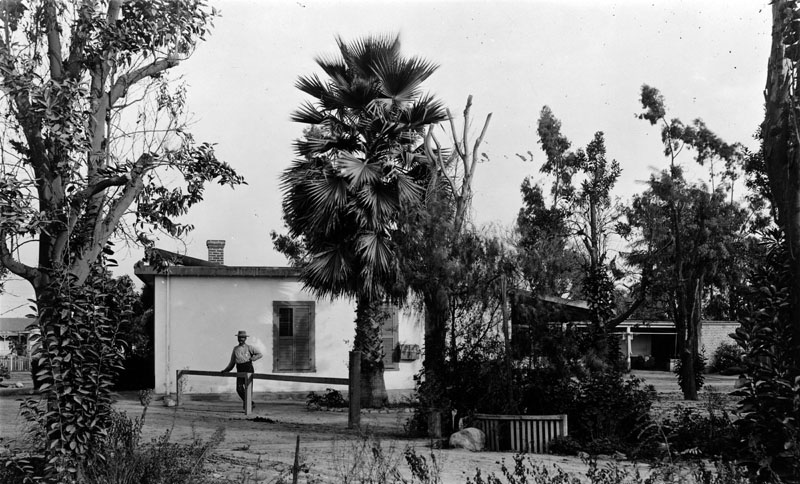 |
|
| (ca. 1880s)* - Exterior view of the William Wolfskill adobe (simply known as the "Wolfskill Adobe") located at 239 Alameda, between 3rd and 4th streets. It shows one side of the white L-shaped adobe behind several palms and trees. A gentleman can be seen leaning against a low post - possibly used to tie horses, as a pile of manure is visible near his feet. |
Historical Notes William Wolfskill died in 1866 at the age of 68, but the property remained in the family, with his son Louis Wolfskill taking over the operation of the ranch. Eventually, all but seven acres of the Wolfskill Ranch would either be sold or subdivided.* John Wolfskill, William's younger brother, owned the Wolfskill Ranch on land that would later become Westwood and UCLA. Click HERE to see more in Early Views of UCLA. |
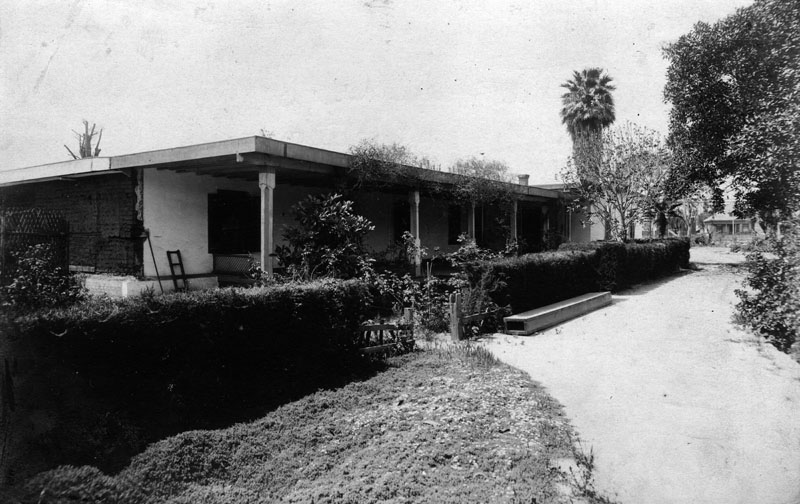 |
|
| (1887)* - Front view of the Wolfskill Adobe showing a low hedge separating the house from a dirt pathway, possibly a driveway. A few trees can be seen in the surrounding area and another house or building is visible in the background on the right. |
Historical Notes In 1887, the still-standing Wolfskill Adobe would be razed to make way for the old Southern Pacific Railroad's Arcade Station, which was located at Fifth and Alameda. This, too, would be demolished in 1914 and replaced with a larger and more modern railroad passenger depot - the Central Station. In 1916, the Ice & Cold Storage Plant was built on a portion of the land, and was located on 3rd and Central avenues. By 1958, the Ice & Cold Storage Plant had become Young's Market Company, located at 500 S. Central Avenue. |
* * * * * |
Arcade Depot Palm and the Arcade Depot
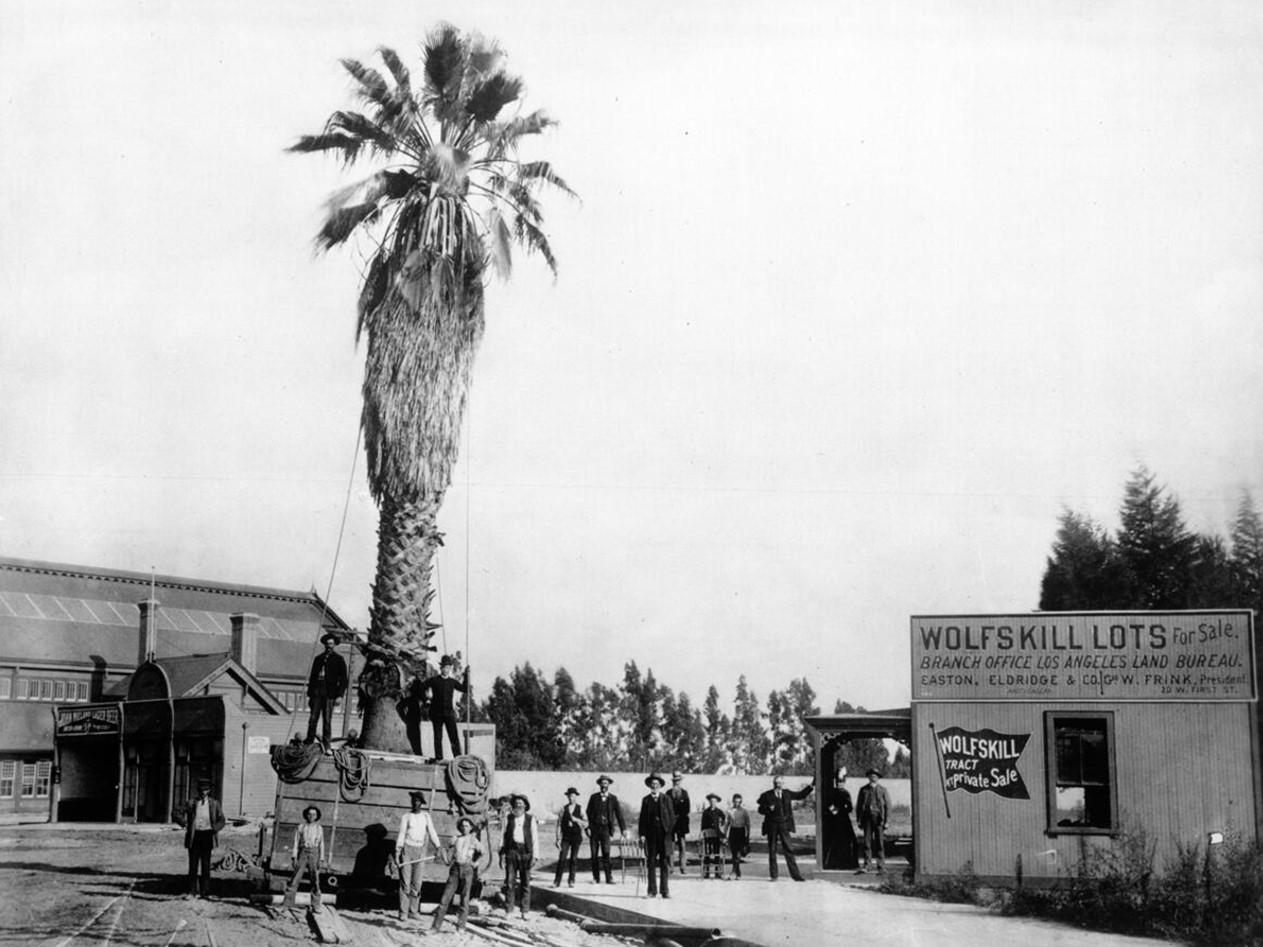 |
|
| (1889)* - View of a palm tree being moved to the front of the recently completed Arcade Depot on Fourth Street and Central Ave on land that was once occupied by the Wolfskill Adobe. Amazingly, the original Arcade Depot palm seen above is still alive. It was replanted at a location in front of the Los Angeles Coliseum where it stands today. It along with the Longstreet Palms are considered to be the oldest trees in the City of Los Angeles (see more below). |
Historical Notes The Arcade Train Depot, also known as the Arcade Station, played a significant role in the development of Los Angeles' transportation infrastructure during the late 19th and early 20th centuries. The Arcade Depot was constructed by the Southern Pacific Railroad and opened in 1888. It was strategically located on Central Avenue between 5th and 6th Streets, on land that was previously part of the orange groves owned by William Wolfskill. The city of Los Angeles provided this land to entice the railroad to establish a major terminal in the city. A fully-grown Washington fan palm, moved from a site nearby, stood outside the station's entrance, symbolically welcoming newcomers to a supposed subtropical paradise. |
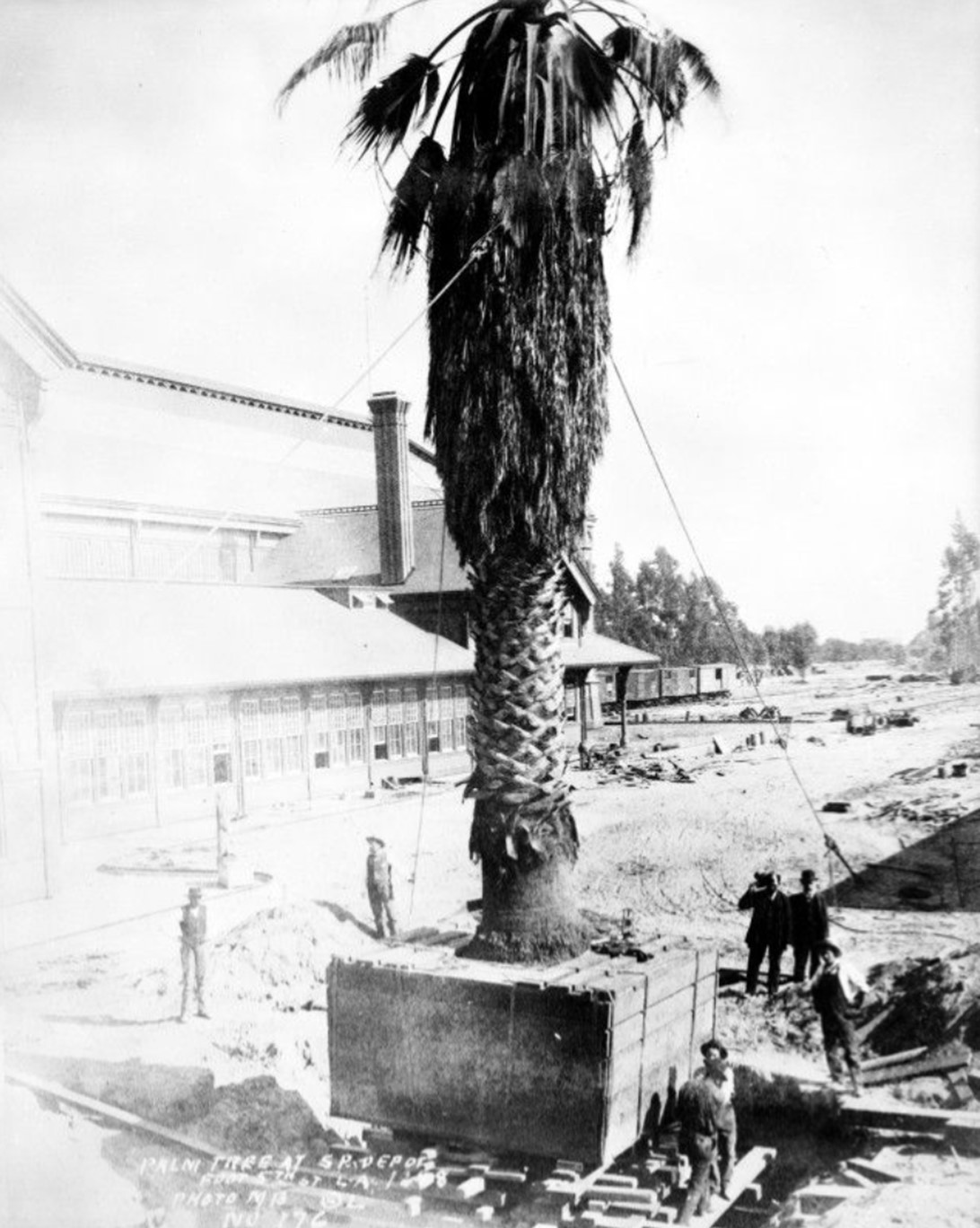 |
|
| (1889)* - A very large palm tree (aka Washingtonia filifera fan palm) being planted outside of the Arcade Station at Central Avenue between 4th and 5th Streets. |
Historical Notes The palm tree, a Washingtonia filifera fan palm, is believed to have started its life in the 1850s in a backyard on San Pedro Street, between 2nd and 3rd Streets. In 1889, the 30-foot palm was chosen to be transplanted to a prominent location in front of the entrance to the Arcade Depot, the Southern Pacific Railroad's new transcontinental terminus. This strategic placement made the palm the first sight that greeted newcomers arriving in Los Angeles by train, offering a welcoming view after long journeys from the colder eastern regions. |
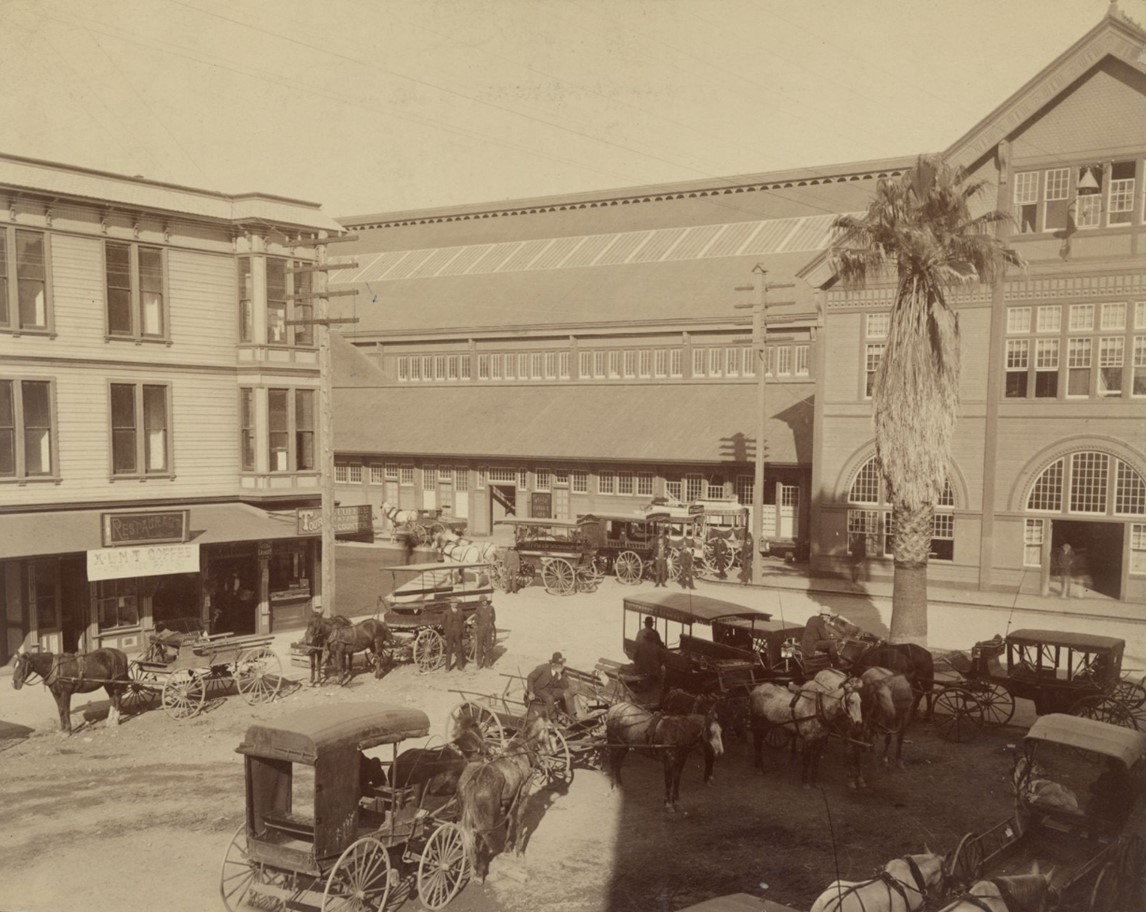 |
|
| (1890)* - A dozen horse-drawn wagons wait for the next train to arrive at the Southern Pacific Arcade Depot with the Arcade Palm standing in front of the depot. |
Historical Notes The establishment of the Arcade Depot was a pivotal moment in Los Angeles' history, marking the city's emergence as a major transportation hub. The station facilitated increased connectivity with the rest of the United States, contributing to the population boom and economic growth of Los Angeles during the late 19th century. The influx of tourists and new residents helped transform Los Angeles from a relatively small town into a burgeoning metropolis. |
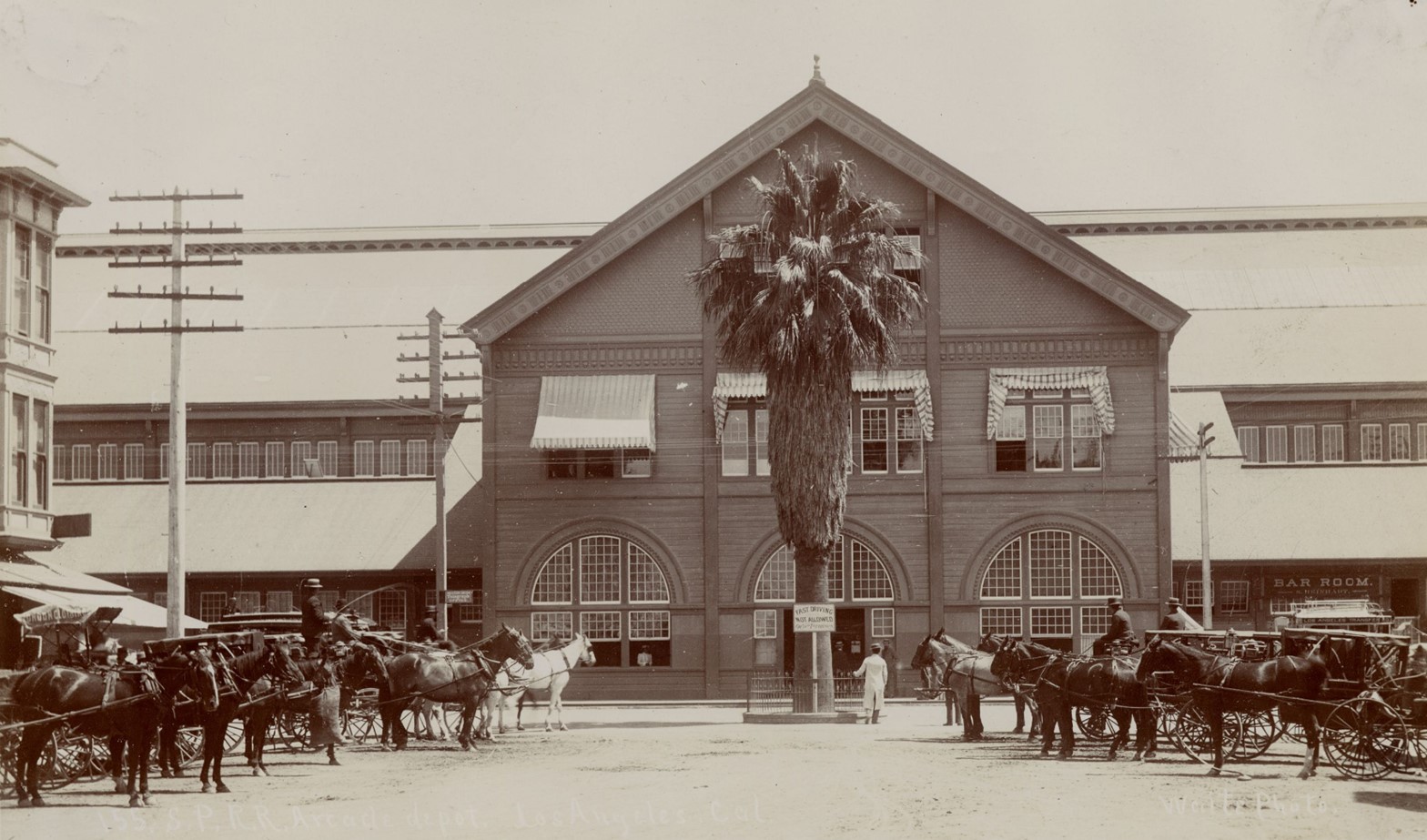 |
|
| (1896)* - Front view of the Southern Pacific Railroad Arcade Depot at end of 5th Street and Central Avenue in Los Angeles; the main building has arched windows at first level, square windows with awnings on second floor. A large palm tree (Arcade Palm) stands at center with horse-drawn carriages on both sides waiting for passengers to arrive. |
Historical Notes The sign in front of the palm reads “FAST DRIVING NOT ALLOWED On These Premises”. |
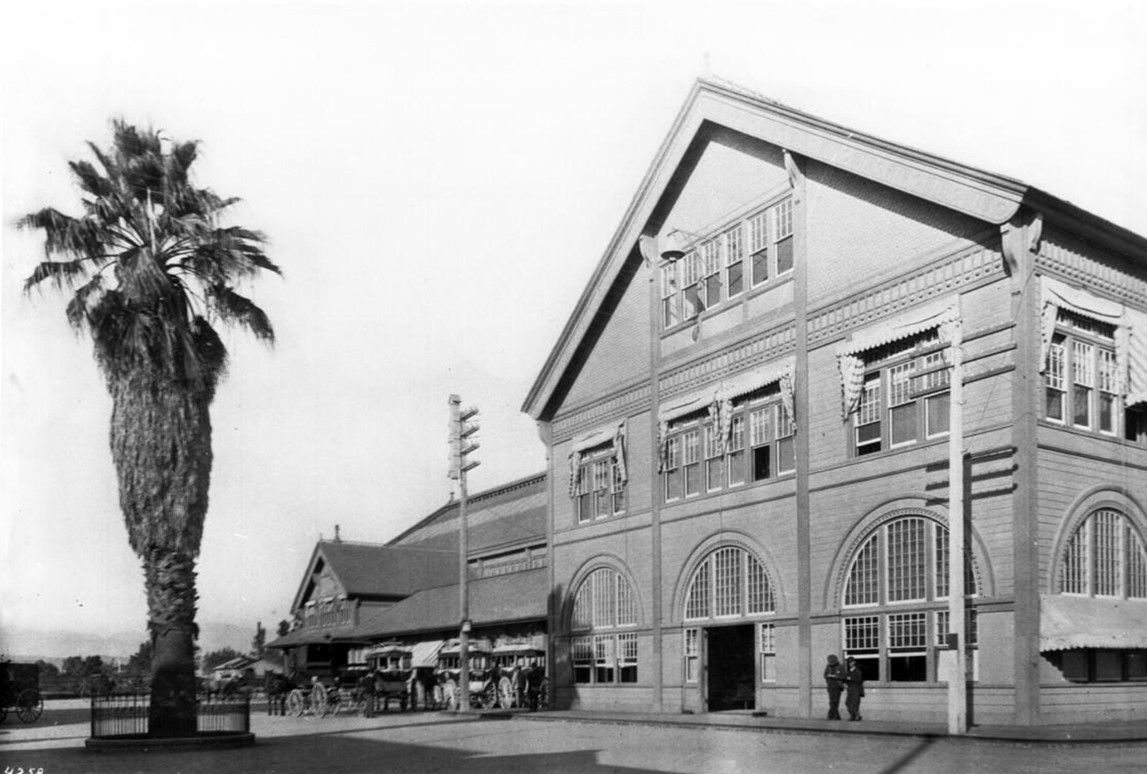 |
|
| (1890s)* - Close-up view of the Arcade Depot with it's now-famous palm tree standing tall in front of the main entrance. Horse-drawn carriages can be seen waiting for the arrival of passengers, 526 Central Avenue. |
Historical Notes For about 25 years (1889 – 1914), the palm stood as a landmark at the Arcade Depot, becoming a familiar sight to thousands of Los Angeles residents and visitors. |
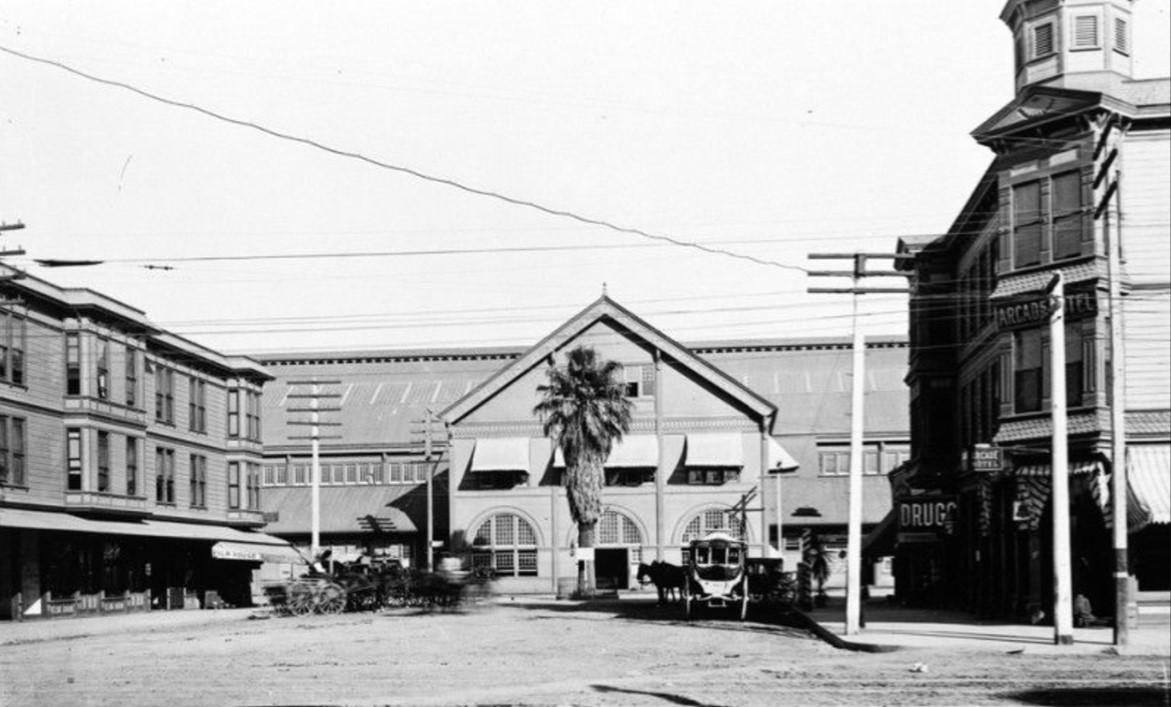 |
|
| (1910s)* - Horse and buggies are parked outside the Arcade Station on the east side of Central Avenue at the end 5th Street. The singular Arcade palm tree can be seen in front of the station, the same tree seen being planted in the earlier 1889 photo. |
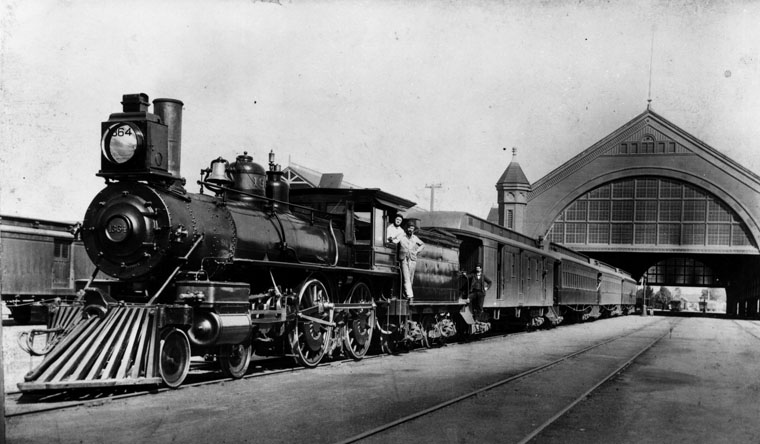 |
|
| (1891)* - Southern Pacific steam engine no. 1364 heads the train at the Arcade Station at Central Avenue between 4th and 5th St. |
Historical Notes The Arcade Station was the second station built by Southern Pacific in Los Angeles (and first one built primarily for passenger service). Built in 1889 and used until 1914 when it was replaced by larger SP Central Station. It was demolished shortly thereafter. |
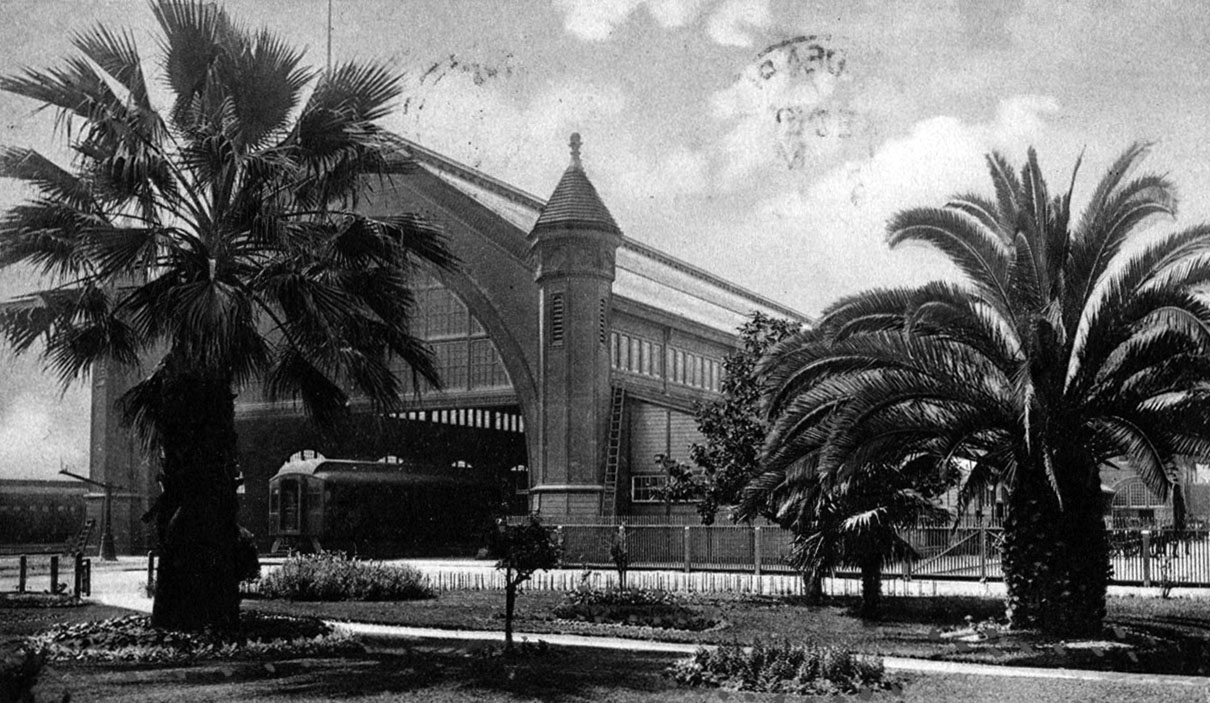 |
|
| (n.d.)^ – Postcard view of the Southern Pacific Arcade Depot looking towards the southeast. A passenger car is visible at the building's entrance. Four palm and fruit trees, a rose bush and flower beds are visible in the park in the foreground. |
Historical Notes The Southern Pacific Arcade Depot was one of three railroad depots that served the Los Angeles area before the construction of Union Station in 1939. The Arcade Depot was originally constructed in 1888 at 5th Street and Central Avenue, on acreage originally owned by William Wolfskill and used for cultivating the first commercial orange grove in Southern California. In 1914, the station was rebuilt on an adjoining site, and renamed Central Station. Central Station also became the site of the Union Pacific Railroad's downtown Los Angeles passenger terminal in 1924 when its original passenger depot was destroyed by fire. The Central Station, along with the "La Grande" Santa Fe Railroad Passenger Depot, was replaced in 1939 by Union Station and later demolished. |
 |
|
| (n.d.)* - Interior view of an empty Arcade Depot. The trains appear to be sitting outside the building. |
Historical Notes The depot itself was a massive, wooden Victorian structure reminiscent of European train stations. Five hundred feet long, the depot's rail shed featured skylights and an arched roof that soared 90 feet above the platforms below. Upon its opening, the Los Angeles Times praised the Arcade Station as "second to none on the Pacific Slope” . |
 |
|
| (ca. 1895)* - View showing the first streetcar on the L.A. Consolidated Electric R.R. in front of Southern Pacific's Arcade Station. |
Historical Notes The Arcade Depot replaced the older Southern Pacific River Station as the primary passenger terminal in Los Angeles. It served not only mainline steam trains but also the Pacific Electric Red Cars, which were a significant part of the city's public transportation network at the time. On October 14, 1890 'General' Moses Sherman founded the Los Angeles Consolidated Electric Railway in Downtown Los Angeles. He received a 50-year franchise from the city and sold stock to help build his street car railroad. In January, 1891 Sherman made is brother-in-law, Eli P. Clark, vice-president and manager of the Los Angeles Consolidated Electric Railway, the predecessor of the Los Angeles Pacific Railroad. The company built 47 miles of track radiating out around from Arcade Depot at 6th and Central Streets in downtown Los Angeles. |
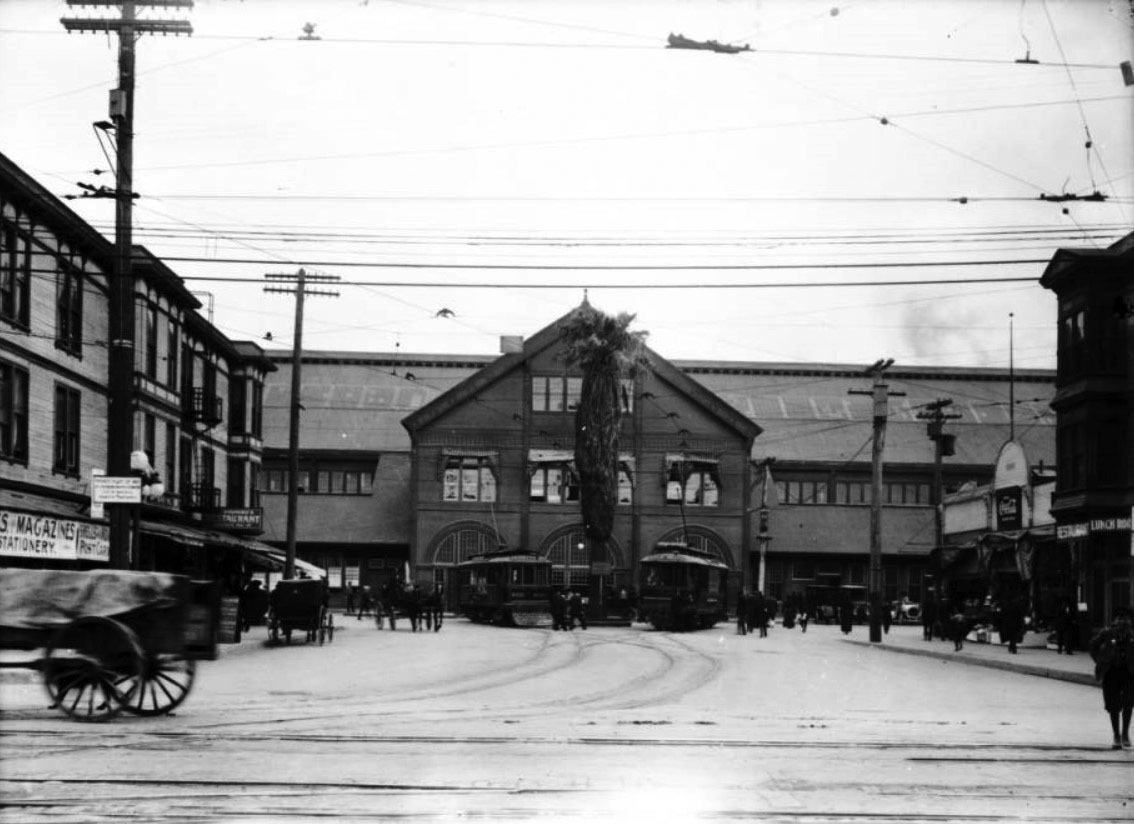 |
|
| (ca. 1914)* - View looking east on Fifth Street as it ends at the Southern Pacific Railroad Arcade Depot on Central Avenue. Two streetcars are parked in front of the railroad building on tracks that intersect with more tracks in the foreground. Several horse-drawn vehicles are visible, as well as many pedestrians making their way along the sidewalks that border the streets. The ‘Arcade Depot Palm’ is seen standing near the center of the building. |
Historical Notes In 1914, the Southern Pacific Railroad replaced the Arcade Station with the Central Station, a larger and more modern railroad passenger depot. The Union Pacific Railroad moved its Downtown Los Angeles passenger terminal to Central Station in 1924 after its original passenger depot just south of First Street on the east side of the Los Angeles River was destroyed by fire. |
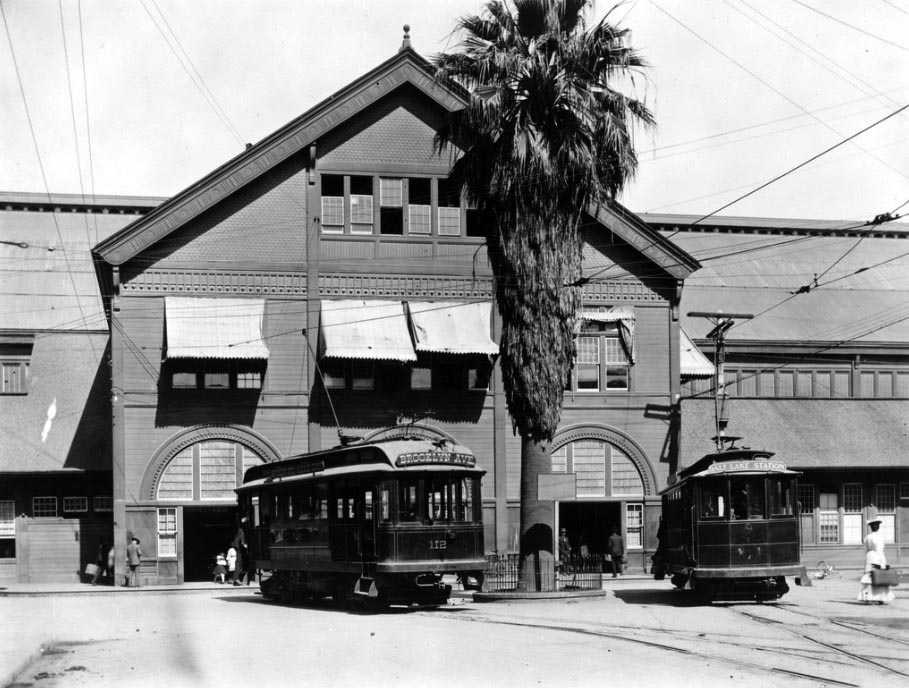 |
|
| (ca. 1905)* – View showing two Pacific Electric Railway cars parked in front of the Arcade Depot. Sign above the two streetcars read Brooklyn Ave and Westlake Station, respectively. |
Historical Notes Amazingly, the original Arcade Depot palm seen above is still alive. It was replanted at a location in front of the Los Angeles Coliseum where it stands today. It along with the Longstreet Palms are considered to be the oldest trees in the City of Los Angeles. |
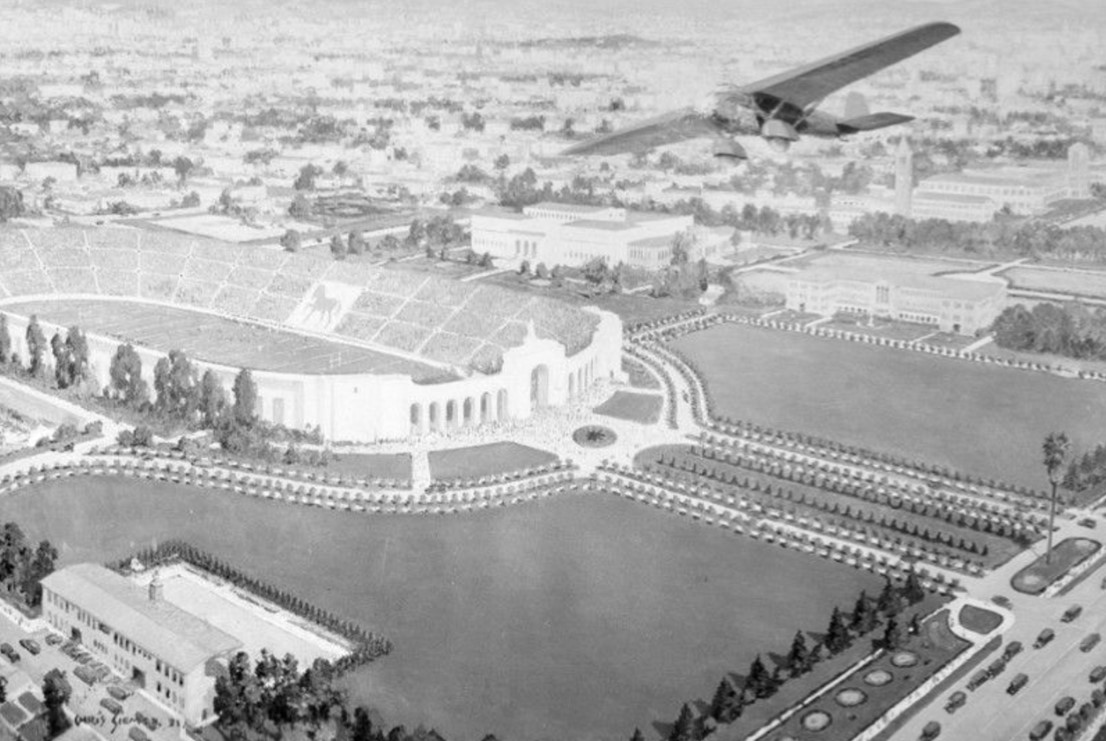 |
|
| (1930s)* - A painting by Chris Siemer of the Los Angeles Coliseum in Exposition Park around the 1930s, created for a display for the Los Angeles Chamber of Commerce. The horse created by the card section indicates that a USC football game is in progress. On the lower right side, at the Figueroa St. entrance to Exposition Park, stands the Arcade Palm. |
Historical Notes On September 5, 1914, when the Arcade Depot was replaced by a new station, the palm was transplanted to its current location in Exposition Park. This move coincided with the renaming of Agricultural Park to Exposition Park in 1913. |
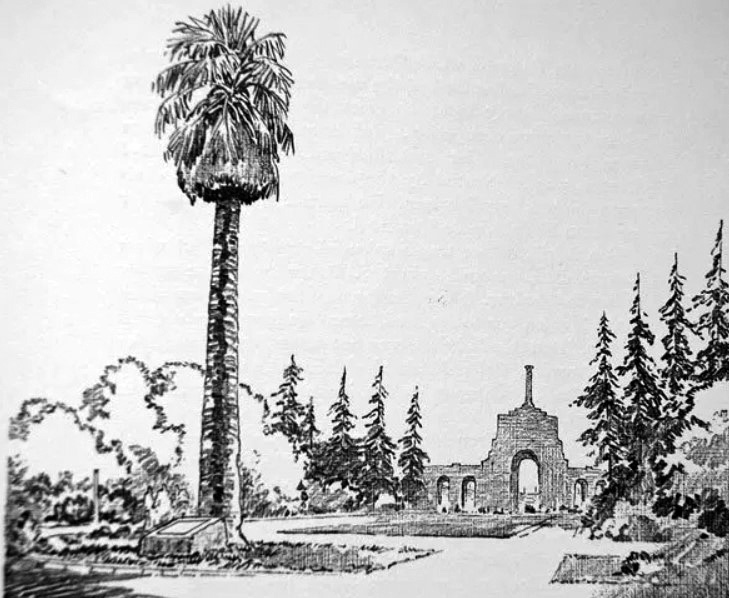 |
|
| (ca. 1938)* - Sketch of the Arcade Depot Palm with the Los Angeles Memorial Coliseum in the background. Note the plaque in front of the palm tree. Sketch by Charles Owens |
Historical Notes On September 5, 1914, when the Arcade Depot was replaced by a new station, the palm was transplanted to its current location in Exposition Park. This move coincided with the renaming of Agricultural Park to Exposition Park in 1913. |
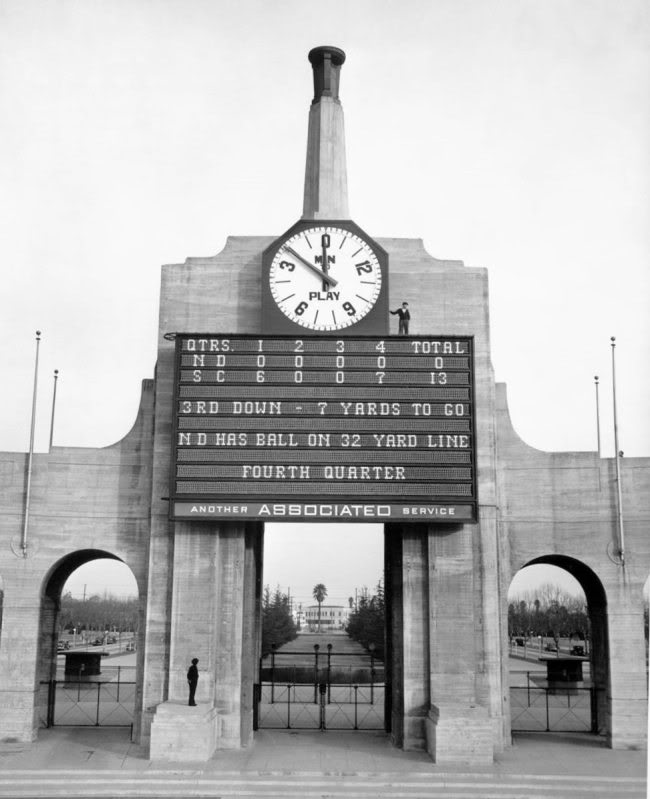 |
|
| (1932)* - View looking east at the LA Coliseum scoreboard during a USC - Nortre Dame game. The Arcade Depot Palm is seen through the arch of the colonnade. |
Historical Notes Final score: USC 13 - Notre Dame 0: USC shut out Notre Dame on its way to a second consecutive consensus national title, matching Notre Dame's feat in 1929 and 1930. From 1928-1932, USC and Notre Dame combined to win the national title five straight years, with USC winning in 1928, 1931 and 1932, and Notre Dame winning in 1929 and 1930. Click HERE to see more in Early Views of USC. |
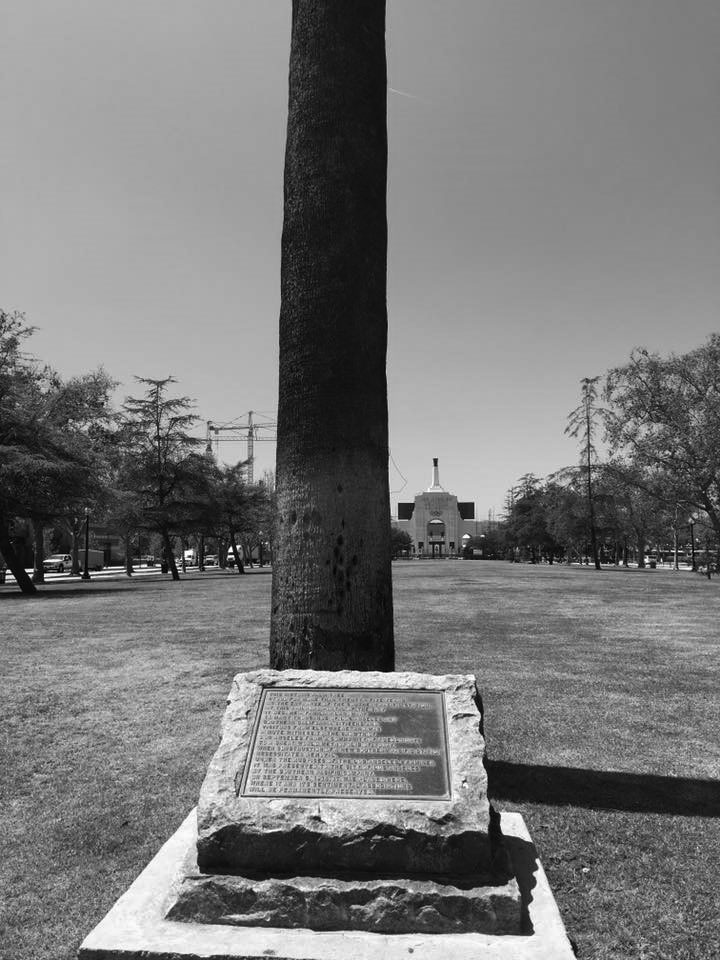 |
|
| (2018)* - View looking west toward the LA Memorial Coliseum in front of the Arcade Depot Palm and commemorative plaque. Photo courtesy of Gary Helsinger. Click HERE for another contemporary view. |
Historical Notes A plaque near the palm commemorates its history, noting its importance as a landmark and its "sentimental associations" with the city's past. |
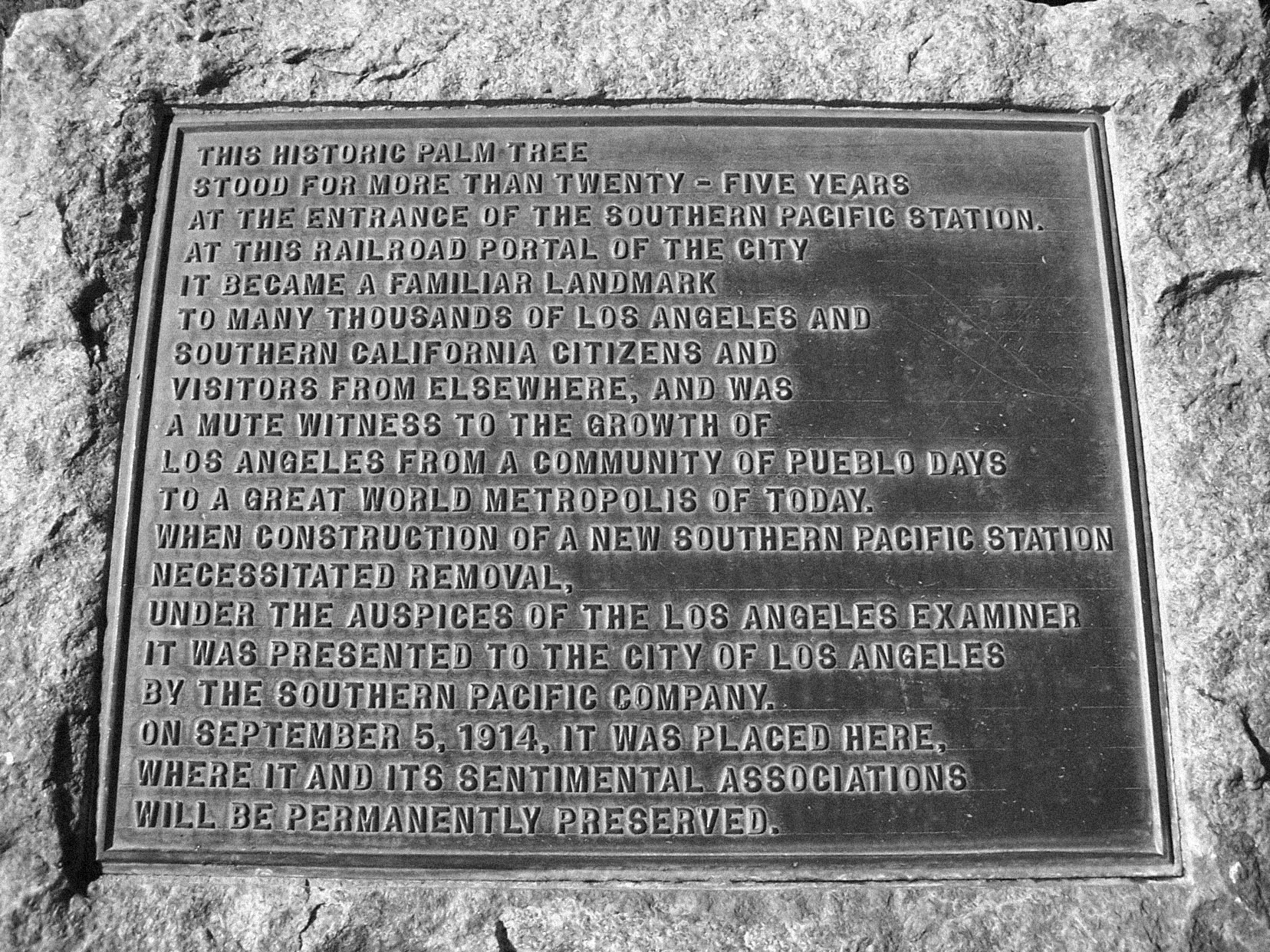 |
|
| (ca. 2010* - Plaque commemorating the Arcade Depot Palm as the "Mute witness to the growth of Los Angeles". Both plaque and Arcade Palm are situated in front of the LA Memorial Coliseum. |
Historical Notes The plaque sits in front of the Exposition Park entrance leading to the coliseum. It reads: “This historic palm tree stood for more than twenty-five years at the entrance of the Southern Pacific Station. At this railroad portal of the City it became a familiar landmark to many thousands of Los Angeles and Southern California citizens and visitors from elsewhere, and was a mute witness to the growth of Los Angeles from a community of Pueblo days to a great world metropolis of today. When construction of a new Southern Pacific Station necessitated removal, under the auspices of the Los Angeles Examiner it was presented to te City of Los Angeles by the Southern Pacific Company. On September 5, 1914, it was placed here, where it and its sentimental associations will be prmanently preserved.” |
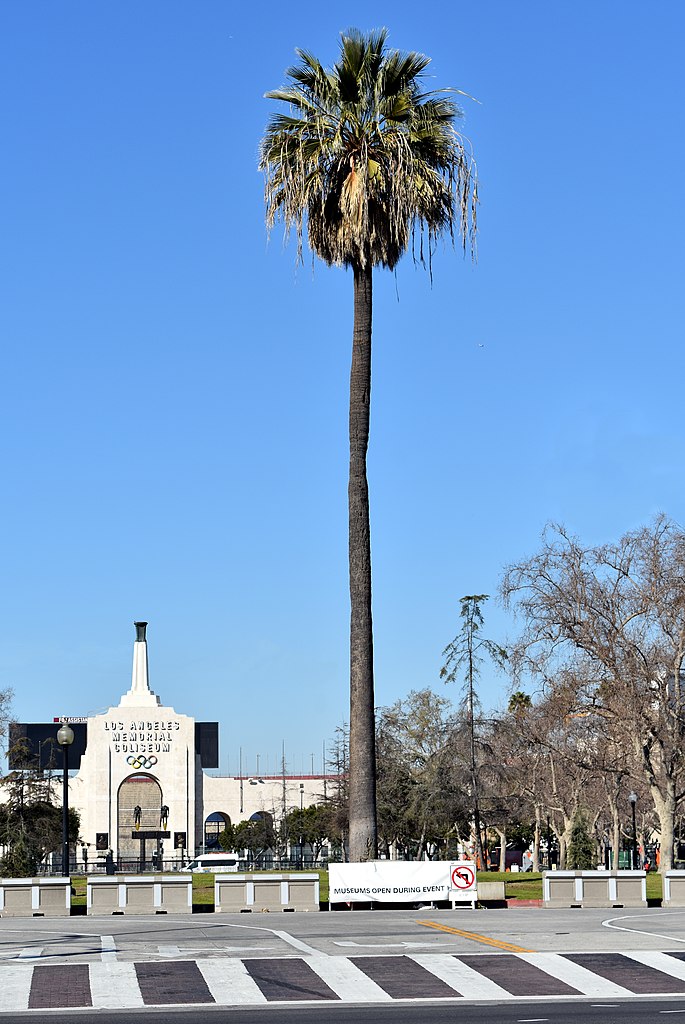 |
|
| (2019)* - Contemporary view of the historic Arcade Depot Palm with the Los Angeles Memorial Coliseum in the background. Photo by Seauton - Wikipedia. |
Historical Notes The Arcade Depot Palm along with the Longstreet Palms are considered to be the oldest trees in the City of Los Angeles. Despite its multiple relocations and the challenges of urban growth, including a noticeable "dent" in its trunk (possibly from the 1947-1950 drought), the palm has flourished over three centuries. |
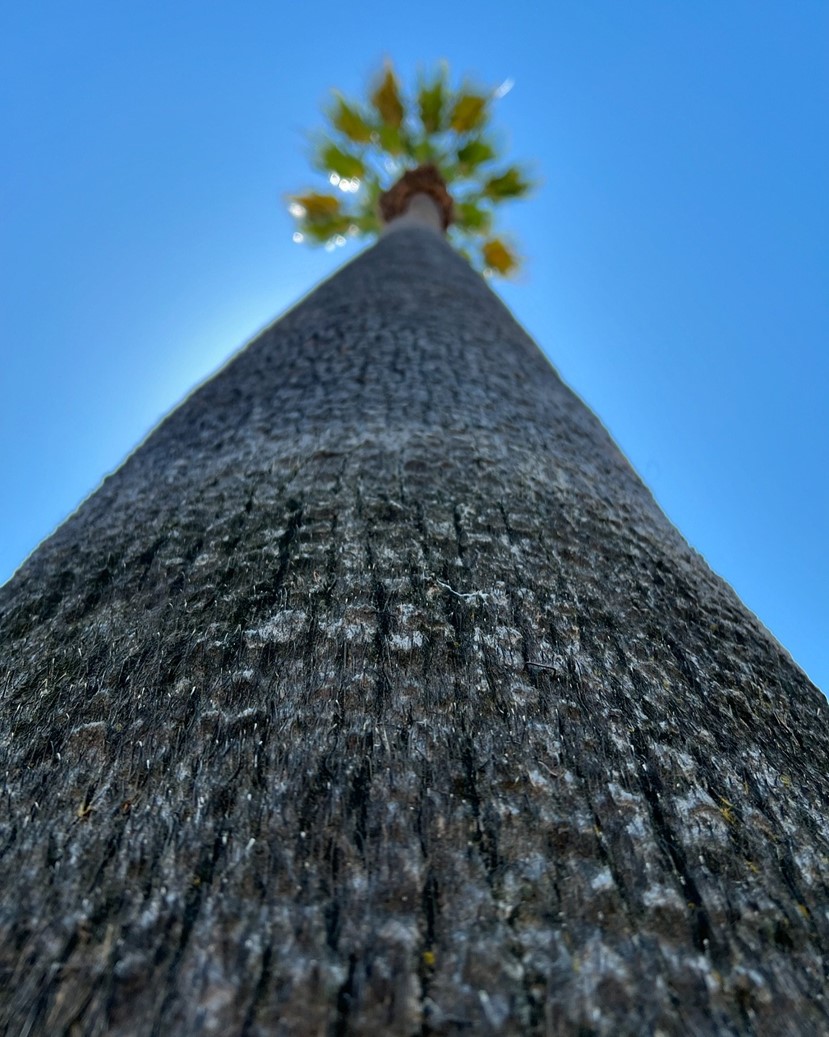 |
|
| (2024)* - Arcade Depot Palm - Photo by Gary Helsinger |
* * * * * |
Banning Residence - Fort Moore Hill
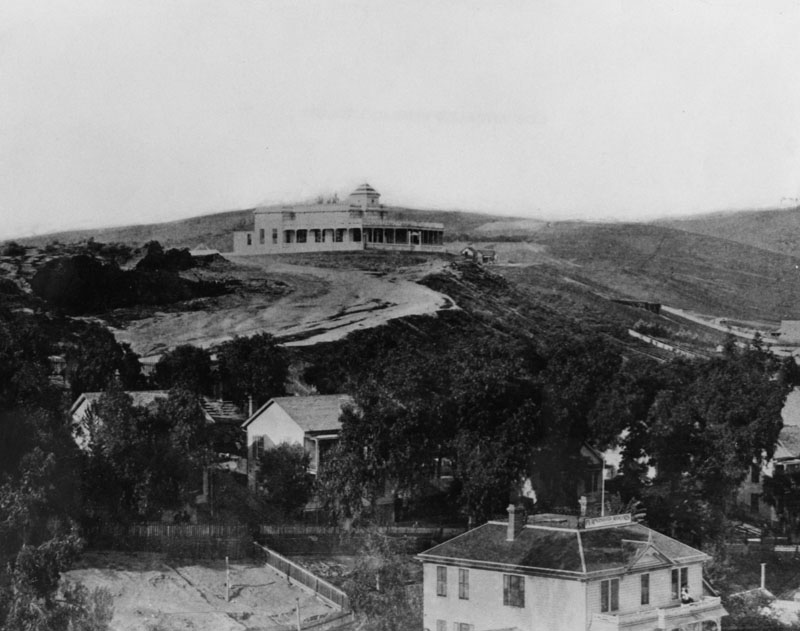 |
|
| (ca. 1887)* - View of Fort Moore Hill, showing the home (upper center) of Mary Hollister Banning, widow of General Phineas Banning. The structure was built by Jacob Philippi as a beer hall, but Banning purchased and transformed it into a home. Part of the trenches of old Fort Moore, built in 1846-1847, are visible in the upper left. |
Historical Notes Fort Moore was an historic U.S. Military Fort during the Mexican–American War. Its approximate location was at what is now the Hollywood Freeway near the intersection of North Hill Street and West Cesar Chavez Avenue, downtown. The building seen above was originally built by Jacob Philippi when he opened shop as a barkeep on Fort Moore Hill in about 1870-75. Being difficult to reach, particularly after a rain, the saloon attracted a rough crowd and after a few years of fist-,gun- and knife fights Philippi called it quits and retreated back down the hill simply boarding it up and leaving. |
.jpg) |
|
| (1888)* - Horses and buggies at the Los Angeles Plaza in 1888. The Banning Residence can be seen in the background on top of Fort Moore Hill overlooking the LA Plaza. The LA Plaza Church is to the left. Click HERE to see more in Early Plaza of L.A |
Historical Notes Following Phineas Banning's death in 1885, his widow, Mary Hollister Banning relocated from Wilmington and chose to purchase and refurbish the structure on top of Fort Moore Hill as a rather unusual home. With two strong-willed daughters in tow, particularly Lucy the younger girl whose life of misbegotten decision-making could fill a book, Mary appreciated the relative isolation as well as the view and frequent breeze the brow of the hill afforded. |
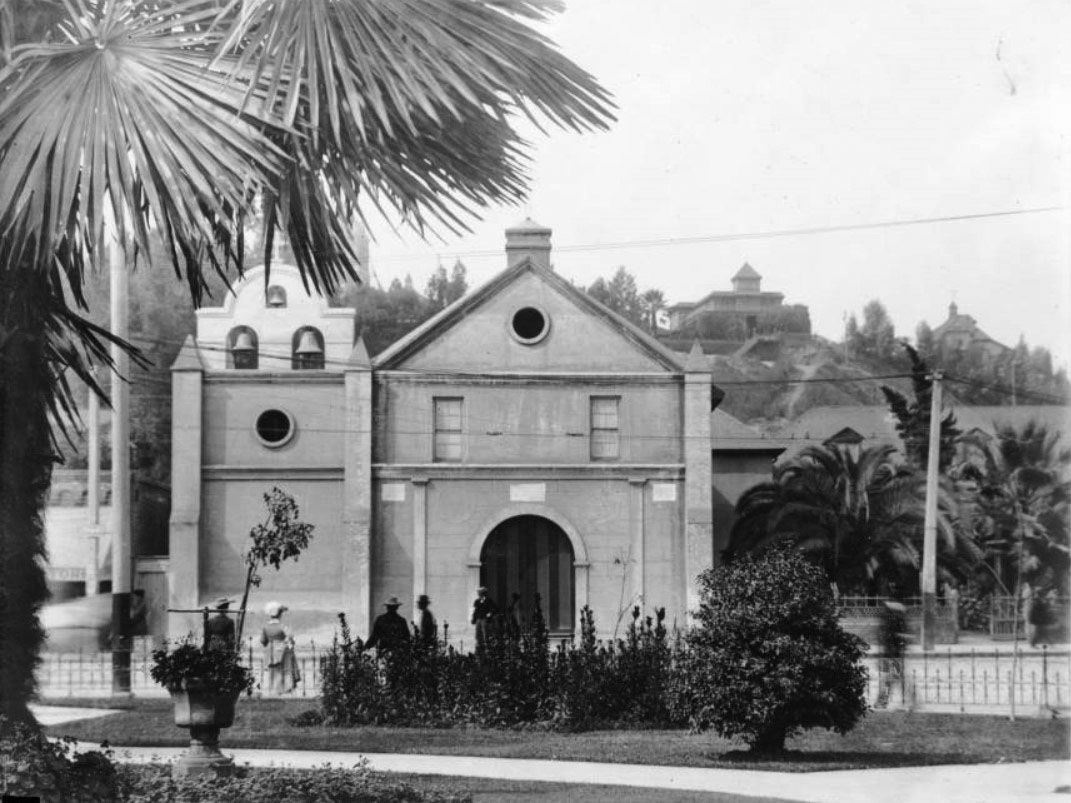 |
|
| (ca. 1915)* - View looking west from the LA Plaza showing the Old Plaza Church with the Banning House in the background on top of Fort Moore Hill. |
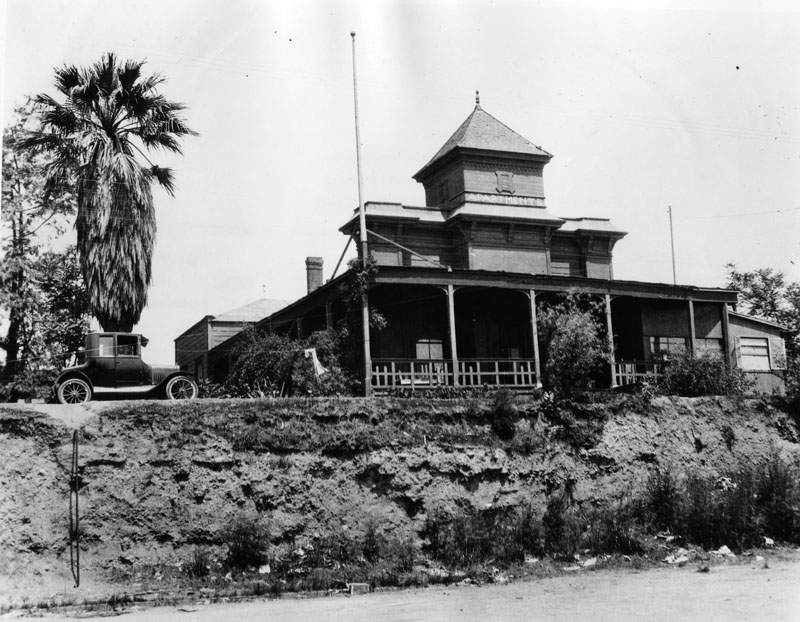 |
|
| (1927)* - View of the old Banning Residence on Fort Moore Hill, seen here as a boarding house. The structure was built by Jacob Philippi as a beer hall, but later Mary Hollister Banning, widow of General Phineas Banning, transformed it into a home. |
Historical Notes At 535 N. Broadway, here, well past its prime, now serving as a boarding house, it overlooked the north portal of the Broadway Tunnel. Interestingly, Mary's step-son Hancock Banning built his own house on Fort Moore Hill at 416 N. Broadway. It overlooked the south portal of the Broadway tunnel. |
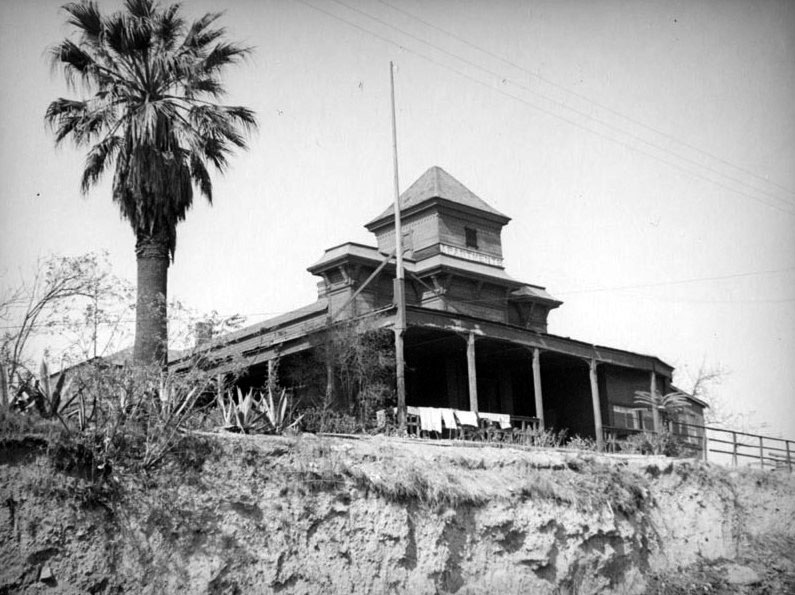 |
|
| (ca. 1937)* – View of the former home of Mary Hollister Banning on Fort Moore Hill. Photo by Herman Schultheis. |
Historical Notes Most of Fort Moore Hill was removed in 1949 for construction of the Hollywood Freeway. The hill was located one block north of Temple Street and a short distance south of present day Cesar Chavez Avenue, between the Los Angeles Civic Center and Chinatown. A small portion of the hill was not bulldozed and remains on the west side of Hill Street on the north side of the freeway where the fort is now memorialized by the Fort Moore Pioneer Memorial. |
* * * * * |
Hancock Banning Home (aka Fort Hill Villa)
.jpg) |
|
| (ca. 1903)* – View looking north from the top of the LA County Courthouse on Temple Street between Broadway and Spring Street showing the south portal of the Broadway Tunnel with tall flagpole on top. Above the tunnel, the first house on the right is the Victorian home of Hancock Banning (also known as Fort Hill Villa) located at 416 N. Broadway. |
Historical Notes Fort Hill Villa, a Victorian house built by Hancock Banning, was located at 416 N. Broadway on Fort Moore Hill in Los Angeles, directly overlooking the south portal of the Broadway Tunnel. This house was distinct from another residence on Fort Moore Hill—the home of Mary Hollister Banning, Hancock's stepmother. Mary Banning had converted a former beer hall, originally built by Jacob Philippi, into her residence after her husband, General Phineas Banning, passed away. Mary's home was located at 535 North Broadway and later served as a boarding house. |
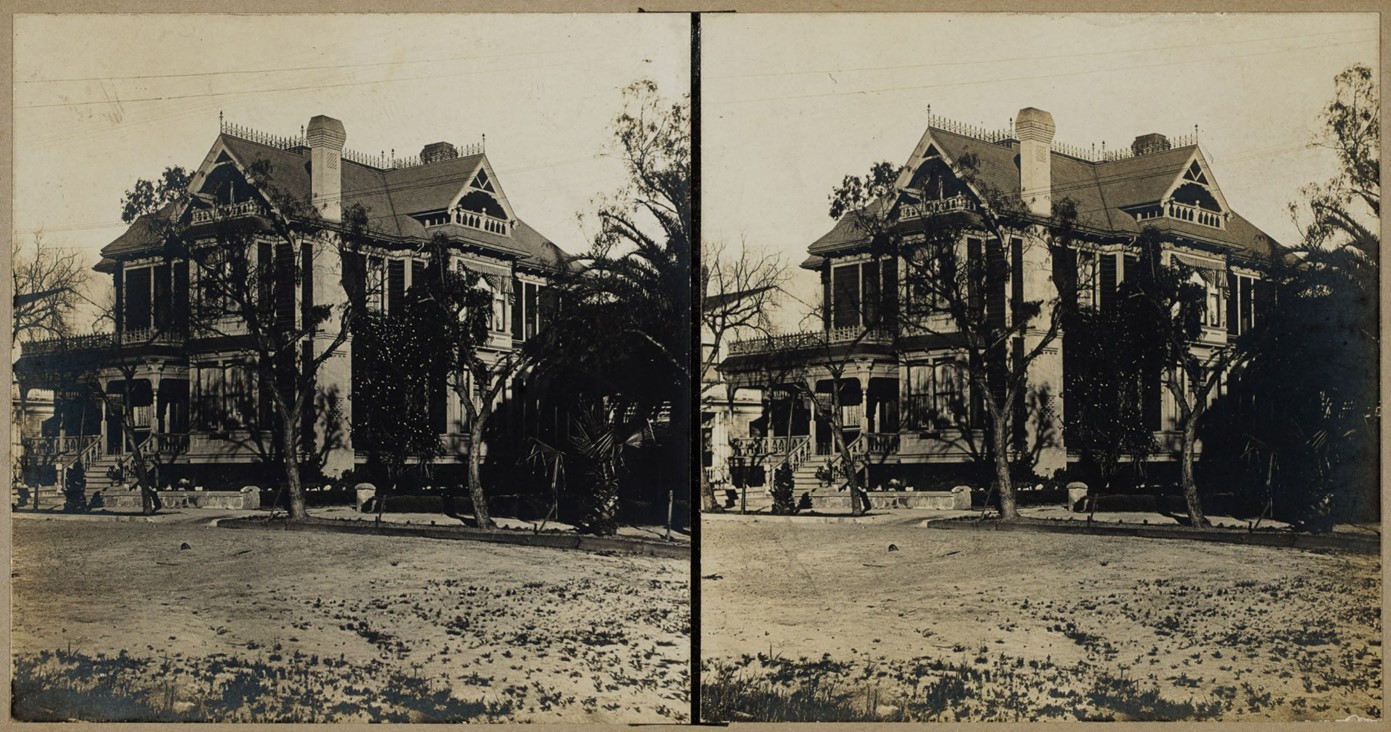 |
|
| (1905)* - Stereoscopic view of the two-story Victorian house of Hancock Banning (also known as Fort Hill Villa) at 416 North Broadway on Fort Moore Hill in downtown Los Angeles. Photo from the Ernest Marquez Collection. |
Historical Notes Fort Moore Hill itself holds significant historical value as it was originally the site of Fort Moore, a U.S. military fort established during the Mexican-American War. The hill provided strategic views over Los Angeles and played a role in the city's early development. Over time, Fort Moore Hill became a residential area, with the Banning family being notable residents. The hill was eventually reduced in size to make way for the Hollywood Freeway in 1949, leaving only a small portion of it intact, which is now commemorated by the Fort Moore Pioneer Memorial. |
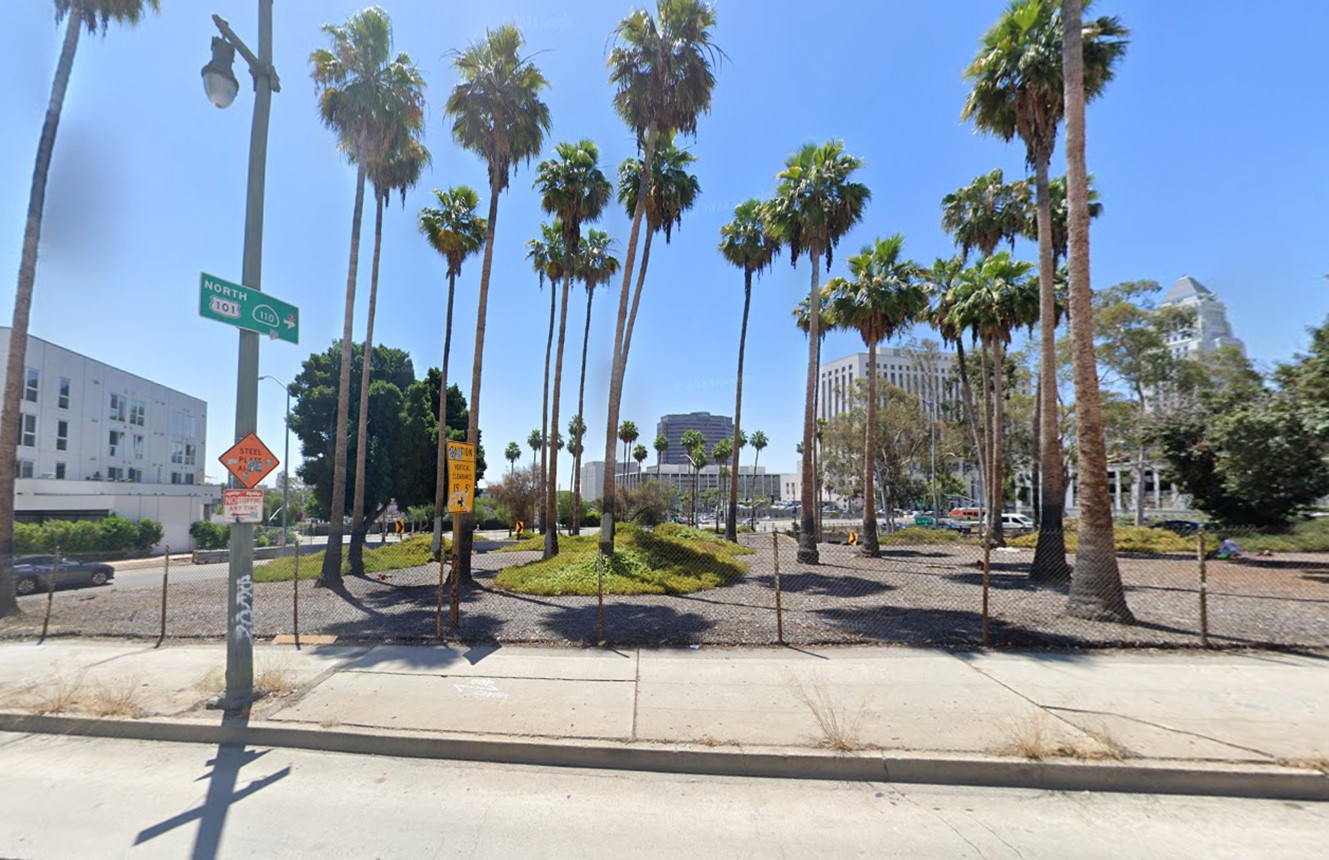 |
|
| (2024)* - Google Street View showing the site where the house of Hancock Banning (Fort Hill Villa) once stood, 416 N. Broadway. |
Historical Notes By the mid-20th century, much of Fort Moore Hill, including these residences, was removed for the construction of the Hollywood Freeway, erasing much of the area's historical landscape. |
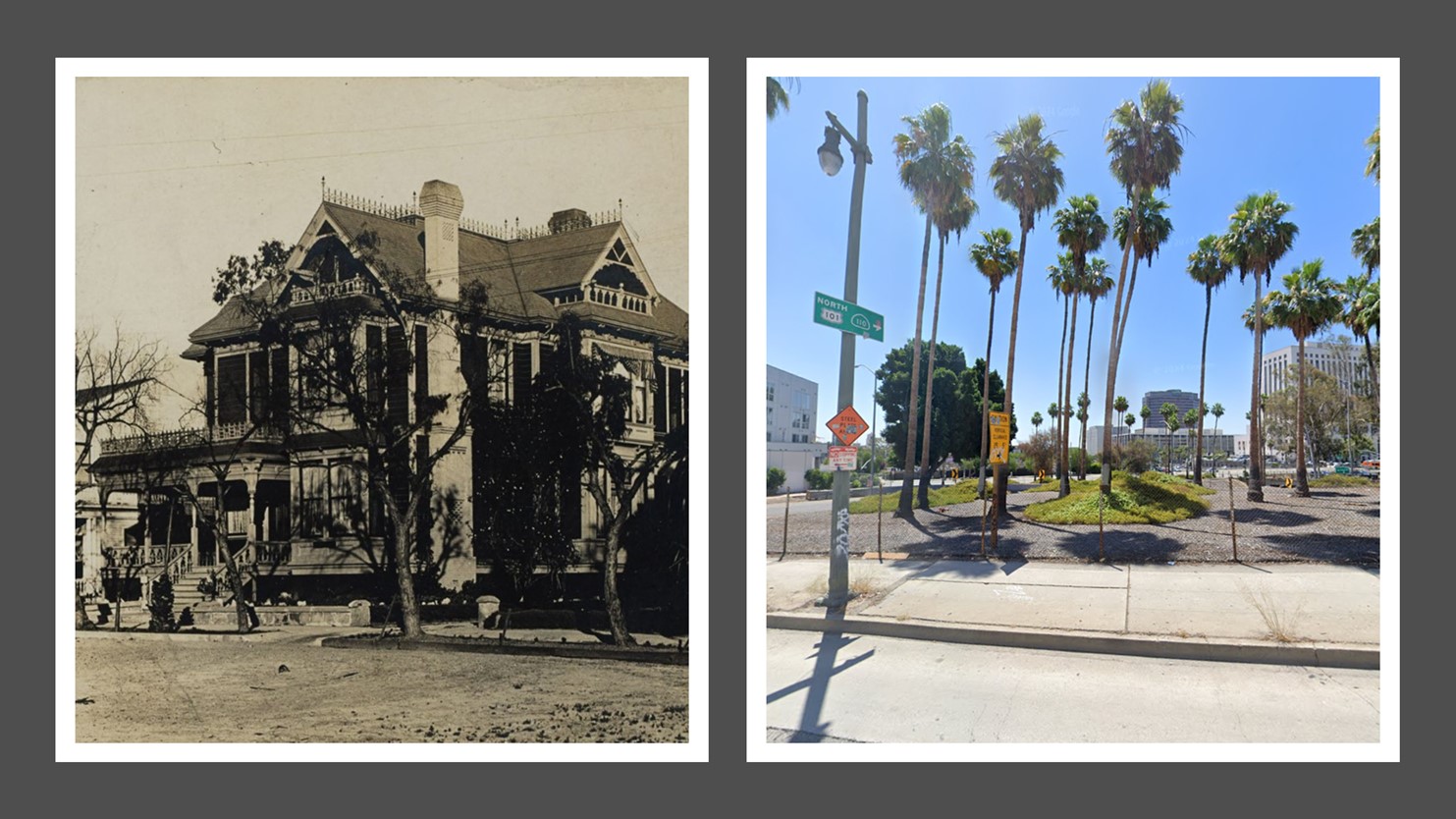 |
|
| (1903 vs 2024)* - The Hancock Banning House (also known as Fort Hill Villa), located at 416 N. Broadway, where today a landscaped plot of land exists adjacent to the on-ramp of the US 101 Freeway. |
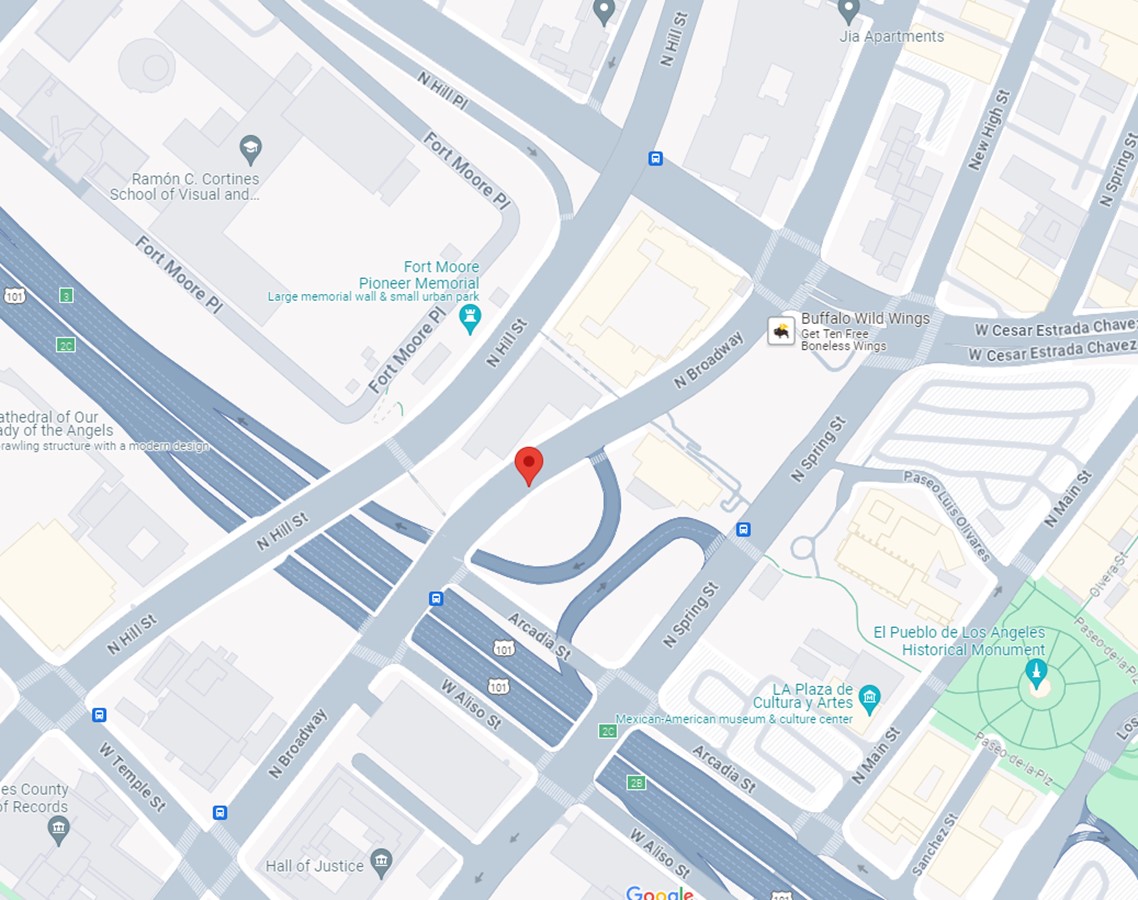 |
|
| (2024)* – Google map showing the location where the old Hancock House (aka Fort Hill Villa) once stood, 416 N. Broadway in downtown Los Angeles. |
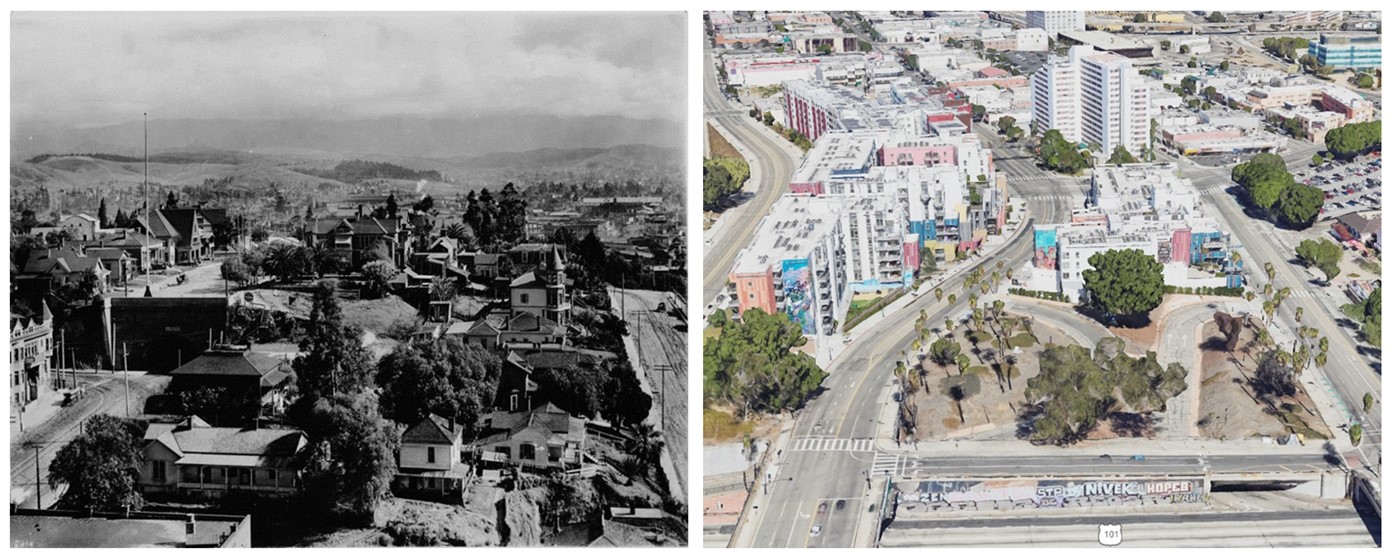 |
|
| (Then and Now)* - Then and Now - Looking north from above Temple Street in downtown Los Angeles, showing the Broadway Tunnel and Fort Hill Villa in 1903 on the left, contrasted with the modern cityscape. By the mid-20th century, much of Fort Moore Hill, including the Broadway Tunnel and Fort Hill Villa, was removed for the construction of the Hollywood Freeway, seen at the bottom of the contemporary photo, running under the Broadway and Spring Street overpasses. This development erased much of the area's historical landscape. |
* * * * * |
Los Feliz School (Cahuenga Valley - later Hollywood)
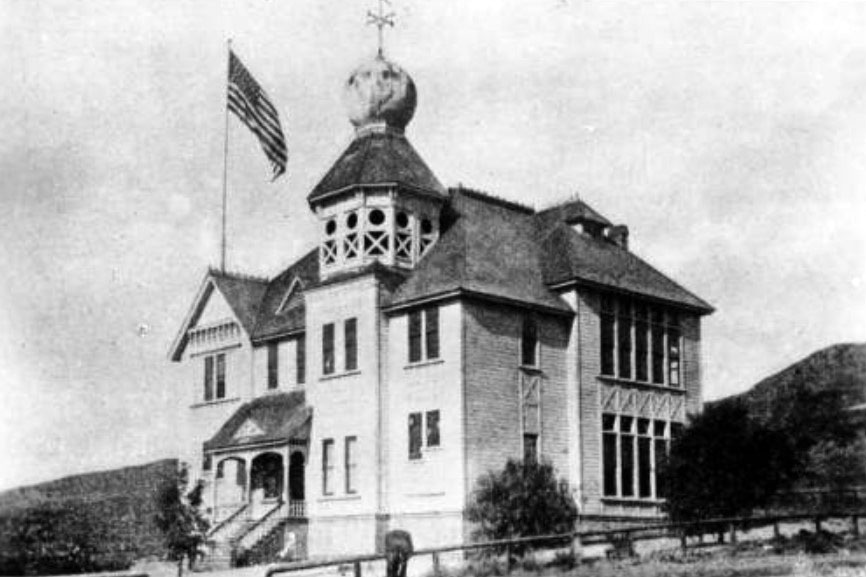 |
|
| (ca. 1887)^^* - Head of Vermont Avenue - Photograph of an exterior view of the old Los Feliz school in Cahuenga Valley, later Hollywood. The building is a two-story wood building with a large tower at center. The top level of the tower is an open deck, and the roof of the tower is onion-shaped. A tall flagpole stands on the roof at left and a large flag flies from it. The main entrance to the school is at left and consists of a stairway leading up to a covered porch. The windows of the school are tall and rectangular, and they are very close together at right. There is a hill in the background, and a low wooden fence is in the foreground. |
* * * * * |
Maclay School of Theology
 |
|
| (ca. 1887)* - Exterior view of Maclay School of Theology, a Methodist seminary founded by Charles Maclay, a Methodist minister, in 1885 in San Fernando. |
Historical Notes In 1874, Charles Maclay bought 56,000 acres of the Rancho Ex-Mission San Fernando land grant including the northern half of the San Fernando Valley. In 1882, cousins George K. Porter and Benjamin F. Porter, owner of future Porter Ranch, each received one-third of the total land. In 1885, Maclay founded the Maclay School of Theology, a Methodist seminary in his newly founded town of San Fernando, California. After his death it became an affiliate and moved to the campus of the University of Southern California before becoming the Claremont School of Theology in 1957.^* Click HERE to see Early Views of the San Fernando Valley or HERE to see Early Views of U.S.C. |
* * * * * |
St. Vincent's College (2nd location)
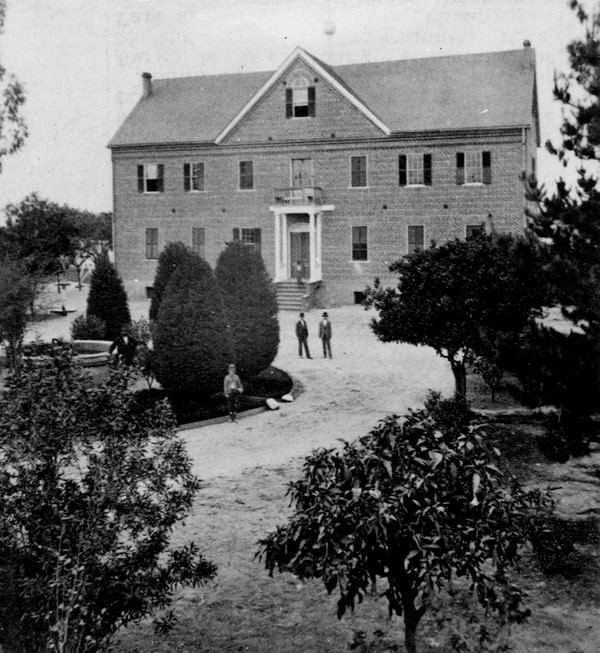 |
|
| (1866)* - View of St. Vincent's College at its second location. This would evolve to become today's Loyola Marymount University (LMU). |
Historical Notes This was St. Vincent's College second location. It first started across from the LA Plaza in a building donated by Vincent Lugo. Click HERE to see St. Vincent's College original location (Vincent Lugo Adobe). |
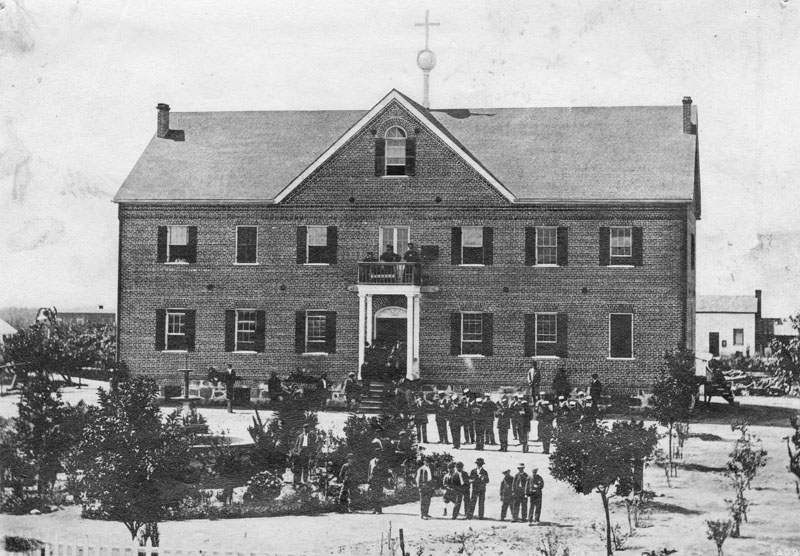 |
|
| (ca. 1868)* - View of St. Vincent's College, located at Hill and Broadway, between 6th and 7th streets. Numerous students, including what appears to be a band, can be seen on the grounds, which are landscaped with several trees. |
Historical Notes In 1865, the Vincentian Fathers were commissioned to found St. Vincent's College for boys in Los Angeles, and appointed John Asmuth, C.M. as its first President Rector. The college was originally located in the Lugo Adobe House at the southeast corner of Alameda and Los Angeles streets. The building was one of the few two-story complexes in the city at that time and had been donated by Vicente Lugo. Although the building no longer stands, its original site was across Alameda Street from the current Union Station on the Plaza near the southeast end of the city's historic Olvera Street. After two years, the school moved several blocks over. The campus encompassed Broadway, 6th, Hill, and 7th streets, the entire block being used for athletic fields, etc.* |
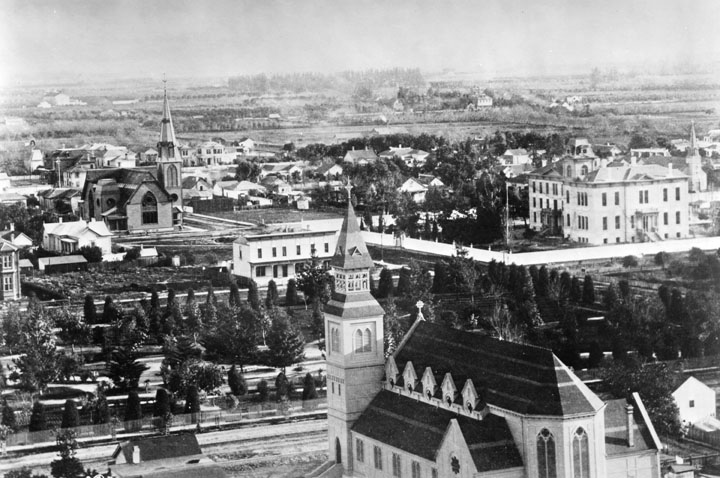 |
|
| (ca. 1884)^ - Panoramic view of St. Vincent Park (later Pershing Square) and surrounding area looking southeast. In the foreground is St. Paul's Pro-Cathedral. St. Vincent's College is seen in the upper-right. |
Historical Notes In 1867, St. Vincent's College, present day Loyola Marymount University, was located across the street, and the park informally became called St. Vincent's Park. In 1870, it was officially renamed Los Angeles Park. In 1886 it was renamed 6th Street Park, and redesigned with an "official park plan" by Frederick Eaton, later the mayor. In the early 1890s it was renamed Central Park, which it was called for decades until after World War I when it was finally named Pershing Square.^* |
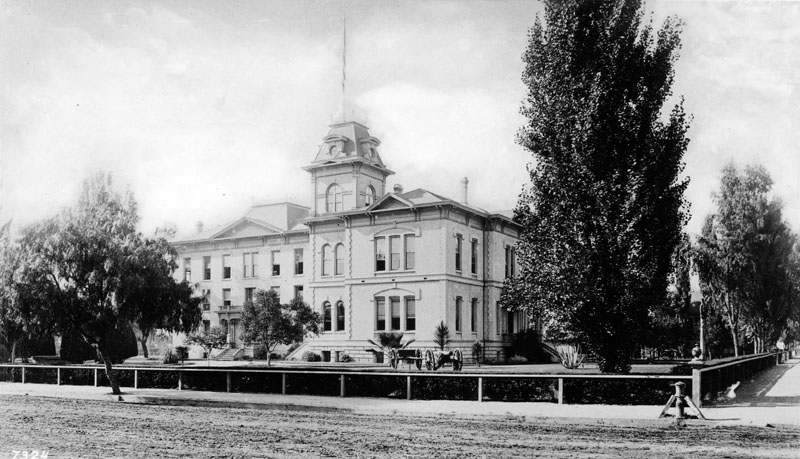 |
|
| (ca. 1887)* - View of St. Vincent's College located at Hill and Broadway, between 6th and 7th streets, showing dirt road in front of the campus. |
Historical Notes St. Vincent's College, which covered an entire block, was bounded by 6th, 7th, Fort and Hill streets. A small lane, St. Vincent's Place, ran north into campus from 7th Street.* |
.jpg) |
|
| (ca. 1887)* - View of St. Vincent's College, located at Hill and Broadway, between 6th and 7th streets. It is believed that the left portion of building was erected for St. Vincent's College, and later, was the headquarters to General Miles of the U.S. Military Dept. of Arizona. |
Historical Notes St. Vincent’s Place, the site of Saint Vincent's College from 1868 to 1887 has been designated as California Historical Landmark No. 567. The college, now Loyola University, was the first institution of higher learning in Southern California. Click HERE to see more California Historical Landmarks in LA. |
 |
|
| (1889)* - Southwest headquarters of the United States Army, formly the site of Saint Vincent's College, Sixth Street and Broadway. |
Historical Notes Today, the site is in the heart of Los Angeles's Jewelry District and is known as St. Vincent Court. A decade later, the school moved to a location at Grand Avenue and Washington Boulevard where it remained until being folded into the newly founded Los Angeles College in 1911.^* |
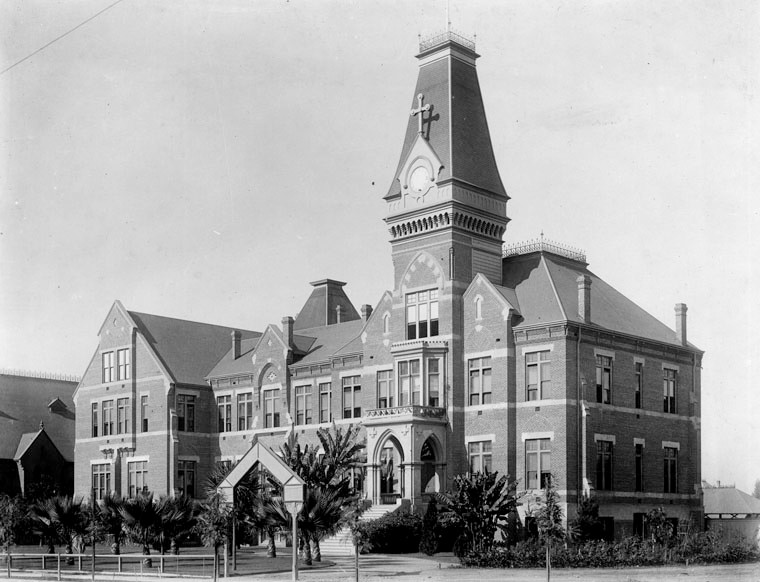 |
|
| (1905)* - Front view of St. Vincent's College (now Loyola Marymount University) on South Grand Avenue, between W. 18th Street and W. Washington Boulevard. This was the third campus location. |
Historical Notes Rapid growth of St. Vincent College enrollment prompted the Jesuits to seek a new campus on Venice Boulevard in 1917. In 1918, the name was changed to Loyola College of Los Angeles. The school relocated once again to the present Westchester campus in 1929, and achieved university status in 1930, becoming Loyola University of Los Angeles. In 1973, Loyola University and Marymount College merged to form Loyola Marymount University (also known as LMU).* |
* * * * * |
Los Angeles Infirmary
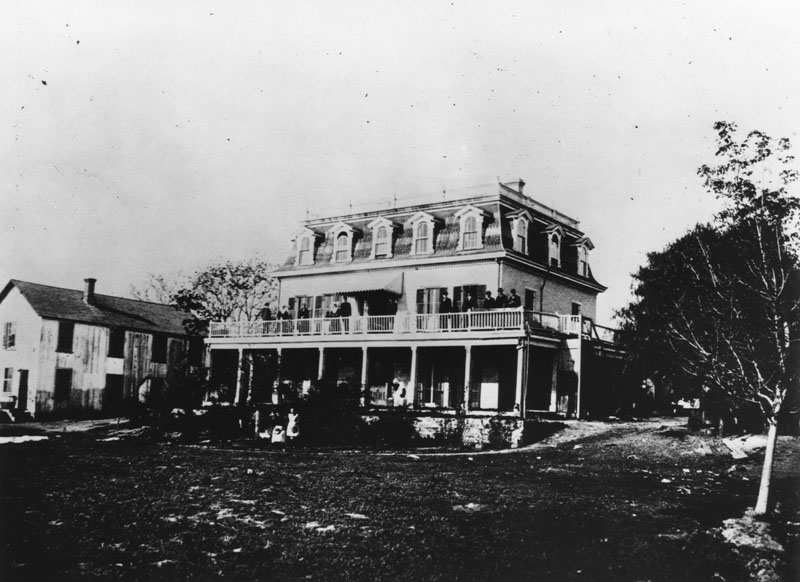 |
|
| (1881)* - Photograph of the Los Angeles Infirmary, as it looked in 1881. This was the second building to house the city's finest hospital, located on Naud Street, opposite the Southern Pacific Railroad Depot. This was a three-story American Mansard-style structure with a wrap-around balcony on the second floor, and numerous windows and doors. Two young girls stand next to a large shrub at the front of the hospital, and several adults stand on the balcony. |
Historical Notes The Daughters of Charity of St. Vincent de Paul established the first hospital in Los Angeles - the Los Angeles Infirmary, in 1856. It was located in the Sonora Town adobe owned by then-Mayor of Los Angeles, Don Cristóbal Aguilar. Four years later, in 1860, the hospital relocated to 1416 Naud Street, between Ann (named for Sister Ann) and Sotillo Street (though other data indicates the location was 1414 Naud Street, between N. Main and San Fernando Road). In 1869, Daughters incorporated the Los Angeles Infirmary under their own ownership, the first women in the region to do so. By 1898, Los Angeles Infirmary had come to be known as Sisters Hospital, but both names were used interchangeably in reference to the same hospital.* |
* * * * * |
St. Vincent's Hospital (aka Sisters Hospital)
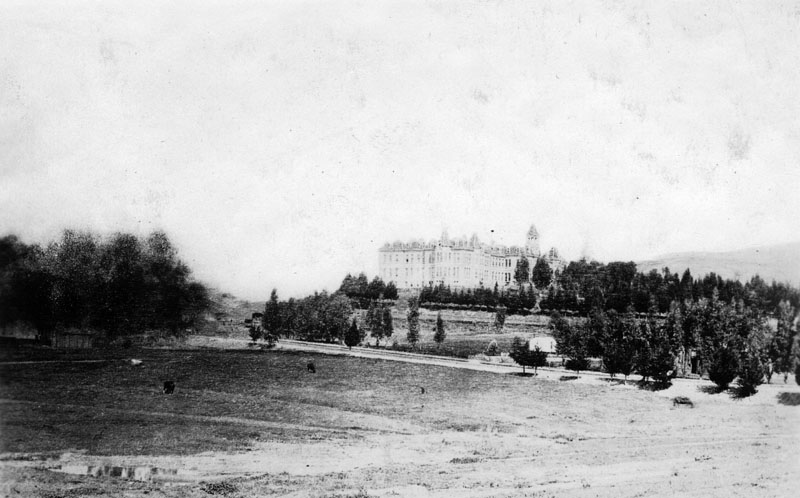 |
|
| ca. 1887)* - View looking northwest showing St. Vincent's Infirmary (aka Sisters Hospital) located near Sunset Blvd and Beaudry Ave as seen from across a sparse field. Several trees can be seen to the right of the grand hospital, which boasts of numerous windows, dormers, an irregular roof, a cupola or tower, and several chimneys. |
Historical Notes In 1883 the Daughters of Charity of St. Vincent de Paul purchased six and a half acres of land at Beaudry Park at a cost of $10,000, and a new hospital building was erected a year later at Beaudry and Sunset, on a hillside overlooking Sonora Town. By 1898, Los Angeles Infirmary had come to be known as Sisters Hospital, but both names were used interchangeably in reference to the same hospital.* |
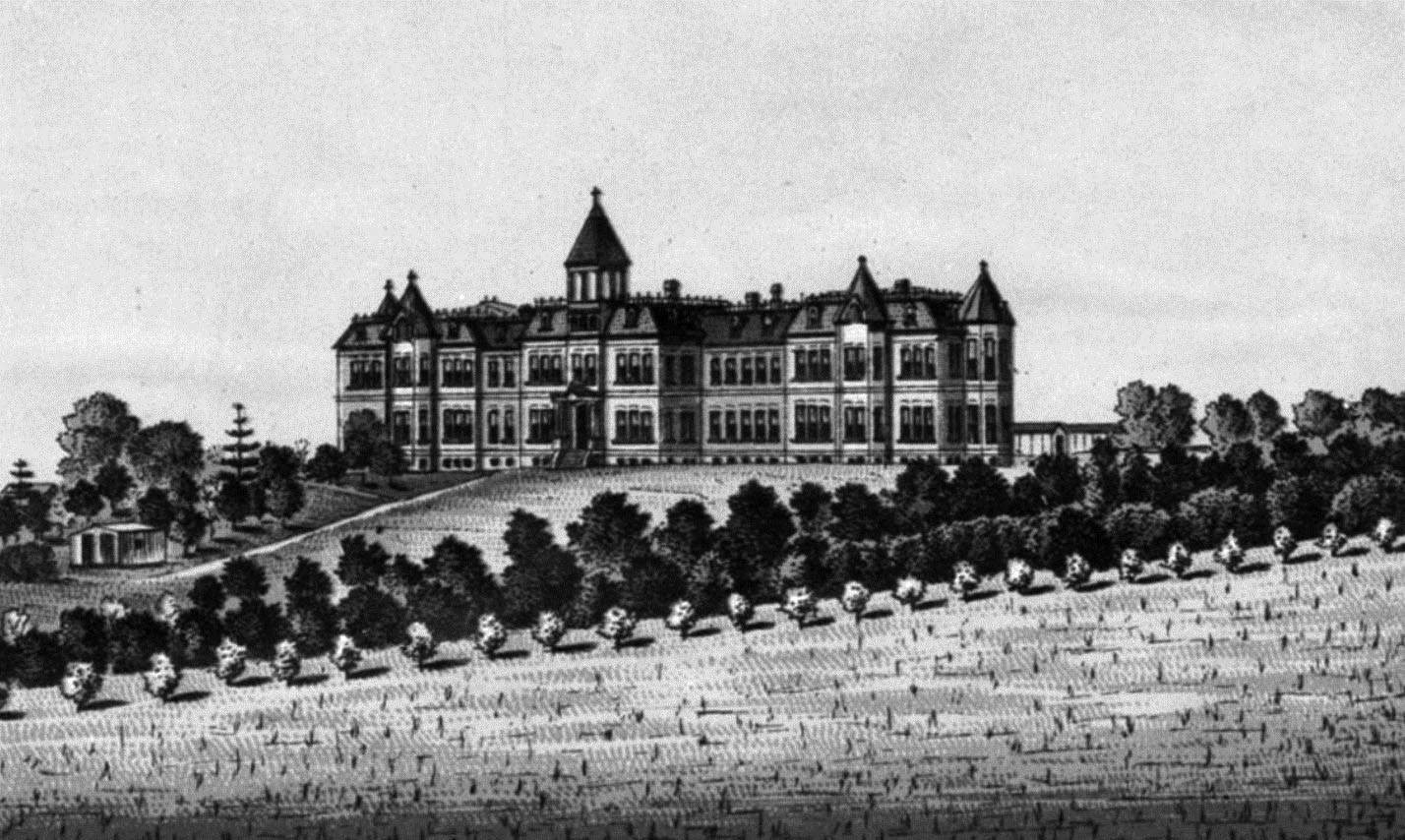 |
|
| (1880s)* - Lithograph sketch showing St. Vincent's Hospital located on a well-landscaped hill that was originally called Beaudry Park. |
Historical Notes Beaudry Park was purchased in 1883 by the Sisters of Charity. On that site (now occupied by The Elysian apartment building and Holy Hill Community Church) the sisters placed their new infirmary, repurposing Beaudry's fruit trees and cypresses into a soothing backdrop for their patients.* |
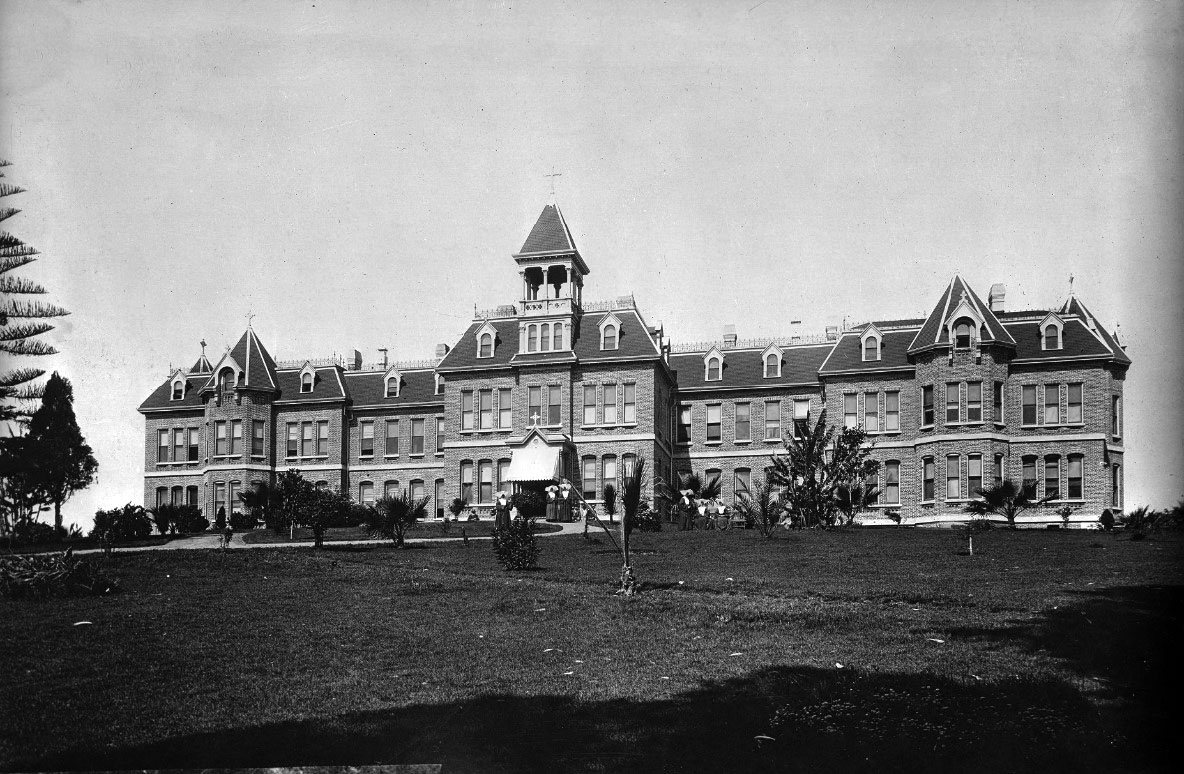 |
|
| (ca. 1887)^^* - Photograph of St. Vincent's Hospital (aka Sisters Hospital) as seen from across the lawn. Several trees, most of them palms, are planted in front of the grand hospital that shows numerous windows, dormers, an irregular roof, a cupola or tower, and several chimneys. Six nuns can be seen walking and/or sitting around the front lawn. |
Historical Notes The Daughters of Charity of St. Vincent de Paul established the first hospital in Los Angeles - the Los Angeles Infirmary, in 1856. It was located in the Sonora Town adobe owned by then-Mayor of Los Angeles, Don Cristo´bal Aguilar. Four years later, in 1860, the hospital relocated to 1416 Naud Street, between Ann (named for Sister Ann) and Sotillo Street (though other data indicates the location was 1414 Naud Street, between N. Main and San Fernando Road). In 1869, Daughters incorporated the Los Angeles Infirmary under their own ownership, the first women in the region to do so. In 1883 they purchased six and a half acres of land at Beaudry Park at a cost of $10,000, and a new hospital building was erected a year later at Beaudry and Sunset, on a hillside overlooking Sonora Town. By 1898, Los Angeles Infirmary had come to be known as Sisters Hospital, but both names were used interchangeably in reference to the same hospital. |
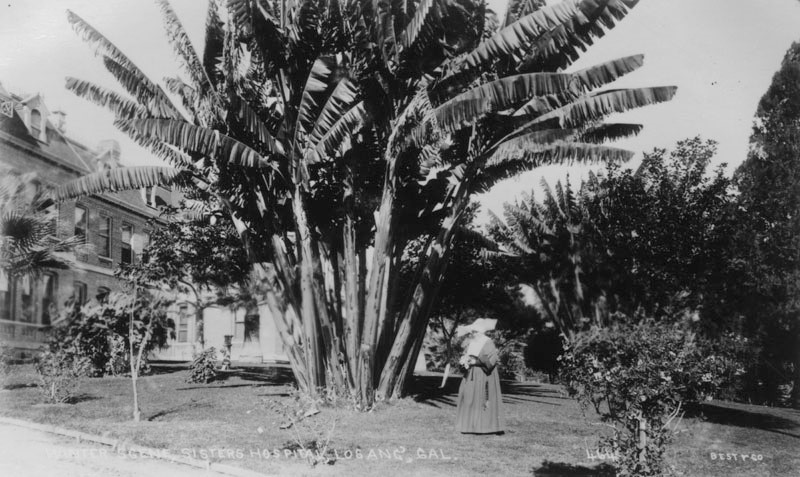 |
|
| (ca. 1890s)* - View of Sisters Hospital (aka St. Vincent's Hospital) as seen from behind a cluster of banana trees located on the grounds; a nun can be seen standing in the foreground. More trees hide the rest of the grand hospital, which boasts of numerous windows, dormers, an irregular roof, a cupola or tower, and several chimneys. |
Historical Notes Sisters Hospital (originally St. Vincent's Infirmary) was built in 1884 on six and half acres of what was then known as Beuadry Park (developed by brothers Prudent and Victor Beaudry in 1876). The area today is called Victor Heights. |
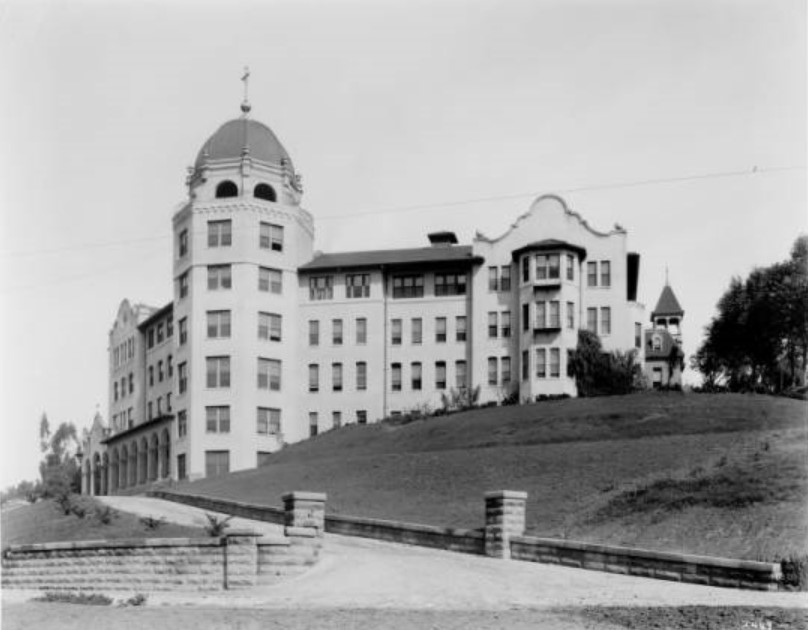 |
|
| (ca. 1910)^^* - View of Sisters Hospital near Sunset and Beaudry. A new seven-story octagonal tower topped with a dome rises on the corner of the four-story Mission-revival building. A cross is on top of the dome. The original building with its unique cupola can be seen at center-right. |
Historical Notes In 1913 the Los Angeles Infirmary became the first hospital in California accredited by the American College of Surgeons. #^#^ |
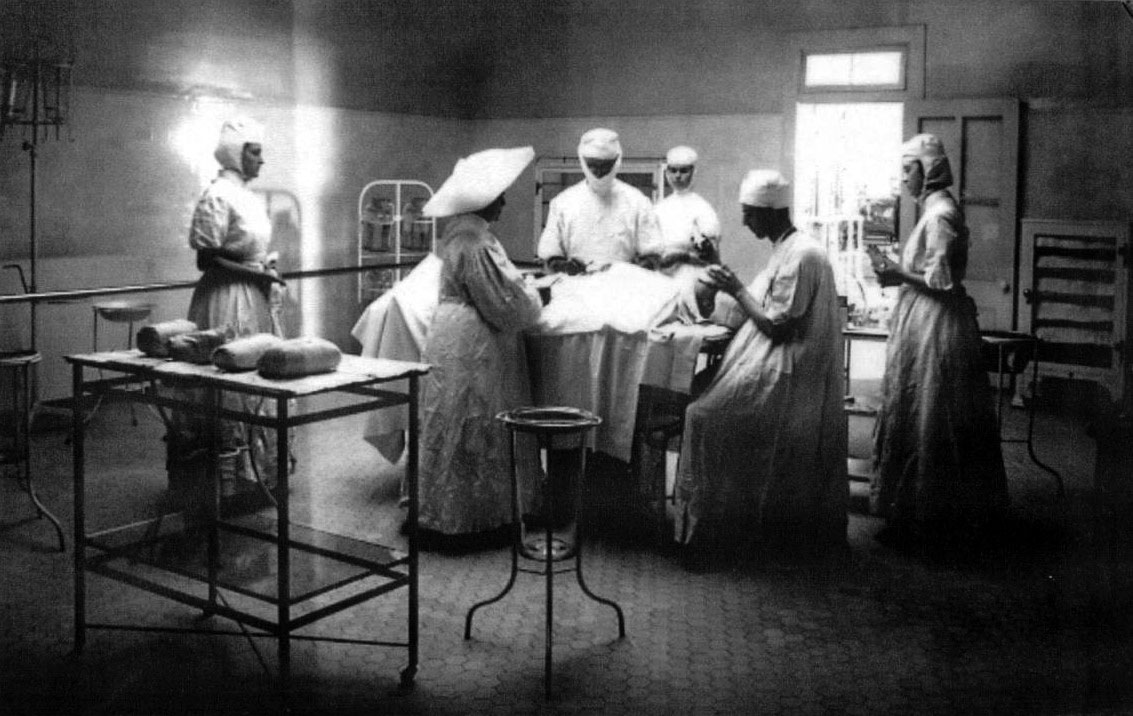 |
|
| (1908)^^* - Interior view of the Los Angeles Infirmary (later, Saint Vincent's Hospital), Sunset and Beaudry. A group of six nurses and doctors surround a patient on an operating table. |
Historical Notes In 1918, the name was officially changed to St. Vincent's Hospital. In 1924 a new building was erected on 3rd and Alvarado, which was built by John C. Austin and Frederick M. Ashley. For 47 years, the hospital had such a steady growth that they were forced to expand yet again, and groundbreaking for a newer, larger building took place in 1971 - this time, located at 2131 W. 3rd Street. With a "new" hospital came a new name, and in 1974, it changed again, this time becoming St. Vincent Medical Center. Click HERE to see more on the new 1924-built St. Vincent Hospital. |
* * * * * |
Los Angeles College for Young Ladies (later Abbotsford Inn)
 |
|
| (ca. 1887)* - View of Los Angeles College, located on the southwest corner of Eighth and Hope streets. Photograph shows a three-story wooden building with jutting towers on each corner, narrow fire-escapes on the second and third floors along the right side of the building, and numerous windows throughout the entire structure. A low fence and hedge surrounds the college. |
Historical Notes Rev. D.W. Hanna, one of the pioneer educators of Los Angeles, opened the Los Angeles College for Young Ladies, better known as Hanna College, on September 2, 1885. At the time, it was the only institution in the city that provided exclusively for the higher education of young women. The school was originally located in a couple of buildings on the corner of Fifth and Olive streets. By 1887, having formed a stock company, Hanna erected a new, larger school structure on the southwest corner of Eighth and Hope streets. With 350 students enrolled at that time, the college prospered and was a popular girls' boarding school, where many of the most exclusive families sent their daughters to be educated. Sadly, Hanna's own daughter died in 1892, and he never fully recovered from the loss; he gave up his teaching work and went into retirement due to poor health, and shortly after, the institution failed. A few years later, Abbot Kinney purchased the still standing building.* |
Abbotsford Inn
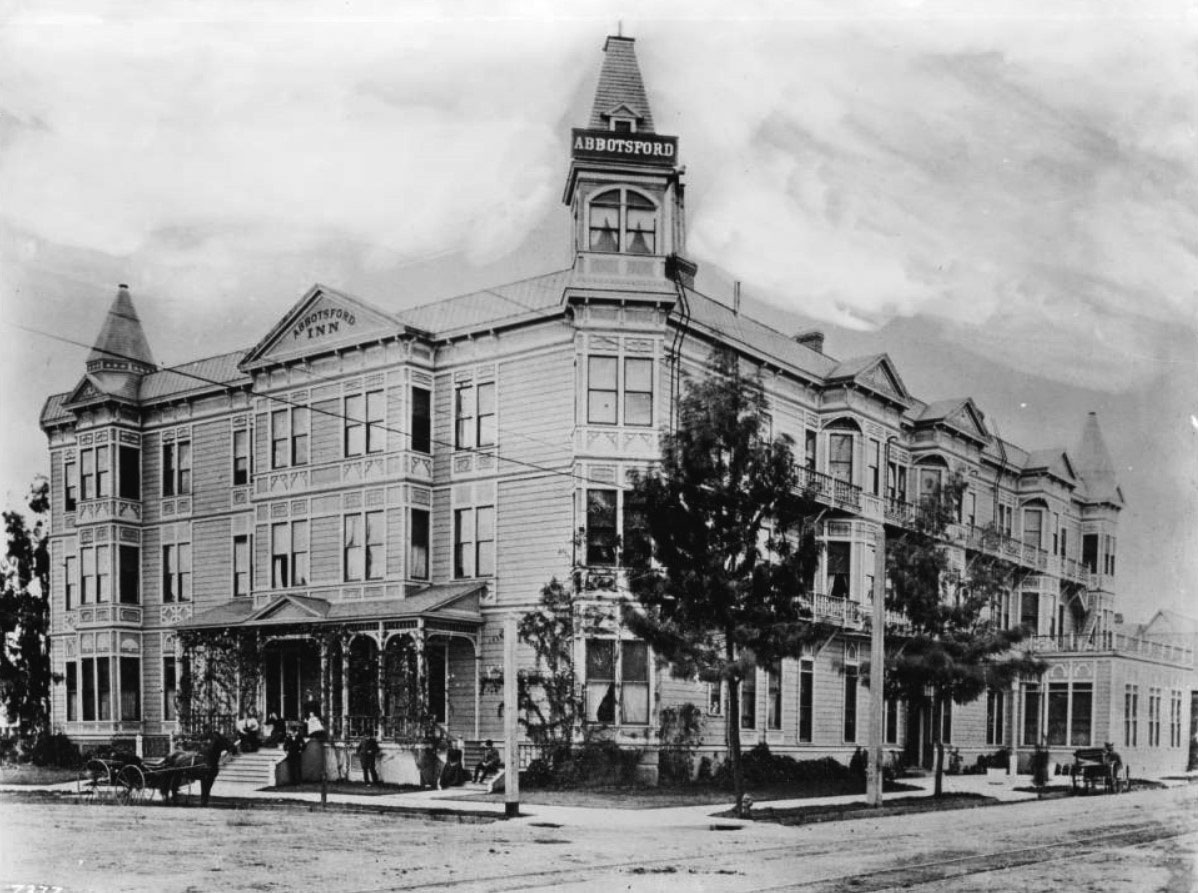 |
|
| (ca. 1903)^^* - View showing the Abbotsford Inn, previously the Los Angeles College for Young Ladies, located on the southwest corner of Eighth Street and South Hope Street. People are posed along the porch to the left of the inn, in front of a horse-drawn carriage parked along the sidewalk. The street shows streetcar rails embedded in it. |
Historical Notes Circa 1900, Abbot Kinney, best known as the developer of Venice, purchased the Los Angeles College for Young Ladies after it failed and operated it as the 100-room Abbotsford Inn. In 1914, First Methodist Church purchased the property; in 1921 the structure was demolished to make way for a new church building.* |
* * * * * |
Los Angeles National Bank Building
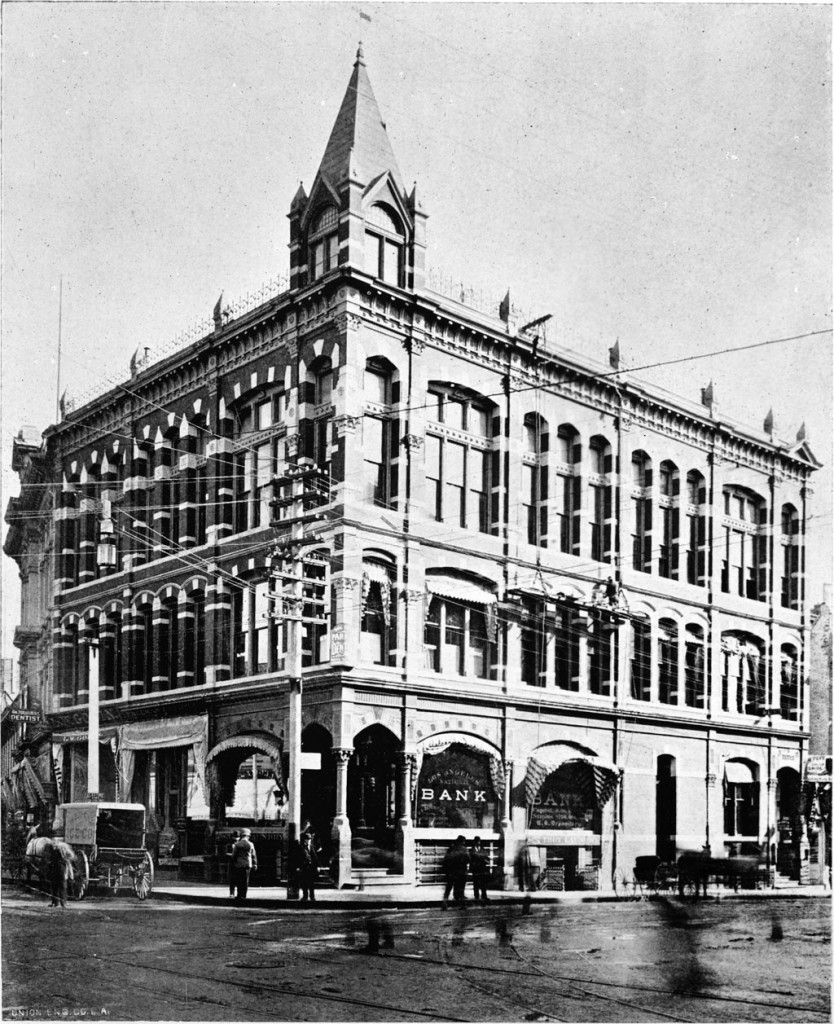 |
|
| (ca. 1887)^^* - View of the Los Angeles National Bank building on the northeast corner of 1st and Spring Street where City Hall is today. |
Historical Notes Completed in 1887, the building was designed by Kysor & Morgan in the "Modern Gothic" style, includes a basement and cost $65,000 to build. The building materials were granite, iron and pressed brick. The bank was organized in 1883 and later merged, along with Southwestern National Bank, with First National in 1905.* The Masonic Temple was located upstairs and the Shriners had their first meeting hall here in 1888.^^* |
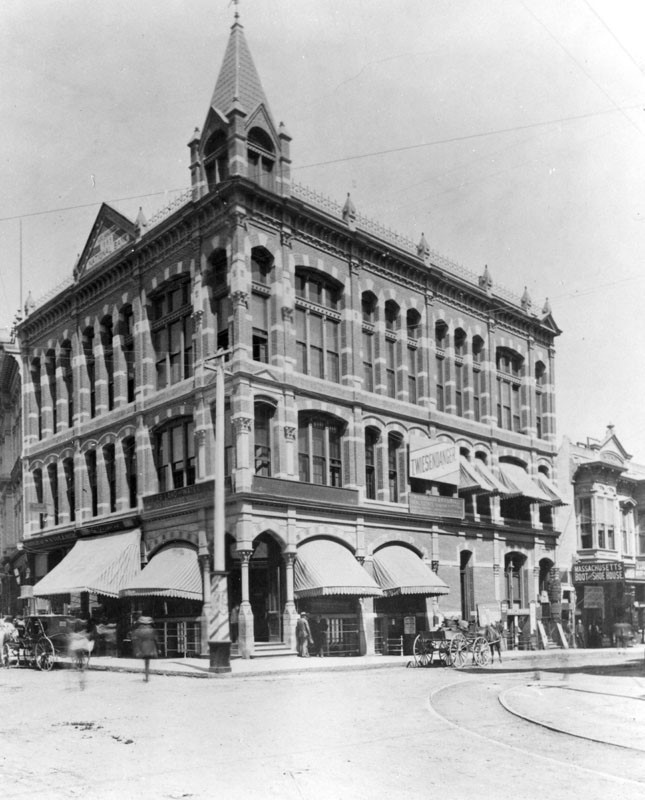 |
|
| (ca. 1890)* - View of the Los Angeles National Bank at the northeast corner of First and Spring streets, in downtown Los Angeles. |
Historical Notes In 1906, the seven-story Equitable Savings Bank replaced the Los Angeles National Bank building on the northeast corner of First and Spring streets.^ |
* * * * * |
Equitable Savings Bank
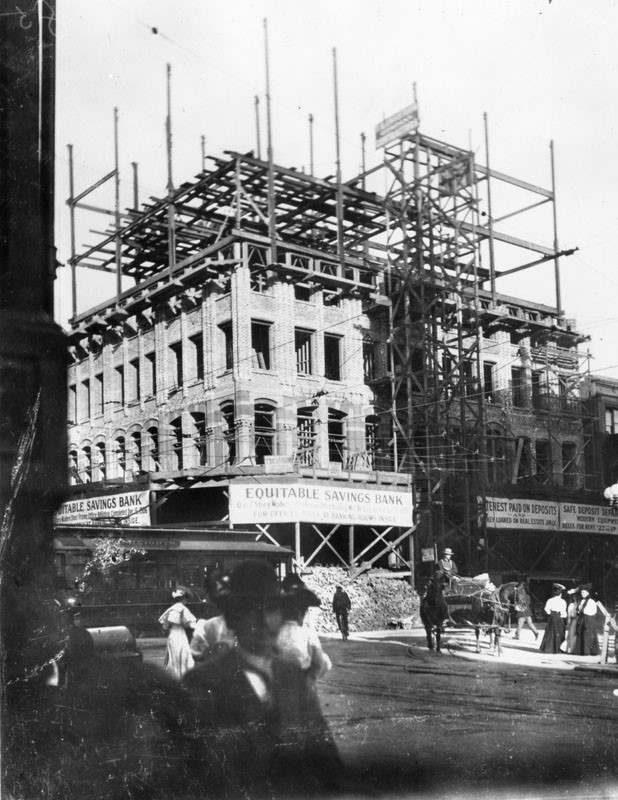 |
|
| (1906)* - View of the construction of Equitable Savings Bank, a seven-story structure that replaced the Los Angeles National Bank building at the northeast corner of 1st and Spring. |
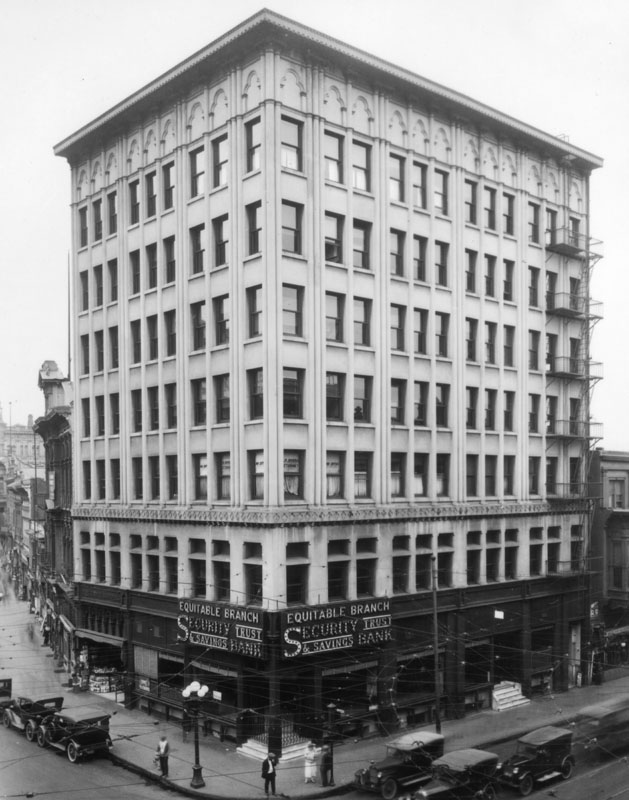 |
|
| (1920)s* - Exterior view of Security Trust and Savings Bank at First and Spring Streets, in the Equitable Building. |
Historical Notes The Equitable Savings Bank Building did not last too long, being demolished in the late 1920s. The site today is the corner of the park next to City Hall.^ |
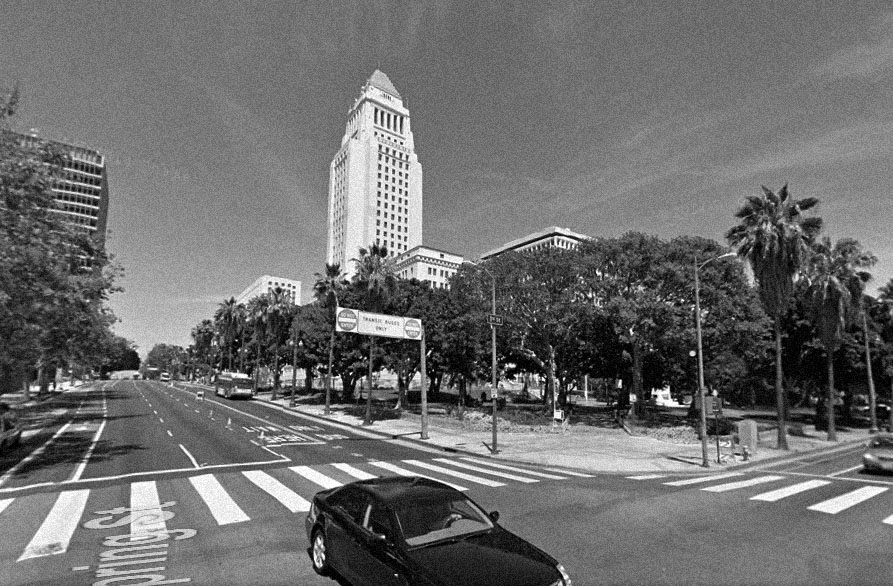 |
|
| (2014)#^** – View looking at the northeast corner of Spring and First Streets where the Equitable Bank Building once stood, now a park next to City Hall. |
* * * * * |
O'Melveny Residence
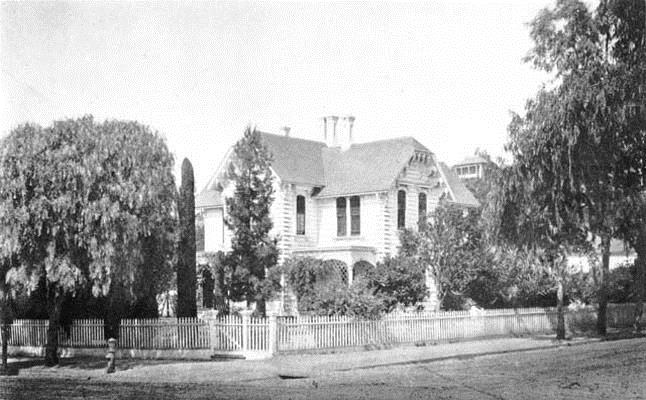 |
|
| (ca. 1880s)* - The southwest corner of Broadway and 2nd St., showing the house built in 1870 for Judge O'Melveny. |
Historical Notes In 1887 the house was moved around to make way for the American National Bank. In 1911 the California Building was erected on the spot.* |
* * * * * |
Brunson Mansion
 |
|
| (ca. 1880s)* - Exterior view of the Brunson Mansion, located at 347 S. Grand Avenue on Bunker Hill. |
Historical Notes The home was built in the early 1880s by Judge Anson Brunson who resided on the bench of the Los Angeles County Superior Court before stepping down to serve as a lawyer for the lucrative Santa Fe Rail Road.* |
 |
|
| (ca. 1880s)* - Front view of the Brunson Mansion on Bunker Hill. Note the man standing on the lawn in front of the house. |
Historical Notes The Brunson Mansion at the corner of Fourth Street and Grand Avenue was an imposing structure that seemed destined to stand indefinitely. Instead it would last less than four decades and become an early victim of the City's obsession with the automobile. According to the L.A. Times, the residence was “a dark red house, large, compact, dignified, in the center of sloping lawns walled up above the level of three streets.” The house was so large it had a Bunker Hill Avenue and a Grand Avenue address, before settling on 347 South Grand as its official label.^ |
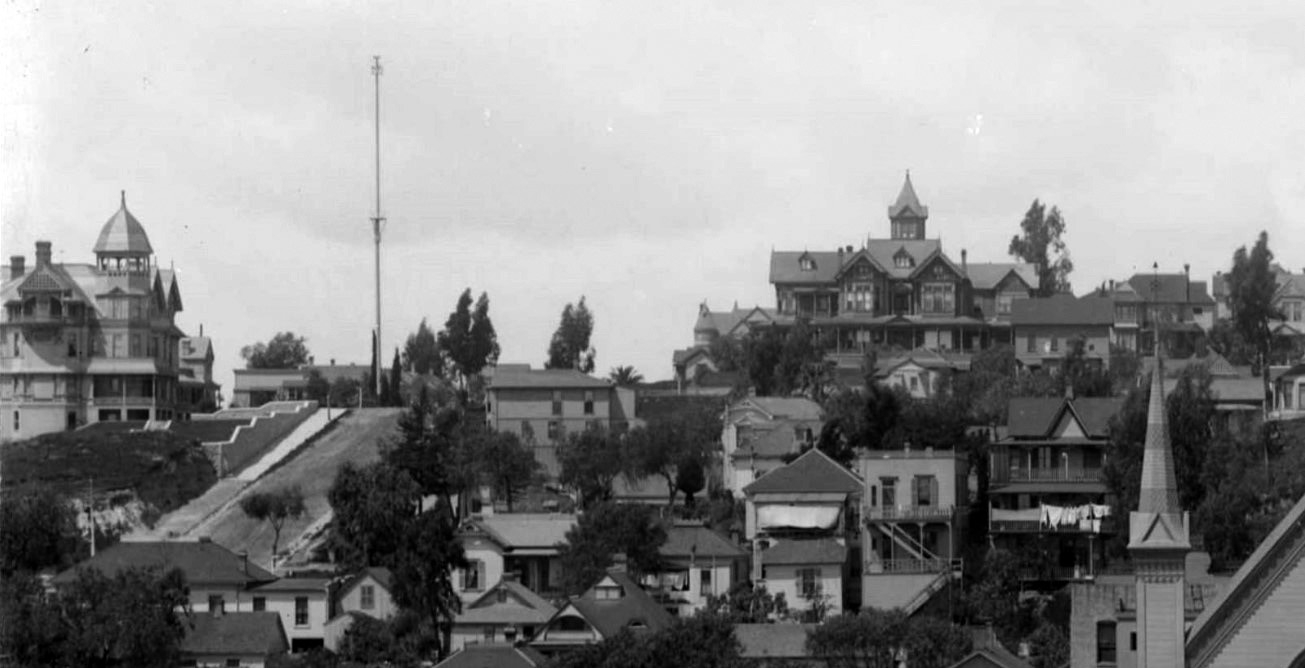 |
|
| (ca. 1890)* – View looking west toward Bunker Hill showing the impressive Brunson Mansion at center-right with the Rose Mansion at far left. Note the 150-ft tall streetlight at center-left. Click HERE to see more Early Views of LA Streetlights. |
Historical Notes At the turn of the century, the 18 room property became the Hotel Brunson and would remain a boarding house for thirteen years. By 1917, the automobile had come to Bunker Hill and the owners of the property at 347 South Grand decided that a two story brick garage would be more lucrative than a hotel. In April of that year, the furnishings of the Brunson Hotel were auctioned off, and the stately structure which was once a “show place of the city” was demolished and replaced by an auto mechanic. |
* * * * * |
Crocker Mansion
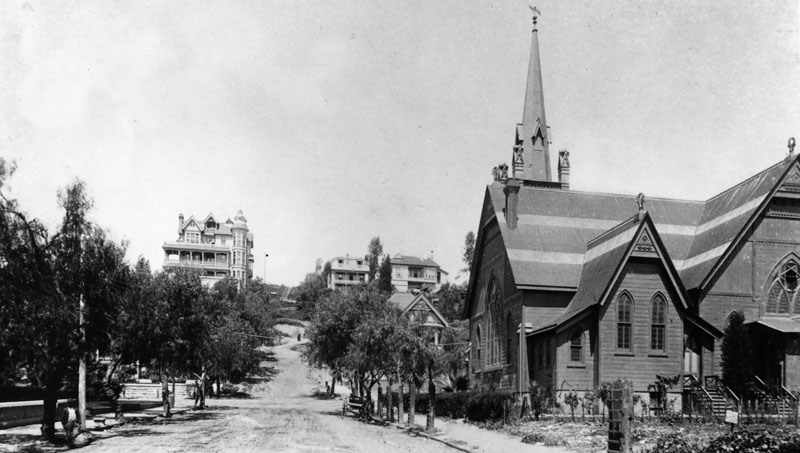 |
|
| (ca. 1885)^ - View of Bunker Hill, looking west from 3rd and Hill streets. On the right is the First Congregational Church, built in 1883. It later became the Central Baptist Church and then the Unitarian Church. The Crocker Mansion is seen in the background. |
Historical Notes At the turn of the 20th Century, no building dominated Bunker Hill like the Crocker Mansion. Perched high at the corner of Third and Olive, the imposing 3-story Victorian structure overlooked the emerging metropolis for more than 22 years. |
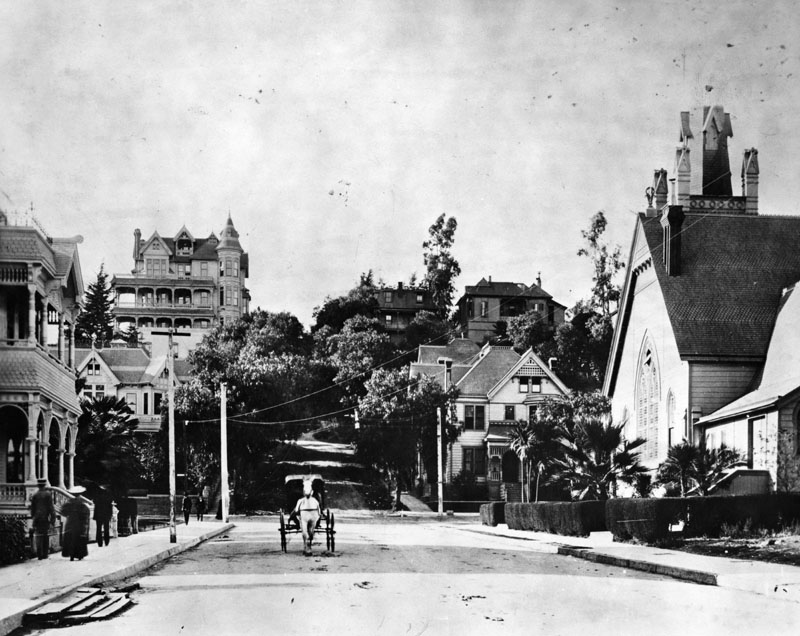 |
|
| (ca. 1885)* - View of Bunker Hill, looking west from 3rd St. and Hill. On the right is a closer look at the First Congregational Church, built in 1883. The Crocker Mansion, located at 3rd and Olive, was later called the Crocker Mansion Rooming House became the site of the Elks Club (later the Moose Lodge). |
Historical Notes By 1901, city and private engineers would come up with two different ways to traverse the steep hill...they built an 1080-foot long tunnel and a 33-percent grade funicular at the intersection seen above. |
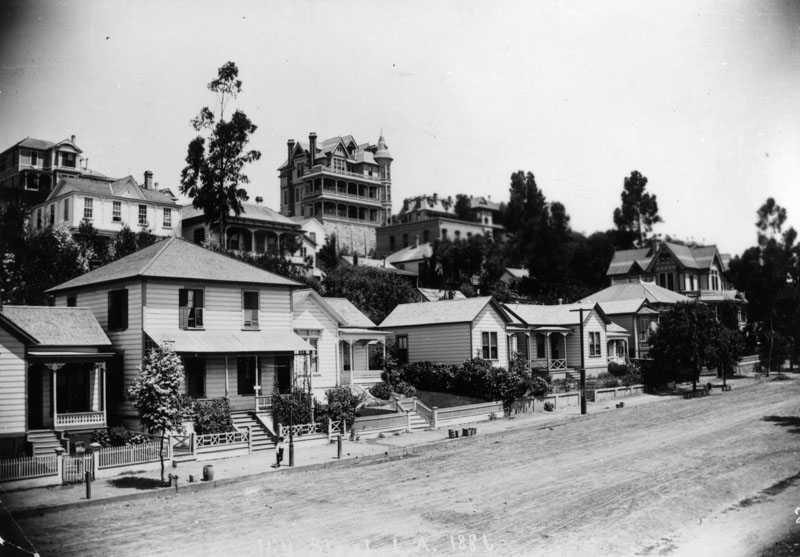 |
|
| (1886)^ - View of Bunker Hill from Hill and 3rd looking northwest. The Crocker Mansion, located at 3rd and Olive, can clearly be seen at the top of the hill. |
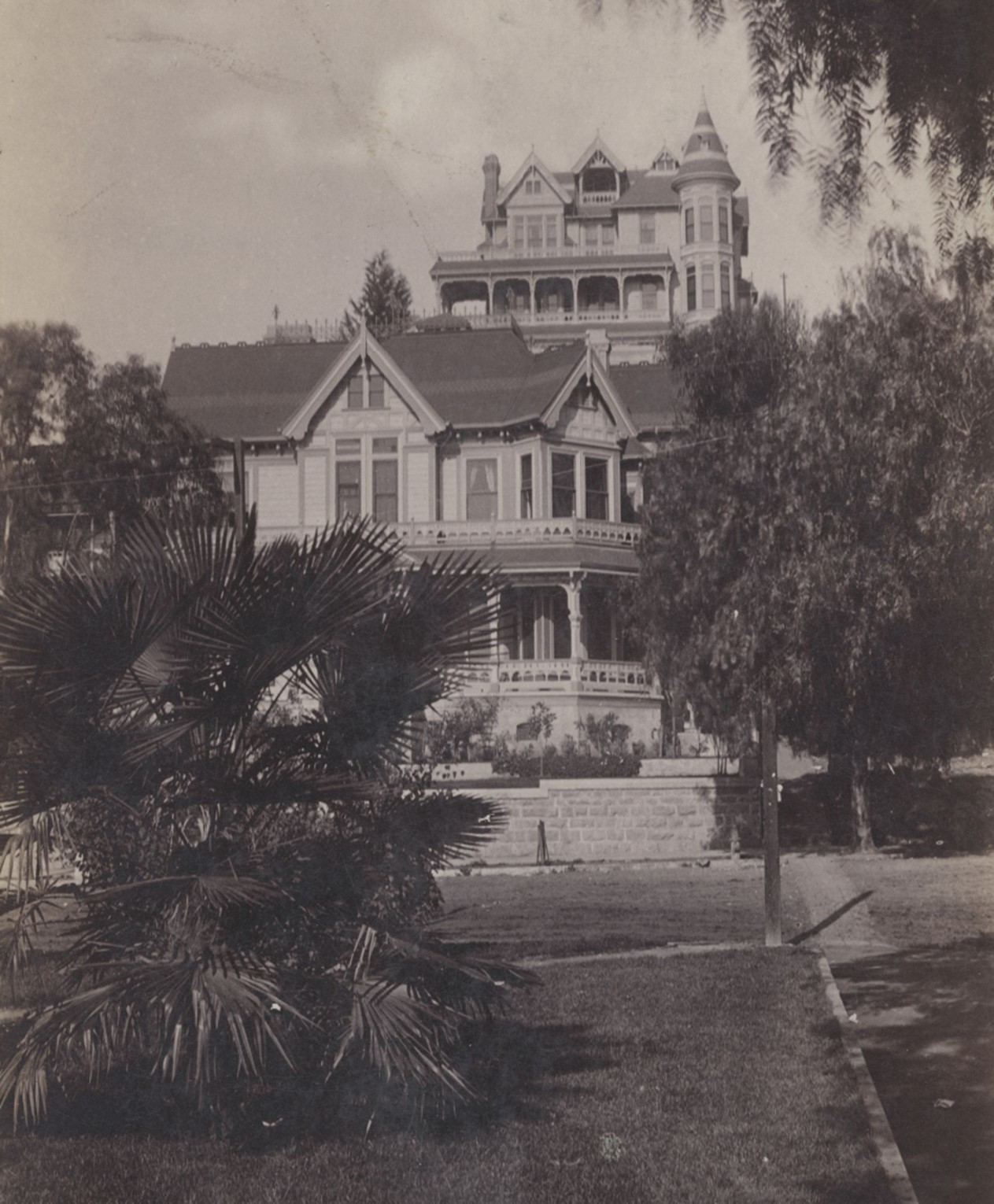 |
|
| (ca. 1990)* - The Crocker Mansion (upper center, 300 South Olive Street, later BPOE Temple), viewed from the corner of Third Street and Hill Street in Bunker Hill. The image showcases the Queen Anne style house on the upper part of the hill, featuring a multi-windowed corner tower, verandas, a balcony set into the roof, and an English chimney. In the foreground, there is a lawn with a Fan Palm tree and an unidentified Victorian house. Photo by C. C. Pierce. |
Historical Notes The Crocker Mansion, located at 300 South Olive Street, was one of the most notable residences in Bunker Hill. Built in 1886 by Margaret E. Crocker, the widow of California Supreme Court Justice Edwin Bryant Crocker, the mansion was an imposing three-story Victorian structure designed by architect John Hall. Margaret Crocker was a prominent social and civic leader, known for her philanthropy, including the donation of the family's art collection to the city of Sacramento. The mansion's history is marked by both grandeur and scandal. In 1887, it became the center of a high-profile kidnapping case when Margaret Crocker's granddaughter, Alma Ashe, was taken by her father, Robert Porter Ashe, amidst a contentious divorce. Despite such dramatic events, the mansion remained a symbol of elite society in Los Angeles. In 1891, the Crocker Mansion was converted into a boarding house, which was still considered more luxurious than the typical rooming houses on Bunker Hill at the time. However, the construction of the Third Street Tunnel in 1900 compromised the mansion's structural integrity, leading to its eventual demolition in 1908 to make way for new development. |
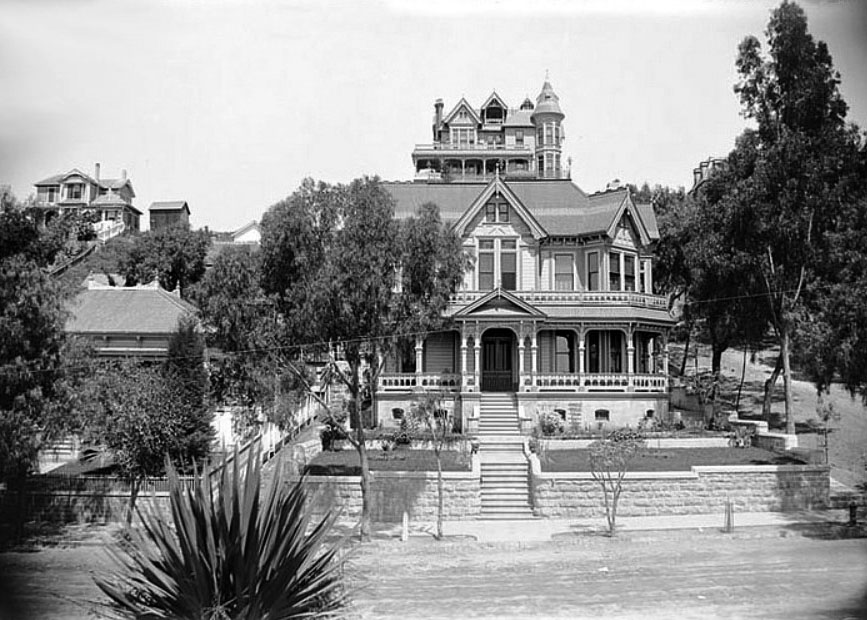 |
|
| (1895)* – View looking west at 3rd and Hill Streets with the Crocker Mansion seen at the top of Bunker Hill. The southwest corner of 3rd and Hill (lower-right) would become the lower station terminal of Angels Flight. |
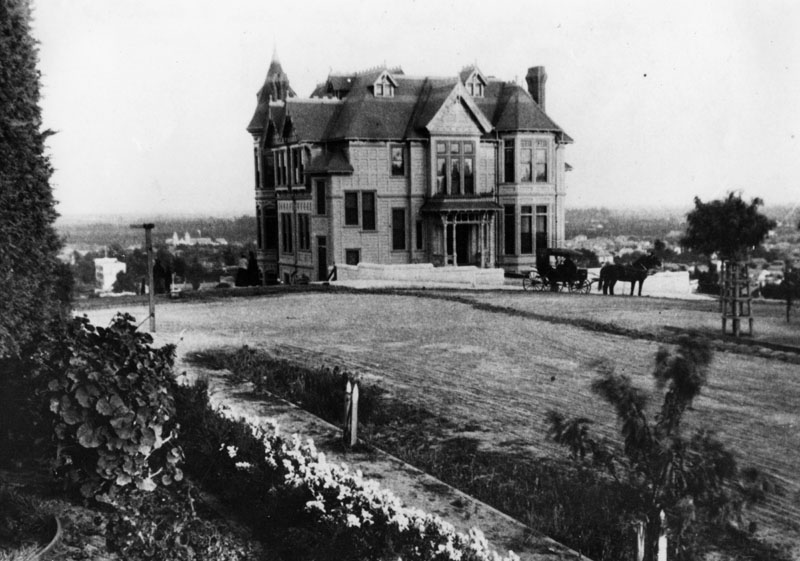 |
|
| (ca. 1887)* - The Crocker Mansion, located on the south east corner of 3rd and Olive street. This photo shows the back entrance of the mansion, as well as a horse-drawn carriage with three women and a child taking in the spectacular views of Downtown Los Angeles. |
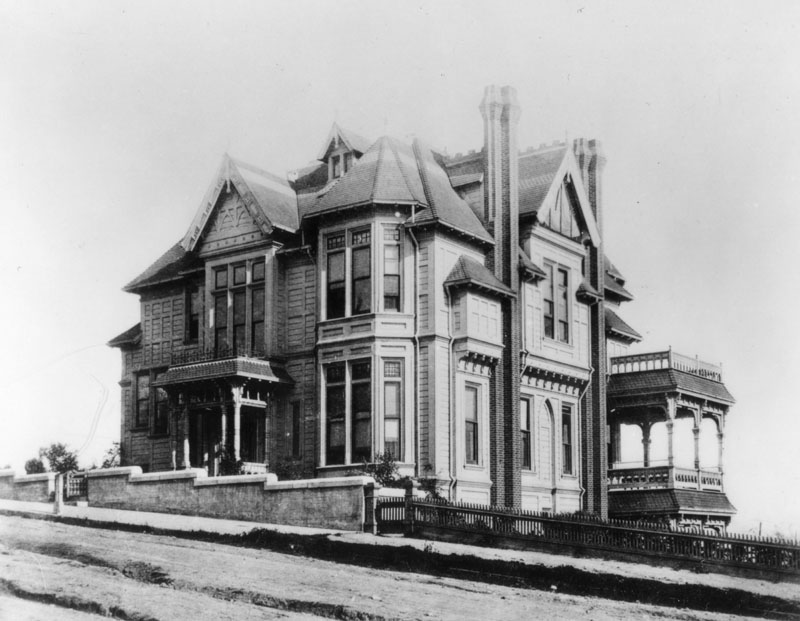 |
|
| (ca. 1888)* - Looking across an unpaved Olive Street, just south of 3rd Street, towards the Crocker Mansion on Bunker Hill. |
 |
|
| (ca. 1890)* - Partial view of the Crocker Mansion looing northeast showing its brick foundation, porch and balcony. |
 |
|
| (ca. 1890)* - Rear view of the Crocker Mansion showing the full extent of its wide balconies where you could get a great view of the emerging metropolis of Los Angeles. |
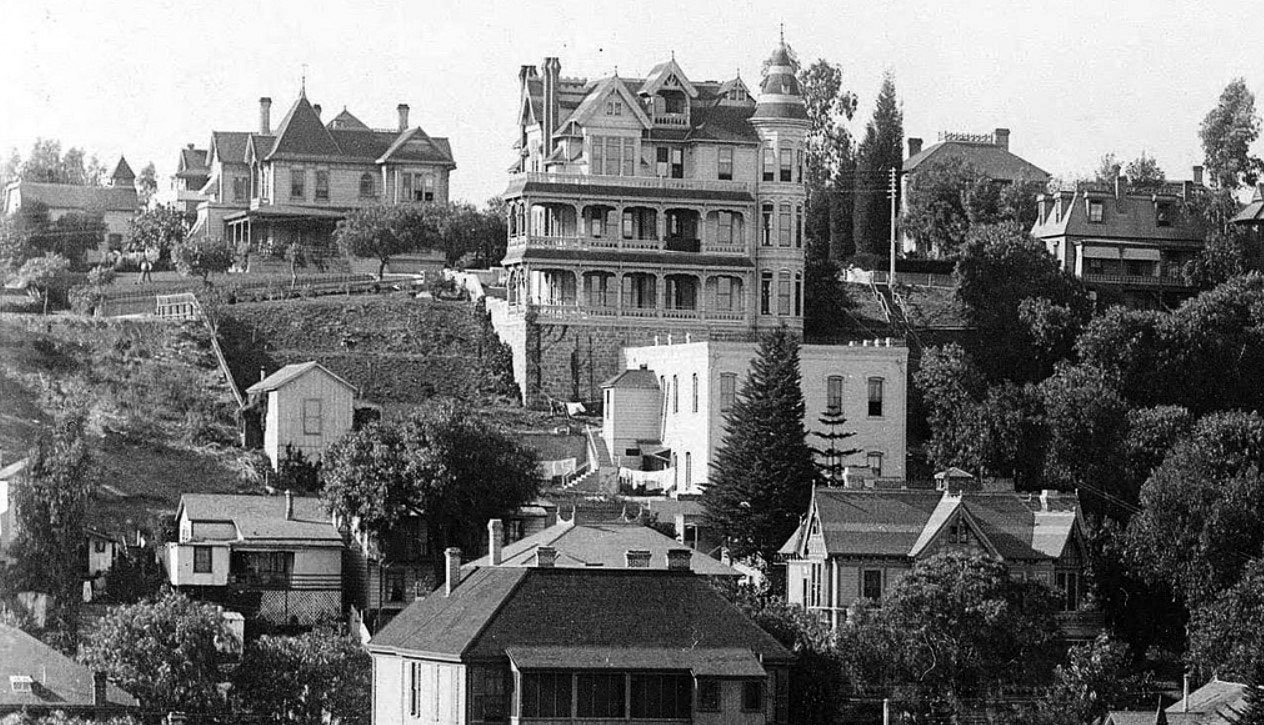 |
|
| (1898)* - Panorama view from 3rd and Spring streets showing the Crocker Mansion and neighbors on Bunker Hill. |
Historical Notes Construction on the Third Street Tunnel began in 1900, and Mrs. Crocker filed a petition claiming that the mansion was endangered by the street tunnel which was “unsafe, improperly constructed and a veritable death trap.” According to the Los Angeles Times, “the walls of her house are settling, the foundations giving way and the plaster is falling off…Unless something is done, the building is liable to topple into a hole.” The house never did topple and was alive and well in 1902 when Angels Flight began operating and dropping riders off practically on the Crocker doorstep. |
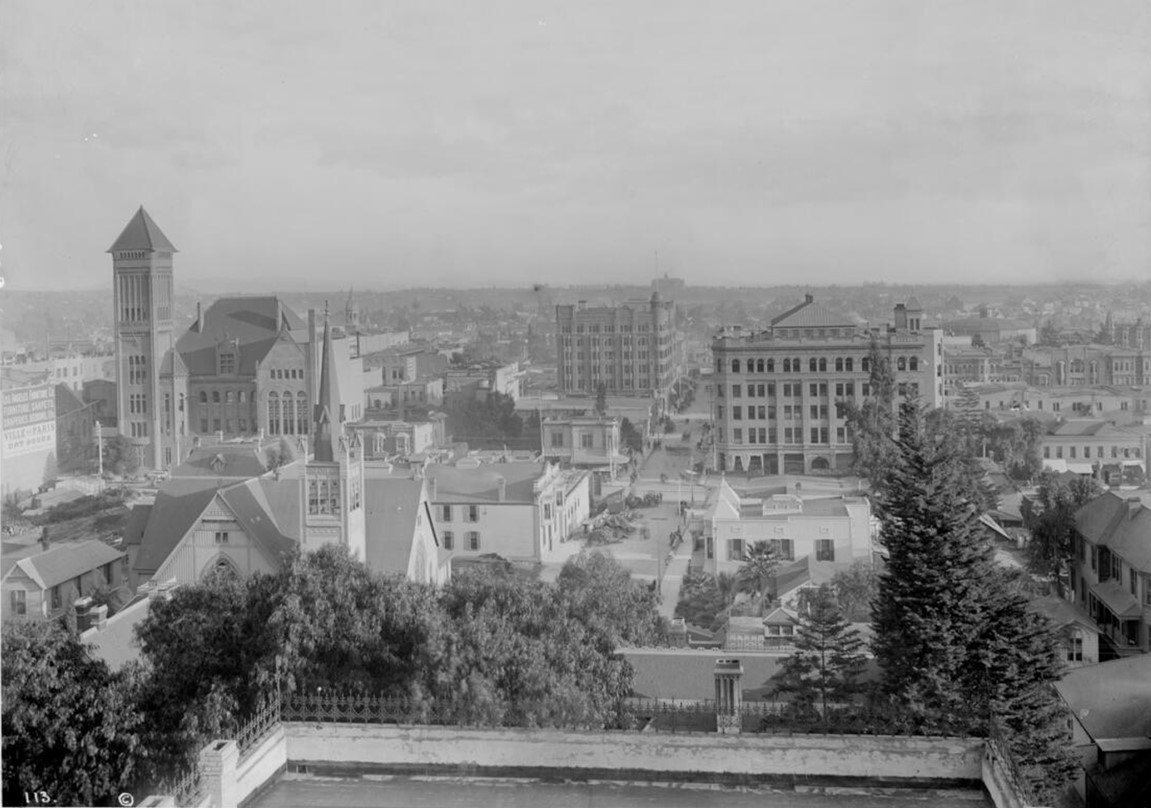 |
|
| (ca. 1894)* - Panoramic view of downtown Los Angeles from the Crocker Mansion (partially visible at left) looking east on Third Street from the intersection of Olive Street on Bunker Hill. Flags are flying on several buildings, including the Bradbury Building (Third Street and Broadway). The Los Angeles City Hall, with its distinguished tall tower, is seen just to the right of the mansion. Photo by C. C. Pierce. |
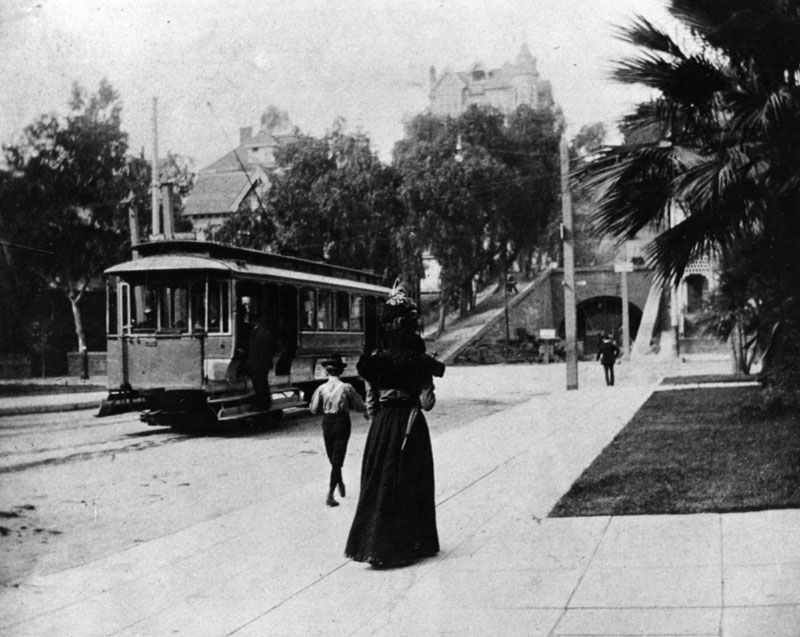 |
|
| (1901)* - 3rd Street, looking west, with a close-up view of a streetcar near the recently completed 3rd Street Tunnel in Bunker Hill. The Crocker Mansion stands tall at the top of Bunker Hill. |
Historical Notes On July 3, 1893, residents and taxpayers presented a petition to the Los Angeles City Council asking that a tunnel be created to connect those who lived in the Crown Hill neighborhood with the business district located on this side of Bunker Hill. Their plans called for a tunnel 1080 feet long, with a twenty-six foot roadway and eight foot sidewalks. Nothing happened for five years. In 1898 the City Council ordered the City Attorney to draw up an ordinance putting tunnel bonds in front of the public via a special election. That election was held on July 6, 1898, and funds were approved for both the Third Street and Broadway tunnels. On January 21, 1900, a serious disaster struck. Thirteen men were "entombed" in the tunnel dig after a massive cave-in on the western end. Several were killed in the collapse, but others were trapped inside with only the air in the tunnel. Frantic efforts were made to dig into their position. Ten men were rescued, while three perished. In March of 1901 the tunnel was opened to the public. It was unpaved and unlit. Gutters weren’t installed until 1902. Angel's Flight would open within a year of completion of the 3rd Street Tunnel. |
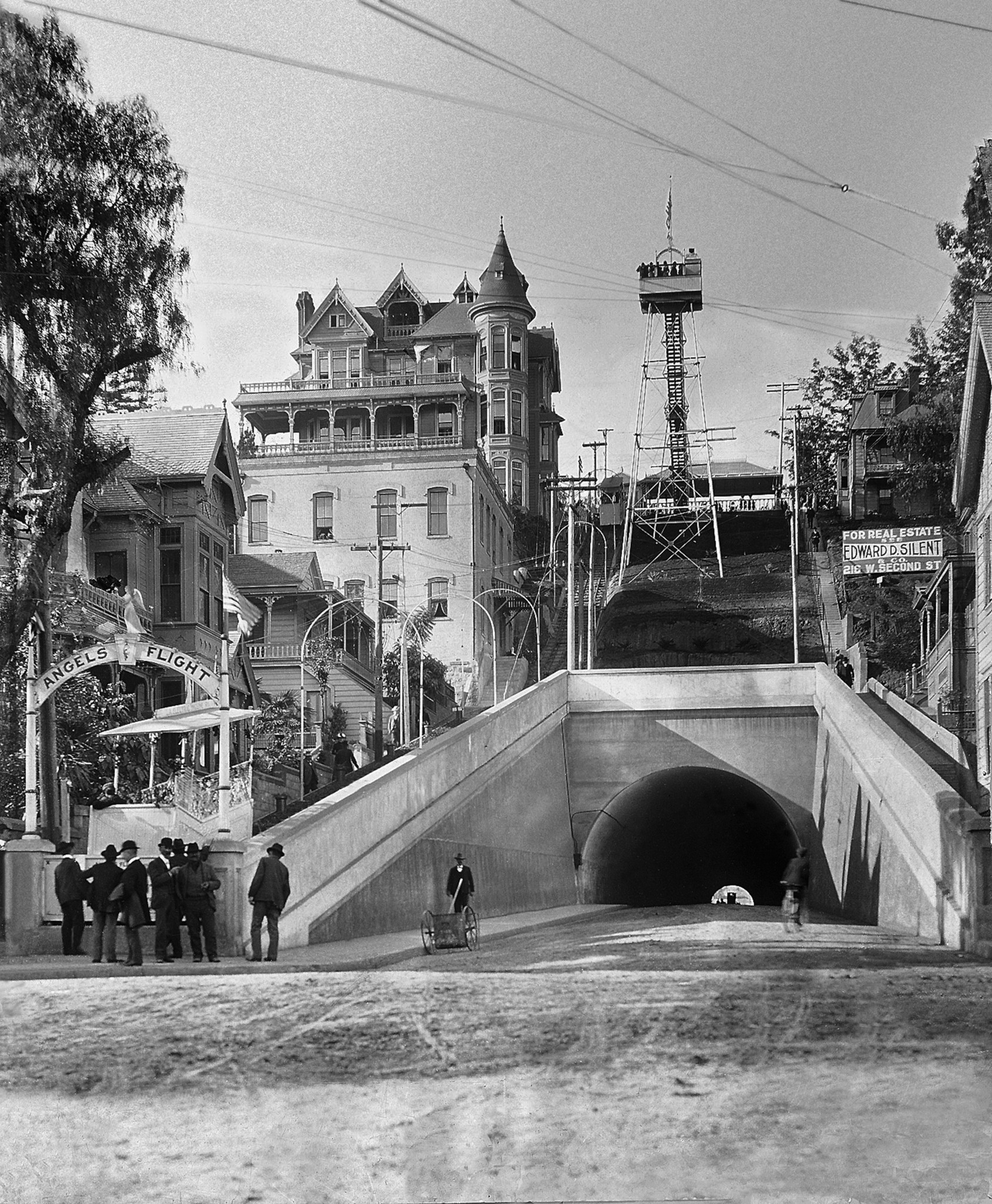 |
|
| (1901)* - Photo of Angels Flight at the grand opening of the incline railway, December 31st, 1901. An observation tower was also constructed on top of the hill adjacent to the Crocker Mansion. |
Historical Notes The Victorian Crocker Mansion was razed in June 1908 and the cornerstone for the Elk’s Annex was laid the following September. Built in 1901 with financing from Colonel J.W. Eddy, as the Los Angeles Incline Railway, Angels Flight began at the west corner of Hill Street at Third and ran for two blocks uphill (northwestward) to its Olive Street terminus. Click HERE to see more Early Views of Angels Flight. |
* * * * * |
Rose Mansion
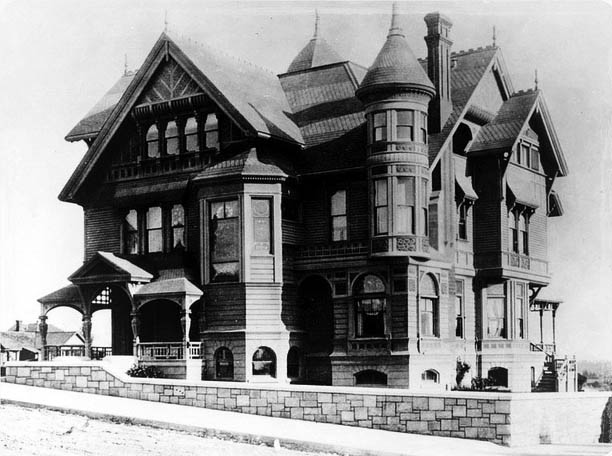 |
|
| (1888)*##^ - Exterior front corner view of the Leonard John Rose Victorian home at 400 South Grand Avenue. |
Historical Notes Sunny Slope was the name of the renowned ranch Rose acquired shortly after arriving in Southern California in 1860. Located in what is now the eastern end of Pasadena, the 1,900 acre property contained countless lemon, orange and olive trees, but became famous for its vineyards. Vines were imported from Spain, Italy and Peru, and the wine and brandy generated from Sunny Slope made L.J. Rose a household name and a very wealthy man. He also found success as a breeder with a horse ranch named Rosemead (where the city of the same name now stands), and eventually became a State Senator.^ |
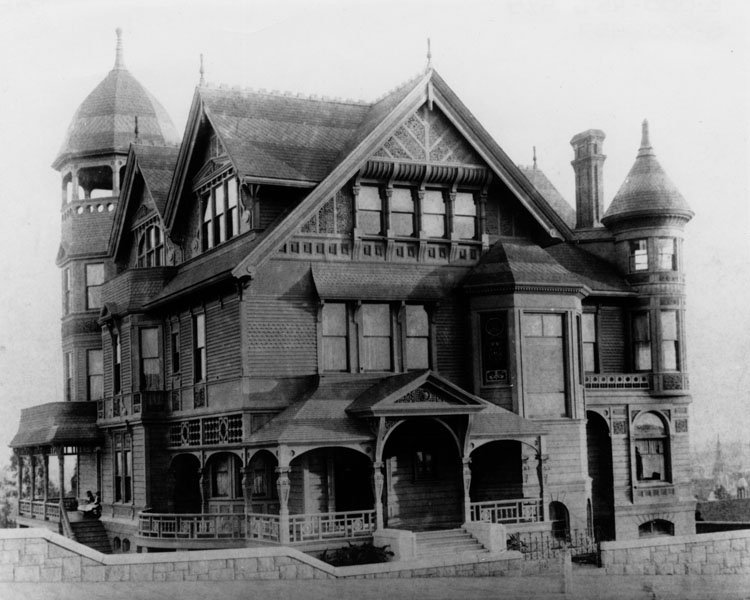 |
|
| (ca. 1890)* - Exterior of the mansion owned by businessman Leonard John Rose, located on the southeast corner of Grand Avenue and 4th Street on Bunker Hill. |
Historical Notes The lavish home, completed in 1888, was designed by Curlett & Eisen and cost approximately $50,000 to build.* |
* * * * * |
Larronde Mansion
 |
|
| (ca. 1888)* - Exterior front corner view of the three-story Victorian style home of Pierre Larronde at 237 N. Hope Street, Bunker Hill. |
Historical Notes At one time, the name Larronde was a fairly well known one in the City of Angels. Pierre Larronde was a native Frenchman who landed in San Francisco in 1847 and made a killing in the gold mines. When he relocated to Los Angeles in 1851, he amassed a further fortune by successfully raising sheep on one of the Ranchos. Always the astute businessman, Larronde cashed out his sheep empire in the late 1880s and focused his energies on real estate. His holdings included prime land at the corner of First and Spring, and a parcel on North Hope Street near Temple where he built the family home. The Sanborn Fire Insurance maps show the house on Hope Street as being under construction in 1888. The Larronde Bunch moved in shortly thereafter and held gatherings on a regular basis that made the society pages. Unlike many residences of Bunker Hill, the Larronde home suffered no scandals or controversies. Pierre the pioneer died in 1896, around the age of 70, and Juana resided on Hope Street until her death in 1920 at the ripe old age of 84.^ |
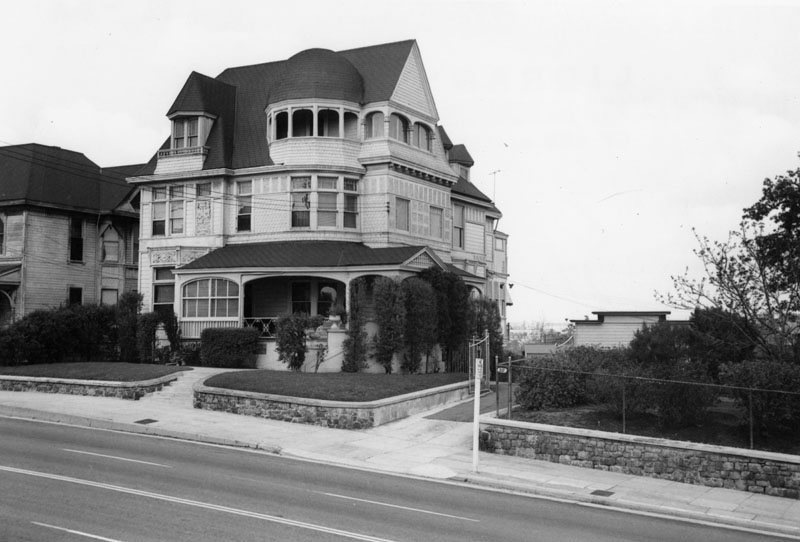 |
|
| (1954)* - Exterior of the Queen Anne Revival style home, located at 237 N. Hope Street. It was demolished in 1957. |
Historical Notes Pierre Larronde had a great deal in common with a fellow Los Angeles pioneer named Jean Etchemendy. Both men hailed from a south western region in France called the Basses-Pyrenees, both briefly lived in South America before cashing in early on the Gold Rush, and both successfully settled in Los Angles as sheep ranchers. Last but not least, both men married a gal named Juana Egurrola. Juana was born in Marquina, Spain but moved to California with her family at a very young age. She married Etchemendy in 1865 and gave birth to daughters Mariana, Madeleine and Carolina. Jean Etchemendy died in 1872 and Juana mourned for a couple of years before hooking up with the other French sheep-man in town. Juana’s 1874 union with Pierre Larronde produced three children, Pedro Domingo, John and Antoinette. For nearly eighty years, one family resided in the house at 237 North Hope Street. By the end of the 1960s, all traces of the Larronde/Etchemendy clan were erased from Bunker Hill.^ |
* * * * * |
Hazard's Pavilion
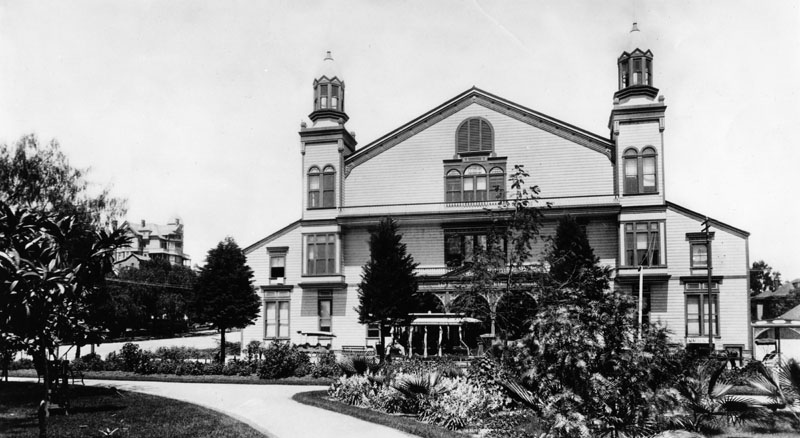 |
|
| (ca. 1887)* - Exterior view of Hazard's Pavilion. Erected in early-mid 1880; demolished around 1905, it is the present site of the Philharmonic Auditorium. |
Historical Notes Hazard's Pavilion was a large auditorium located at the intersection of Fifth and Olive Streets. Showman George "Roundhouse" Lehman had planned to construct a large theatre center on the land he purchased at this location, but he went broke and the property was sold to the City Attorney (and soon to be Mayor), Henry T. Hazard. The venue was built in 1887 at a cost of $25,000, a large amount for the time, and seated up to 4,000 people (some sources say that seating could be up to 8,000; the building was divided into two galleries, and perhaps each accommodated 4,000). The building was constructed of wood with a clap-board exterior, and the front was framed by two towers.^* |
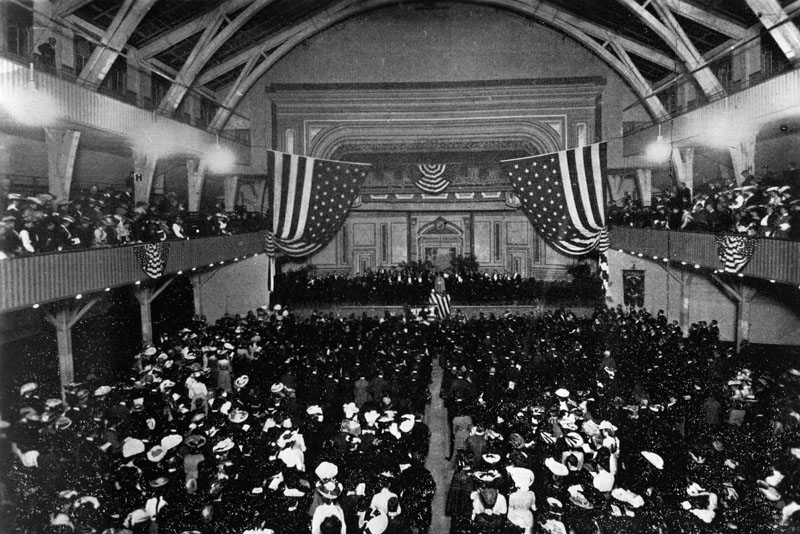 |
|
| (1903)* - A public reception being held inside the Hazard's Pavilion in May 4, 1903. The pavilion was erected in 1887 and demolished around 1905. The Philharmonic Auditorium was built in its place. |
Historical Notes As the largest building of its type in Los Angeles at the time, Hazard's Pavilion was a venue for conventions, political meetings, lectures, fairs, religious meetings, concerts, operas, balls, and sports events. It opened in April, 1887 with a modest civic flower festival, but a month later it hosted the National Opera Company with 300 singers, ballet dancers, and musicians. The Pavilion hosted regular religious meetings, including a series in 1888 where famed evangelist Dwight L. Moody spoke. In attendance at one of these meetings was Harry A. Ironside, which led him to becoming a world-famous preacher in his own right. Booker T. Washington, William Jennings Bryan and Carrie Nation were among the famous people who spoke to crowds gathered at Hazard's Pavilion. The great Italian operatic singer, Enrico Caruso, performed there.^* |
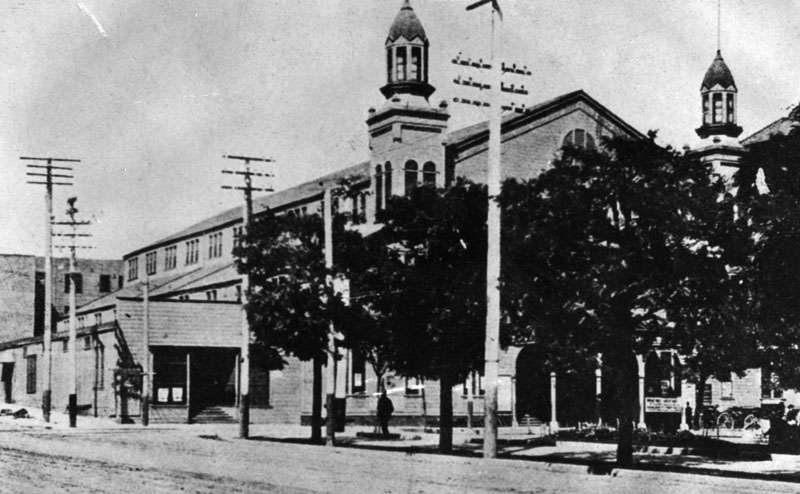 |
|
| (1895)* - Hazard's Pavilion as seen from across the street. Location: Intersection of 5th and Olive Streets. |
Historical Notes From 1901 to 1904, the first great Los Angeles boxing promoter, Uncle Tom McCarey, staged his first boxing shows at the pavilion. It would be McCarey who put the Los Angeles area on the map as a major boxing venue. Many famous boxers fought at the Pavilion.The future World Heavyweight Champion, Jim Jeffries, had only one fully recorded bout in Los Angeles, his hometown, when he fought Joe Goddard there in 1898. The man who would go on to be the first World Heavyweight Champion, Jack Johnson, fought in eight main events on cards staged by Tom McCarey at the pavilion during a period from 1902 to 1904. In 1906, Hazard's Pavilion was demolished to make way for a new Temple Auditorium. This was the largest reinforced concrete structure with the only cantilevered balcony in the world. It had the largest stage west of New York when it was completed, and it seated 2,600 people. An eight story office block and retail shops were part of the complex. For a number of years during the 1910s, Billy Clune presented silent films in the auditorium, then called, "Clune's Auditorium." The landmark film, Birth of a Nation, had its world premiere at Clune's Auditorium on its way to becoming a massive success.^* |
* * * * * |
Panorama Rotunda
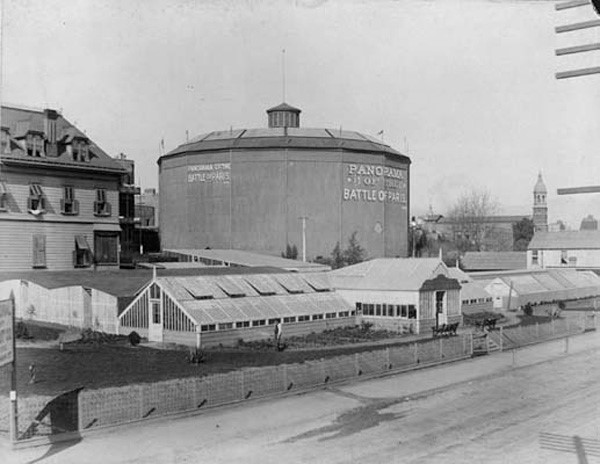 |
|
| (ca. 1887)* – View of the Panorama Rotunda showing the Battle of Paris. The large round building is seen from the rear and sits in the middle of the block bounded by 3rd, 4th, Main, and Los Angeles streets. |
Historical Notes The Panorama is an art form which encircles the spectator with an illusion of continuous space, often in a painted 360º format. Patented by Englishman Robert Barker in 1787, this spectacular visual entertainment flourished throughout the 19th century, mostly in Europe and the United States. Downtown Los Angeles debuted a panoramic exhibit in late 1887 at Main Street between Third and Fourth Streets, displaying the last battle between the French resistance and Prussian 'besiegers' after which Paris fell in January of 1871.^*#* |
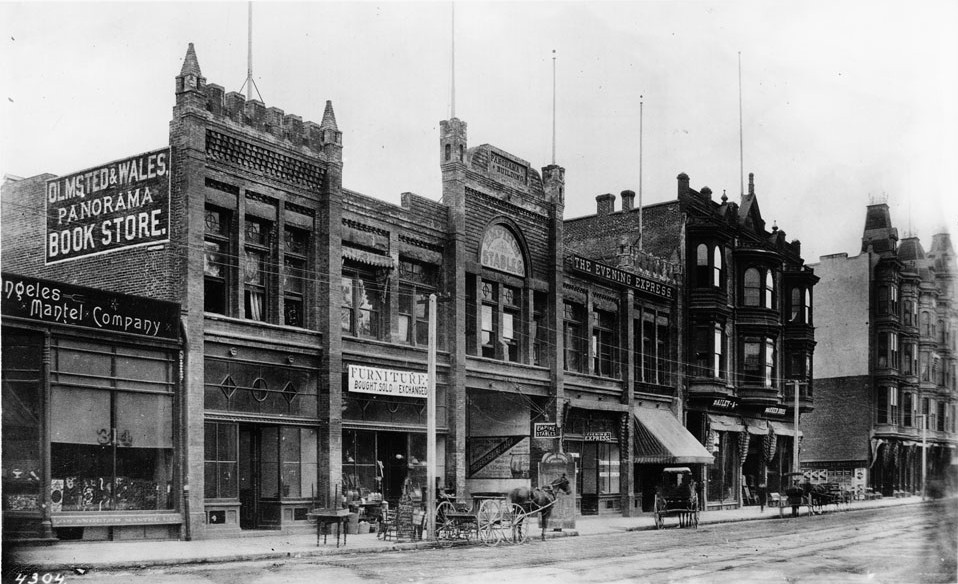 |
|
| (ca. 1890)^^* - View of Main Street south from 3rd Street. showing the Panorama Building. The Panorama Rotunda is conected to this building and stands to the rear, out of view. The Westminster Hotel, located on the northeast corner of 4th and Main streets, is seen at far right. |
Historical Notes Within a year of its construction, the brick storefront on Main Street through which panorama visitors entered, called ''Panorama Building,' was home to many business ventures, its owners quickly capitalizing on the prestige of the art work and its instantly recognizable address. Not only was it home to the painted battle scene, but also served as a warehouse for the Bancroft Piano Company; a rehearsal hall for the vocal section of the Philharmonic Society; the meeting space for the Young Man's Prohibition Club as well as the Harrison and Morton Club, a Republican party group; and Miss B.M. Tobin's millinery, directly adjacent to the offices of W.O. Merithew, architect. The Evening Express newspaper had its offices in the building, and the Olmstead and Wales Panorama Bookstore was also an early tenant.^*#* |
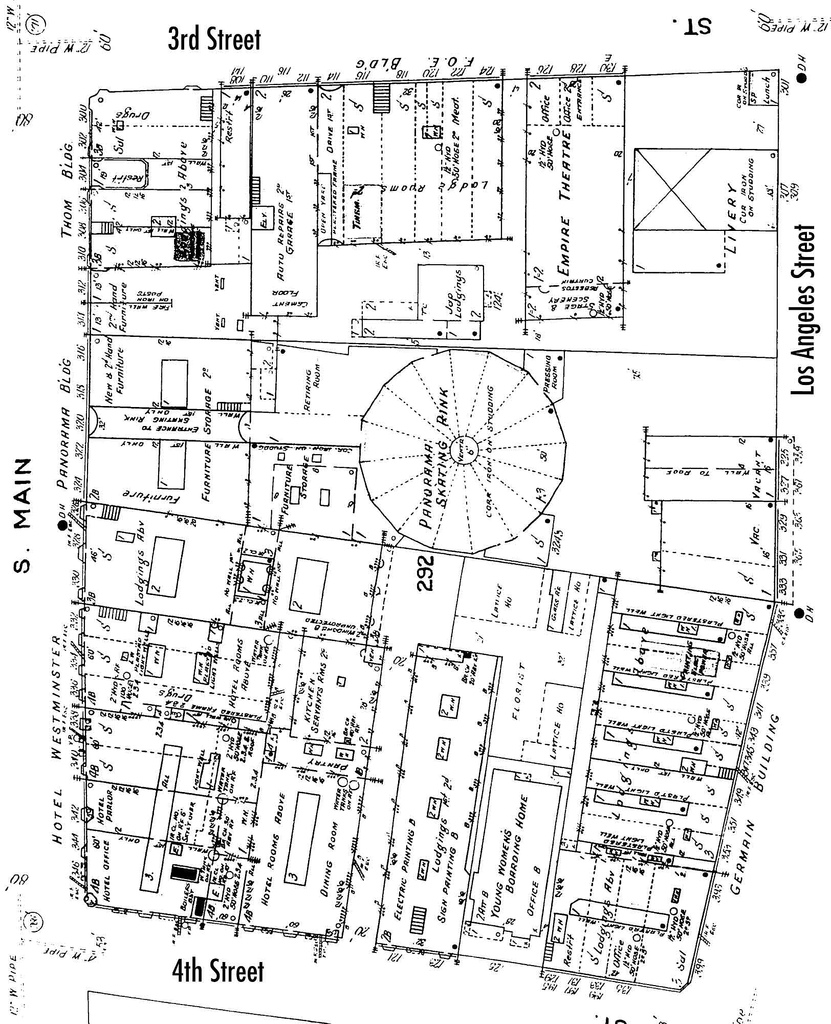 |
|
| (1906)^*# - Sanborn map showing the location of the Panorama Building and the large rotunda, now called the Panorama Skating Rink. The Westminster Hotel is at lower-left (N/E corner of 4th and Main). |
Historical Notes As the city continued to grow and change, the painting was removed, and the rotunda began to take on an array of ventures. Throughout the 1890s and early 1900s, the rotunda housed Empire Stables, also seen in the previous image. In 1906 it was configured into a grand state-of-the-art roller skating rink. Unfortunately, it didn't last long as a skating venue; in 1907, the owner of the property, a Mr. Adolph Ramish, demolished the building and made plans to construct the Adolphus Theatre on the site, later to be called the Hippodrome.^*#* |
* * * * * |
Pacific Railway Powerhouse
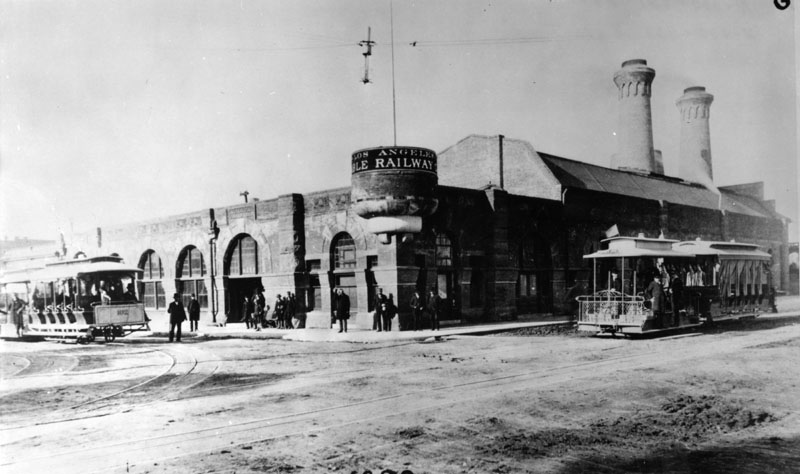 |
|
| (ca. 1888)* - Two separate cable cars arrive at the same location (7th and Grand) from different directions. The southwest corner building is the main power station for the Pacific Railway Company (formerly Los Angeles Railway). |
Historical Notes In September 1888, the Los Angeles Cable Railway Company sold their controlling interest to C. B. Holmes, and associates, of Chicago, Ill. They organized a new company, known as the Pacific Railway Company, capitalized at $5,000,000.00 and finished the construction of the cable lines, which when completed covered many of the LA streets with double tracks.^ |
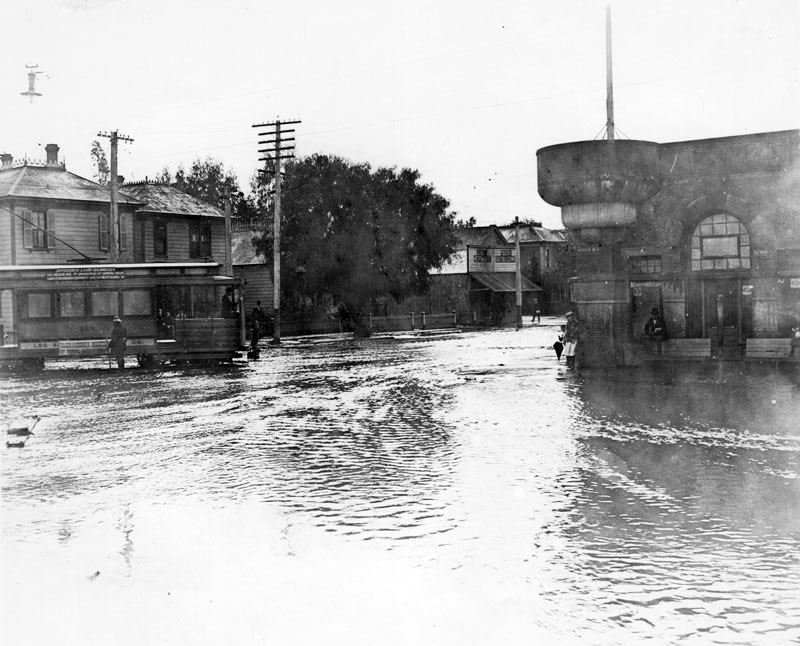 |
|
| (1890s)* - View of a flooded intersection at 7th Street and Grand Avenue. On the right, two men stay on high ground trying to avoid the rising water. To the left, a cable car appears to be stalled in the middle of the intersection. |
Historical Notes The principal power station for the Pacific Railway Company was located on the southwest corner of Seventh Street and Grand Avenue. Between 1904-1910, this building was used as a Post Office. Later, J. W. Robinson’s Dry Goods would build their first store at this corner.^ |
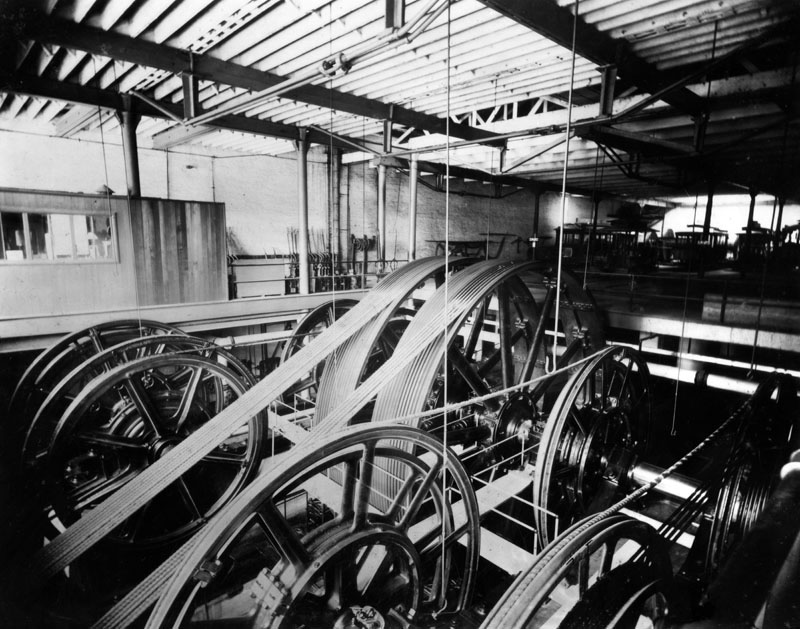 |
|
| (1890s)* - Interior view of the Pacific Railway Company power house, located at 7th and Grand, where huge wheels controlled the lines pulling the cable cars. |
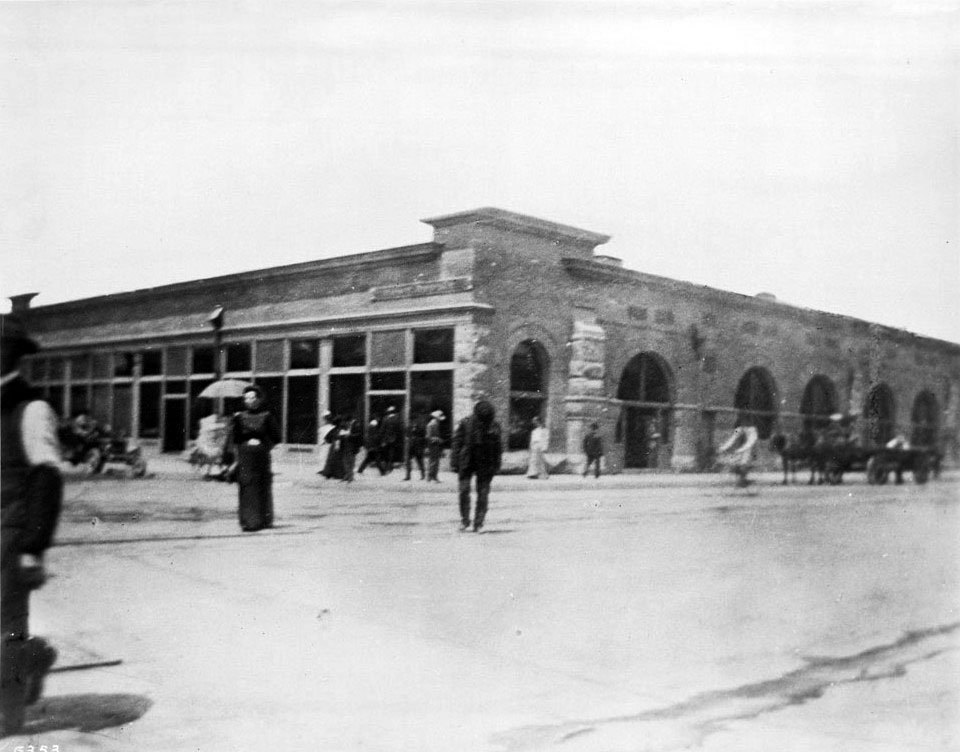 |
|
| (1906)^^* - Several people are seen crossing the street at the interscetion of 7th Street and Grand Avenue. The old Pacific Railway power house as been converted into a Post Office. The Romanesque architecture of the one-story building sports six visible arched windows to the right wall, while showing fourteen rectangular one-over-one sash windows to the left. |
Historical Notes The Post Office was moved here to Seventh and Grand in November 1904 and later moved away again in the September of 1910 to the corner of Main Street and Winston Street. The site, which was once the former cable power house, later became site of the J.W. Robinson Co. Department Store.^^* |
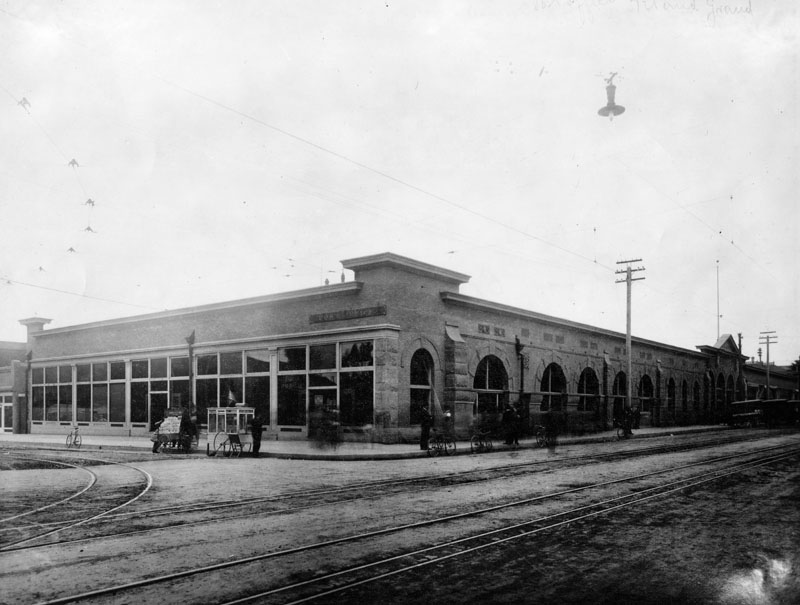 |
|
| (1907)* - View of the unpaved intersection of 7th Street and Grand Avenue, where a post office building sits on the southwest corner. This site later became the location of the large J.W. Robinson's store. |
* * * * * |
LA's First Electric Light Power Plant
 |
|
| (1888)* - View of Banning Street electric plant located on the corner of Alameda and Banning Streets. Photograph marked 1888 shows a brick building with men and a horse and buggy in front of it. |
Historical Notes The first electric light plant in Los Angeles was built in 1882 by C. L. Howland on the corner of Alameda and Banning Streets. One year later, Howland formed the Los Angeles Electric Company.* Click HERE to read the story behind LA's first electric power plant in Early Power Generation. |
* * * * * |
Mission Hotel (aka Porter Hotel)
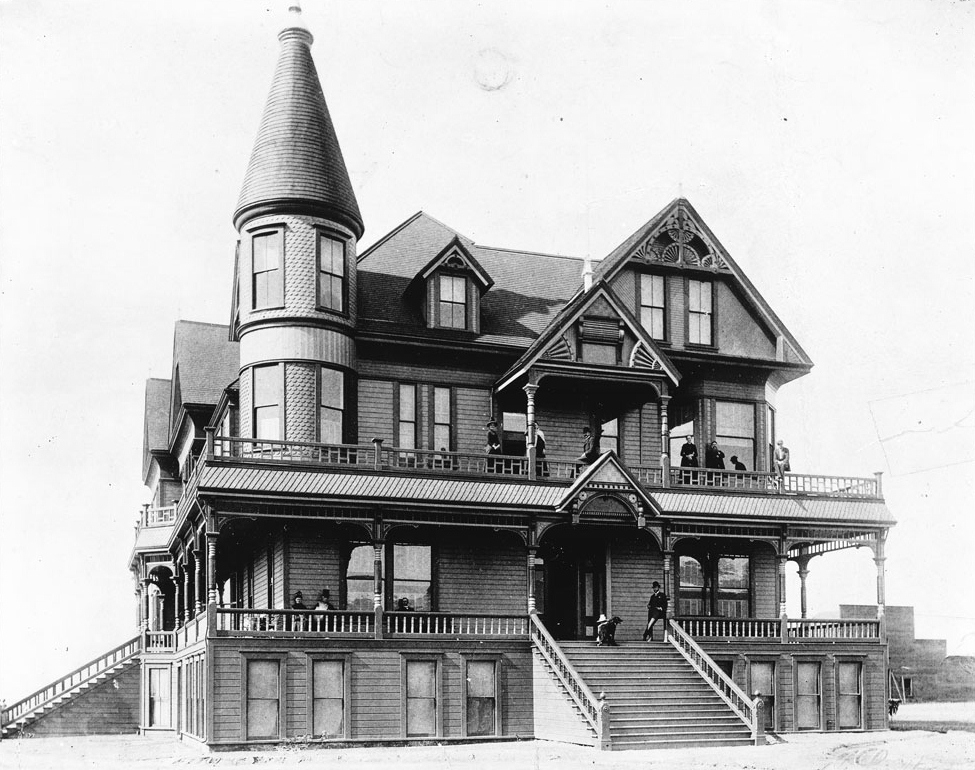 |
|
| (ca. 1888)* - The Mission Hotel located in the City of San Fernando. The three and a half-story, Victorian-style hotel is shown with people posing on its porch and balcony. On the second floor a man can be seen leaning against one of the beams which support the overhang near the hotel's entrance. A dog is visible near him at the top of the front steps that lead to the second floor and the subsequent entrance. On the second floor to the left, a two-story tower extends from the hotel, decorated in gingerbread clapboard. |
Historical Notes In the late 1800s the City of San Fernando, as well as the entire San Fernando Valley, saw a significant land boom A major hotel was built near the modern intersections of Laurel Canyon Boulevard and South Brand Street. Called the Mission Hotel, the building was built by the Porter Land and Water Company during 1887. |
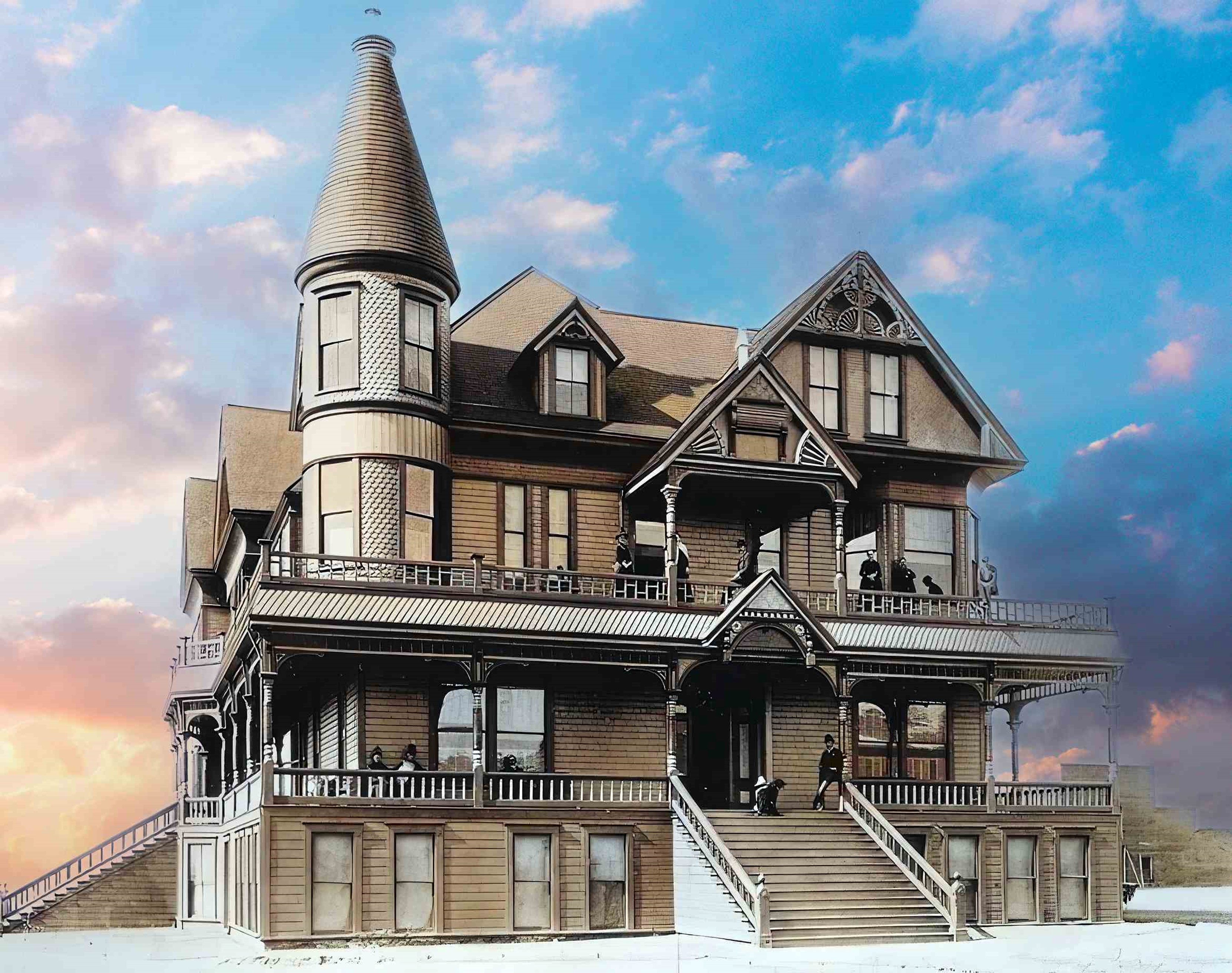 |
|
| (ca. 1888)* - The Mission Hotel located in the City of San Fernando. The three and a half-story, Victorian-style hotel is shown with people posing on its porch and balcony. On the second floor a man can be seen leaning against one of the beams which support the overhang near the hotel's entrance. A dog is visible near him at the top of the front steps that lead to the second floor and the subsequent entrance. On the second floor to the left, a two-story tower extends from the hotel, decorated in gingerbread clapboard. Photo enhancement and colorization by Richard Holoff. |
Historical Notes The Victorian-style building served as a hotel for about a year, and later, as a summer residence for the Porter family. |
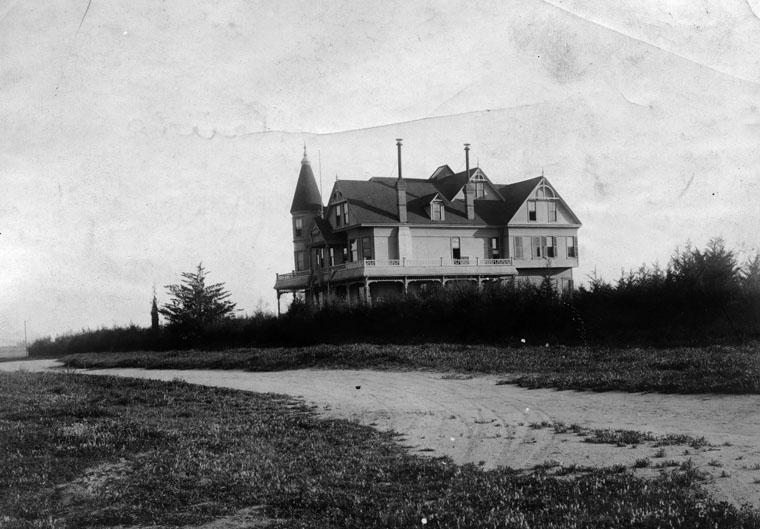 |
|
| (ca. 1890)* - Exterior view of the Porter Hotel (also called the Mission Hotel). Building was built in 1887, on a knoll about a mile from the center of San Fernando. It served as a hotel for about a year, and later, as a summer residence for the Porter family. |
* * * * * |
Hotel Cecil
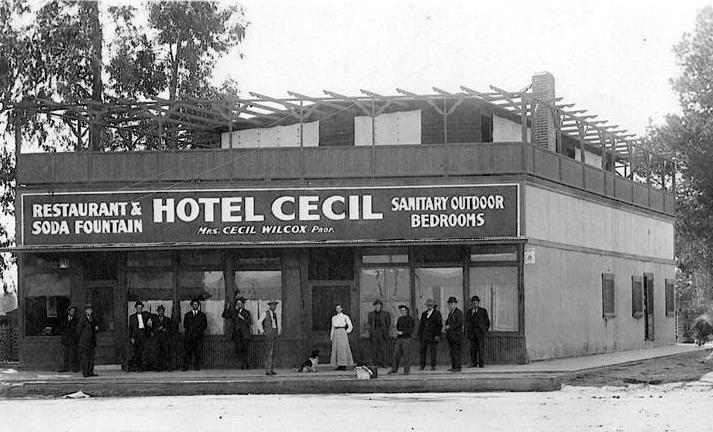 |
|
| (1888)^*^^ – View of the Hotel Cecil in Lankershim (North Hollywood). It was one of the first hotels in the San Fernando Valley. Pictured in the center is the owner, Mrs. Cecil Wilcox, with a dog by her side. A dozen men surround her, all posing for the photographer. |
Historical Notes Cecil Wilcox was the husband and his wife's given name was Clara. They appear in the censuses. He owned a furniture/book store and was apparently the publisher of a San Fernando Valley newspaper "The Lankershim Laconic." While it is not mentioned in the censuses, a newspaper article in the early 1950's promoting a "pioneer picnic" in Toluca/Lankershim, lists her as a widow who was the owner of the hotel. The photo date more than likely should be 1898 since Cecil was born in 1876. Clara (Hoegerman) and Cecil were married in 1897 in Los Angeles County. Cecil had died in 1933. Clara died in 1958. Ancestry.com has a picture of Clara and her sister Rose.^*# |
Click HERE to see more in Early Views of the San Fernando Valley |
* * * * * |
Wilson Block
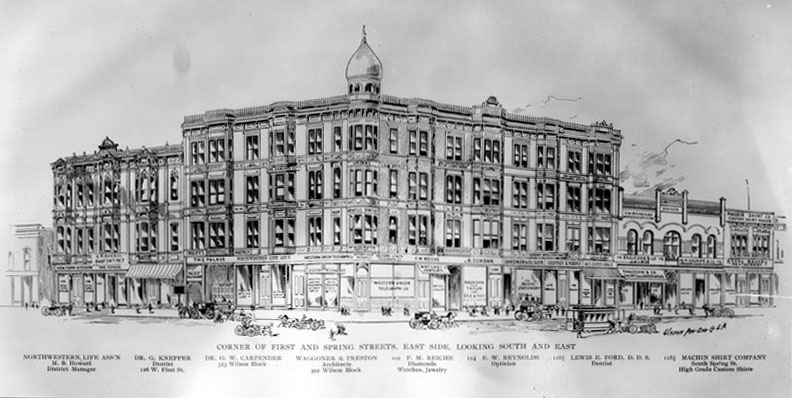 |
|
| (ca. 1886)* - Sketch showing the corner of First and Spring streets, looking southeast at the Wilson Block with its distinct copula, built in 1886. |
Historical Notes The Los Angeles Herald has an extensive article about the Wilson Block in the 8 August 1886 edition. The first paragraph says: The full article can be found at the California Digital Newspaper Collection. ^*# |
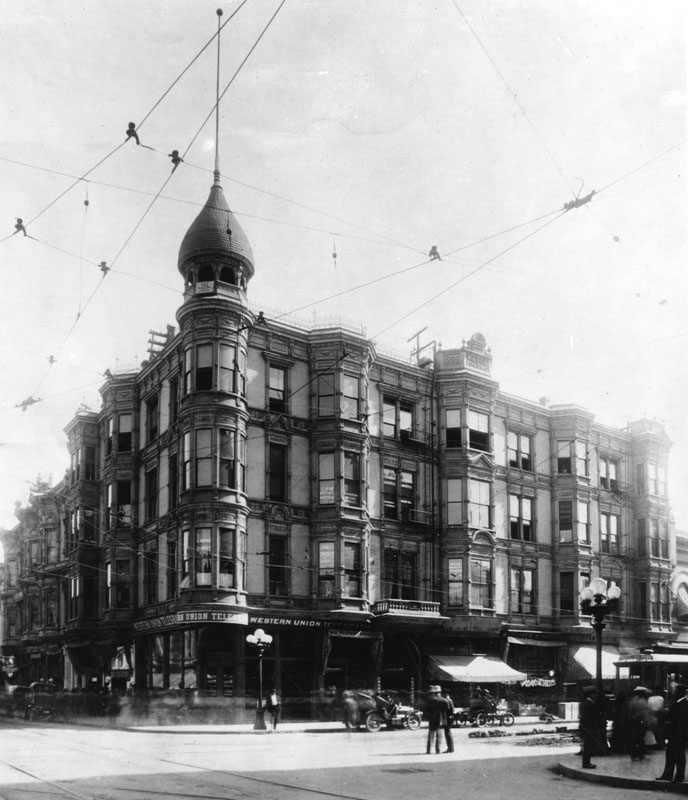 |
|
| (ca. 1910)* - View of the Wilson Block located on the southeast corner of First Street and Spring Street. Sign over the corner store reads: WESTERN UNION TELEGRAPH. Note the ornate streetlights on the corners. Click HERE to see more in Early L.A. Streetlights. |
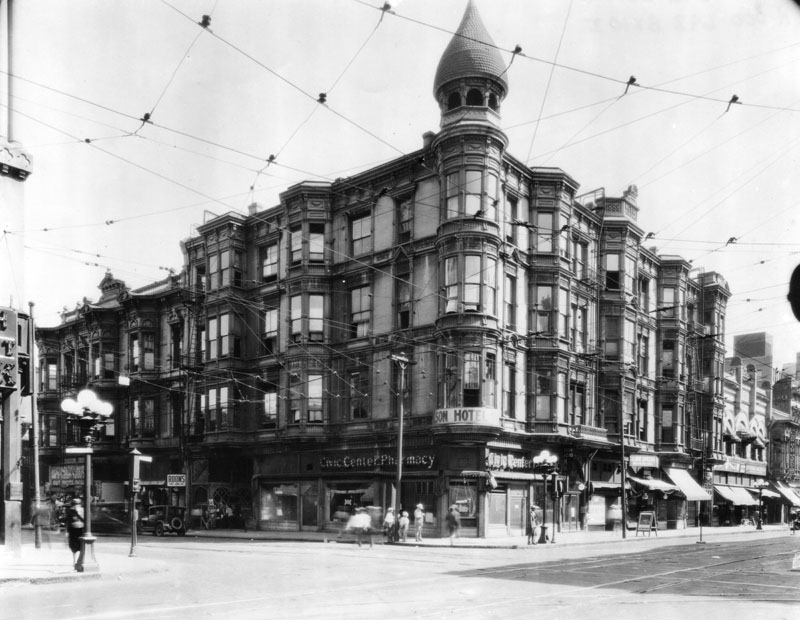 |
|
| (ca. 1918)* - View of the Wilson Building, also known as Wilson Block, on corner of First Street and Spring Street. Sign over the corner store reads: Civic Center Pharmacy |
* * * * * |
YMCA (212 W. 2nd Street)
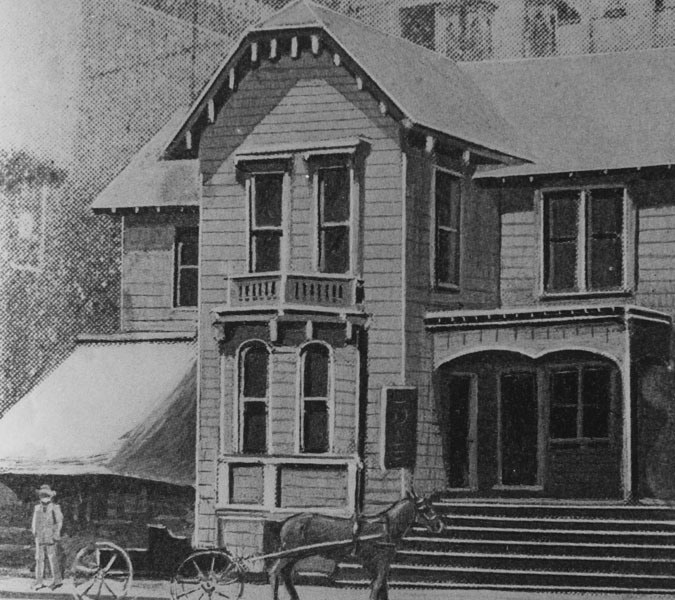 |
|
| (ca. 1888)* - Sketch showing the first permanent home of the Los Angeles Young Men's Christian Association (YMCA), located in this structure at 212 West 2nd Street, which the organization leased in 1886. It was used by the Y until about 1889. |
YMCA (207 S. Broadway)
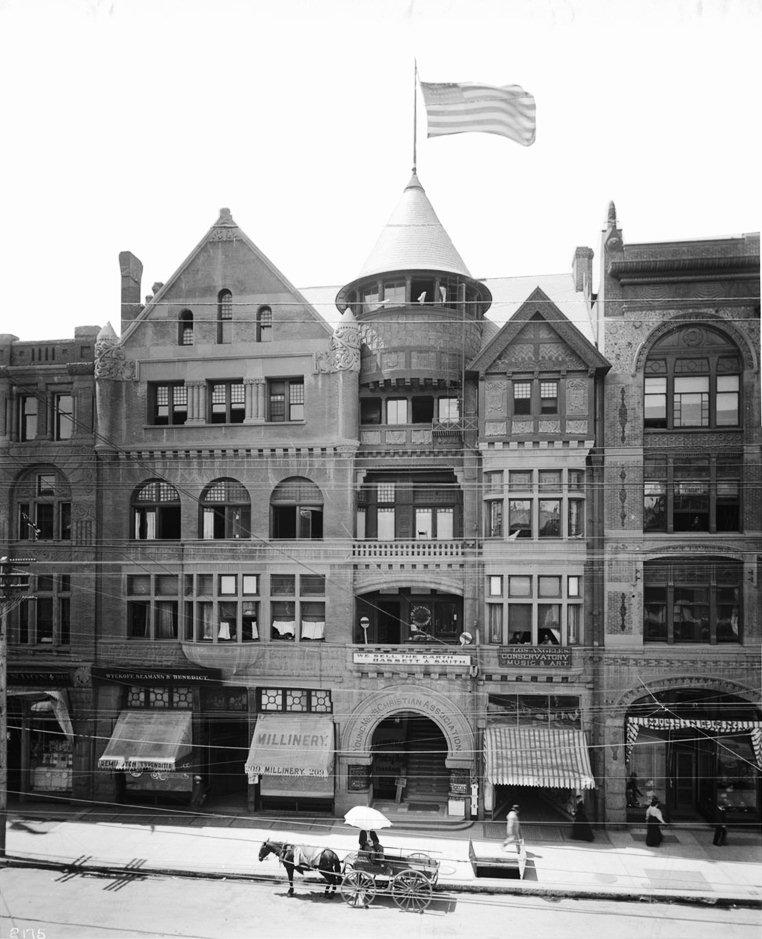 |
|
| (ca. 1899)^^* - View of the first building designed and constructed as a YMCA structure in Los Angeles. It was located at 207 Fort Street (now Broadway). Completed in 1889, it had the first gymnasium in Los Angeles. |
Historical Notes The YMCA's most influential period since its conception (London in 1844) could be between the 1870s and 1930s. It is during this time that they most successfully promoted "evangelical Christianity in weekday and Sunday services, while promoting good sportsmanship in athletic contests in gyms (where basketball and volleyball were invented) and swimming pools." Later in this period, and continuing on through the 20th century, the YMCA had "become interdenominational and more concerned with promoting morality and good citizenship than a distinctive interpretation of Christianity.^* |
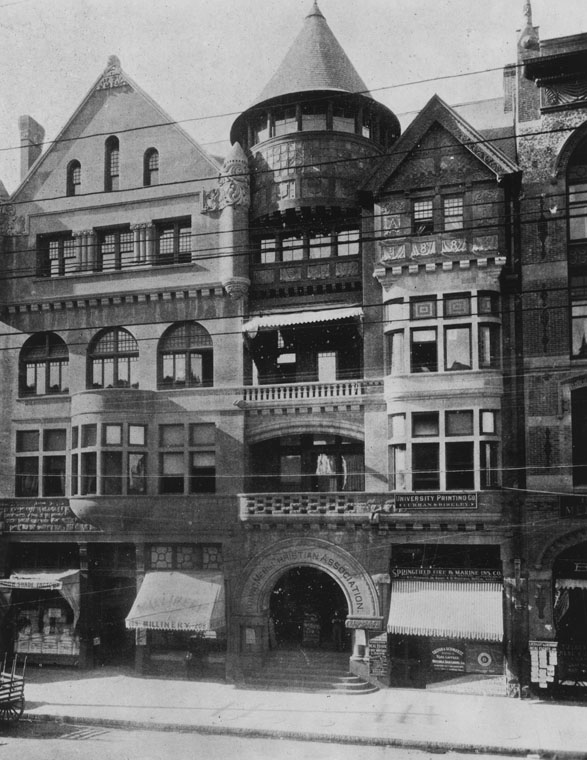 |
|
| (ca. 1900)* - YMCA building at 209 South Broadway, used from 1889 to 1903. |
Historical Notes In 1903, the YMCA Building would be demolished to make way for the Merchants Trust Company Building. |
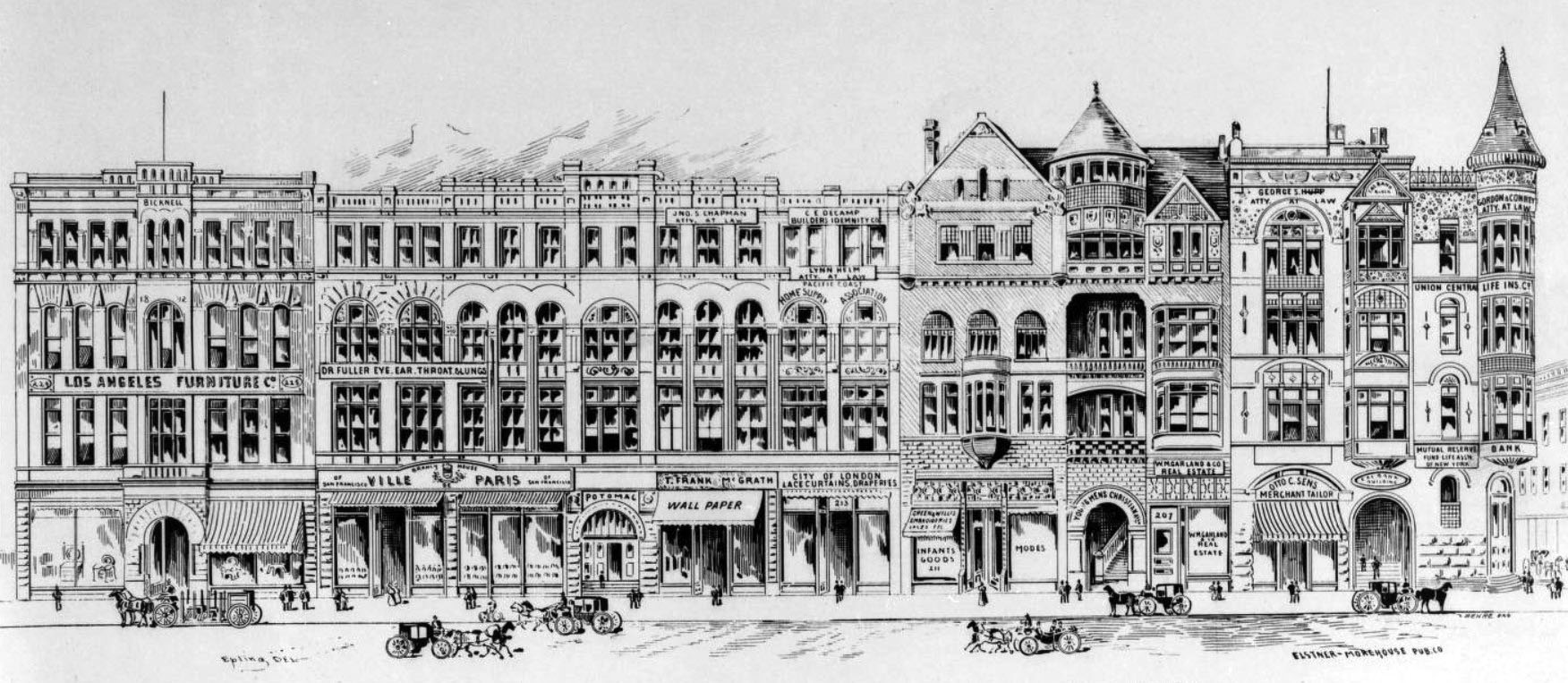 |
|
| (ca. 1890s)^^*- Photograph of an artist's rendering of a portion of a block on the west side of Broadway, between Second and Third Streets, showing commerical buildings and pedestrian traffic. The YMCA Building is the second building from the right. On the southwest corner of Broadway and 2nd Street, next to the YMCA, stands the California Bank Building. On the other side of Broadway are: City Hall , B'nai B'rith Temple, and the First Presbyterian Church. |
Historical Notes A block of commercial buildings, designed in the Second Empire style of architecture, is depicted in detail, with the row of buildings crossing the center of the image. Each building is four stories tall and its front contains many windows; the building at the right edge of the picture is more ornate, with gabled windows and a turret at its outer edge. The bulidings are fronted by a paved sidewalk, which is occupied by pedestrian traffic. The edge of another block can be seen at the rightmost edge of the image, while horse-drawn carriages line Broadway. Legible signs, from left to right, include: "Los Angeles Furniture Co", "Dr. Fuller Eye, Ear, Throat & Lungs", "Ville de Paris", "Jno.S Chapman. Atty. At Law", "T. Frank McGrath Wallpaper", "C.E. Decamp Builders Indemnity Co", "Lynn Helm Atty. At Law", "Pacific Coast Home Supply Association", "City of London Lace Curtains, Draperies", "Green & Willis Embroideries Laces Etc. Infant Goods. Modes", "Young Mens Christian Assn", "W.M.Gar & Co. Real Estate", "George S. Hupp Atty At Law", "Otto C. Sens Merchant Tailor", "Cal-Bank Building", "Gordon & Conrey Atty At Law", "Union Central Life Ins. Co", "Mutual Reserve Fund Life Assn of New York", and "Bank".^^* |
California Bank Building
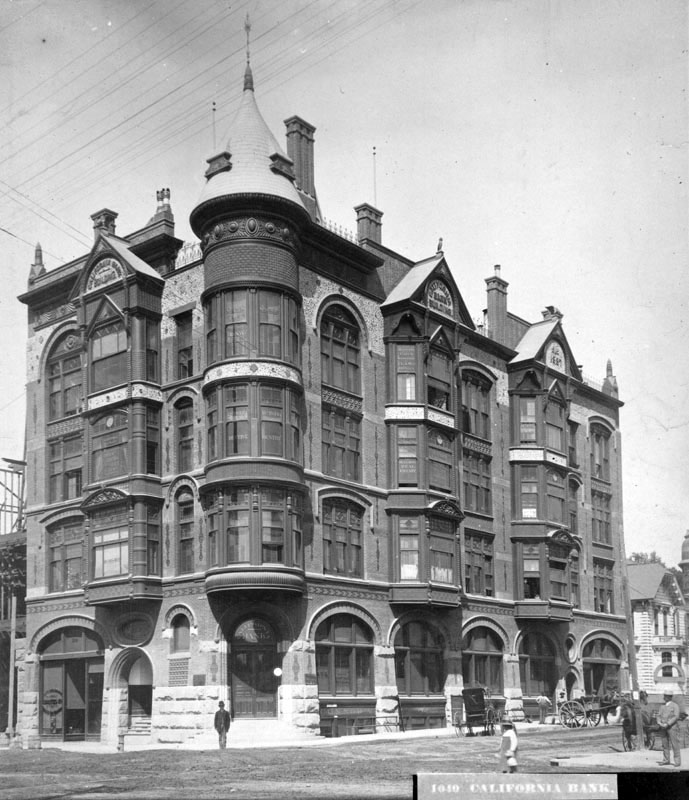 |
|
| (ca. 1887)* - Exterior view of the California Bank building, located on southwest corner of Second and Broadway. Note the adjacent bulding is still under construction. |
Historical Notes Of the buildings seen in the previous artist rendering of 200 block of Broadway, the 1887 built California Bank Building appears to be the first building constructed. |
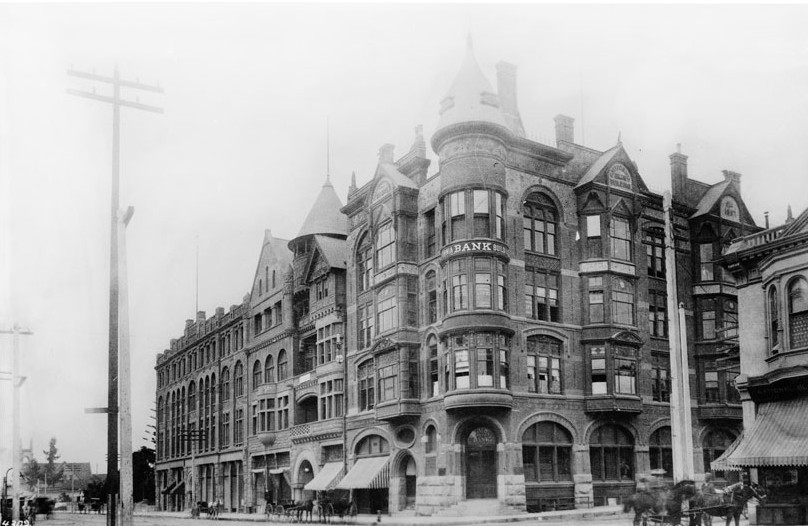 |
|
| (ca. 1889)^^* - View of the California Bank, the YMCA and the Fort Street Methodist Episcopal Church on Broadway and Second Street, looking south. |
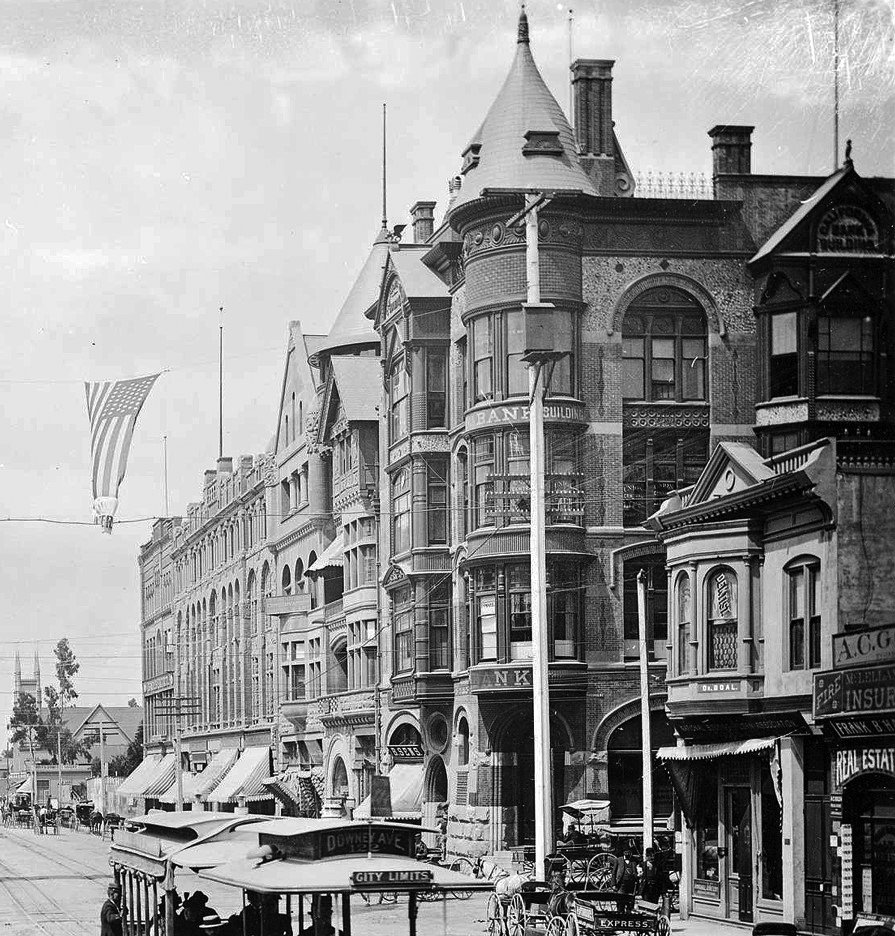 |
|
| (1889)* – View looking south on Broadway at 2nd Street showing the California Bank Building on the southwest corner. City Hall (built in 1888) is across Broadway out of view on the left. |
* * * * * |
Turnverein Building
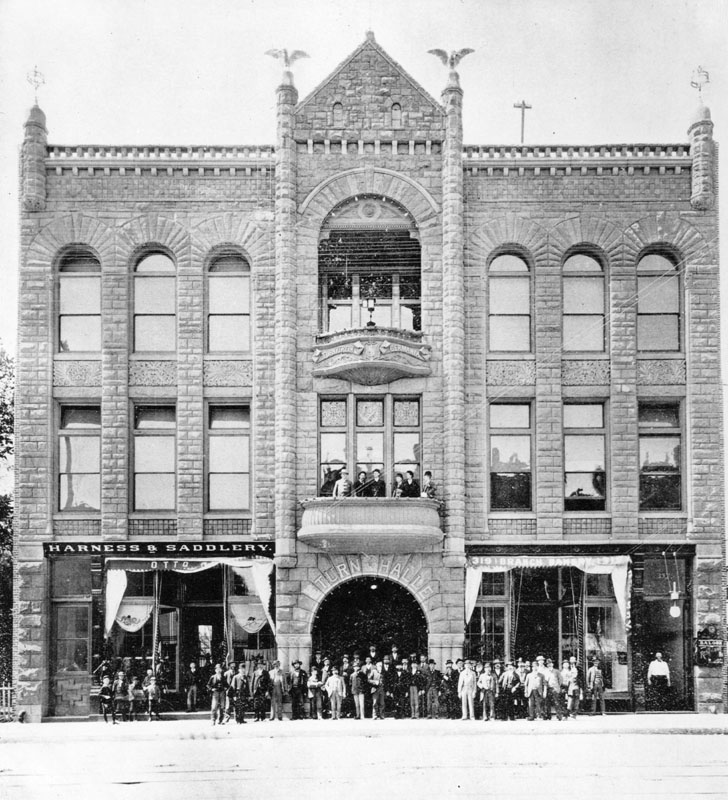 |
|
| (1888)* - Exterior view of the new Turnverein building in 1888, located at 321 So. Main Street. It has a group posing in front. This was a club of German Americans. |
* * * * * |
St. Francis Apartments
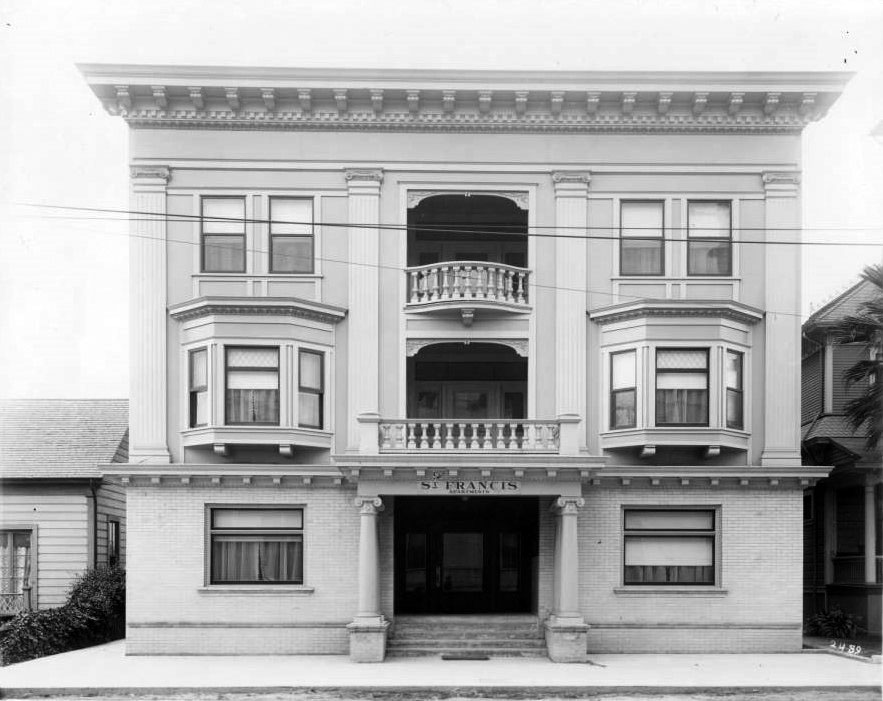 |
|
| (ca. 1890)* – View of the St. Francis Apartments on Tenth Street (Olympic Blvd. today) near Broadway. The three-story apartment building’s main entrance is on a covered porch with two balconies directly above. The bottom floor of is made of brick, while the upper floors are made of wood and decorated with façade columns. Each floor consists of large windows, designed in different sizes and shapes. |
Historical Notes Olympic Boulevard was originally named 10th Street for most of its length, except for a couple of shorter stretches. In 1932, the entire length of the street, from East L.A. to Santa Monica, was renamed Olympic Boulevard for the Summer Olympics being held in Los Angeles that year. |
* * * * * |
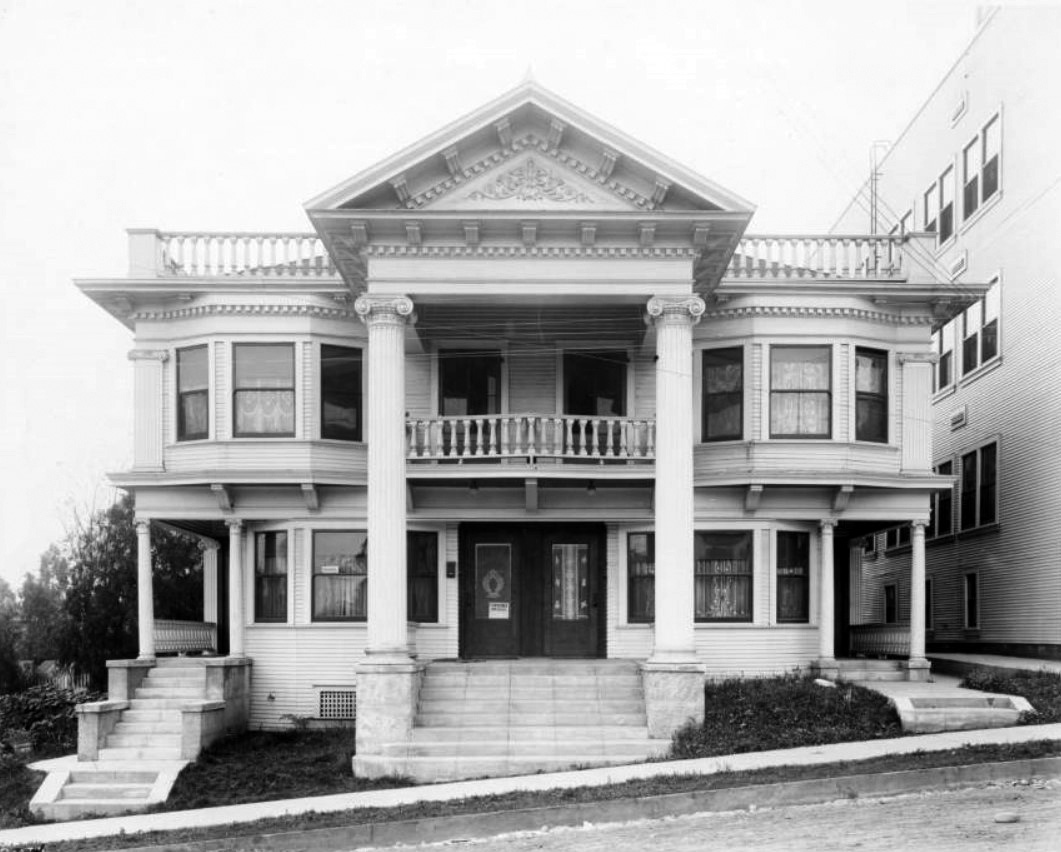 |
|
| (ca. 1889)* – View showing a Colonial Revival-style apartment building located on 6th Street west of South Figueroa Street in Los Angeles. The main entrance is flanked by two massive columns, and a balcony can be seen over the front double doors. Two cement stairways lead to covered walkways on the sides of the building, while another set of stairs leads to the front door. A thee-story rectangular building can be seen at right. |
* * * * * |
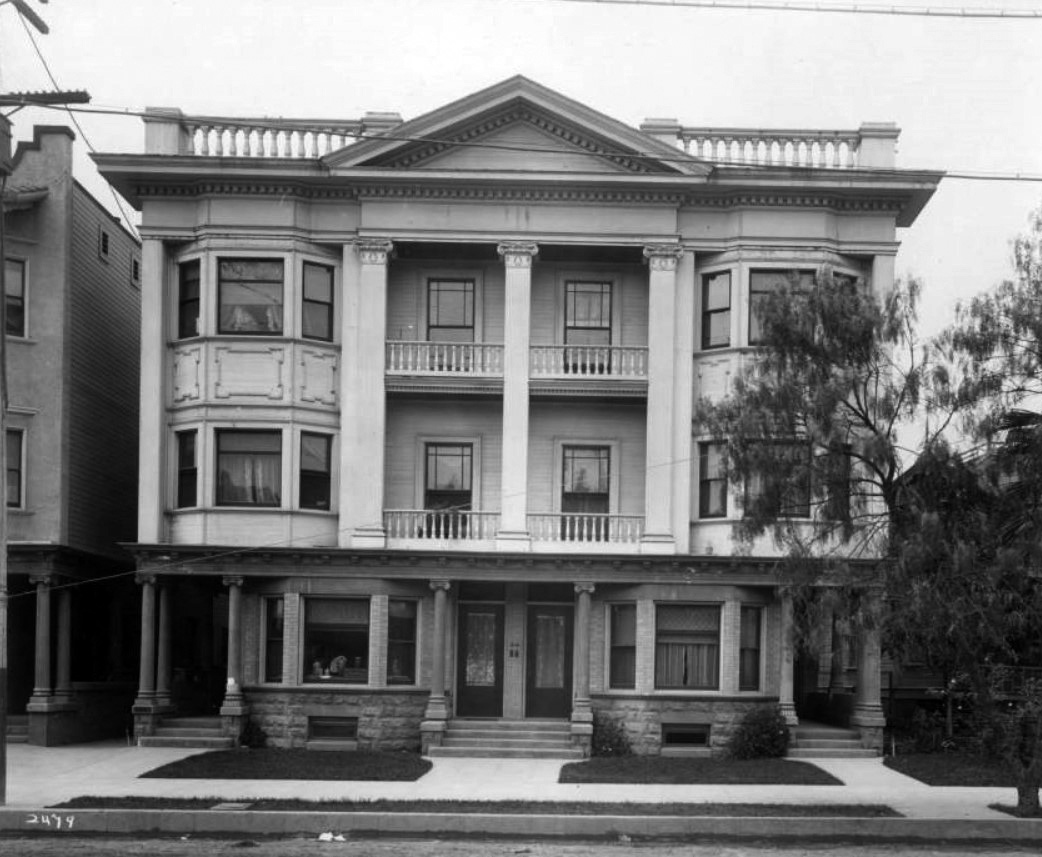 |
|
| (ca. 1889)* - View showing a three-story Colonial-revival apartment house located at 1111-1117 South Figueroa Street. The first floor is constructed of stone, while the upper stories are made of wood. All three stories are decorated with large columns, and rectangular windows look out on the street below. Two balconies are visible in the middle of the building. A concrete sidewalk runs parallel to an unpaved street in the foreground. |
* * * * * |
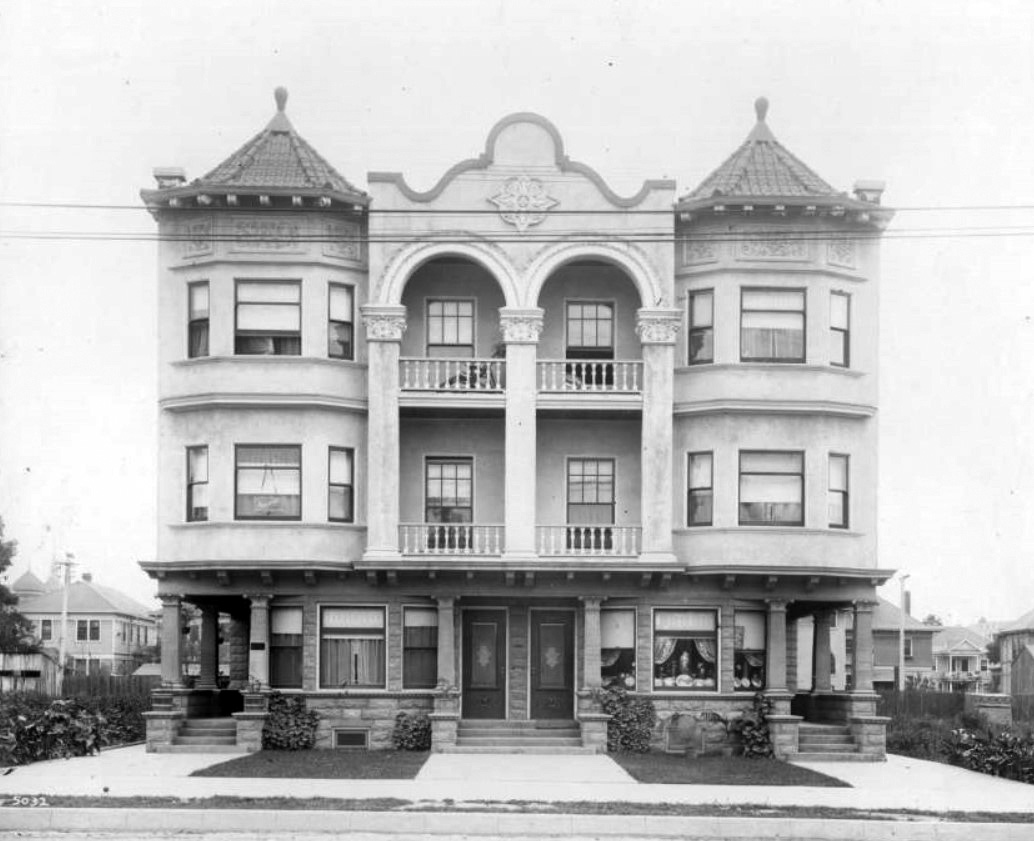 |
|
| (ca. 1889)* - View shwoing a three-story apartment building on Figueroa Street between Eleventh Street and Twelfth. The main entrance is in the middle of the building on the bottom floor and is flanked by two sets of three windows. Covered walkways lead to other rooms on the edges of the building. There are two balconies visible on the second and third stories. The roof of the building is made of terracotta tiles. |
* * * * * |
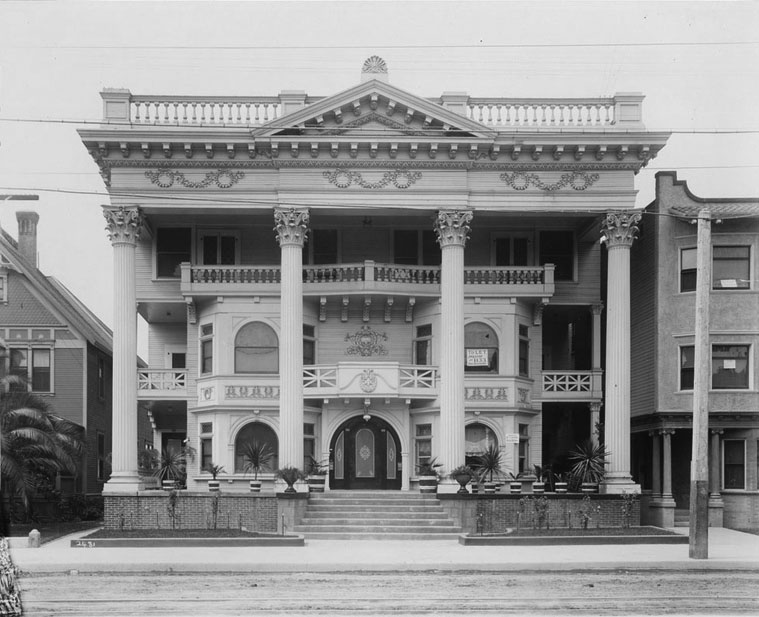 |
|
| (ca. 1889)* - Exterior view of a three-story Romanesque apartment building located at 1133 South Figueroa Street. Four tall columns hold up an overhanging section of the roof in the front of the building. Balconies can be seen on the second and third stories, while arched windows can be seen flanking the arched front door at center. |
Historical Notes Today, the Crypto Arena (Staples Center) is located where this beautifully designed apartment building once stood, 1133 S. Figueroa Sreet. |
* * * * * |
Princess Apartment-Hotel (aka 'Queen Apartments')
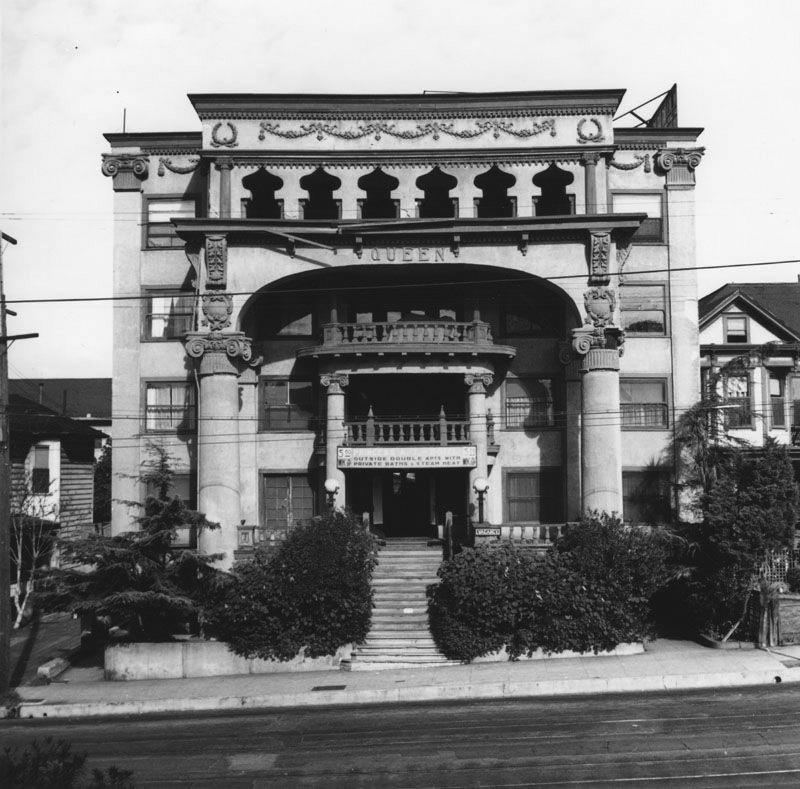 |
|
| (ca. 1940)* - Street view of a large residential building known as the Princess Apartment-Hotel, located at 529 California Street. A sign indicates that there are "outside double apartments with private baths and steam heat" for $5.00 a week and up. The Classical Revival structure, which was demolished when the 101 Freeway was constructed, was named as the Queen by oil baroness Emma Summers, a onetime owner of the home. Photo by Ansel Adams |
Historical Notes In 1892, "Miss" Emma Summers (1858-1941) was listed in the directory as "Piano Teacher", giving lessons at her residence at 517 Sand Street (soon to become California), where she and carpenter husband A.C. rented a small place. With her 1879 degree from the New England Conservatory of Music, she was in strong demand to teach many children the black and white of pianos, and in fact had multiple pianos in the house. But in April 1893 all that was about to change, as two down-on-their-luck miners (Doheny and Canfield), using a 60 foot Eucalyptus tree trunk as a drill bit, struck oil a few blocks away at Court and Patton. It was the first oil well in downtown Los Angeles. Emma had the business head in the family--she had saved $700 from her child tutelage, and she used the money to go in half on a new well in the neighborhood. She ended up following the initial amount with an additional $1800, and the well hit. In fact it was still producing after 10 years. Wells popped up everywhere in the area. The neighborhood by the late 1890's consisted of houses interspersed between well derricks. Emma continued to invest in oil wells, still teaching piano at night, followed by then balancing the books of the business. In the beginning she was in debt up to $10,000 and thought that she might quit when the debt was paid off, But she continued and by 1901 she was being called the "Oil Queen", and with her many dealings in oil, she controlled the Los Angeles market. By 1904 she dealt in 50,000 barrels per month, having moved her office from her home on California St. to the Mason Opera House building downtown. Down the block from her early California Street residence Emma had built the Queen Apartments, which by 1940 had been "downgraded" to the Princess Apartment-Hotel. At that time Ansel Adams came by to take a shot of the apartment building as part of an article for the L.A. Examiner. It is said that Emma lived in the apartment building for awhile. The building survived until the early 1950's when the downtown freeway destroyed the whole block. |
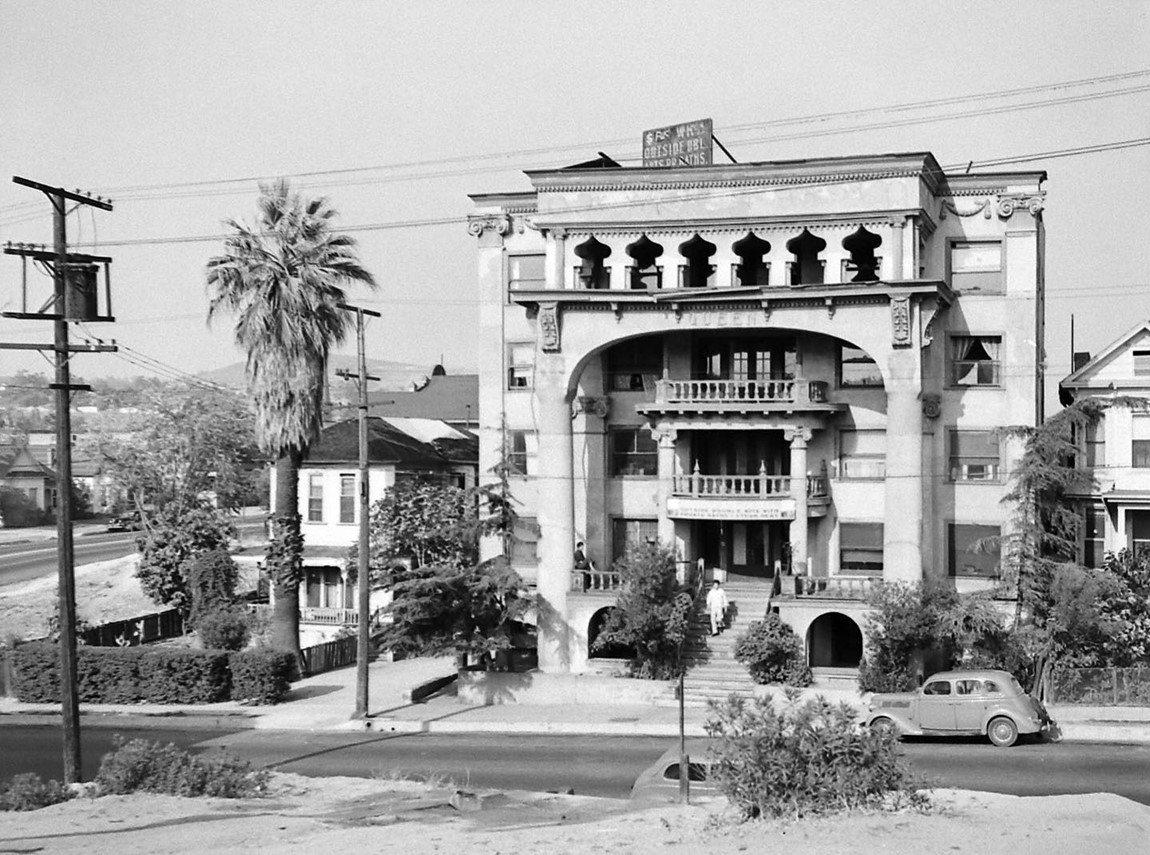 |
|
| (1945)* - The Queen Apts located at 529 California Street. It was demolished the 1950s to make way for the 101 Freeway through downtown LA. Photo by Walter Sanders |
Historical Notes California Street (originally Sand Street) was located one block north of Temple Street in Downtown Los Angeles. It is where the 101 Freeway is today. |
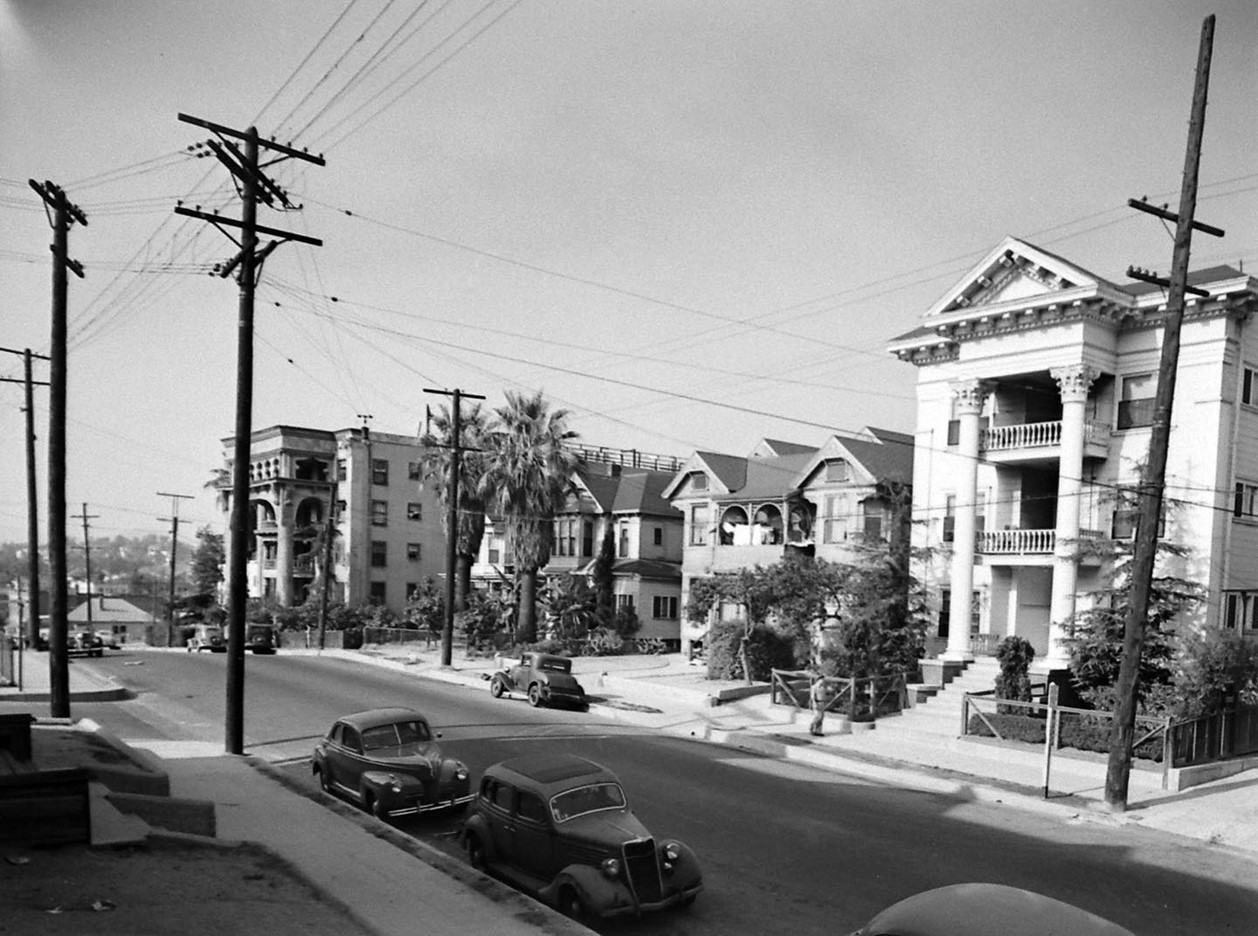 |
|
| (1945)* - Waldron Apts at 509 California Street, with the Queen Apts seen in the distance. |
* * * * * |
Lima Apartments Hotel
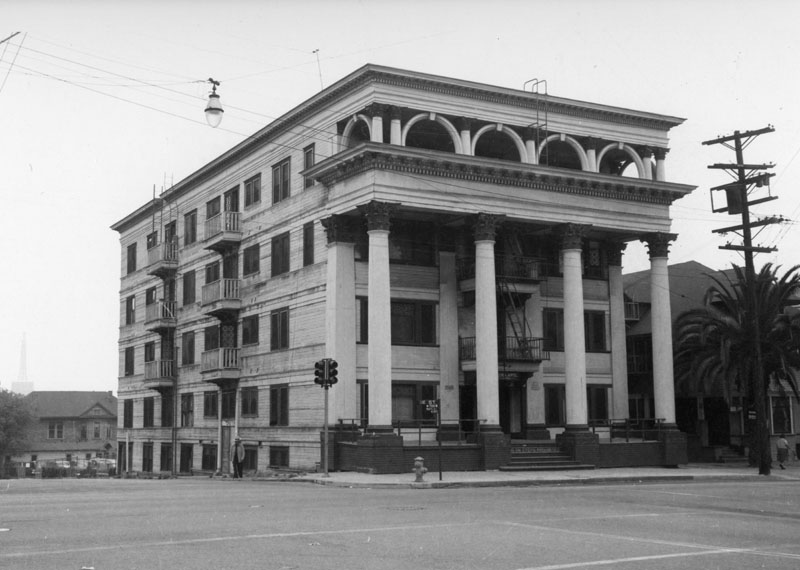 |
|
| (ca. 1955)* - Looking southwest across the intersection of W. First Street (running left to right in the foreground) and S. Hope Street, showing the Lima Apartments, also known as the Lima Apartments Hotel, located at 700–702 W. First Street. |
Historical Notes Built around 1900–1905, this three-story masonry apartment house with Edwardian and Classical Revival influences stood on the southwest corner of First and Hope Streets in the Bunker Hill district. Like many such structures on Bunker Hill, the Lima began as a respectable middle-class residence before evolving into a residential hotel—a common form of affordable urban housing in the early 20th century. By the postwar years, these once-elegant buildings reflected the area’s decline, offering low-cost rooms to seniors and working-class tenants. The Lima stood as a modest but characteristic survivor of old Bunker Hill’s apartment era until it was cleared by the Community Redevelopment Agency (CRA) during the sweeping urban renewal of the mid-1960s. Demolished c. 1965–1966 during the Bunker Hill Redevelopment Project. |
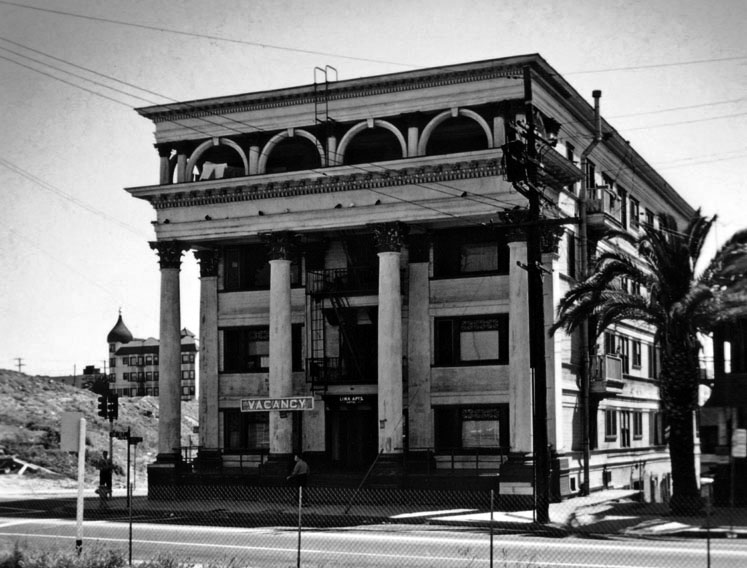 |
|
| (ca. 1964)* - View showing the Lima Apartments Hotel on the southwest corner of First and Hope Streets. On the far left is a glimpse of the Dome Hotel Apartments, located on the southwest corner of 2nd and Olive Streets—another residential hotel soon lost to redevelopment. |
Historical Notes By the early 1960s, the city and federal redevelopment programs were transforming Bunker Hill. Photographs like this, taken just before demolition, document the final years of the hill’s residential hotels, once home to thousands of downtown residents. Today, the site of the Lima Apartments lies within the Bunker Hill Cultural Complex. The Lima’s former parcel is now part of the landscaped open space that links these civic landmarks—symbolizing Los Angeles’ transformation from a once-crowded residential hill to a modern cultural center. |
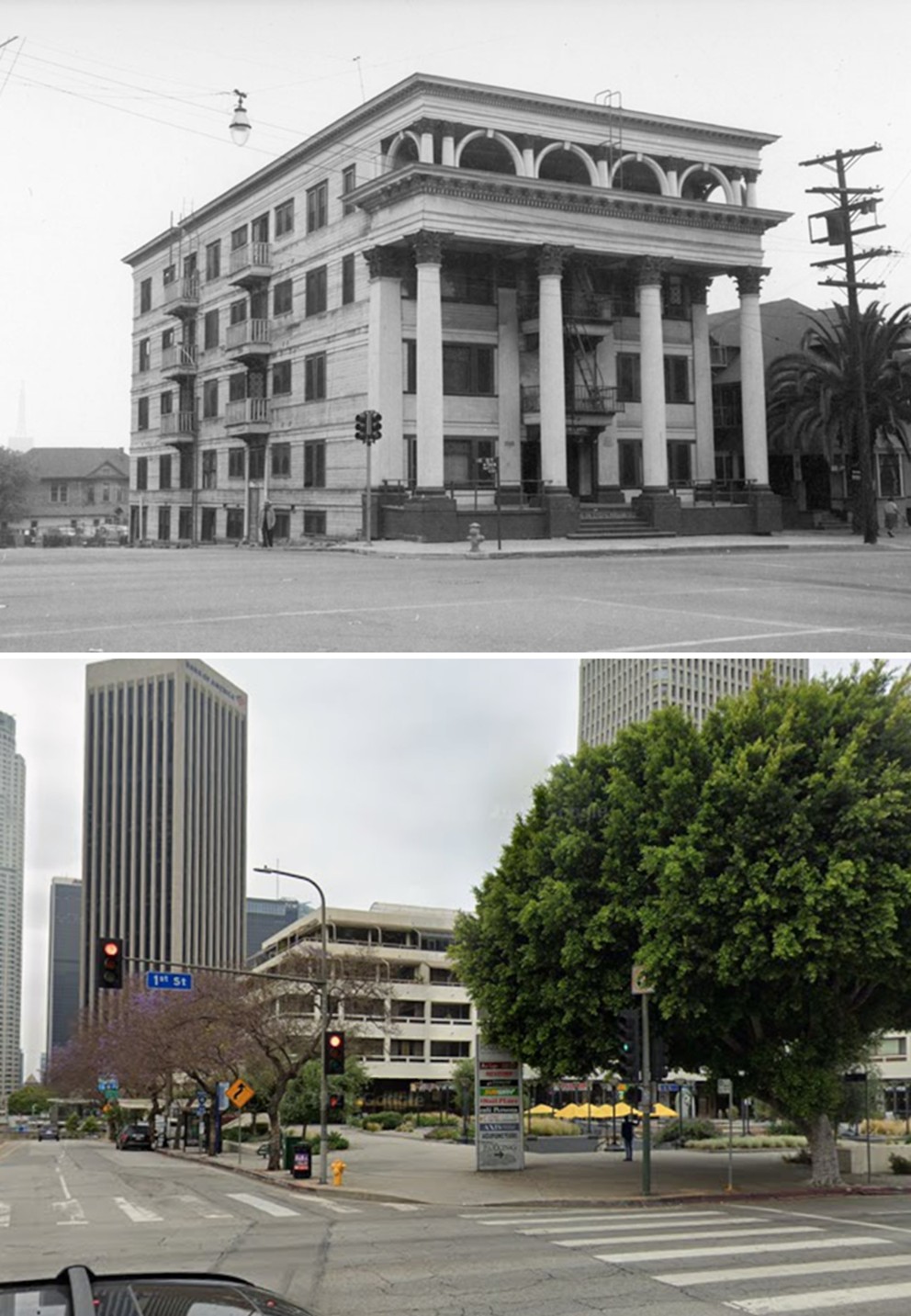 |
|
| (1955 vs. 2024)* – Looking at the southwest corner of Hope and 1st Streets. The Lima Apartments Hotel once stood here; today the site is the Promenade Plaza in front of the Promenade Residences building. Photo comparison by Jack Feldman. |
Historical Notes The southwest corner where the Lima Apartments once stood is now occupied by the Promenade Residences at 121 S. Hope Street, with Promenade Plaza forming the landscaped terrace in front. Completed in 1980, the Promenade was among the first residential projects to bring housing back to the redeveloped Bunker Hill area. Its stepped design and open plaza stand in contrast to the densely built apartments that once defined the neighborhood, reflecting the district’s evolution from early 20th-century residential hotels to the modern skyline seen today. |
* * * * * |
Purser Apartments
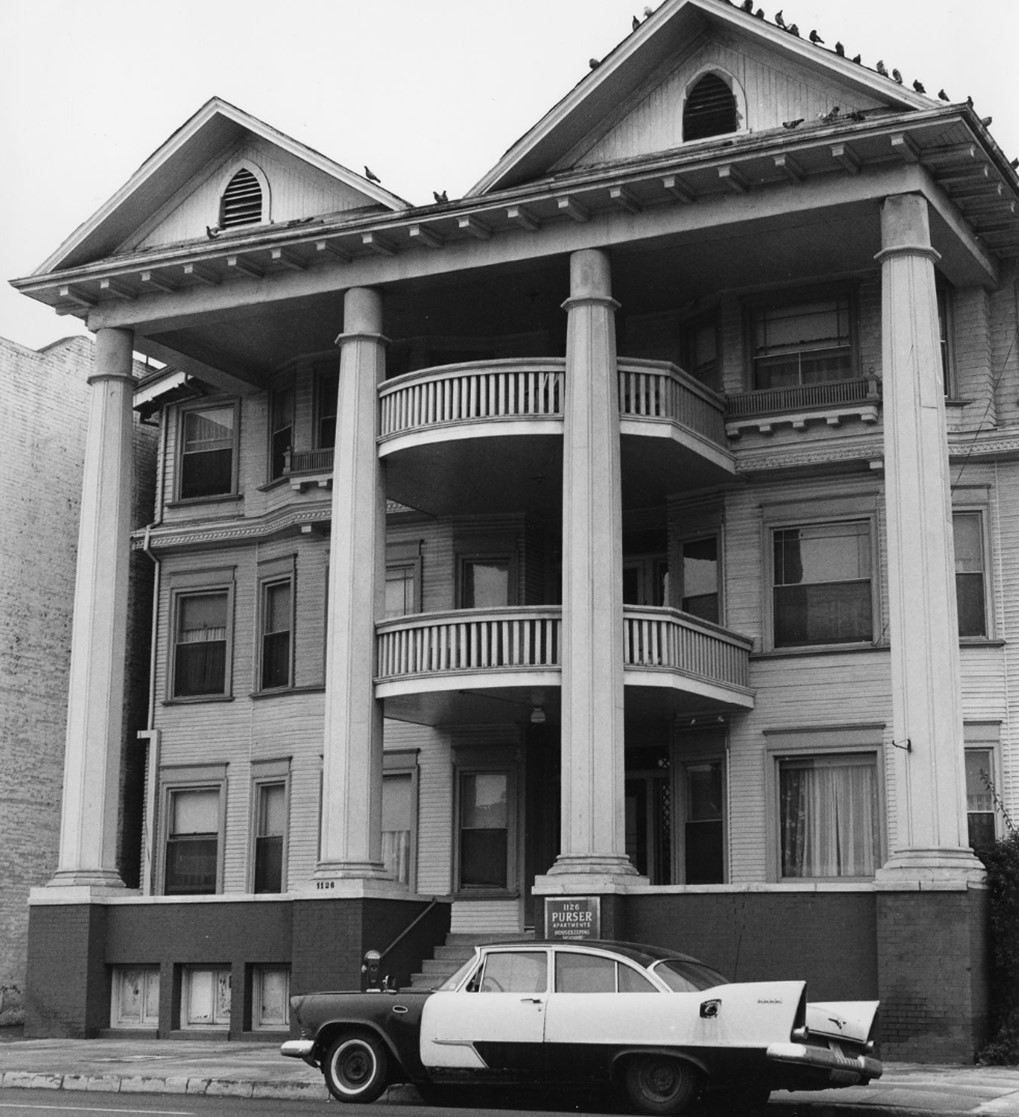 |
|
| (1965)* - The Purser Apartments at 1126 S. Olive Street. This multi-story clapboard building features four tall columns, with two supporting graceful balconies. Pigeons perched along the roofline and a classic car parked in front lend a nostalgic charm to the scene. Photo by William Reagh. |
Historical Notes Photographer William Reagh documented the Purser Apartments in 1965 as one of the last wood-frame, veranda-style apartment houses lingering in the South Park area of downtown Los Angeles. Library catalog records confirm the address, date, and photographer, and describe the same clapboard façade with full-height columns and stacked porches shown here. While no architect or exact construction date has been identified in the public catalogs, the building’s form fits early 20th-century apartment types that once lined nearby streets before mid-century redevelopment. Reagh’s image preserves the “everyday” residential fabric that was fast disappearing from this part of downtown. |
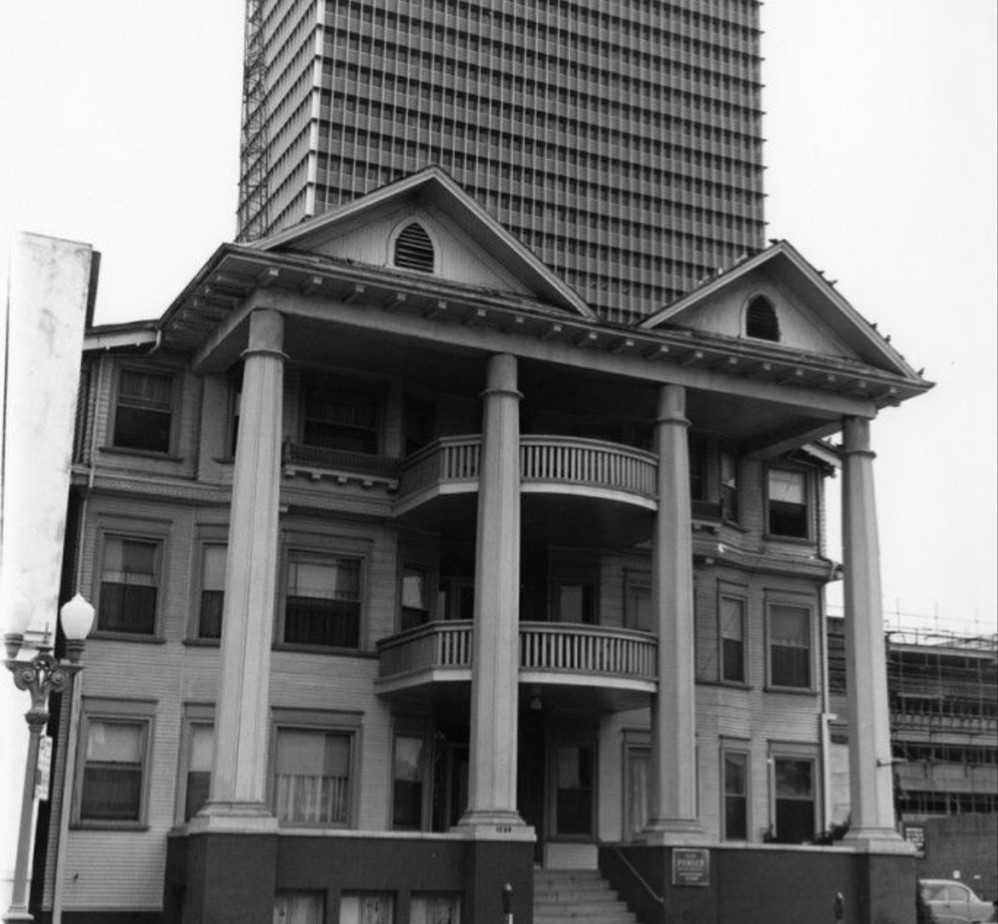 |
|
| (1965)*– The Purser Apartments at 1126 S. Olive Street in downtown Los Angeles, with a high-rise in the background. Photo by William Reagh. |
Historical Notes The high-rise behind the Purser is the Occidental Life Building at 1150 S. Olive Street, later known as the Transamerica and AT&T Center and today called USC Tower at South Park Center. Designed by William Pereira & Associates, construction started in 1962 and the 32-story tower was completed in 1965. Reagh’s pairing of the wooden Purser in the foreground with this glass-and-steel skyscraper captures a turning point for South Park, when small, older apartments gave way to corporate modernism and larger commercial projects. The same tower remains a district landmark today as part of the South Park Center complex. |
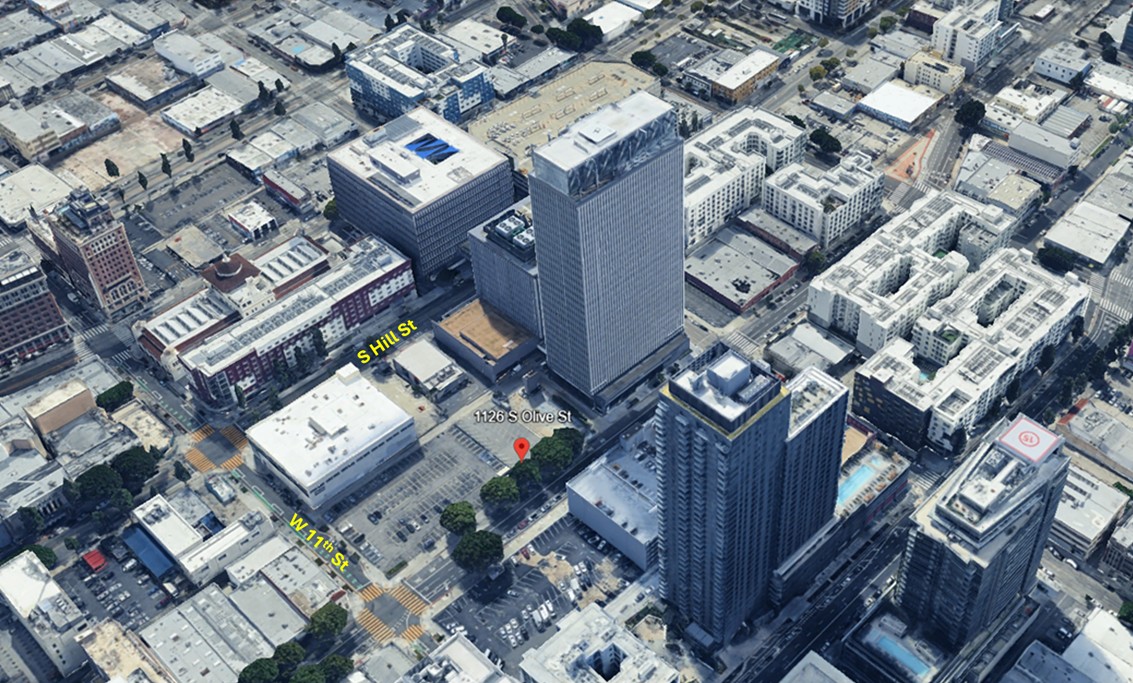 |
|
| (2024)* - Google Earth view showing the location of where the Purser Apartments once stood. Today the site is a parking lot. |
Historical Notes The former Purser address sits within the 1100–1130 block of South Olive Street. City planning documents describe these corners at Olive and 11th as existing surface parking lots targeted in recent years for large mixed-use proposals. In 2024 the City released a Sustainable Communities Environmental Assessment for the “DTLA South Park Properties, Sites 2 and 3,” covering 1105–1123 S. Olive (southwest corner) and 1100–1130 S. Olive (southeast corner). Those filings confirm the present-day parking use and outline potential high-rise redevelopment. Separate plans across the street at 1120 S. Olive were withdrawn in September 2025, underscoring that while redevelopment pressure is ongoing, the immediate Purser frontage remains a surface lot at this time. |
* * * * * |
Downey Estate
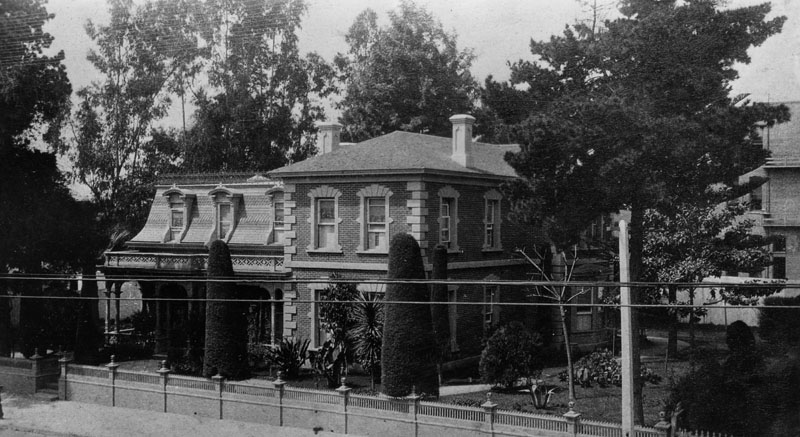 |
|
| (ca. 1888)* - Exterior view of the Governor John Gately Downey estate at 345 S. Main Street, near 3rd Street. The house is a Second Empire residence with a mansard roof and ornamental ironwork, typical of the period. |
Historical Notes John G. Downey (California governor, 1860–1862) made his home at 345 South Main Street, where he died on March 1, 1894. Contemporary reports identify the address and confirm his death at the residence. Architecturally, sources describe the house as a modestly scaled Second Empire design with a mansard roof, dormers, an inset front porch, and decorative iron cresting—features visible in period photographs. The location is consistently recorded as Main Street near Third. Downey played a central role in early Los Angeles banking. In 1871 he joined financier Isaias W. Hellman and others to found the Farmers and Merchants Bank; multiple histories note that Downey served as the bank’s first president before Hellman succeeded him in 1876. The institution became Los Angeles’ leading bank and helped finance growth along Main Street, only a few blocks from Downey’s residence. Downey’s broader legacy extended to the founding era of the University of Southern California and to the community that bears his name. USC’s own history notes his early trustee role alongside Ozro W. Childs and I. W. Hellman, while the City of Downey took its name from his landholdings and subdivision efforts in the 1870s. The Main Street house itself appears frequently in institutional photo catalogs under “Ex-Gov. Downey’s Home,” reinforcing the identification and its proximity to Third Street. Later city views and surveys suggest the residence was removed during downtown’s commercial buildout, but published records do not provide a firm demolition date; by the early twentieth century, larger commercial structures dominated this stretch of Main. |
* * * * * |
Bryson-Bonebrake Block
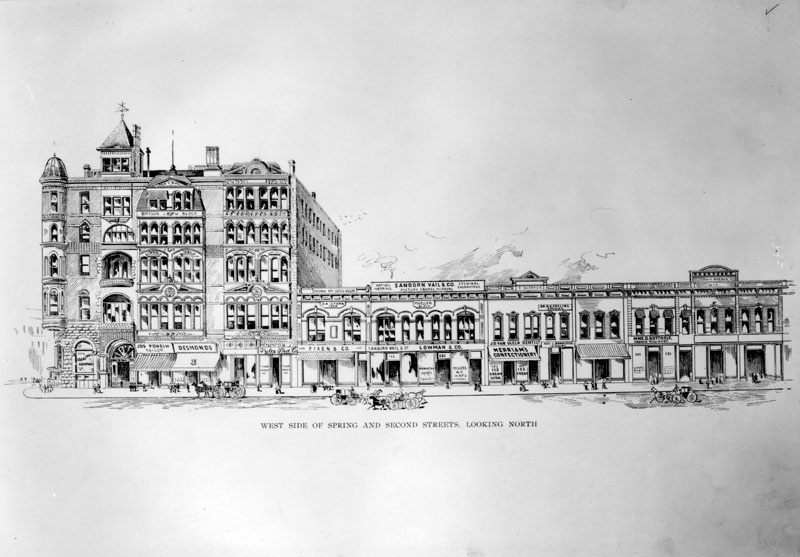 |
|
| (ca. 1888)* - Drawing of the west side of Spring Street, including the Bryson-Bonebrake Block on the left, between 1st and 2nd Streets. |
Historical Notes Designed by architects Joseph Cather Newsom and Samuel Newsom, the Bryson-Bonebrake Block was completed in 1888. The 126-room bank and office building cost $224,000, a staggering sum at the time. Bonebrake was one of the richest men in the city at the time, and he could afford making such an investment. He located the main headquarters of his bank in the Bryson-Bonebrake Block. |
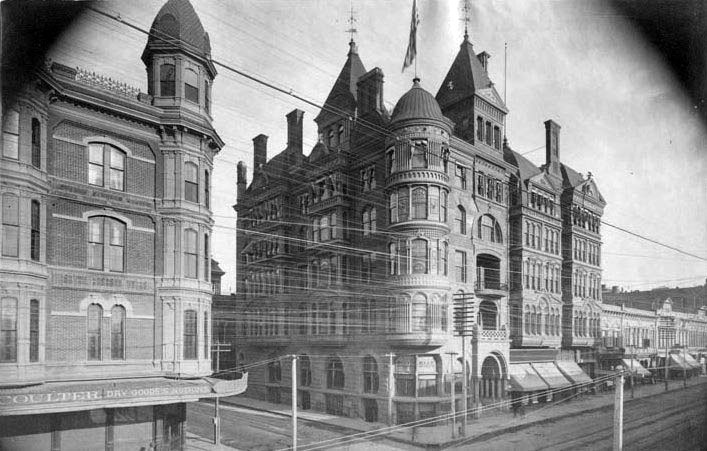 |
|
| (ca. 1888)* - View of the Bryson-Bonebrake Block located on the northwest corner of Spring and Second streets. |
Historical Notes The Bryson-Bonebrake Block was one of the more important office buildings built during the 1880s building boom in Los Angeles. It had six stories, with a typical Queen Anne Style variety of shapes, materials and ornamentation for which architect Joseph Cather Newsom was famous. |
 |
|
| (1888)* – Looking north on Spring Street toward 2nd Street showing horse-drawn wagons and a street car in front of the Hollenbeck Hotel left and the Bryson Building on the NW corner. |
Historical Notes Two highly influential figures in 1880s Los Angeles, John Bryson, Sr., the 19th mayor, of LA and Major George H. Bonebrake, President of the Los Angeles National Bank and the State Loan and Trust Company, commissioned Joseph Cather Newsom to erect this 126-room bank and office building. It's cost was projected to be $224,000, a staggering sum at the time. Bonebrake was one of the richest men in the city at the time, and he could afford making such an investment. He located the main headquarters of his bank in the Bryson-Bonebrake Blocks. |
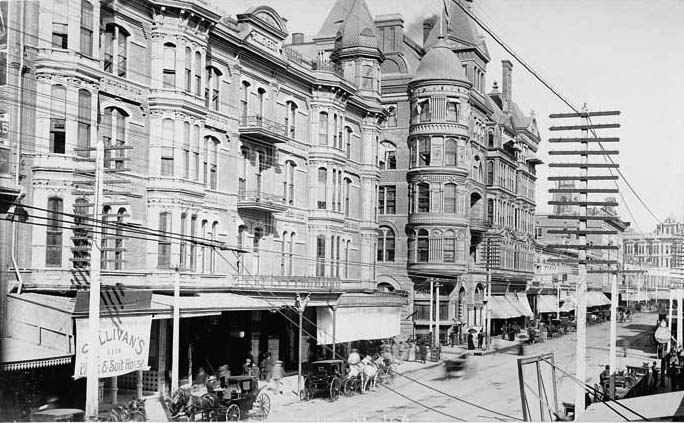 |
|
| (1890)* - View of Spring at 2nd Street looking north. The Hollenbeck Hotel is seen on the left and the Bryson-Bonebrake Building is on the right. Horse-drawn carriages are parked in front of the hotel. |
Historical Notes The Bryson-Bonebrake Building housed Desmond's department store from 1890 to 1900. |
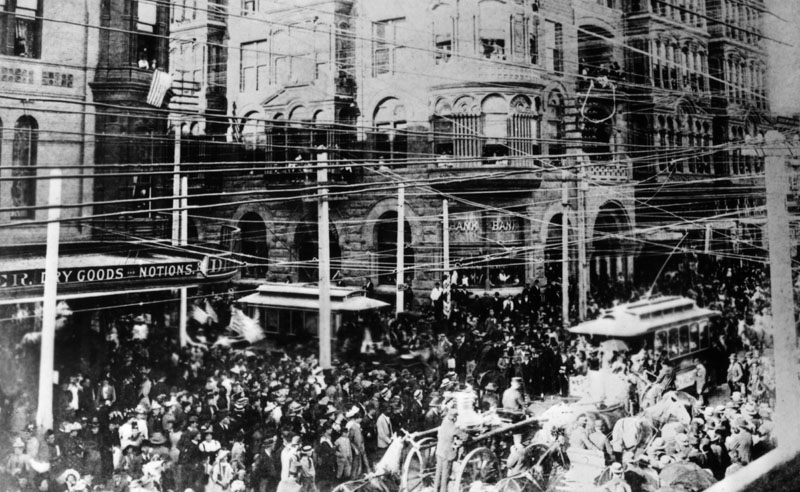 |
|
| (1892)* - A Columbus Day parade on October 26, 1892, on Spring and 2nd Streets. The Bryson-Bonebrake Building is on the right and the Hollenbeck Block on the left. |
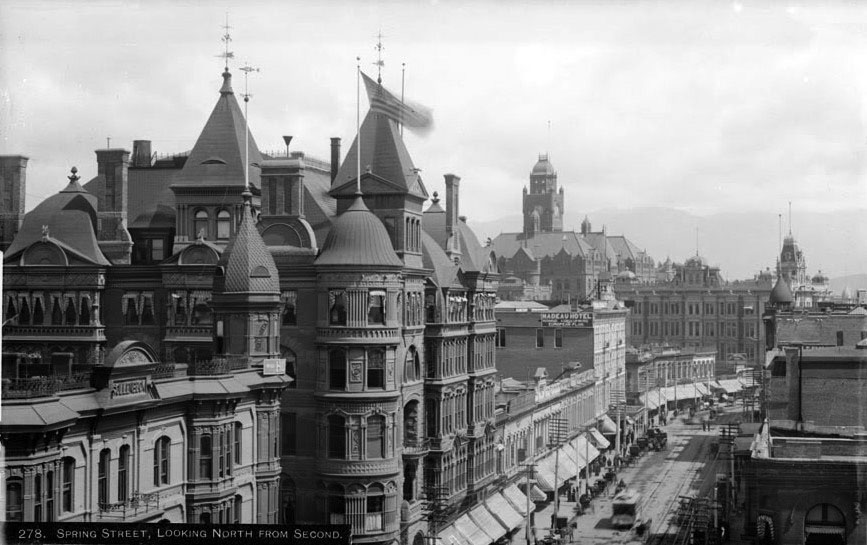 |
|
| (ca. 1895)* - View of Spring Street looking north from Second. The Bryson-Bonebrake Block is seen on the northwest corner of Spring and Second streets. The Hollenbeck Hotel is seen across the street (left of photo). Both the LA Country Courthouse and the Phillips Block can be seen in the background. Photo by C.C. Pierce |
Historical Notes The building was described as "nothing short of amazing, displaying a riotous and eclectic amalgam of features" and was considered a landmark in late 19th century Los Angeles. |
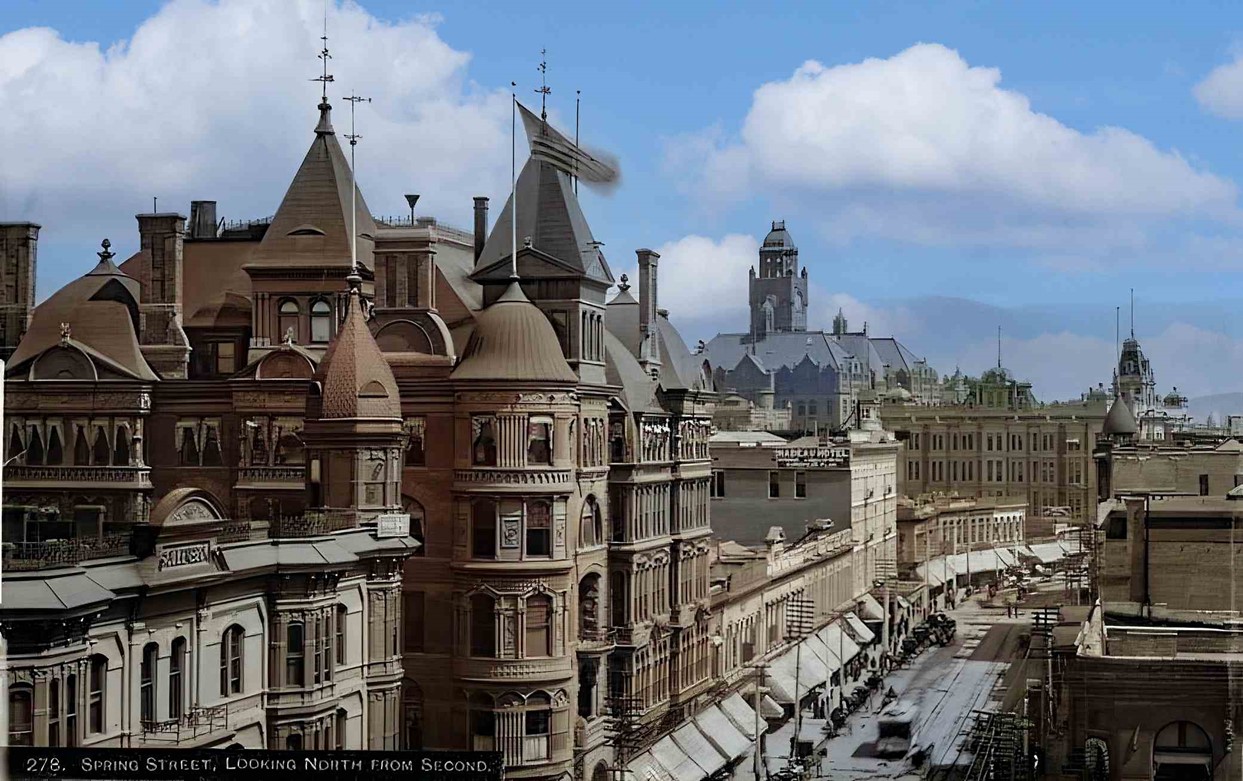 |
|
| (ca. 1895)*- View of Spring Street looking north from Second. The Bryson-Bonebrake Block is seen on the northwest corner of Spring and Second streets. The Hollenbeck Hotel is seen across the street (left of photo). Both the LA Country Courthouse and the Phillips Block can be seen in the background. Photo by C.C. Pierce, AI image enhancement and colorization by Richard Holoff |
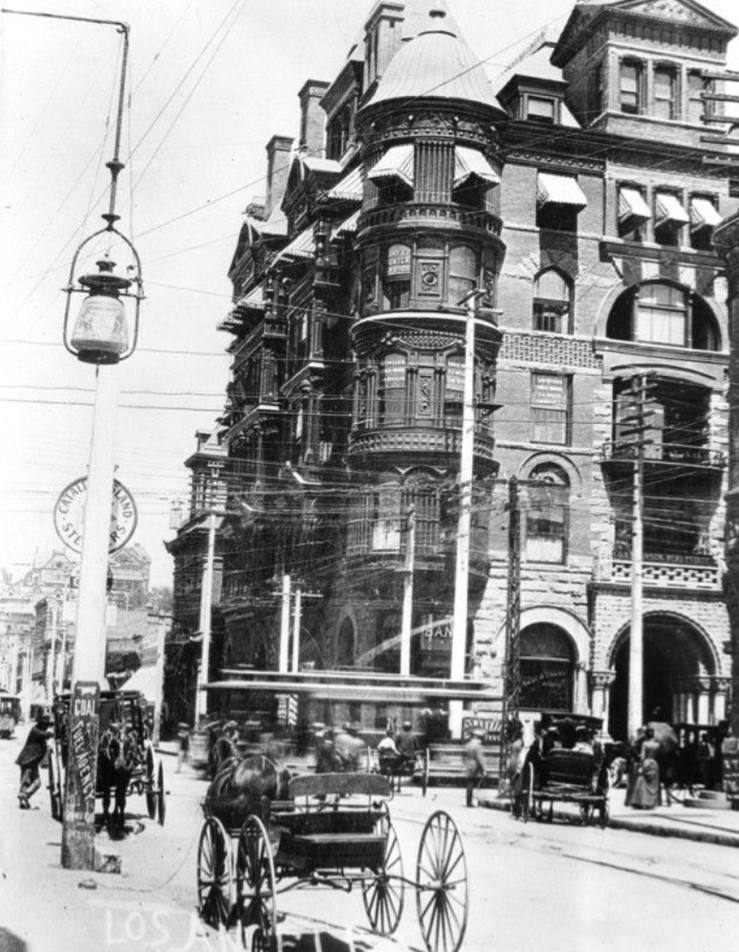 |
|
| (ca. 1900)* – Looking west on 2nd Street toward Spring Street where the Bryson-Bonebrake Building stands on the NW corner. Note all the horse-drawn carriages parked along the curb. |
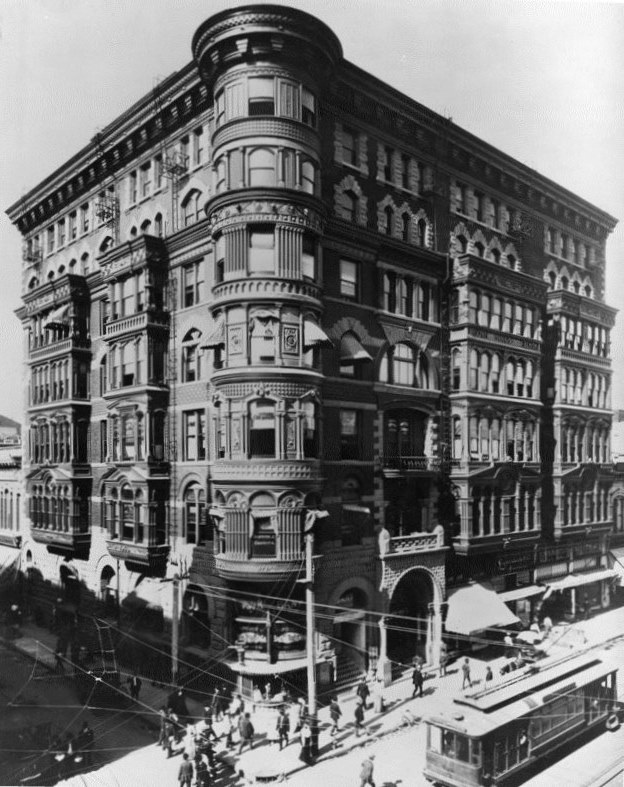 |
|
| (ca. 1904)* - View of the Bryson-Bonebrake Building located at the northwest corner of 2nd and Spring. Note how the roofline has been shaved off, including towers, domes, and chimneys, to make room for two additional stories (see previous photos). |
Historical Notes In 1902-1904, two additional stories were added to the original structure. |
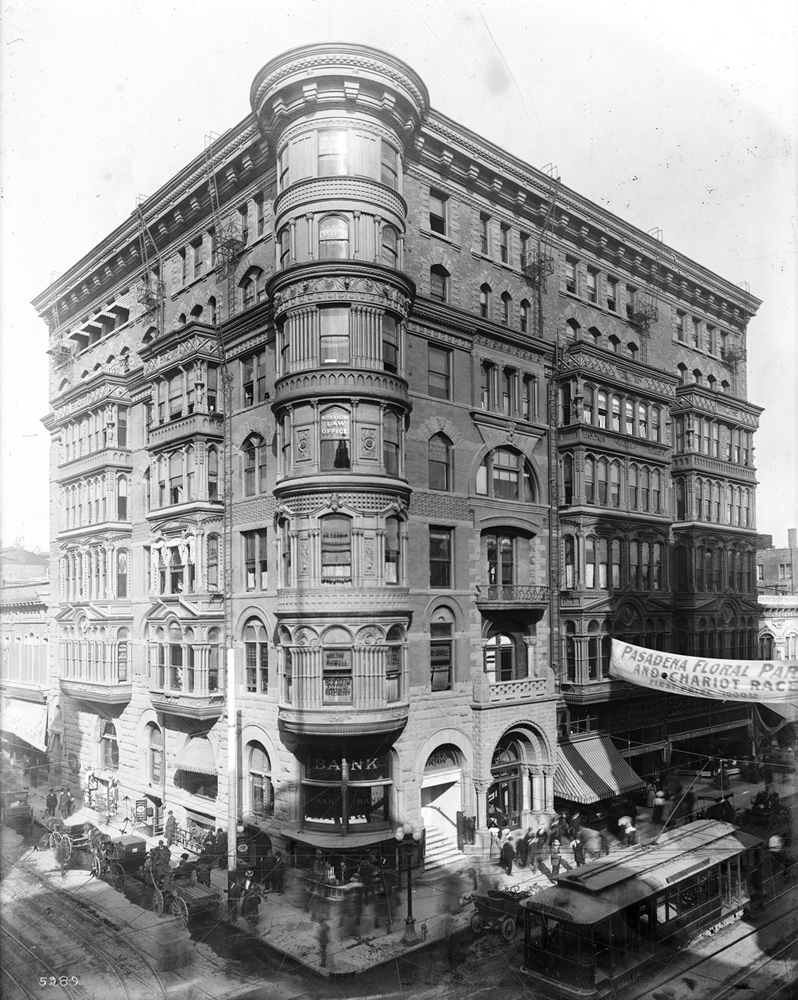 |
|
| (1905)* - Photograph of the Bryson-Bonebrake Block on the corner of Second Street and Spring Street. The eight-story building towers above the streets and other buildings nearby. The first two floors are constructed of stone masonry, while the top two floors are constructed of brick. The building has a circular, tower-like corner. A street banner announces, "Pasadena floral parade and chariot races, first prize $1000.00." The street is busy with pedestrian, bicycle, horse-drawn carriage, early model car and streetcar traffic. |
Historical Notes While an architectural landmark when built in 1888, the Bryson-Bonebrake Building was expanded vertically in the early 1900s before being torn down in 1934 after over 45 years at that prominent downtown Los Angeles intersection. |
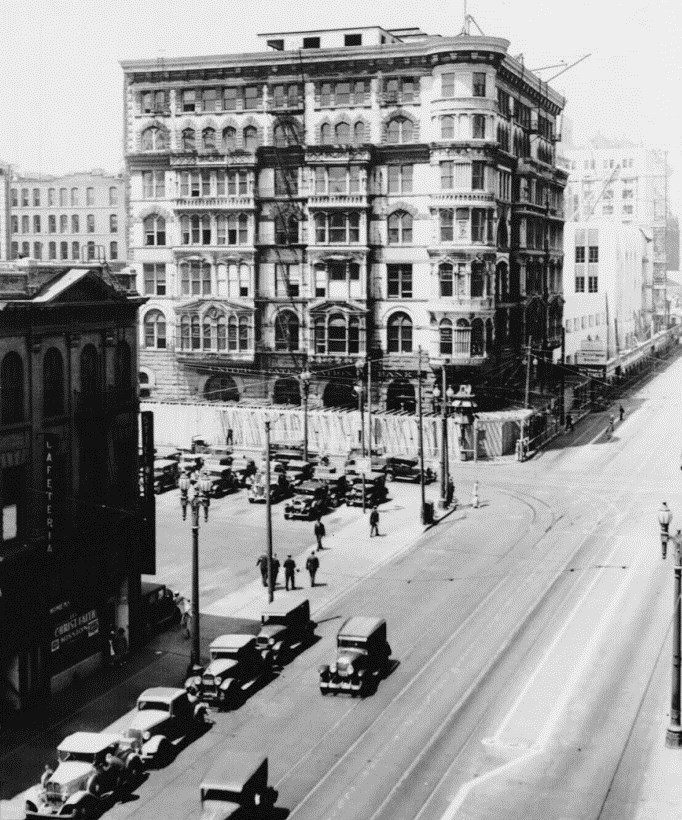 |
|
| (1934)* - Only 46 years after its construction, demolition of the Bryson Block is underway. |
Historical Notes The Bryson-Bonebrake Building stood at the northwest corner of Spring and 2nd Streets until its demolition in 1934 to make way for the 1948 Crawford Addition building, part of the Times Mirror Square complex. |
* * * * * |
Hollenbeck Hotel (aka Hollenbeck Block)
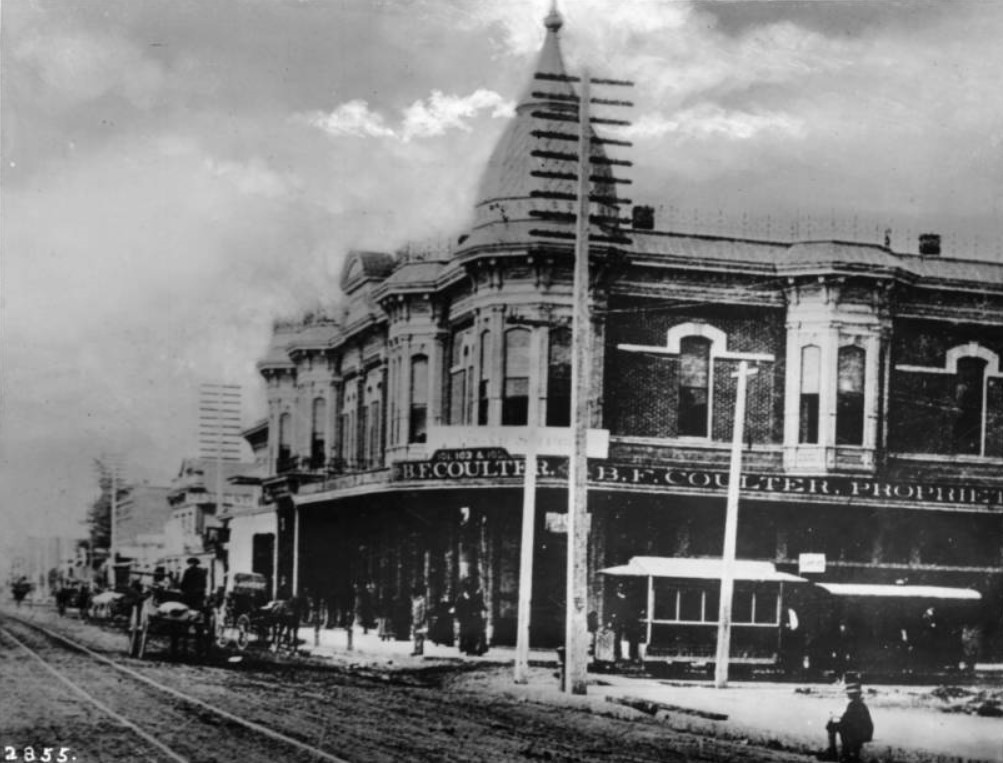 |
|
| (1886)* - View of the southwest corner of Spring and Second streets showing the B.F. Coulters store on the ground floor of the Hollenbeck Hotel. A streetcar is stopped along Second Street. A series of utility poles are visible looking up Spring Street in front of the store. Horse-drawn wagons, carriages, and pedestrians are on the dirt street and sidewalk. Legible signs include: "101, 103 & 105, B.F. Coulter, proprieter"; "Coulters Store in the Baker Block is to be closed Feb. 1 and all business of the firm will hereafter be done in the Hollenbeck block, corner Spring & Second Streets" -- 10 January 1886. |
Historical Notes The Hollenbeck Hotel was constructed in 1884 at Spring and Second streets. The hotel was named for its owner, John Hollenbeck, a prominent investor, banker, and owner of large landholdings in the Boyle Heights area. A leading hotel in its day, it was designed by Robert Young, an architect responsible for several early downtown hotels, including the Lankershim, the Lexington, and the Westminster. |
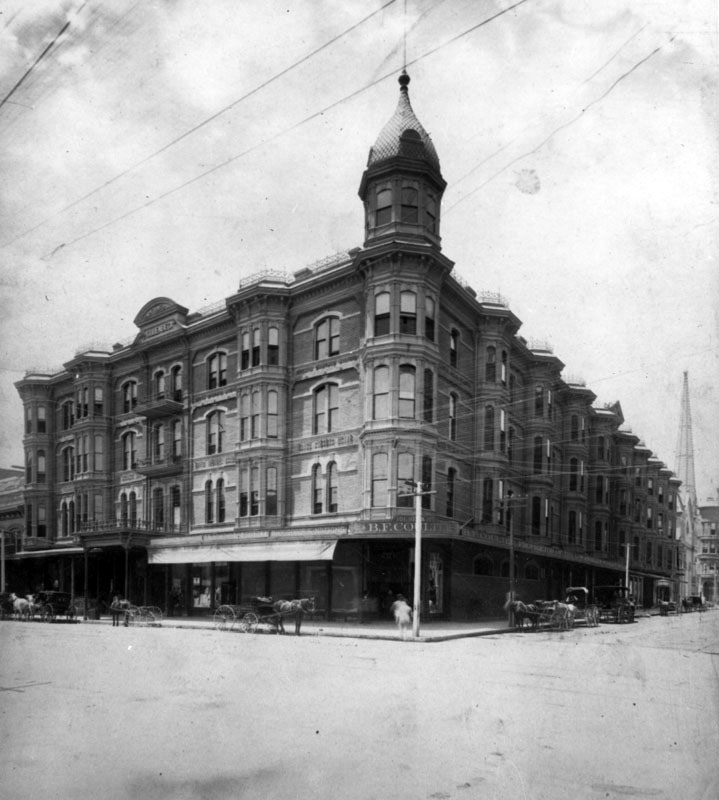 |
|
| (ca. 1888)* - View of the Hollenbeck Block shortly after it was enlarged to include a 3rd and 4th floor (see previous photo). The Hollenbeck Hotel entrance is to the left, and Coulter's Dry Goods store occupies a portion of the first floor. Several horse-drawn wagons are seen parked in front. In the distance is the tall spire of the First Presbyterian Church, located on the southeast corner of 2nd Street and Broadway. |
Historical Notes B. F. Coulter was one of the earliest merchants in Los Angeles. The Coulter's Dry Goods business dates from 1878 and later was called Coulter's. Coulter was an ordained minister and founded the Broadway Christian Church. The business was continued by B.F. Coulter's son-in-law, R. P. McReynolds, and his son, James McReynolds. |
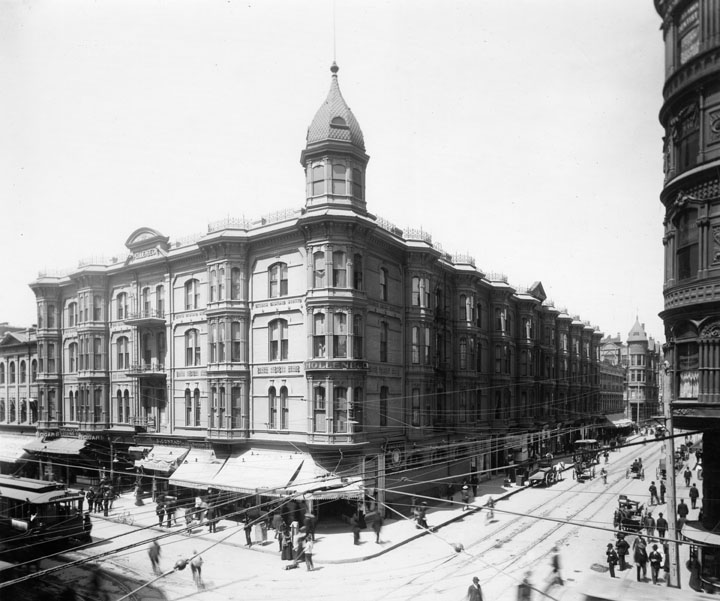 |
|
| (ca. 1890)* - The Hollenbeck Hotel sits on the southwest corner of Spring and Second behind trolley lines extending up and down the streets on both sides. On the street are people, a trolley, horses and buggies. A portion of the Bryson-Bonebrake Building can be seen on the right. |
Historical Notes John Edward Hollenbeck (June 5, 1829 - September 2, 1885) was an American businessman and investor who was involved in the 19th century development of Nicaragua and the city of Los Angeles, California. Arriving in Los Angeles a wealthy man from his investments in Nicaragua in 1876, Hollenbeck purchased land on the east side of the Los Angeles River, and built a large residence with broad verandas and a tower on extensive grounds on Boyle Avenue. He made twenty-seven acquisitions of property by 1880. In 1884 he purchased and developed an urban business district, known as the Hollenbeck Block, within Los Angeles. In 1878 Hollenbeck became a stockholder in the Commercial Bank of Los Angeles, and was elected its president. In 1881, he and other investors organized and established the First National Bank. In 1880, Hollenbeck, with former California Governor John G. Downey, horticulturalist Ozro W. Childs and other associates, persuaded the State of California to purchase 160 acres in Los Angeles to foster agriculture in the southland. The property, then known as Agriculture Park, is now known as Exposition Park, home to the Los Angeles Coliseum and the Los Angeles County Museums. |
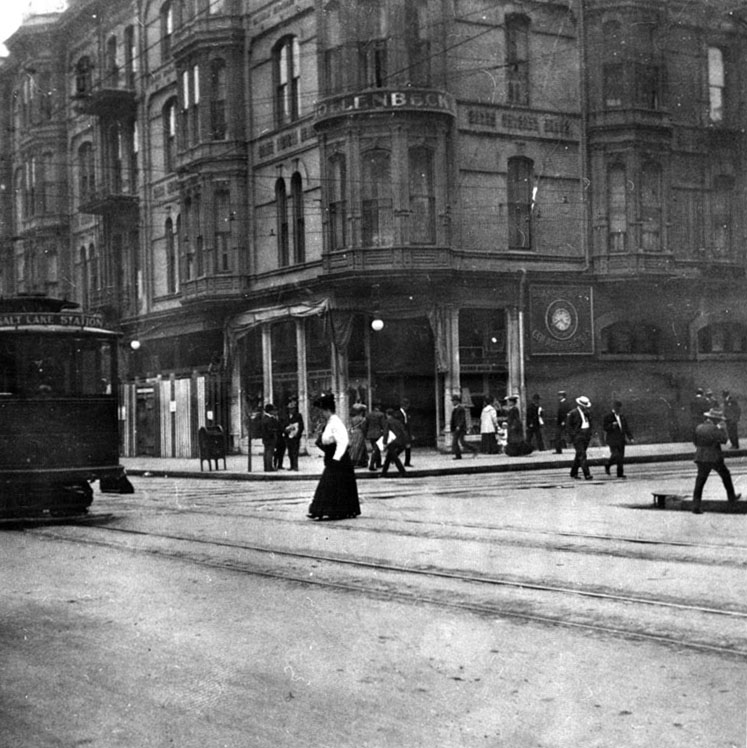 |
|
| (ca. 1900)* - The intersection of Spring and 2nd Street, showing the Hollenbeck Block on the southwest corner. An electric trolley car heading to the Salt Lake Station is seen. A woman appears to walking in toward the trolley. |
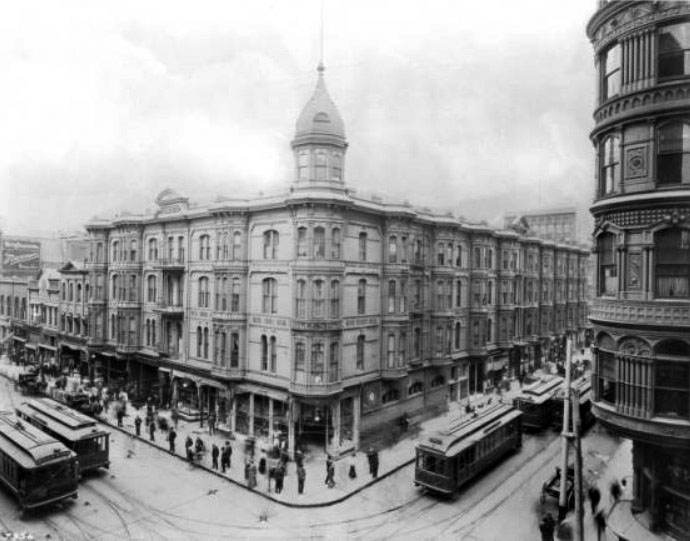 |
|
| (ca. 1905)* - Exterior view of the Hollenbeck Hotel at the intersection of Second Street and Spring Street. Streetcars are pictured making their way down either side of the three-story Romanesque hotel, which is pictured on the southwest corner at center. Pedestrians, including a man riding a strange, bicycle-like contraption can be seen navigating the sidewalks. The column of a larger building is visible in the right foreground. The signs on the streetcars read "Hollywood", "Griffin Ave.", "Redondo", and "2nd & Spring Streets". |
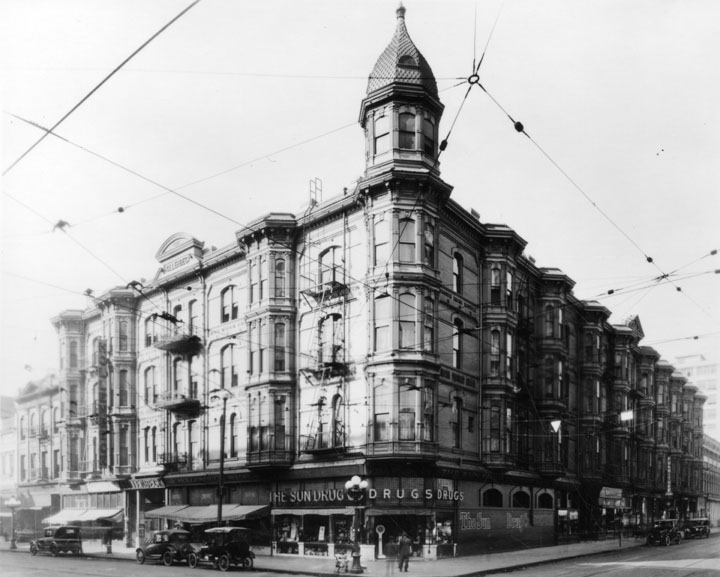 |
|
| (ca. 1920)* - The Hollenbeck is seen standing regally behind some trolley lines crossing in front and extending down the streets. Cars can be seen in the street and some people. A drug store now occupies the street level corner of the building. |
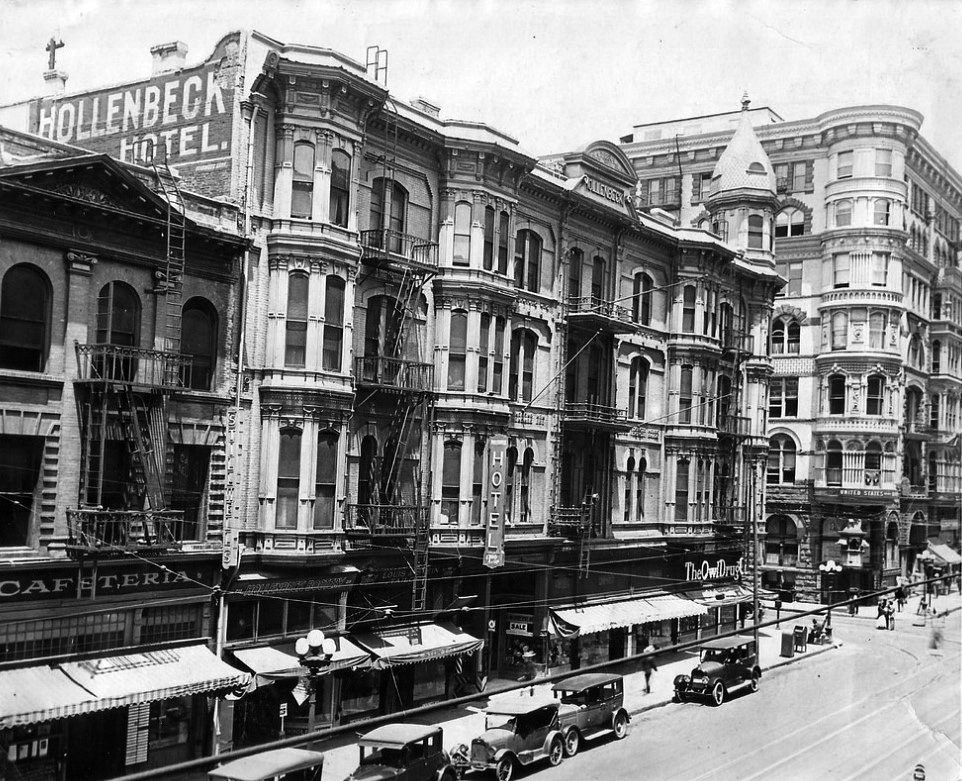 |
|
| (1926)* - The Hollenbeck Hotel and the Bryson Building, 2nd and Spring Streets. |
Historical Notes The Hollenbeck will be gone by late 1931 (in favor of a parking lot) and the Bryson in 1934 (with the coming of the Times building). |
* * * * * |
City Hall (1884 - 1888)
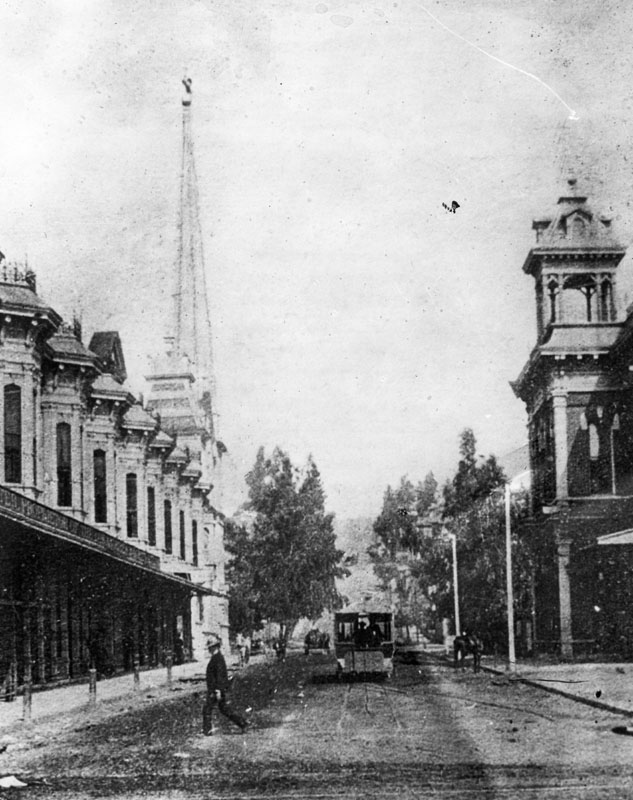 |
|
| (1880s)* - View looking west on 2nd Street from Spring Street. The building to the right was Los Angeles City Hall between 1884-1888 (site of current Los Angeles Times Building). The tall spire in the background is the First Presbyterian Church located on the southeast corner of 2nd and Fort Street (later Broadway). |
Historical Notes The following historical timeline lists the buildings used by City Council, also known as City Hall, since 1850, when Los Angeles was incorporated as a municipality: ◆ 1850 - 1853 - used rented hotel and other buildings for City meetings ◆ 1853 - rented adobe house (aka Rocha Adobe) on Spring Street - across from current City Hall (now parking lot for Clara Shortridge Foltz Criminal Justice Center). The buliding was shared with the County who used it as a Court House. ◆ 1861 - moved into John Temple's Clocktower Market Building, but only stayed for less than a year before the County Court House moved-in ◆ 1861 - 1884 - relocated back to the Rocha Adobe and stayed for over 20 years ◆ 1884 - 1888 - moved to new City Hall Building at South Spring Street and West 2nd Street (site of current Los Angeles Times Building) ◆ 1888 - 1928 - moved to new Romanesque Revival Building on 226-238 South Broadway between 2nd Street and 3rd Street; demolished in 1928 and now site of parking lot between LA Times Parking structure and 240 Broadway. ◆ 1928 - moved to current City Hall Building |
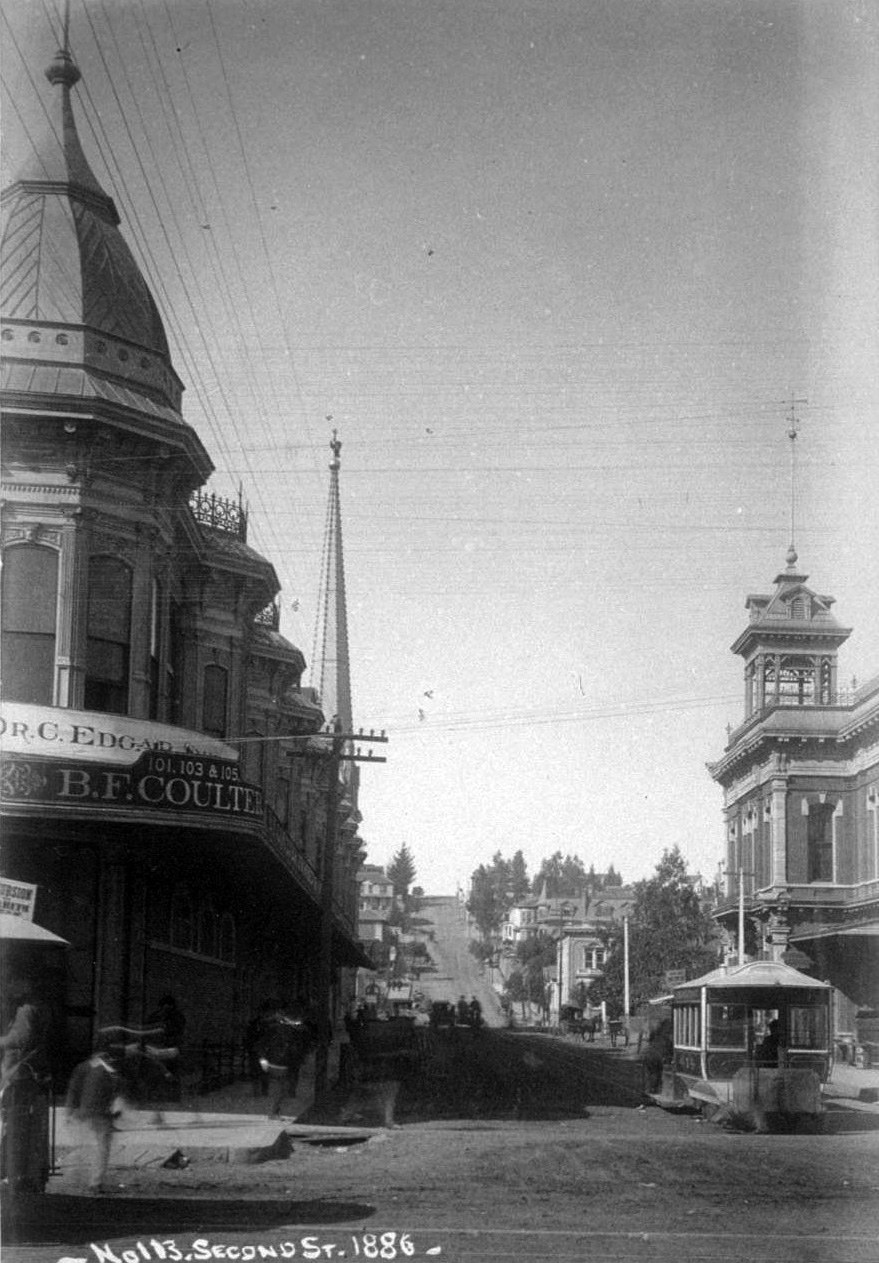 |
|
| (1886)^ - On the right behind the cable car is the Second Street City Hall. This is apparently the best available photo of the building when it was owned by the city. The two-story Hollenbeck Block (expanded to four stories in the second half of 1887) and the spire of the First Presbyterian Church are on the left in the photo, which looks west on Second from Spring. Construction of the California Bank Building on the southeast corner of Second and Fort (renamed Broadway in February 1890) has just begun. |
Then and Now
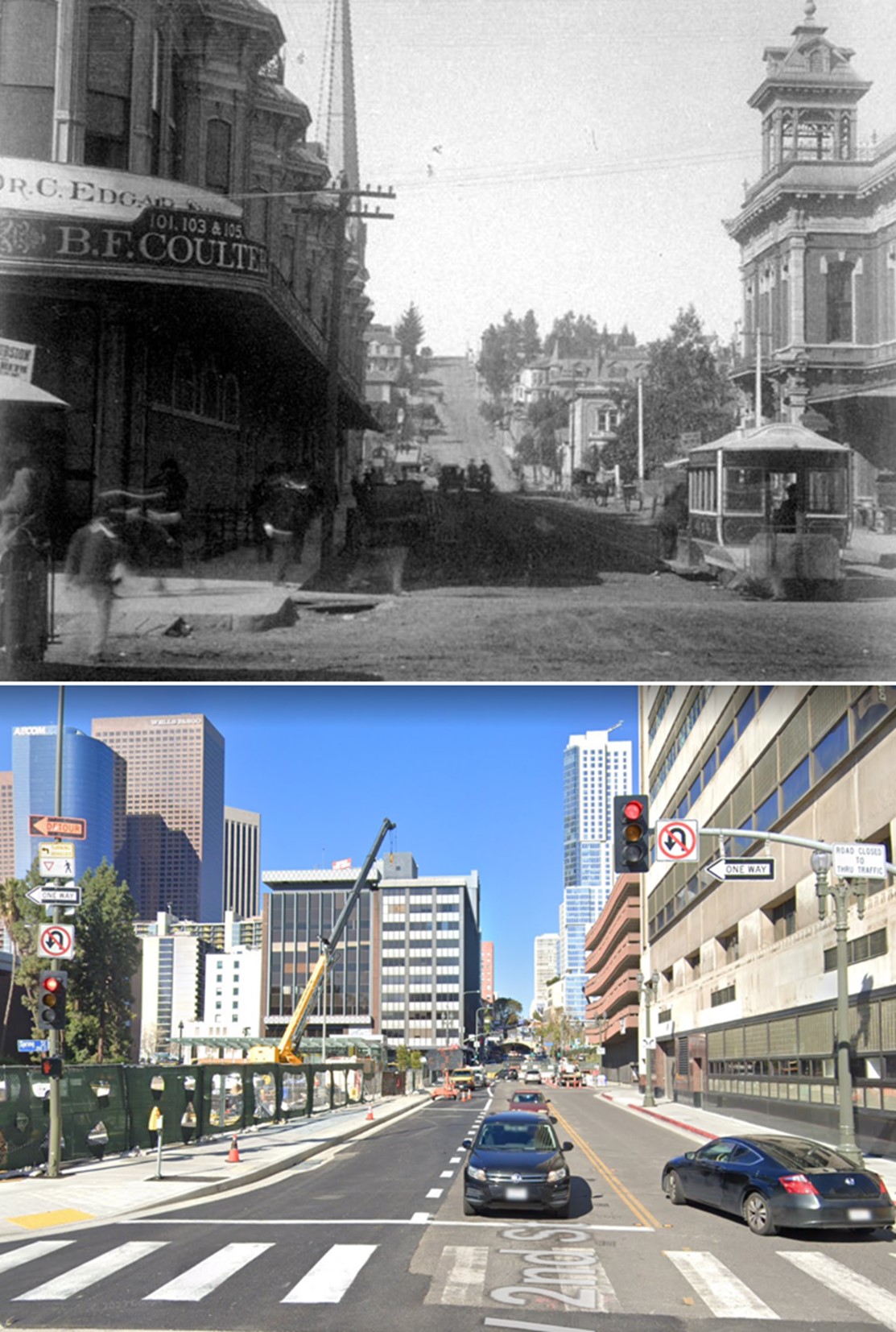 |
|
| (1886 vs 2023)* - Looking west on 2nd Street from Spring Street. |
 |
|
| (ca. 1888)^ - View looking at the northwest corner of 2nd and Spring streets showing the newly built Bryson-Bonebrake Block. On the left is the Hollenbeck Block shortly after it was enlarged to include a 3rd and 4th floor. Just to the left of the Bryson-Bonebrake Block can be seen part of the short-lived City Hall Building (1884 - 1888). |
Historical Notes The Bryson-Bonebrake Block was one of the more important office buildings built during the 1880s building boom in Los Angeles. It had six stories, with a typical Queen Anne Style variety of shapes, materials and ornamentation for which architect Joseph Cather Newsom was famous. Click HERE to see more early views of the Bryson-Bonebrake Block. |
City Hall (1888 - 1928)
 |
|
| (ca. 1889)* - Exterior view of the Old City Hall, located at 226 Broadway. It stood from 1888 until 1928. This was Los Angeles' third City Hall. The building to the left is the B'nai B'rith Temple (First Jewish Synagogue in Los Angeles). |
Historical Notes Built in 1888, this grand Romanesque edifice of marble and red sandstone building located at 226-238 South Broadway stood for 40 years until 1928 when the present day City Hall was completed. |
 |
|
| (ca. 1889)* - Los Angeles City Hall from 1888 until 1928, located at 226 Broadway. AI image enhancement and colorization by Richard Holoff |
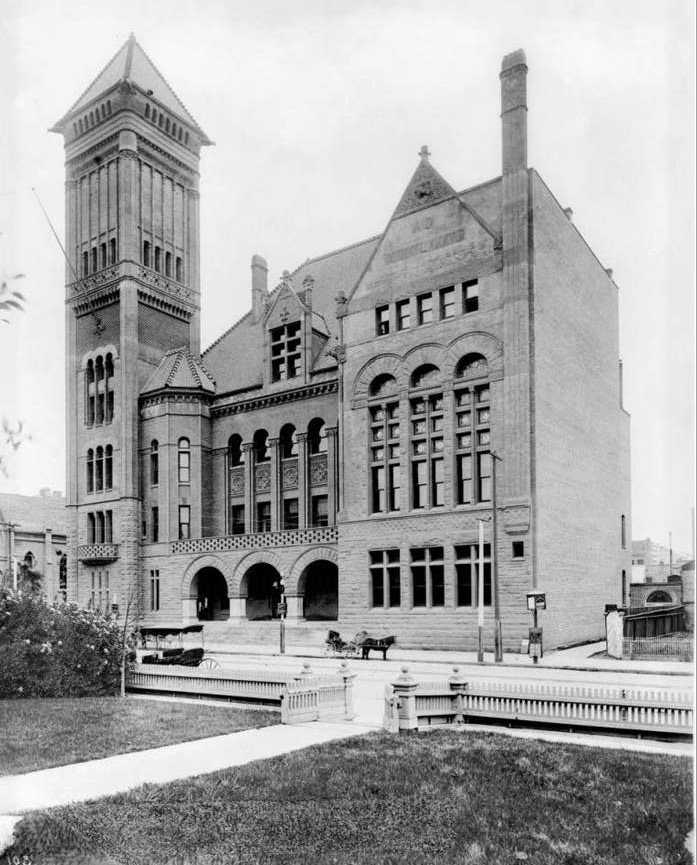 |
|
| (ca. 1890)^*# – View of City Hall as seen from the front yard of a home across the street. Two horse-drawn wagons are parked by the curb. |
Historical Notes Architectural plans for this building were submitted by Caukin & Hass and formally accepted by City of Los Angeles officials on July 7, 1887; the cost of the entire structure had to come within the limits of $150,000.* |
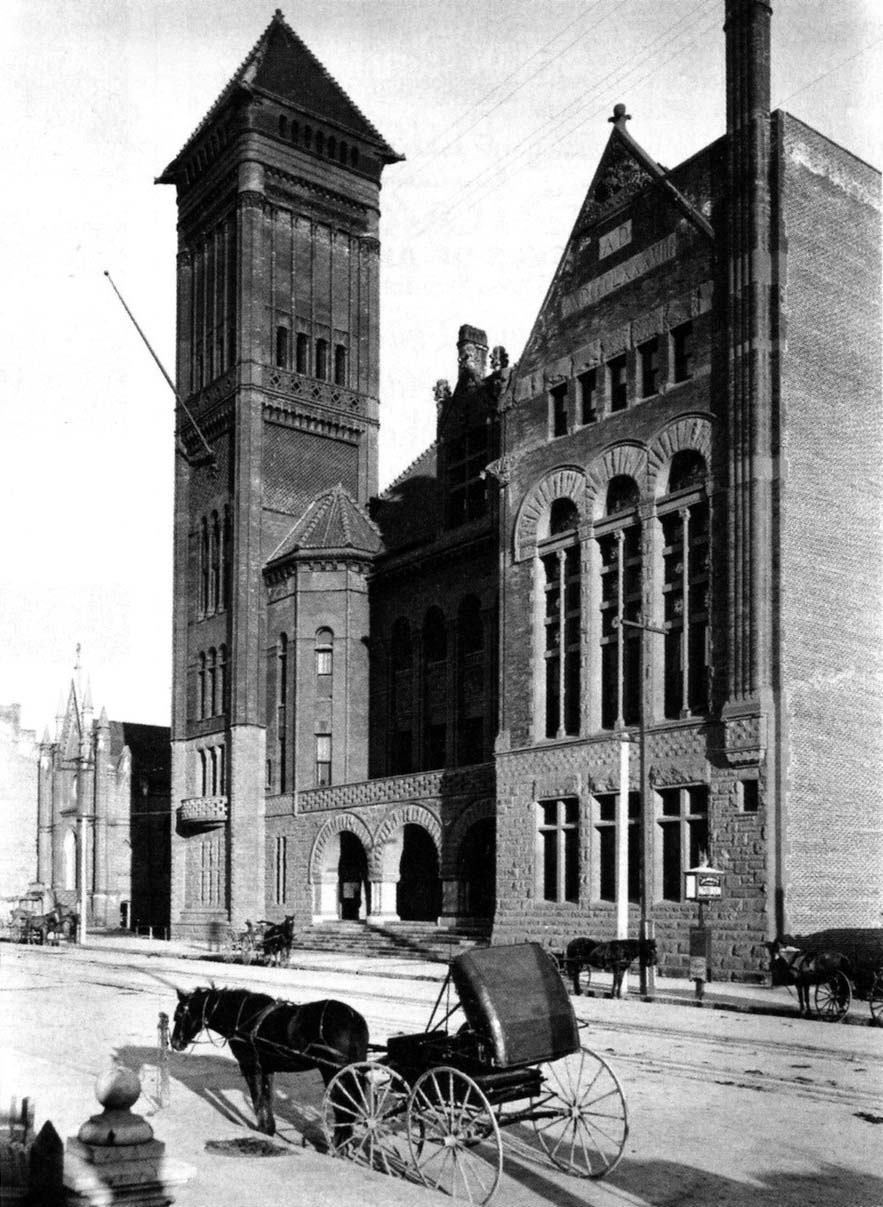 |
|
| (ca. 1890)^*# – Closer view showing several horse-drawn carriages parked on an unpaved Broadway in front of City Hall. The building north of City Hall is the B'nai B'rith Temple, built in 1873. |
Historical Notes Designed and built in 1888 in a graceful Romanesque style and constructed of brick, sandstone and terra cotta, City Hall included a buttressed skyscraper tower atop a square colonnade base, a wide three-arched porch accessed by a broad flight of stone steps, numerous large windows throughout, and a gabled roof.* |
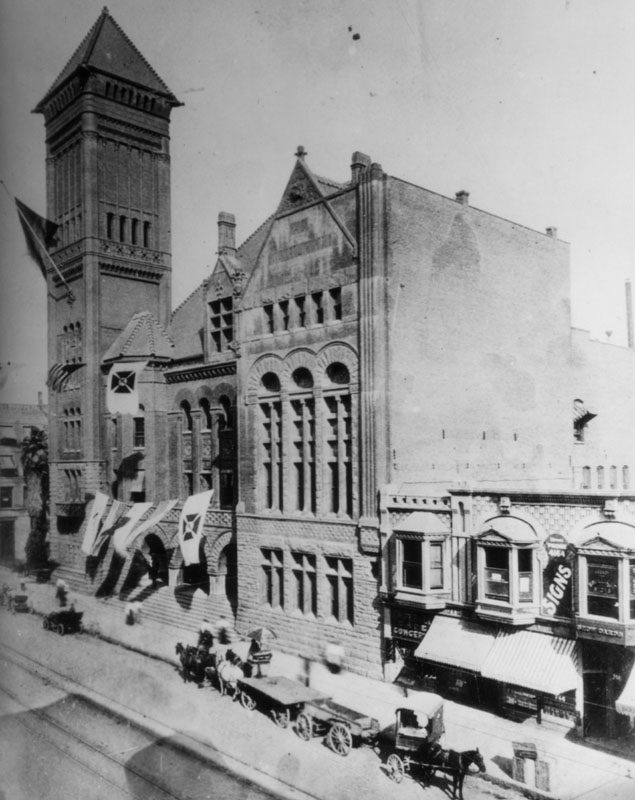 |
|
| (1895)* - Exterior view of the 1888-built City Hall, adorned with banners. Horse-drawn wagons are parked in front. |
Historical Notes The following historical timeline lists the buildings used by City Council, also known as City Hall, since 1850, when Los Angeles was incorporated as a municipality: ◆ 1850 - 1853 - used rented hotel and other buildings for City meetings ◆ 1853 - rented adobe house (aka Rocha Adobe) on Spring Street - across from current City Hall (now parking lot for Clara Shortridge Foltz Criminal Justice Center). The buliding was shared with the County who used it as a Court House. ◆ 1861 - moved into John Temple's Clocktower Market Building, but only stayed for less than a year before the County Court House moved-in ◆ 1861 - 1884 - relocated back to the Rocha Adobe and stayed for over 20 years ◆ 1884 - 1888 - moved to new City Hall Building at South Spring Street and West 2nd Street (site of current Los Angeles Times Building) ◆ 1888 - 1928 - moved to new Romanesque Revival Building on 226-238 South Broadway between 2nd Street and 3rd Street; demolished in 1928 and now site of parking lot between LA Times Parking structure and 240 Broadway. ◆ 1928 - moved to current City Hall Building^* |
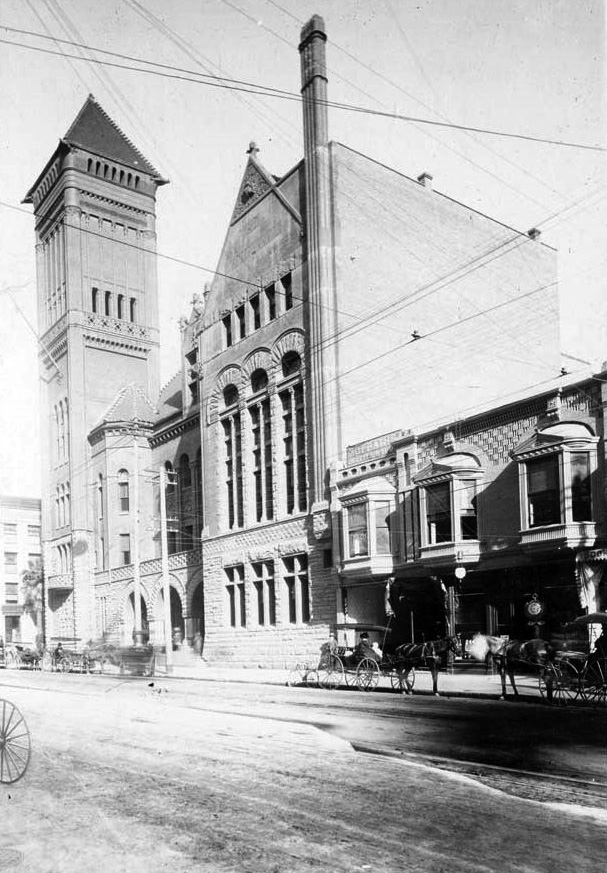 |
|
| (ca. 1895)^## – Street view looking across Broadway toward City Hall. |
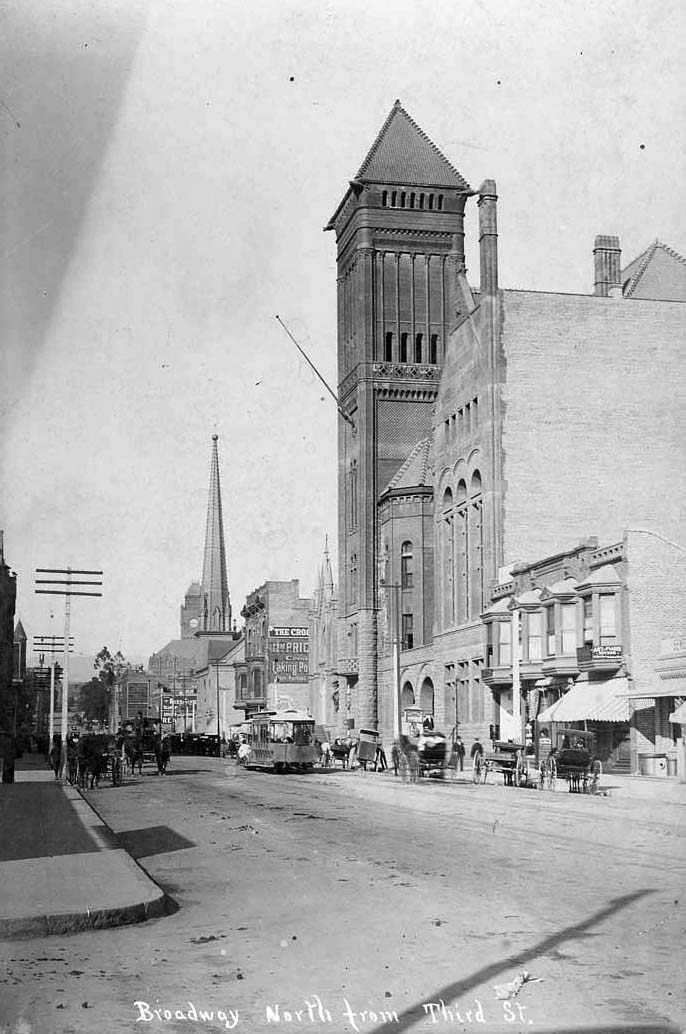 |
|
| (ca. 1895)^## - View of Broadway looking north from Third Street. Horse-drawn carriages and a streetcar share the road. |
Historical Notes City Hall (1888-1928) dominates the right of the picture. Several other landmarks of the day can also be seen here. The tower of Los Angeles High School is partially visible to the left of the power poles. The clock tower in the distance is that of the LA County Courthouse. The tall spire next to that belongs to the First Presbyterian Church at the SE corner of Broadway and Second Street. And, the gothic structure just barely visible between City Hall and the Crocker Building (with the two bay windows) is Los Angeles' first Jewish synagogue, the B'nai B'rith Temple.*^^* |
 |
|
| (ca. 1895)* - View looking southeast toward the Old City Hall at 226 Broadway. Horse-drawn carriages can be seen parked in front of the building. |
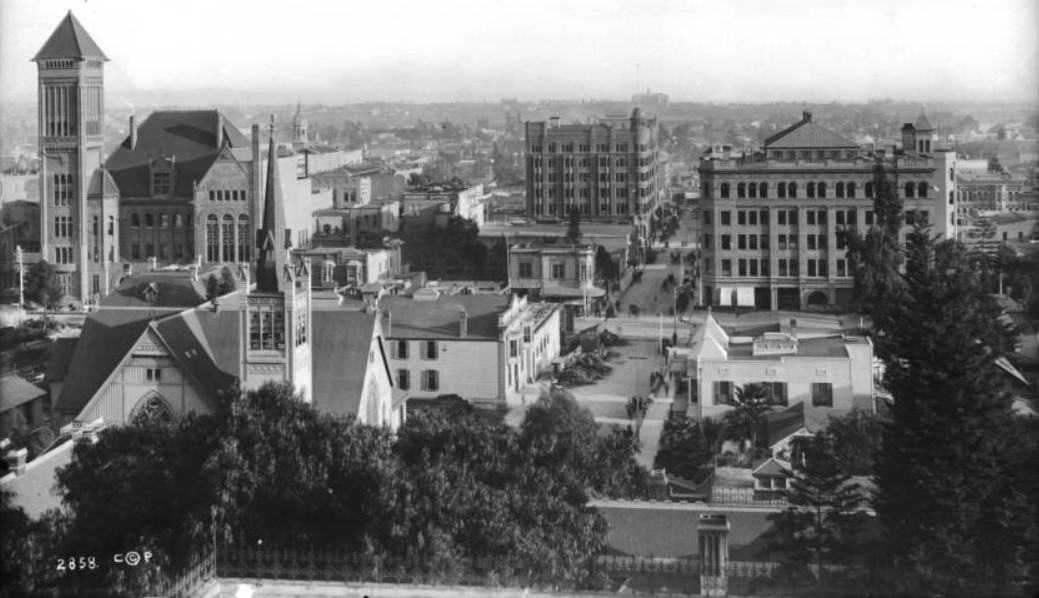 |
|
| (1894)^^* - Panoramic view of downtown Los Angeles, looking east on Third Street from the balcony of the Crocker Mansion. There is a clear view of the intersection of Broadway and Third Street where the Bradbury Building is seen on the southeast corner. On the northwest corner can be seen the excavation for the Irvine Building. City Hall is at upper-left of photo with the cupola of St. Vibiana's Cathedral behind it in the distance. |
 |
|
| (ca. 1900)#*^^ - View looking north on Broadway from near 3rd Street showing streetcars, horse-drawn wagons, bicycles and pedesrians all sharing the roadway. City Hall stands tall on the east side of Broadway. The LA County Courthouse, built in 1891, stands in the background. |
Historical Notes Municipal departments, as well as the offices for: Clerk and Council, Tax Collector, Treasurer, Chief of Fire Department, Zanjero, Building Inspector, Board of Education, Board of Health, Health Officer, Board of Public Works, Mayor's office, Council Chambers, City Attorney, Superintendent of Streets, Assessor, Public Library, and City Surveyor, among others were housed here from 1888 until 1928; a courtroom and several private offices were also located here.* |
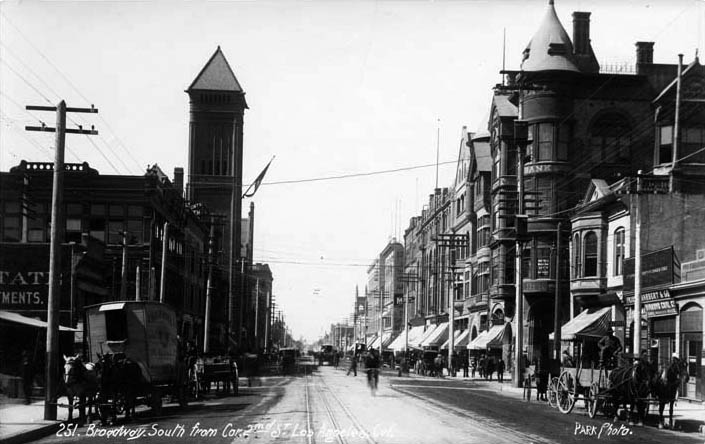 |
|
| (ca. 1902)^## - Street view looking south on Broadway from near the conrner of 2nd Street. Horse-drawn carriages are seen on both sides of the street. A bicycle is moving north toward the photographer as it passes 2nd Street. The group of buildings opposite City Hall, on the west side of Broadway, includes California Bank Building (S/W corner). |
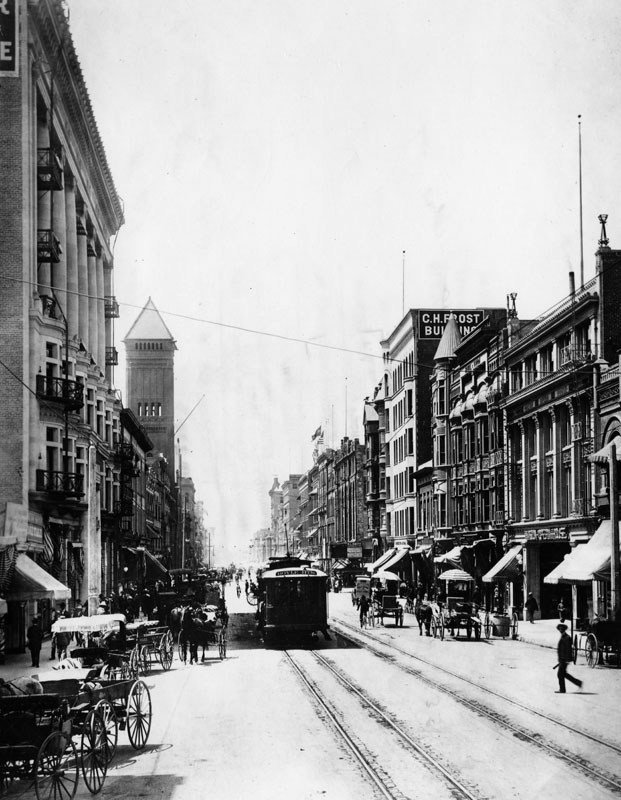 |
|
| (ca. 1904)* - A view of Broadway looking south from 1st Street. A trolley marked "Boyle Heights” takes the center of the street while horses and carriages fill the sides in front of the businesses along the street. Down the street on the left can be seen the tower of the City Hall building. |
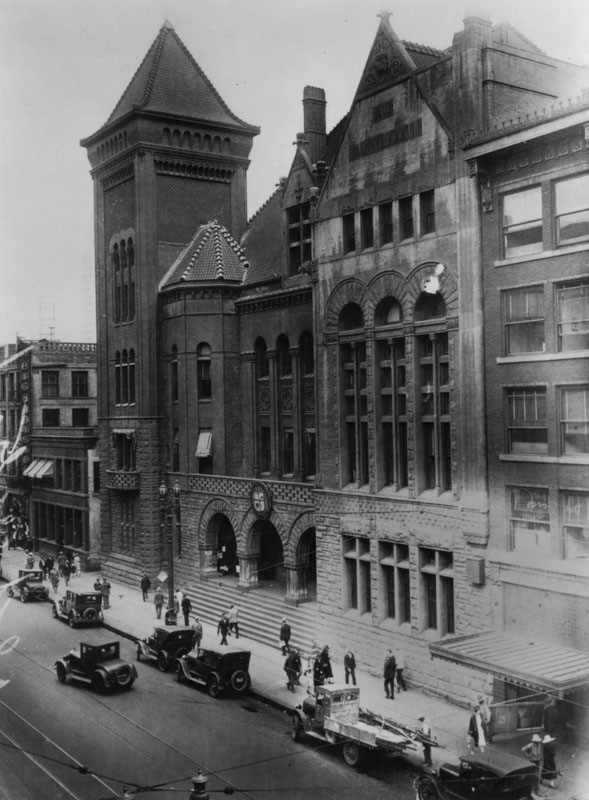 |
|
| (1925)* - Exterior view of L.A.'s third City Hall, located at Broadway, between 2nd and 3rd streets. Within three years of this photo, the building would be torn down. |
Historical Notes On January 10, 1928 an auction of the furnishings and other items inside the structure was conducted on the front steps before the building was torn down later that same year. A new, larger City Hall had been built (in 1927) to replace this one.* |
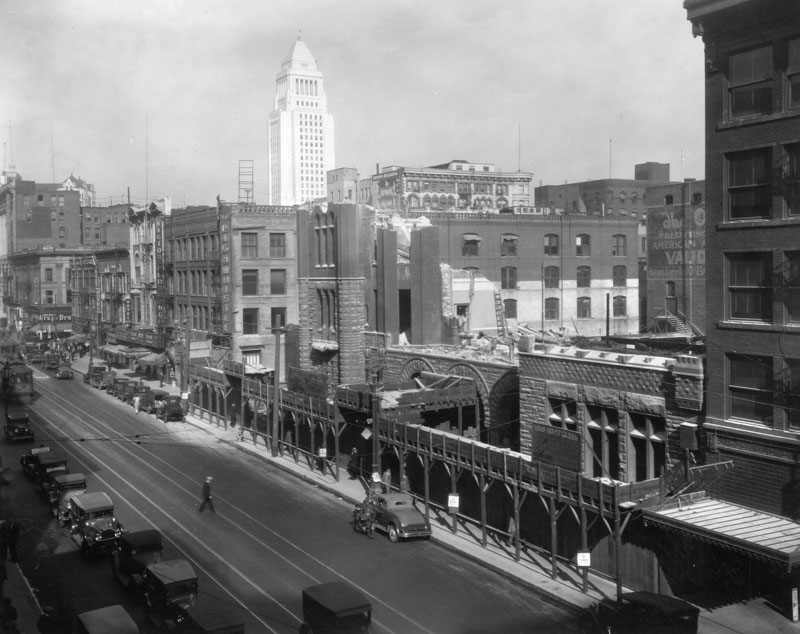 |
|
| (1928)* - View of the demolition of the old City Hall building which stood at 226 S. Broadway between 1888 and 1928. The governmental offices moved into the new City Hall, seen in the background, earlier in the year. |
Historical Notes Click HERE to see more on the current Los Angeles City Hall (completed in 1928). |
* * * * * |
Temple Block
 |
|
| (1889)* - People standing outside the County Courthouse in 1889. This was LA's original County Courhouse, located on Temple Block. Between 1860s-1884 City Hall also occupied this building. |
Historical Notes The old County Courthouse, originally built by John Temple in 1861 as a marketplace and theater. Its first floor was used for that purpose for a number of years, and the second floor was the first theater in Los Angeles. The County purchased it for $25,000 in 1870 and occupied it as a court from 1861 to 1891.* In 1891 the LA County Courthouse moved to it's newly constructed building located at the old site of Los Angeles High School where it would stay until 1932. |
* * * * * |
Weil Building
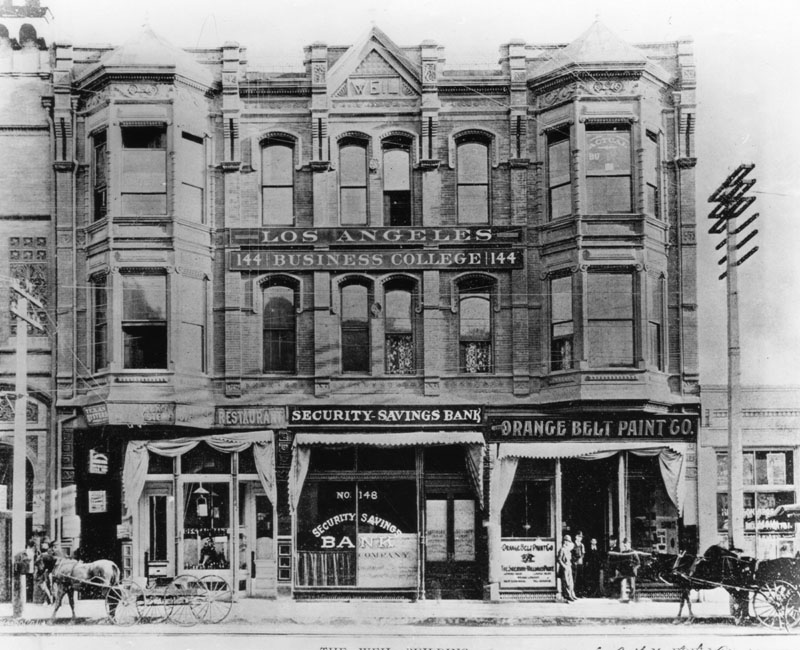 |
|
| (1889)* - Exterior view of the Weil Building, owned by Mrs. Jacob (Yetta) Weil, Maurice Hellman's aunt. |
Historical Notes The Weil Building housed the Security Savings Bank and Trust Co., a predecessor of the contemporary Security Pacific National Bank, which opened in this building on Main Street, on February 11, 1889. The name was changed to Security Trust Savings Bank in 1912 and to Security First National Bank in 1929. Also sharing this building was the Los Angeles Business College and the Orange Belt Paint Co.* |
* * * * * |
Grand Opera House (1st Home of the Orpheum Circuit)
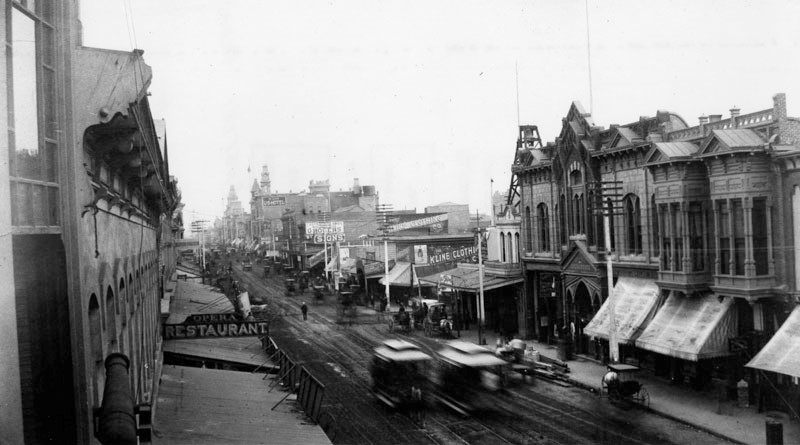 |
|
| (ca. 1889)* – View of Main Street looking north from 2nd Street showing various businesses, horse-drawn street-cars, and Childs’ “Los Angeles Opera House” (center-right). This would become the Orpheum Theatre in 1894. The Opera Restaurant is seen across the street on the left. |
Historical Notes Opened on May 24, 1884 as Child's Opera House, but also known as the Grand Opera House. The theatre at the time was the largest yet built in the growing city of Los Angeles. It was built by local entrepreneur and real estate man Ozro W. Childs, one of the city’s most successful developers. #^#* There were four Orpheum theatres in downtown Los Angeles: ◆ 110 S. Main St. -- Grand Opera House was the home of Orpheum vaudeville from 1894 to 1903. ◆ 227 S. Spring St. -- The Los Angeles Theatre, later called The Lyceum, was known as the Orpheum from 1903 to 1911. ◆ 630 S. Broadway -- Now the Palace Theatre -- this was the Orpheum between 1911 and 1926. ◆ 842 S. Broadway -- Orpheum Theatre from 1926 to Today |
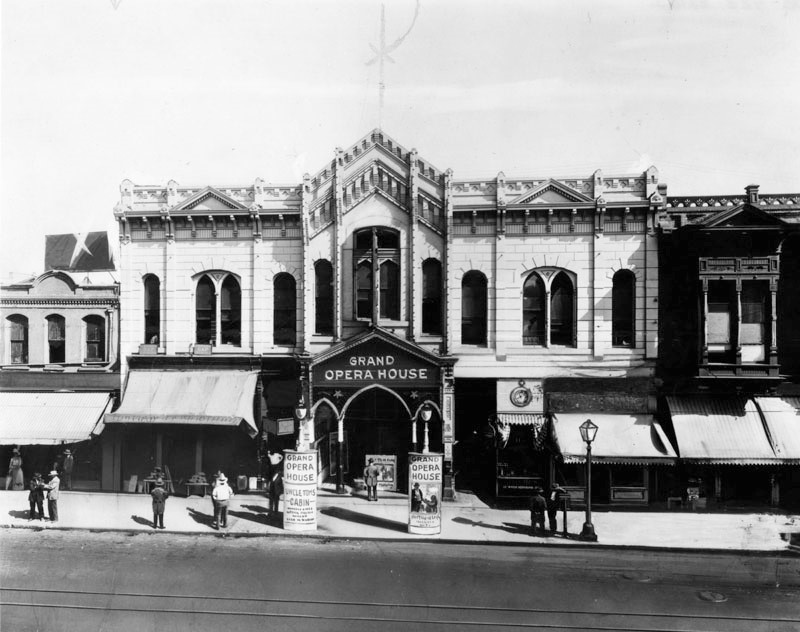 |
|
| (n.d.)* – Exterior view of the Childs' Grand Opera House, featuring "Uncle Tom's Cabin." |
Historical Notes The theatre was designed by architects Ezra F. Kysor and Octavius Morgan, whose firm later became Morgan and Walls (Arcade Theatre) and later Morgan, Walls and Clements (Mayan, Belasco and many others). Kysor had earlier designed the Merced Theatre.**# Childs' Grand Opera House was the home of Orpheum vaudeville from 1894 to 1903. |
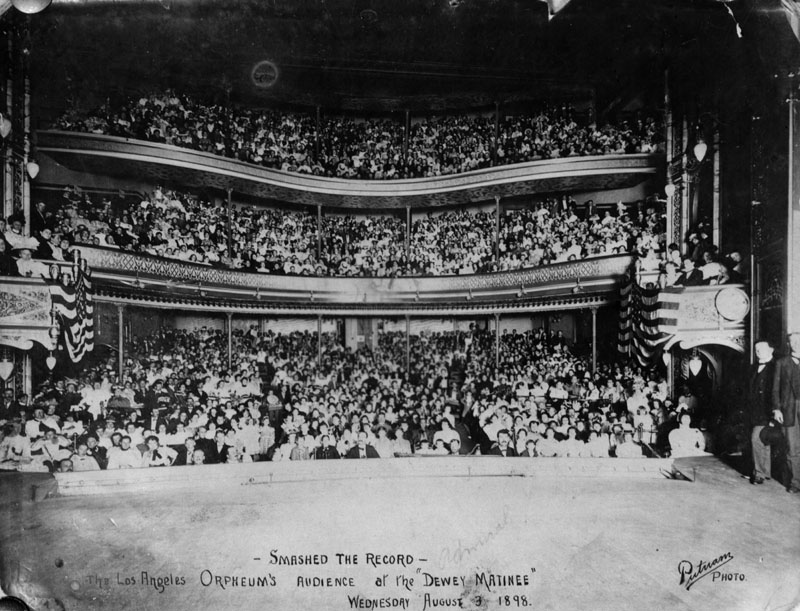 |
|
| (1898)* - The Los Angeles Orpheum's Audience at the "Dewey Matinee" on Wednesday, August 9, 1898. |
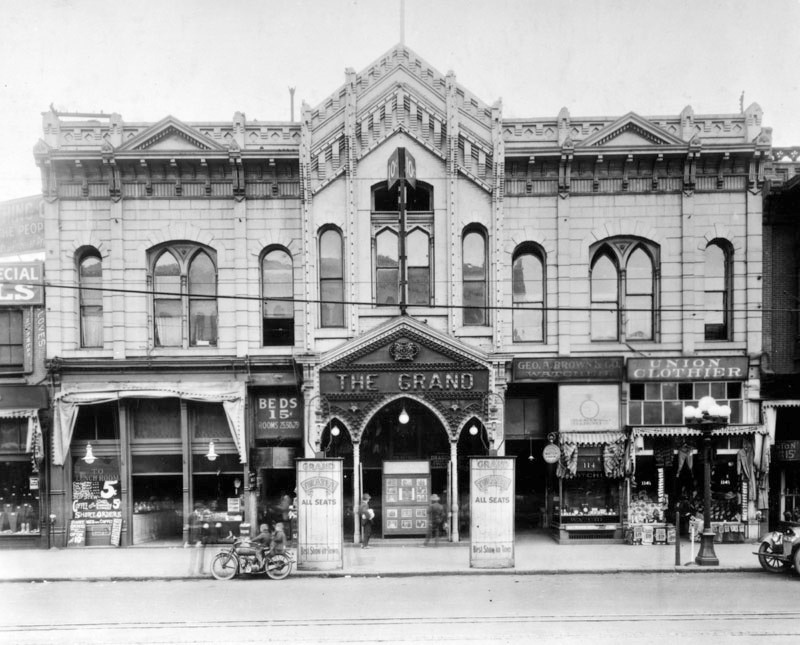 |
|
| (ca. 1920)* - Exterior view of the Grand Opera House (also known as Childs' Opera House). Two young people are seen on a motorcycle parked by the curb. |
Historical Notes As the theater district of Los Angeles shifted south and west, and larger, more modern theaters such as the Burbank, the Hippodrome and, in 1905, the new Mason Opera House on Broadway opened, the fortunes of the Grand Theater declined. By 1910, it had become a movie house, and by 1920, second run movies were being shown for an admission price of ten cents. #^#* |
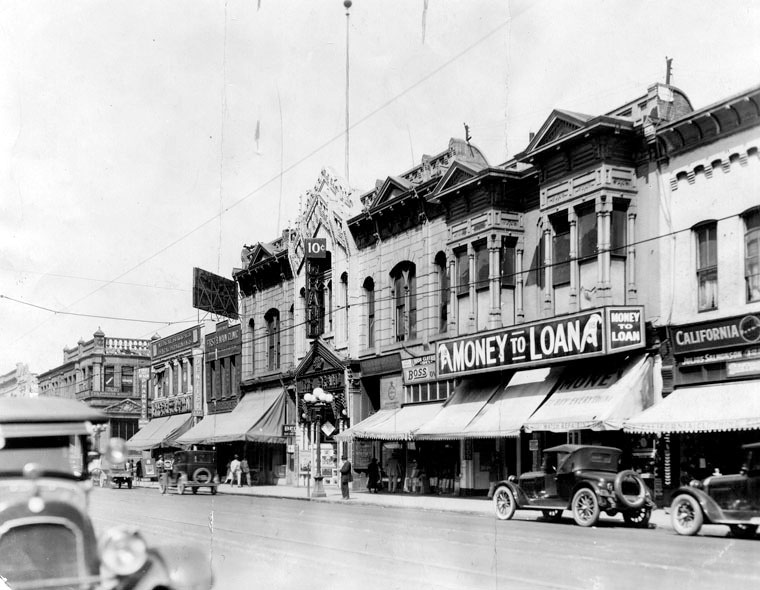 |
|
| (ca. 1920s)* – View of the Grand Theatre (first Orpheum in Los Angeles) located on Main Street near 1st Street. |
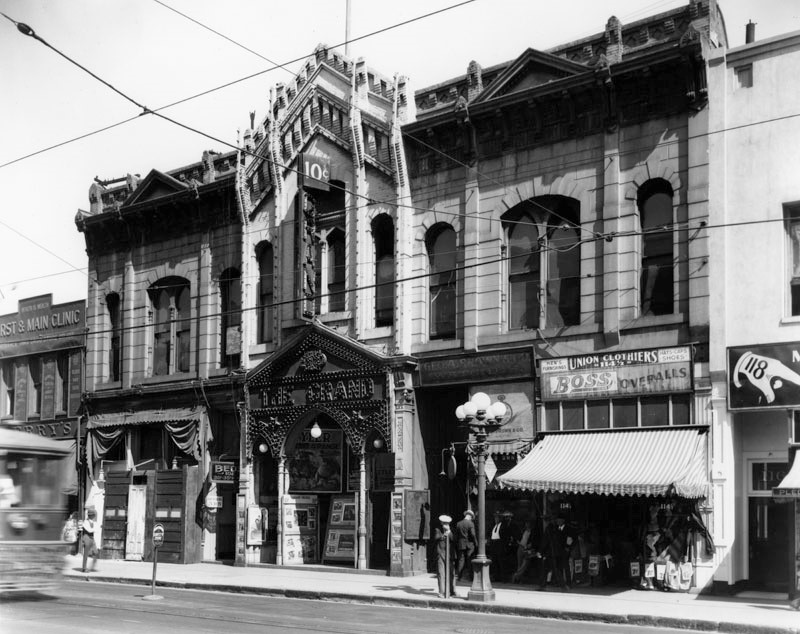 |
|
| (1929)* – View of the Los Angeles Grand Opera House after it became a 10 cents movie house; it originally opened on May 27, 1884. |
Historical Notes In 1912 the theatre was known as Clune's Grand. With increased competition from newer theatres, the Grand became a showplace for Mexican stage shows and movies in the 20's as Teatro Mexico.*## |
.jpg) |
|
| (1936)* – Last days of Childs’ Grand Opera House (now known as El Teatro Mexico), located at 110 S. Main Street. |
Historical Notes Photo Caption Reads: "That treasure house of the gaiety and culture in old Los Angeles, Childs Grand Opera House on Main Street just south of First Street, is no more. The curtains went down for the final time and the old show house was being torn down. Photo shows the old opera house when its light were dimmed for the last time. It was built in 1884 by Ozro W. Childs as the last word in theaters. In the past decade it has been known as El Teatro Mexico." * Closed April 5, 1936, the theatre was soon demolished for a parking lot. It is now the site of the California Department of Transportation building.*## |
* * * * * |
Los Angeles Cable Railway Co. Barn
 |
|
| (1889)* - Before being run by electric lines, the cable cars were pulled by horses. Shown here is the horse barn at 12th and Olive Streets which ran the "red line", running from Broadway out E. 1st St. to Boyle Heights, Broadway to 7th, west on 7th to Westlake Park. The sign on the barn reads "Los Angeles Cable Railway Co." |
* * * * * |
Boyle Hotel - Cummings Block
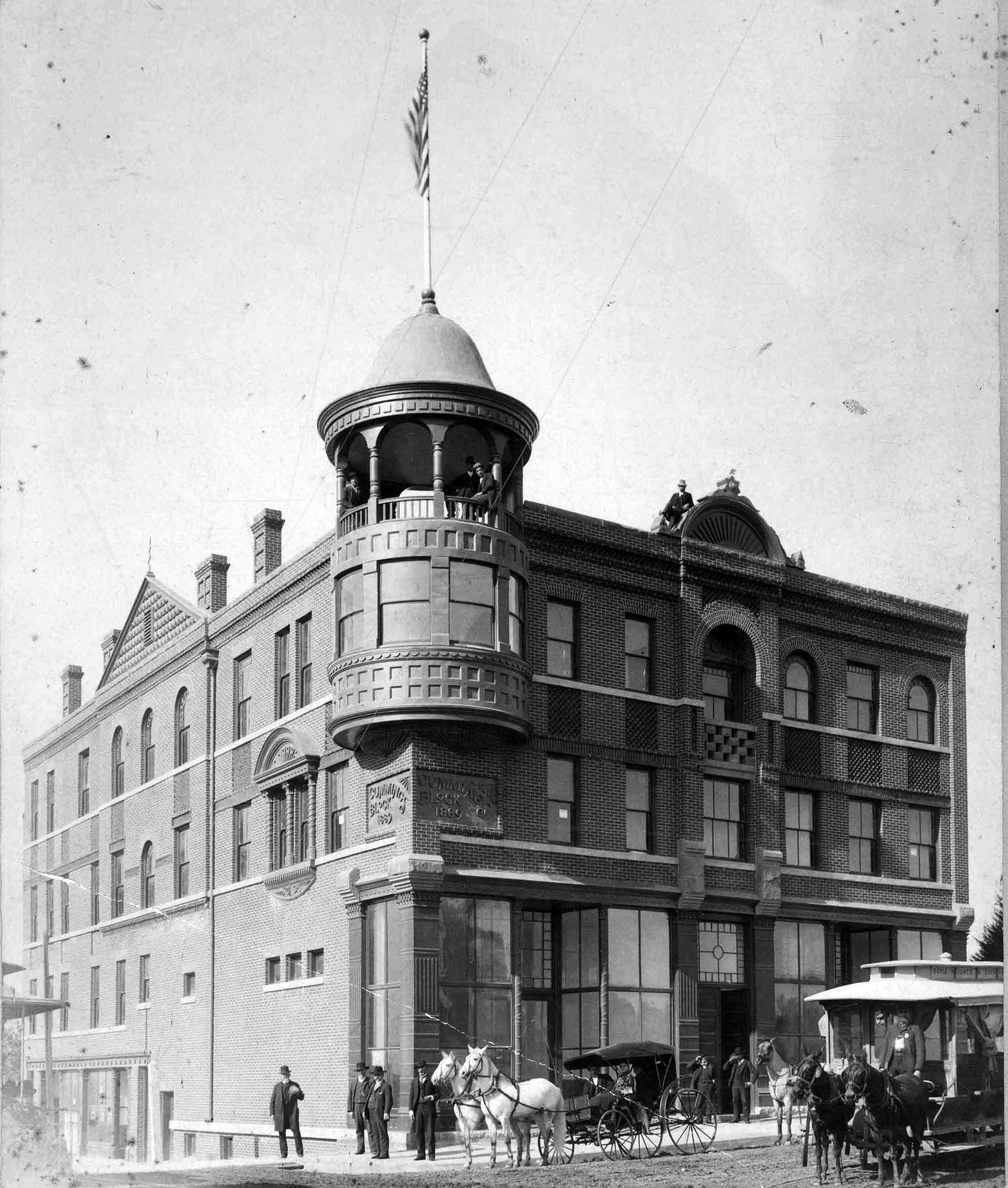 |
|
| (1889)* - View of the Boyle Hotel-Cummings Block on the northwest corner of 1st and Bolye Ave. A horse-drawn carriage is parked at the curb while a group of men stand behind it on the sidewalk. A horse-drawn streetcar is in the lower right. Also, several men can be seen on the building roof balcony and parapet. |
Historical Notes Located at the corner of Boyle Avenue and E. First Street in Boyle Heights, the Boyle Hotel, also known as the Cummings Block, is one of the oldest remaining commercial structures in Los Angeles and is significant for its many layers of history. Designed by architect W. R. Norton and built in 1889 for community leaders George Cummings and his wife Maria del Sacramento Lopez, this Victorian-era hotel became a social and political center for the community and encouraged the residential and commercial development of Boyle Heights. The building features decorative patterned brickwork, cast iron storefront columns, and a corner turret with an open belvedere. #*^ |
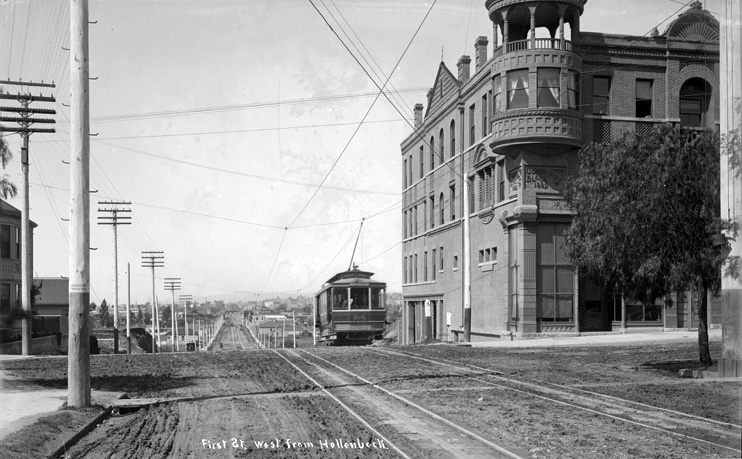 |
|
| (ca. 1895)^## - View looking west on 1st Street at Boyle Avenue. An electric streetcar passes by the Boyle Hotel located on the northwest corner. |
Historical Notes In 1858, Irish-born Andrew A. Boyle (1818–1871) came to Los Angeles from San Francisco (having also previously lived in New Orleans and Texas after his 1832 migration to America.) Boyle built the first brick house east of the Los Angeles River and cultivated the Lopez vineyards, manufacturing and selling wine under the Paredon Blanco name. He also operated a shoe store in Los Angeles and was a member of the city council. After Andrew Boyle's death in early 1871, his property passed to his only daughter and her husband, William Henry Workman (1839–1918), a saddler and rising politician in town. As the first growth boom was underway in the Los Angeles area, Workman decided to subdivide part of Paredon Blanco. In Spring 1875, he partnered with banker and real estate speculator Isaias W. Hellman and John Lazzarovich, who was married to a member of the Lopez family, and announced the creation of the new neighborhood of Boyle Heights. Before long, the growth boom ended, largely because of the failure of the bank co-owned by Workman's uncle, William Workman (1799–1876), owner of the Rancho La Puente in the eastern San Gabriel Valley. It was not until the next development boom, which took place during Workman's tenure as mayor in the 1887-88 period, that Boyle Heights grew rapidly and became a desirable residential area for middle and upper middle class Angelenos. Some large Victorian-era homes still survive in Boyle Heights as testament to the late nineteenth-century status the neighborhood possessed.^* |
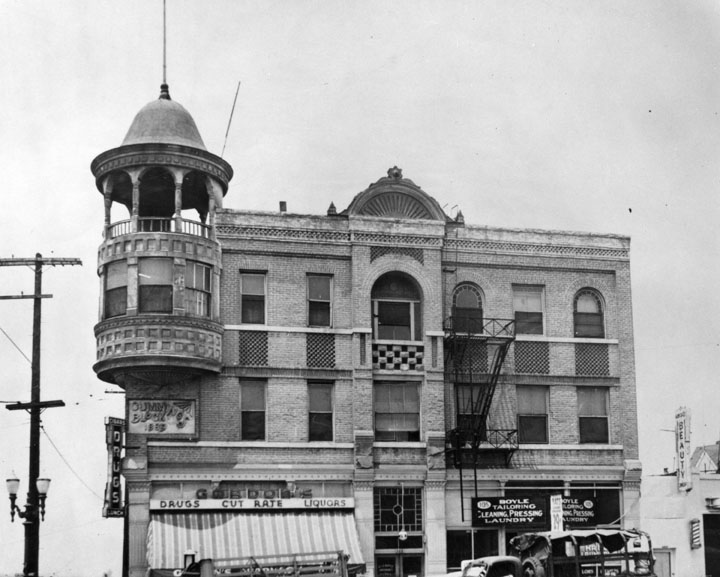 |
|
| (1942)* - View of the Boyle Hotel-Cummings Block, located on the corner of Boyle Avenue and First Street, Boyle Heights as it appeared in 1942. |
Historical Notes In the twentieth century, the building became associated with the many mariachi musicians who rented rooms in the hotel and gathered in the adjacent plaza to await customers. #*^ |
 |
|
| (ca. 1950)^^+ - View looking up at the cupolaed structure of the old Cummings Block on the northwest corner of E 1st St. and Boyle Ave. It was built originally as a hotel and it still is one. |
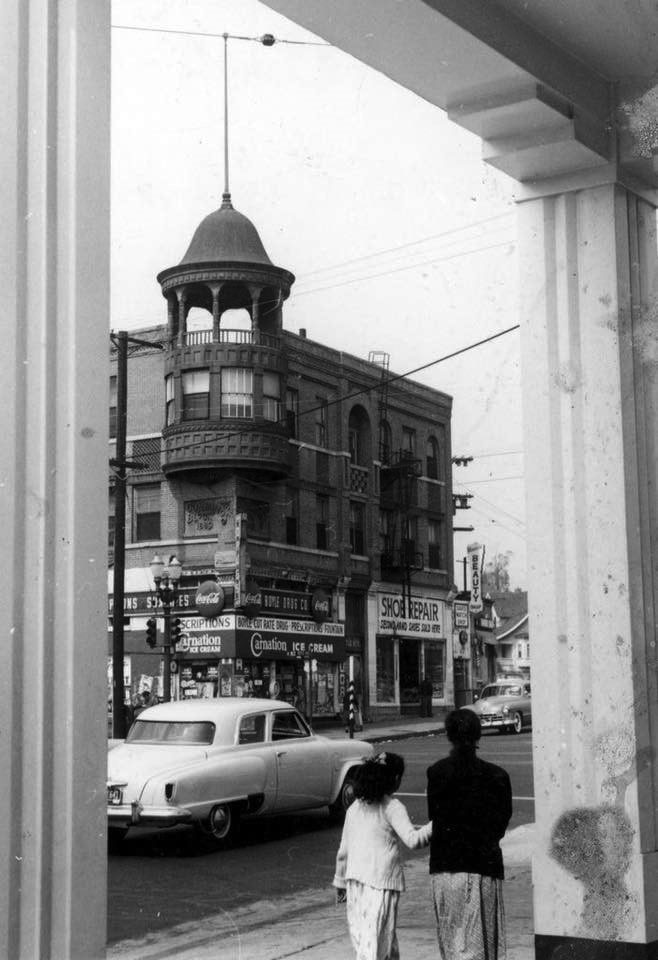 |
|
| (1950s)^.^ - Kitty corner shot of the Cummings Hotel, Boyle Heights. |
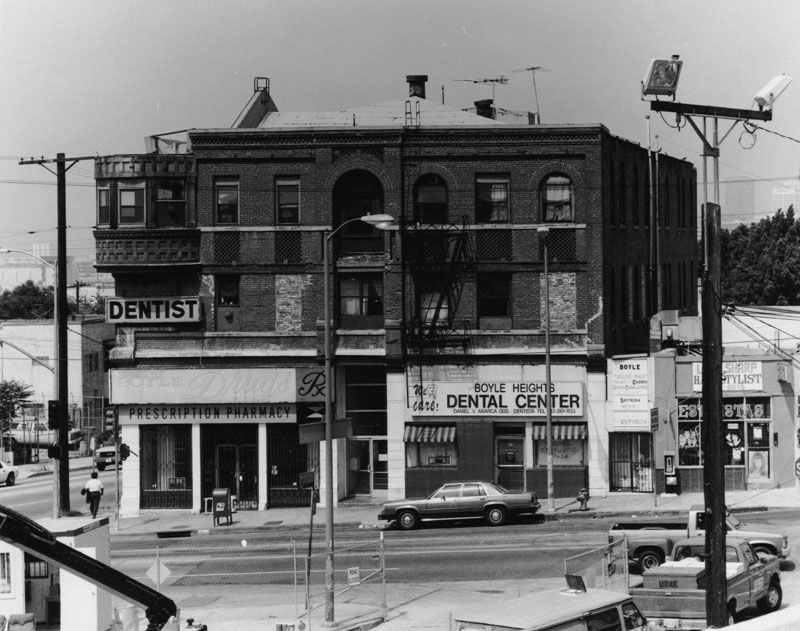 |
|
| (1979)* - Exterior view of the historic Boyle Hotel on the Cummings Block with its turret gone and some of its windows bricked in. |
Historical Notes Although the condition of the building deteriorated through the years and some of the decorative elements were removed, the Boyle Hotel underwent a full-scale rehabilitation that renovated the interior for use as apartments and restored missing architectural elements, such as the upper portion of the corner turret. #*^ |
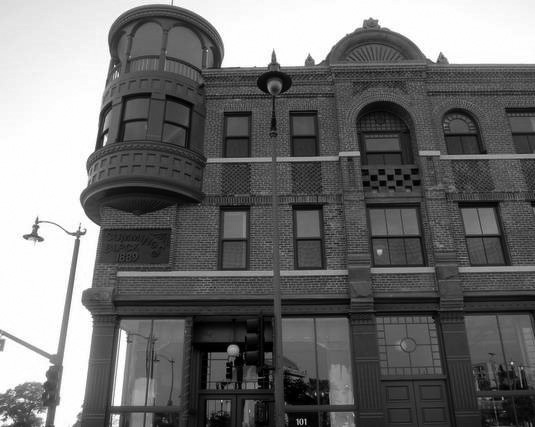 |
|
| (2012)#^^ - View of the Boyle Hotel complete with its turret shortly after the building was renovated. |
Historical Notes In 2012, renovation of the relic of Victorian-era Boyle Hotel was completed with a turret, arches and a domed cupola crowning the four-story brick building. The East Los Angeles Community Corp., a nonprofit developer, restored the Victorian Italianate-style building, as part of an approximately $25 million project to transform the former hotel into affordable housing. #^^ |
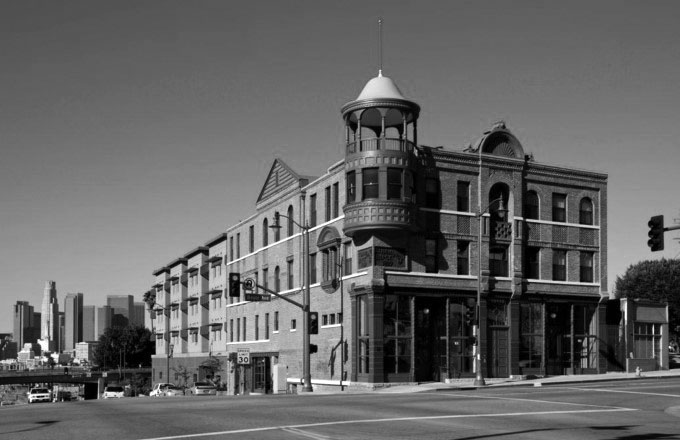 |
|
| (2012)#*^ - View looking west on 1st Street at Boyle Avenue shortly after the building was renovated. |
Historical Notes The Boyle Hotel was declared Los Angeles Historic-Cultural Monument No. 891 in 2007. |
Before and After
.jpg) |
 |
| (1895 vs 2012) - Looking west on 1st Street at Boyle Avenue. |
Then and Now
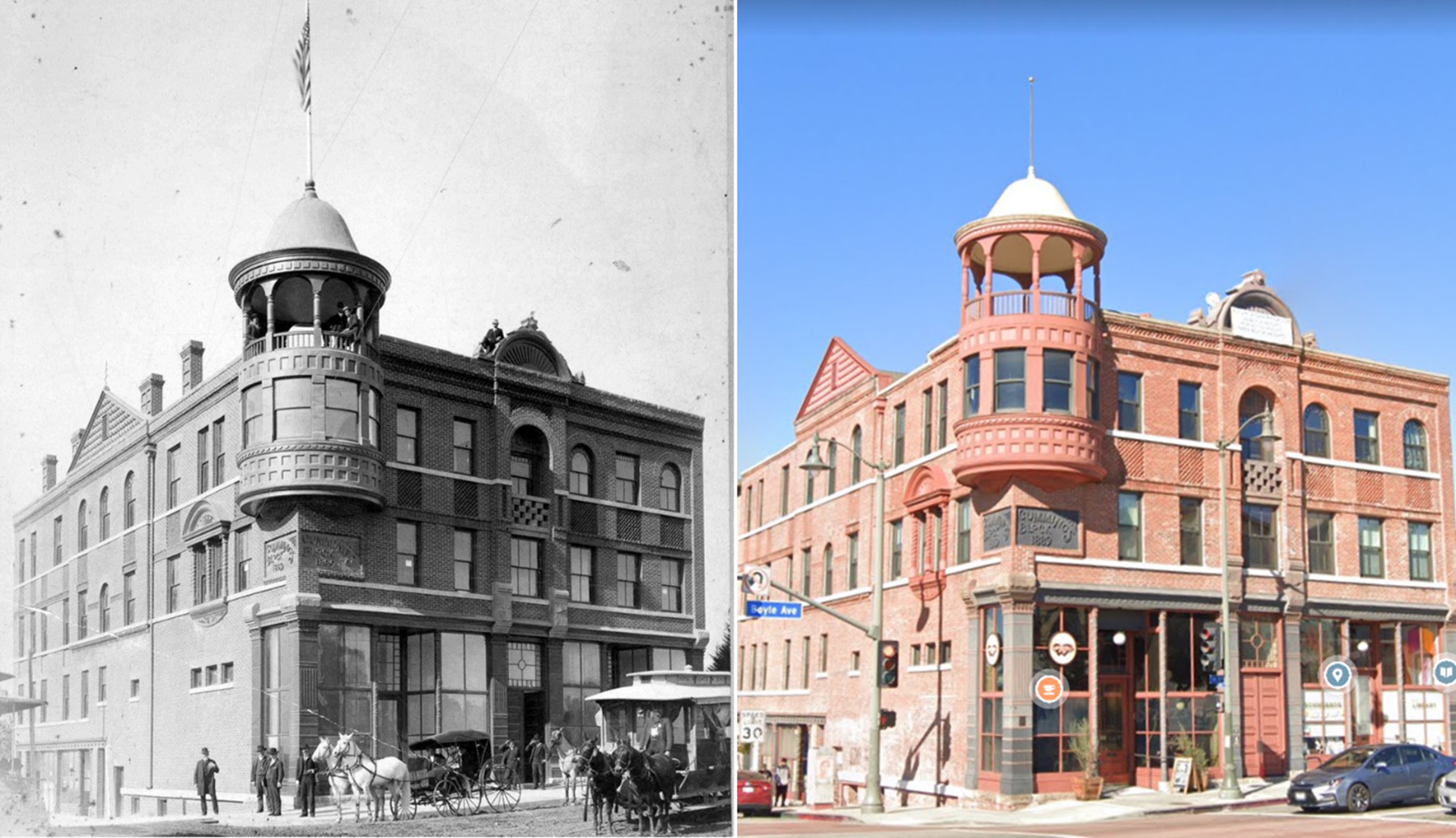 |
|
| (1889 vs 2023)* - Boyle Hotel, NW corner of Boyle and 1st in Boyle Heights. |
Then and Now
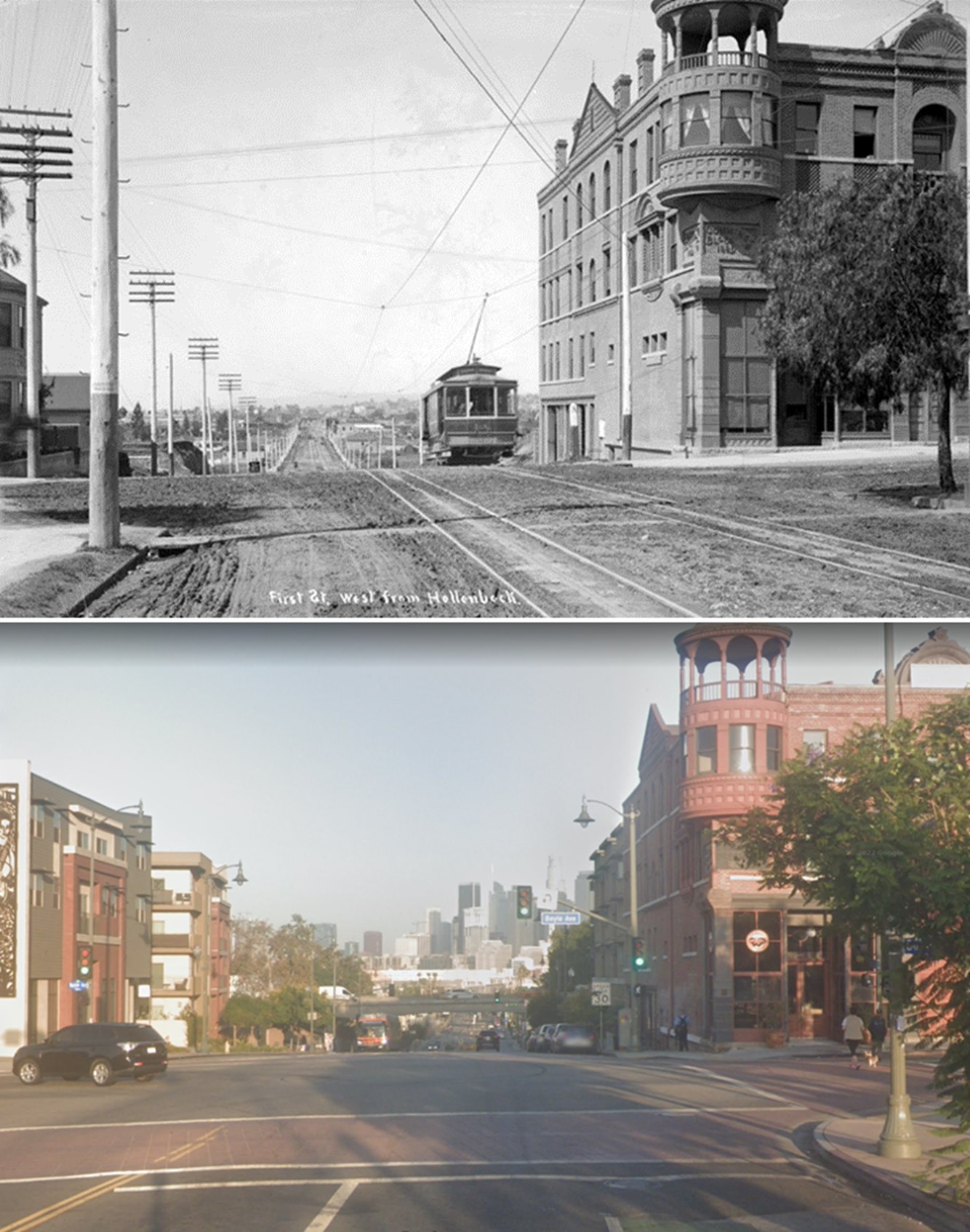 |
|
| (1895 vs 2022)* - Looking west on 1st Street at Boyle Avenue. |
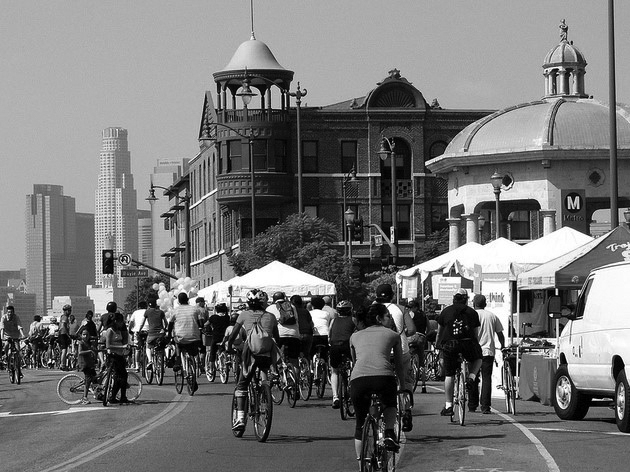 |
|
| (2014)^# – Weekend bike riders head west on 1st Street at Boyle Avenue. The beautiful Boyle Hotel stands tall on the corner with the downtown skyline in the background. Photo by Victoria Bernal |
* * * * * |
Workman Residence
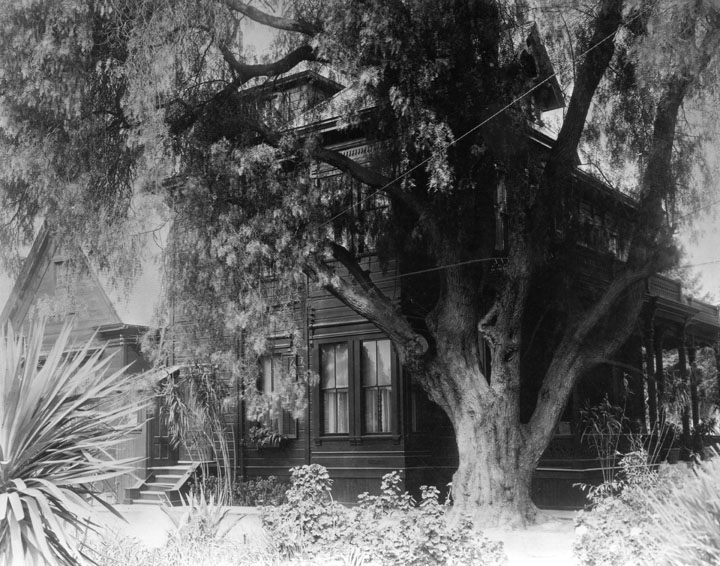 |
|
| (n.d.)* - Close-up view of the residence of W. H. Workman at 357 Boyle Ave., Boyle Heights, later the site of the Hebrew Sheltering Home for the Aged. The house was built in 1880. |
* * * * * |
Occidental College (First Campus)
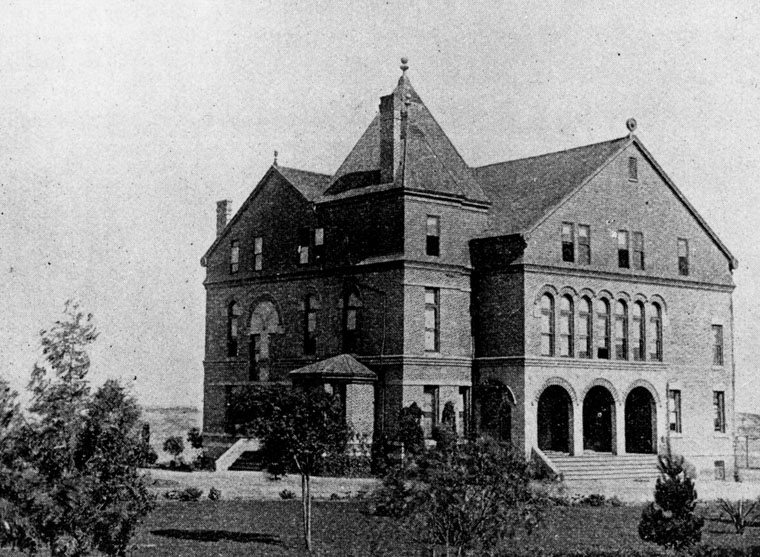 |
|
| (1890s)* - View of the first campus of Occidental College in Boyle Heights. An institution for the higher Christian education of both sexes, the college was built in 1890 in Romanesque/Elizabethan style and was destroyed by a fire in 1896. |
Historical Notes On 20 April 1887, a group of clergy and laypersons from the city's Presbyterian population received its articles of incorporation from the State of California for "The Occidental University of Los Angeles, California." The site chosen for the school was at the southern end of Boyle Heights off Rowan Street (named, incidentally, for banker, county treasurer, county supervisor and Los Angeles mayor Thomas E. Rowan.) On 20 September, the cornerstone was laid for the sole college structure and construction commenced. A year later, in October 1888, instruction began for the first crop of Oxy students, composed of twenty-seven men and thirteen women, who paid $50 tuition per year. Five years later, the college celebrated the matriculation of its first graduates: Maud E. Bell and Martha J. Thompson. Another landmark occurred in 1895 when Oxy played its first football game against arch-rival Pomona College, a contest won by the Tigers, 16-0. On 13 January 1896, a fire destroyed the sole structure at the institution, which then moved temporarily to 7th and Hill streets in downtown Los Angeles. A new campus was built and occupied in 1898 at Highland Park, on Pasadena Avenue (now Figueroa Street) near Avenues 51 and 52.**^^ |
Occidental College (2nd location)
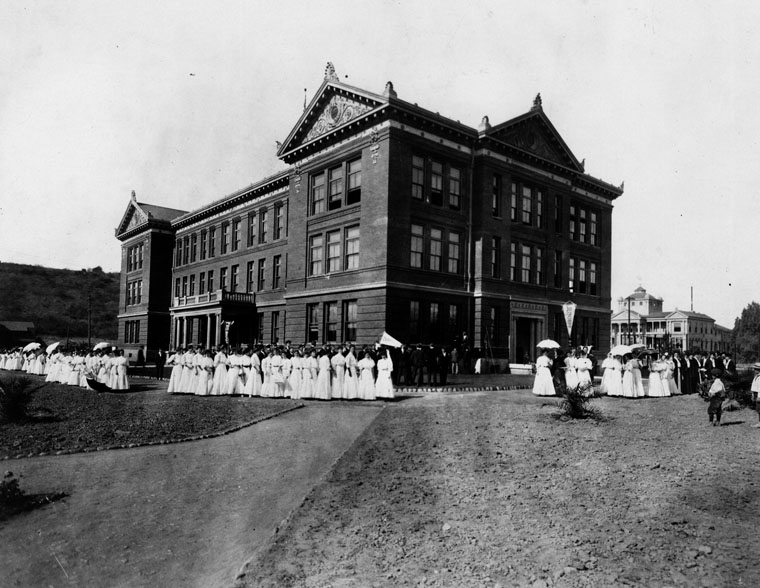 |
|
| (1904)* - A group of formally-dressed people, women in white, men in black, pose by the Hall of Letters building at Occidental College. It may be a graduation ceremony. The structure was built in 1898 on Pasadena Ave (now Figueroa), between Ave 51 & Ave 52 in Highland Park (the second location of the campus). |
Historical Notes Despite a strong Presbyterian presence on its campus, Occidental cut ties to the church in 1910. In 1912, Occidental President John Willis Baer announced the trustees’ decision to convert Oxy into an all-men’s institution. However, students protested, and the idea was abandoned.^* |
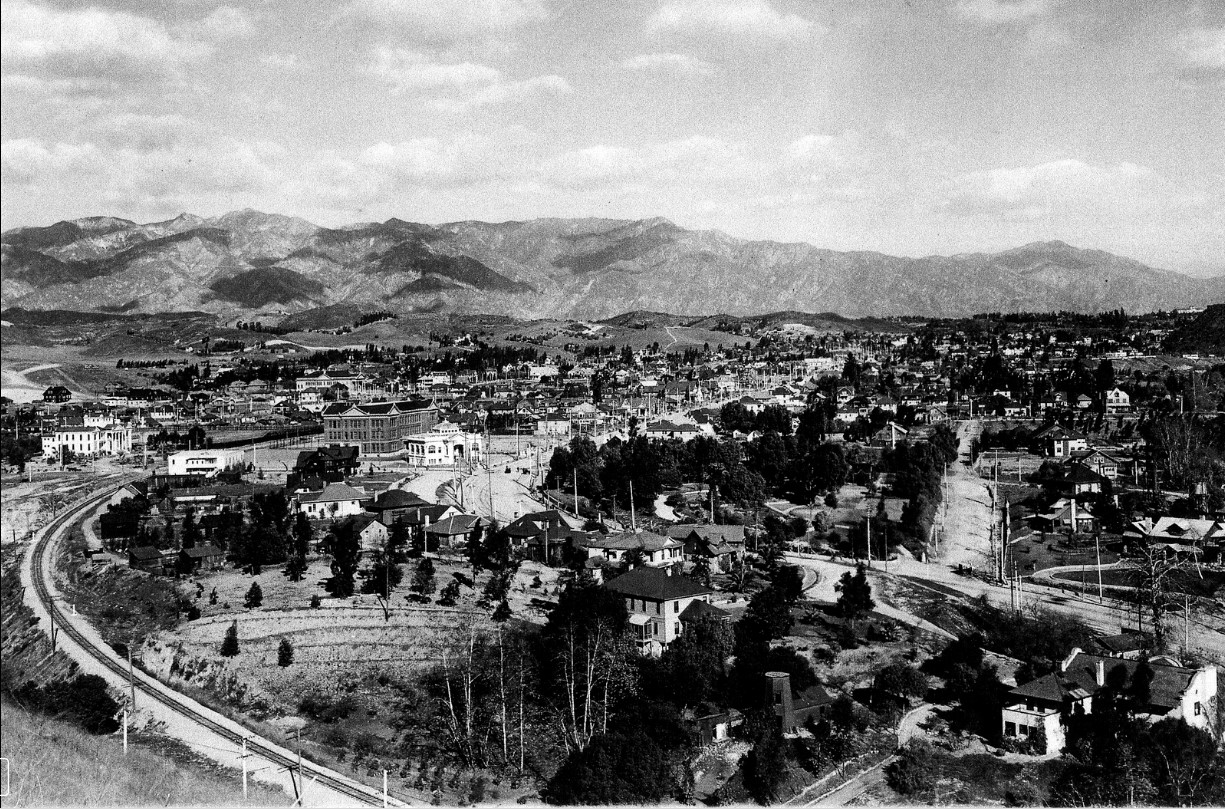 |
|
| (ca. 1905)*#*# - Panoramic view of Highland Park with the San Gabriel Mountains in the distance. On the left, the railroad tracks make a turn and then head northeast toward South Pasadena. At center, Figueroa Street also turns and parallels the tracks. At center-left stands the 3-story Hall of Records Building seen in previous photo. The white building to its right is the Occidental College Library Building. It sits at the point where Figueroa makes its turn. |
Historical Notes After being located in Highland Park for over a decade, another move would be made. The small size of the 15-acre campus and the disruption caused by frequent freight trains pushed the college's trustees to find a new location. In 1912, the school began construction of a new campus located in Los Angeles’ Eagle Rock neighborhood.^* |
 |
|
| (1908)* - Closer view showing the Occidental College campus in Highland Park (center-left). North Figueroa Street runs down the center of photo after make a sharp turn. It was called Pasadena Avenue at the time. Monte Vista Avenue parallels it to the left. |
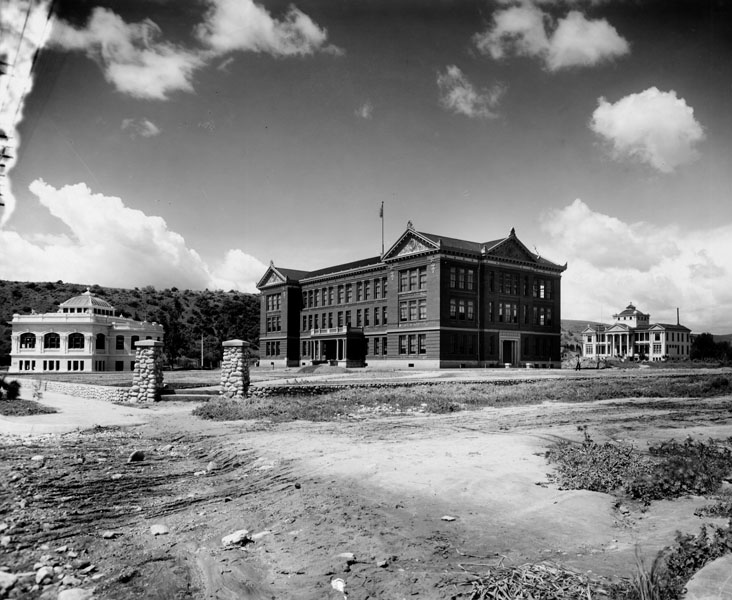 |
|
| (Early 1900s)* - View showing three of the early buildings at Occidental College. From left to right they are: the Chas. M. Stimson Library building, theStimson Library Hall of Letters building, and the Academy building. |
Historical Notes The Hall of Arts and Letters building was converted to apartments. The hall still stands today.^* |
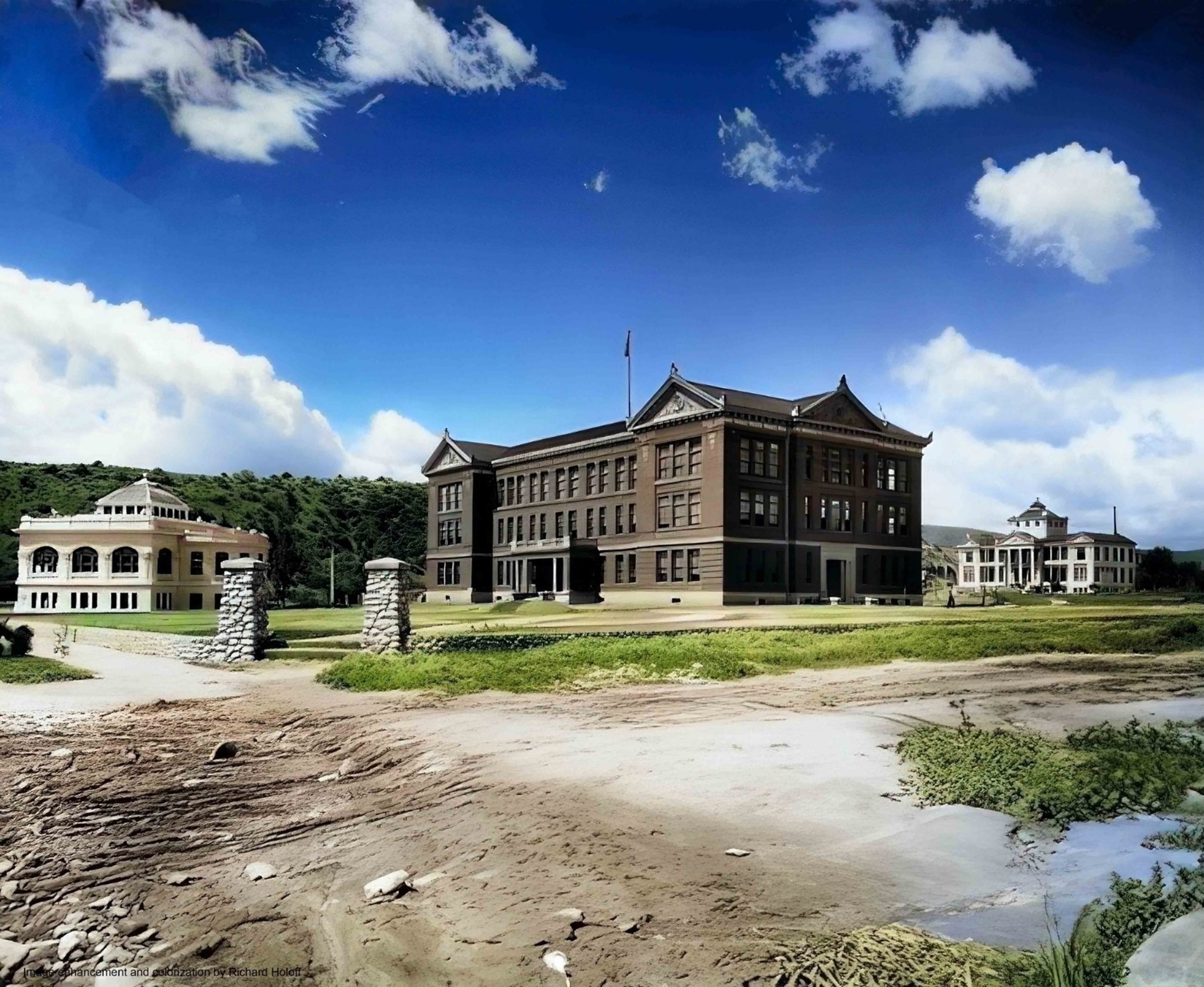 |
|
| (Early 1900s)* - View showing three of the early buildings at Occidental College. From left to right they are: the Chas. M. Stimson Library building, theStimson Library Hall of Letters building, and the Academy building. Image enhancement and colorization by Richard Holoff. |
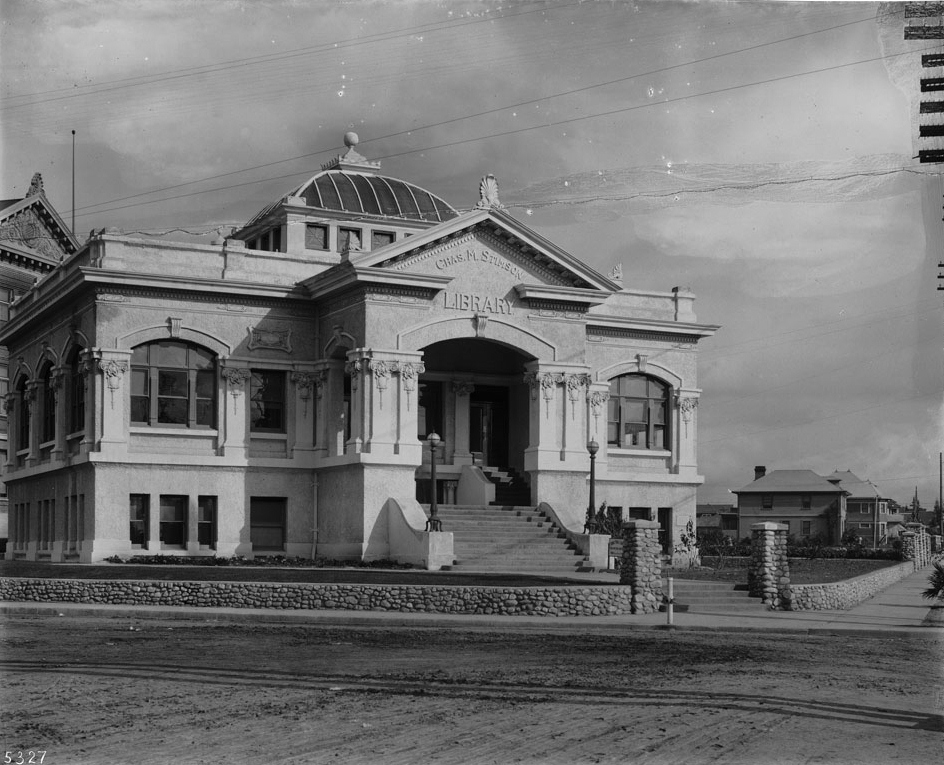 |
|
| (ca. 1908)* - Photograph of the Chas. M. Stimson Library, built in 1904 on the Occidental College Highland Park Campus. The two-story building has an extended porch where above it is a pediment displaying the name of the building. Multifoil tracery outline the windows the walls. Above the roof is a turret-like tower. A stone masonry wall creates a perimeter around the front yard. Heavy tracks line the dirt road in front of the building. |
Historical Notes After the College moved to its present campus in Eagle Rock (1914) the Library building was used for a short time as a Los Angeles City Branch Library. The building has since been demolished.^ The new Eagle Rock campus was designed by noted California architect Myron Hunt, also known as the planner of the Caltech campus and as designer of the Huntington Library and Art Gallery and the Rose Bowl.^* Click HERE to see Occidental College's 3rd location in Eagle Rock. |
* * * * * |
Temple Street Cable Railway Barn
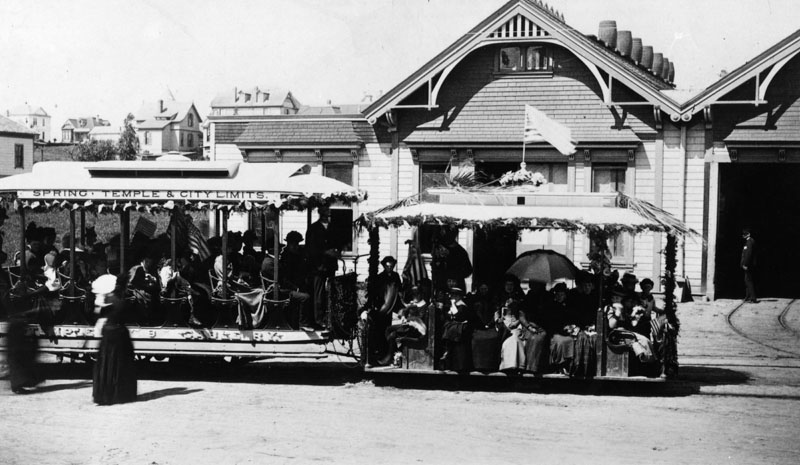 |
|
| (ca. 1890)* - A cable car full of passengers and decorated with American flags is seen in front of the Temple Street Cable Railway barn and powerhouse on the northwest corner of Temple Street and East Edgeware Road. Angelino Heights is in the background. |
Historical Notes Originally spelled Angeleno Heights, Angelino Heights is second only to Bunker Hill as the oldest district in Los Angeles. Founded in 1886, it was originally connected to the downtown mainline (which ran east to west on Temple Street) by the Temple Street Cable Railway and later by streetcars.^* |
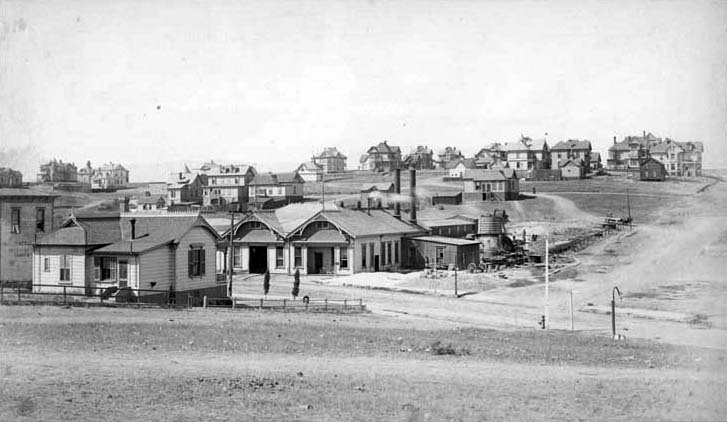 |
|
| (ca. 1890)^## - View of Angelino Heights looking north at the corner of Temple Street and East Edgeware Road. The two buildings on the northwest corner belonged to the Temple Street Cable Railway. The front building with tracks running into its entry is the cable car barn. The building in the rear with the smokestacks is the powerhouse. |
Historical Notes In the late 1940s, a large swath of Angelino Heights was destroyed to build the Hollywood Freeway. The new freeway cut off Temple Street save an overpass at Edgeware Road.^* |
Homes of Angelino Heights
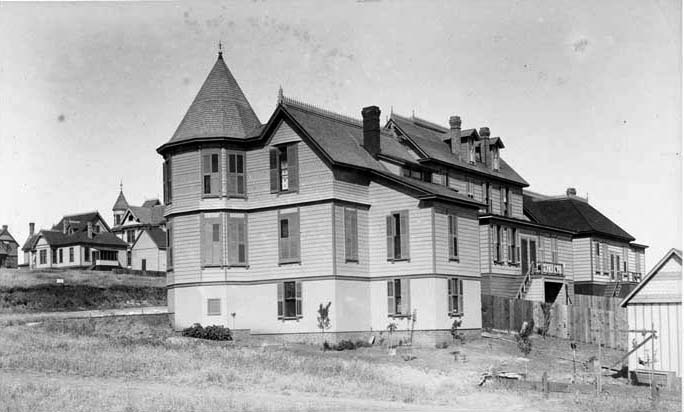 |
|
| (ca. 1890)^## - Close-up view of the multi-story homes of Angelino Heights. |
Historical Notes Angelino Heights was the City of Los Angeles' first recognized historic district, or Historic Preservation Overlay Zone (HPOZ). Enacted in 1983 and spelled out in Angelino Heights' Preservation Plan, this zoning prohibits unsympathetic remodelling of historic houses and requires new construction to resemble original architecture in scale, massing and materials. Today, the district contains many notable examples of Victorian architecture, particularly of the Eastlake and Queen Anne styles, and though found throughout the neighborhood, they are especially concentrated on Carroll Avenue. Two of these residences served as the houses used for the TV shows Charmed and Journeyman, used in the shows as San Francisco Victorian residences, and because of the picturesque nature of the neighborhood, they have served as the backdrop for countless motion pictures from the earliest days of cinema to the present.^* |
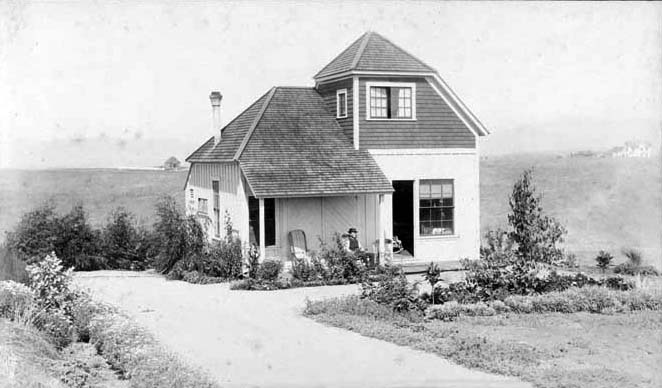 |
|
| (ca. 1895)^## - A man is seen sitting on the front porch of his simplistic but elegantly stylish home in Angelino Heights. |
Historical Notes Traveling around the Angelino Heights today, one can see many styles of architecturally significant homes, such as Craftsman, Bungalow, Mission Revival, Art Deco, and Colonial Revival, to name a few. |
* * * * * |
Vincent Lugo Adobe (Original location of St. Vincent College)
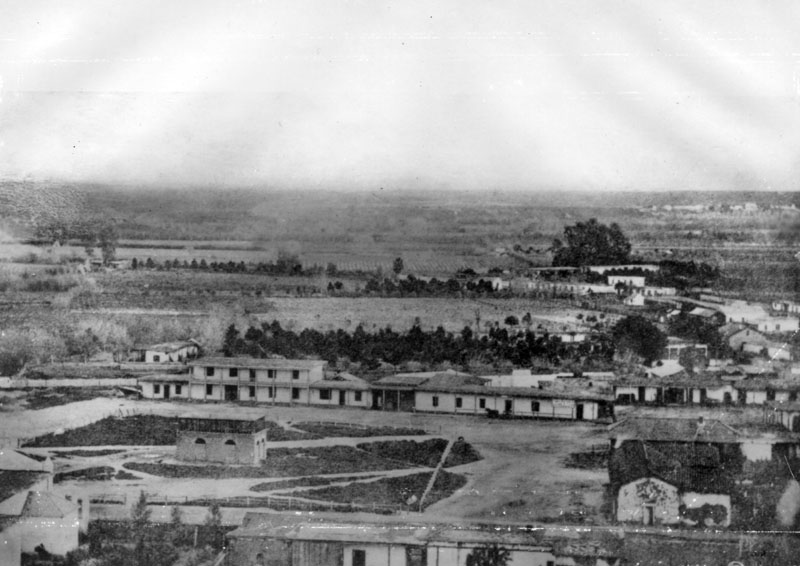 |
|
| (ca. 1858)* - This is the earliest known close-up photograph of the Los Angeles Plaza. There is a square main brick reservoir in the middle of the Plaza, which was the terminus of the town's historic lifeline: the Zanja Madre ('Mother Ditch'). The two-story building behind the reservoir is the Vincent Lugo Adobe House. |
Historical Notes The Lugo Adobe, built in the 1840s by Don Vicente Lugo, was one of the few two-story houses in Los Angeles. The Lugo family, one of the founding families of Los Angeles in 1781, played a significant role in the city's early history. Antonio Maria Lugo, Vicente's father, received a land grant in 1819 for his service in the Spanish army, which included present-day Bell Gardens, and later became mayor of Los Angeles. In 1867, Vicente Lugo donated the house on the Plaza to St. Vincent's School, the predecessor of Loyola University. |
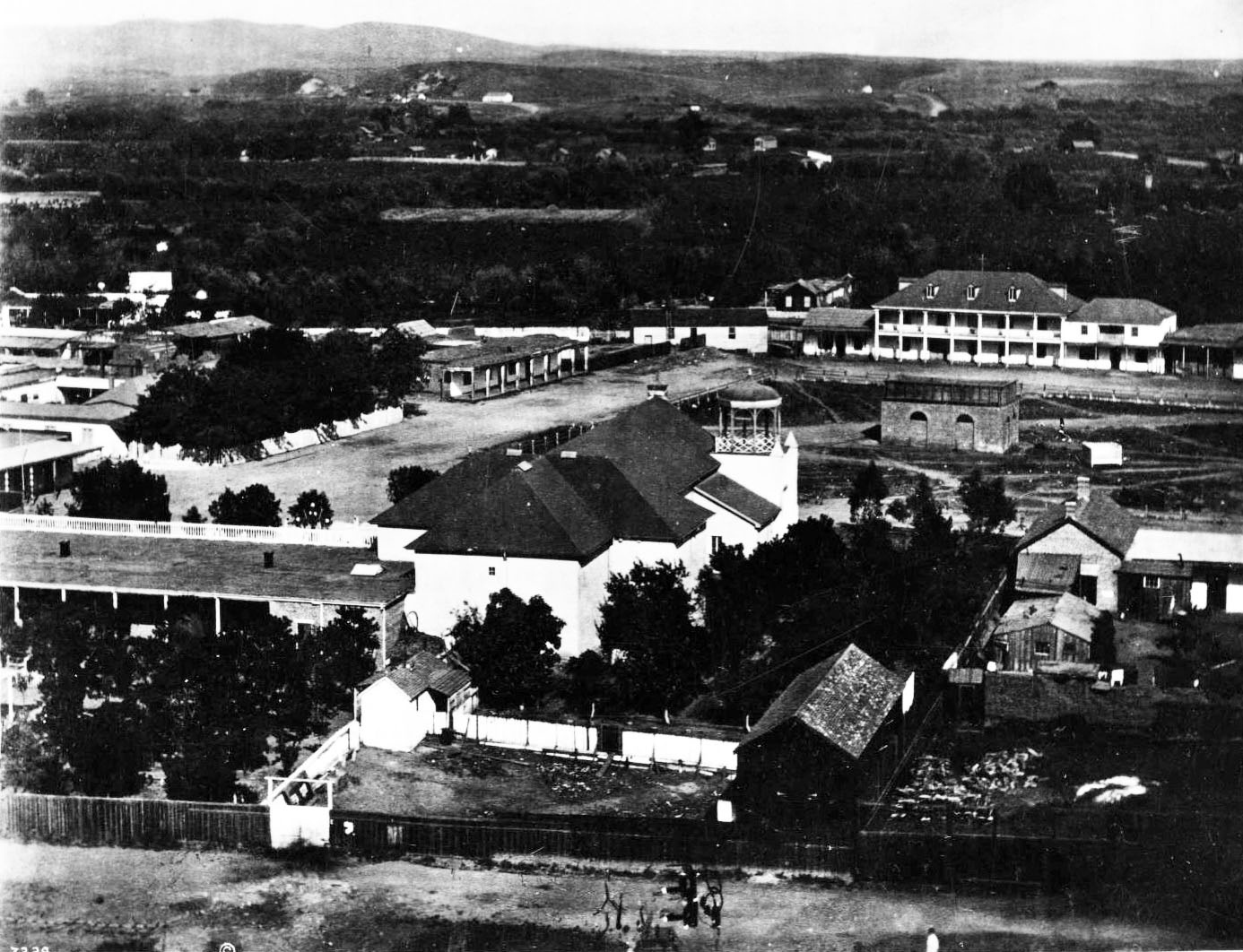 |
|
| (1865)* - View of the LA Plaza looking east, showing the newly refurbished Vincent Lugo adobe, now housing Saint Vincent's College. The Old Plaza Church is seen in the foreground. |
Historical Notes Saint Vincent's College was founded by the Vincentian Fathers in 1865. Initially located in the Lugo Adobe, as described above, the college remained there from 1865 to 1868 before moving to a new location several blocks away. The new campus was bounded by Broadway, 6th Street, Hill Street, and 7th Street. Today, this site is in the heart of Los Angeles's Jewelry District and is known as St. Vincent Court. A decade later, the school moved to a location at Grand Avenue and Washington Boulevard, where it remained until merging with the newly founded Los Angeles College in 1911. This institution evolved into Loyola College of Los Angeles, which eventually became Loyola Marymount University. Click HERE to see more of St. Vincent's College (later LMU). |
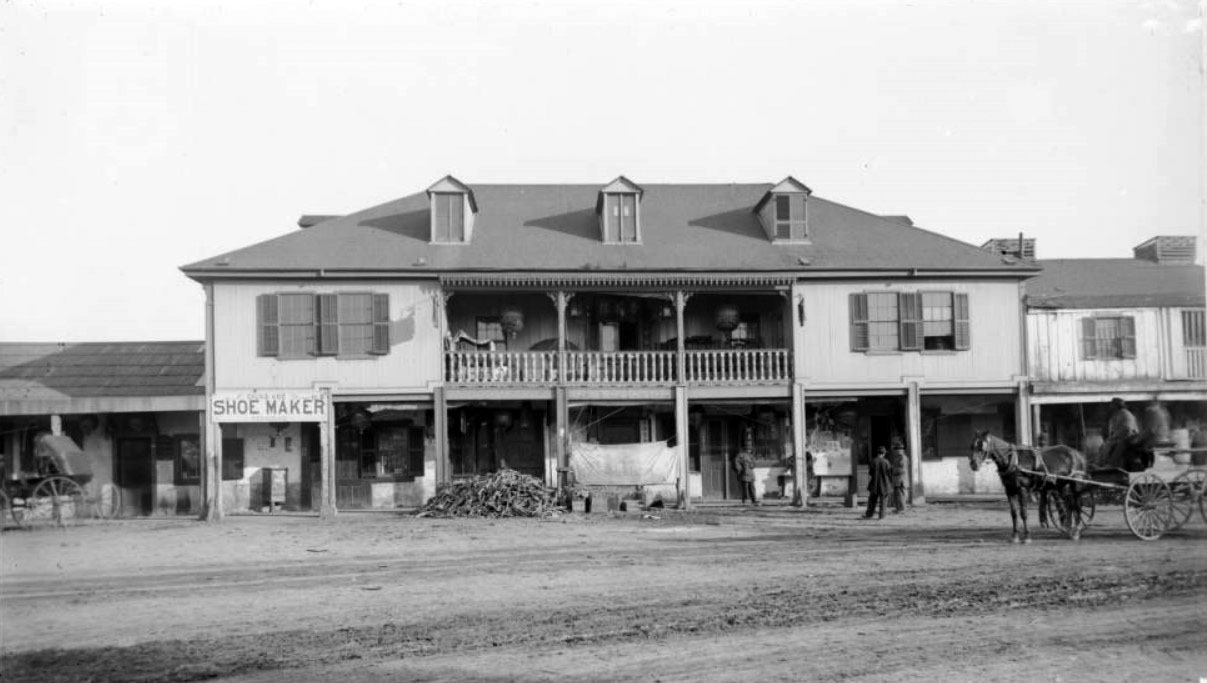 |
|
| (ca. 1886)* - Panoramic view showing the Old Lugo Residence, now a Chinese restaurant in disrepair, on the east side of the Plaza. |
Historical Notes The building features a covered veranda and balcony, four windows with shutters on the second level, and three dormer windows along the roof. In front of the large building, there is a pile of debris or wood. A shoemaker has a shop next door. On the second-story porch, furniture and two Chinese lanterns are visible, with at least eight additional lanterns hanging below. Four men stand in front of the building. A horse and carriage are visible on the right, and another carriage can be seen on the far left. Some signs are in Chinese. Legible signs include: "Chung Kee, shoe maker, repairing," "Chung Kee Co., shoe makers," and "Chinese merchandise, Chinese goods, butcher shop." From the 1880s until it was razed in 1949, the building was occupied by Chinese businesses. |
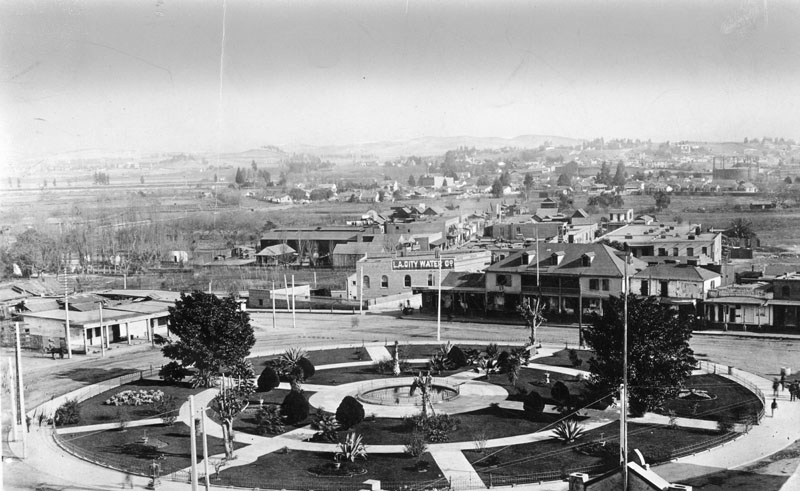 |
|
| (ca. 1890)* - The Los Angeles Plaza, around 1890. The one story building on the left is the former residence of Don Augustin Olvera. The large two story on the right is the former residence of Don Vicente Lugo. The LA City Water Company building is at the northwest corner of Marchessault and North Alameda (at the center of the photo). |
Historical Notes In 1902 the City of Los Angeles took over control of its water system from the LA City Water Company. The building seen with a large sign on its face reading: LA CITY WATER CO., was used by the City's Water Dpartment (later DWP) from 1902 until it was razed in 1939. Click HERE to see more in Water Department's Original Office Building. |
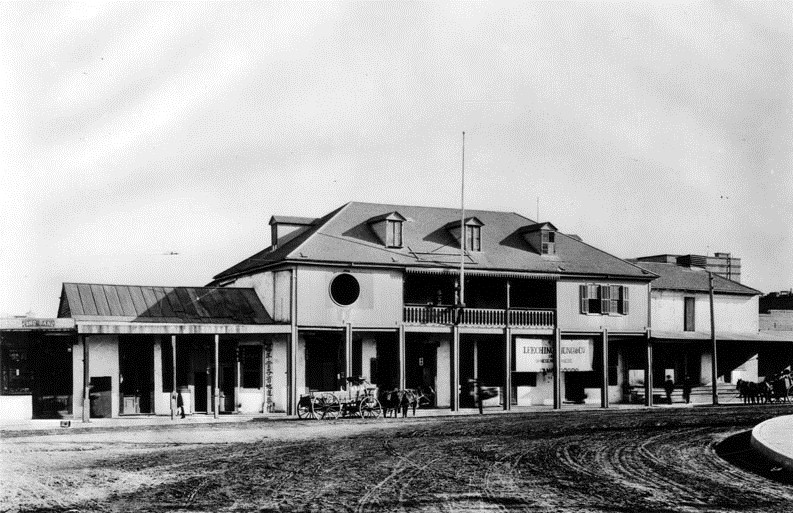 |
|
| (ca. 1890s)** - Exterior front view of the two-story Vicente Lugo adobe house, seen with hipped roof and dormer windows. The home is on S/E corner of Los Angeles and Alameda Streets, and faces the Plaza. |
Historical Notes When this photograph was taken, the adobe was home to Leeching Hung & Co. |
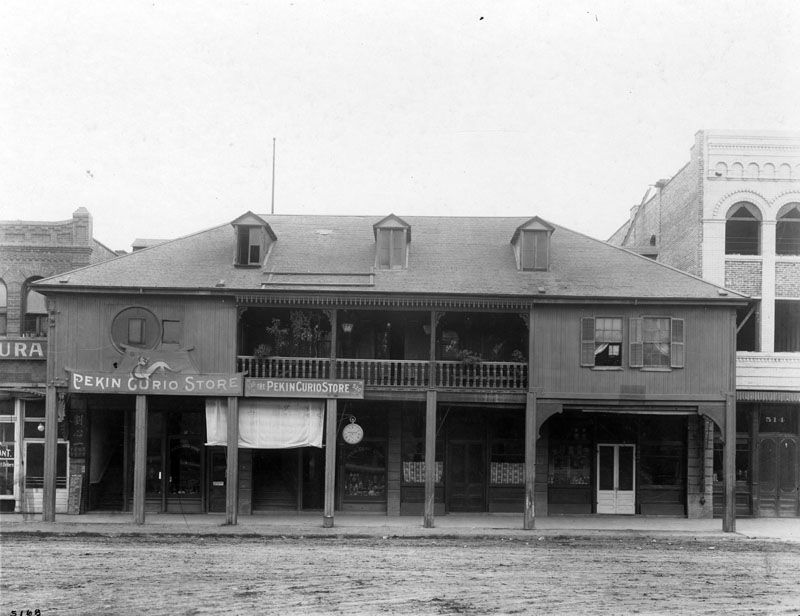 |
|
| (1905)* - View showing the two-story Vicente Lugo adobe house, seen with hipped roof and dormer windows. The home is located at 518-520 North Los Angeles Street and Sunset Boulevard, and faces the Plaza. When this photograph was taken, the adobe was home to the Pekin Curio Store with brick buildings flanking it on either side; and the road was still unpaved. |
Historical Notes La Casa de Don Vicente Lugo located on the east side of the El Pueblo Plaza at North Los Angeles Street and Sunset Boulevard. Built in 1839 by Vicente Lugo, it was one of the few two-story homes in Los Angeles at the time. It was donated in 1867 to St. Vincent's College (which later became Loyola University), the first college in Southern California; but later became known as the Washington Hotel, and later, the Pekin Curio Store. Unfortunately, the structure was so altered, that it does not resemble an adobe. The site of the Vicente Lugo adobe house was designated California State Historic Landmark No. 301. |
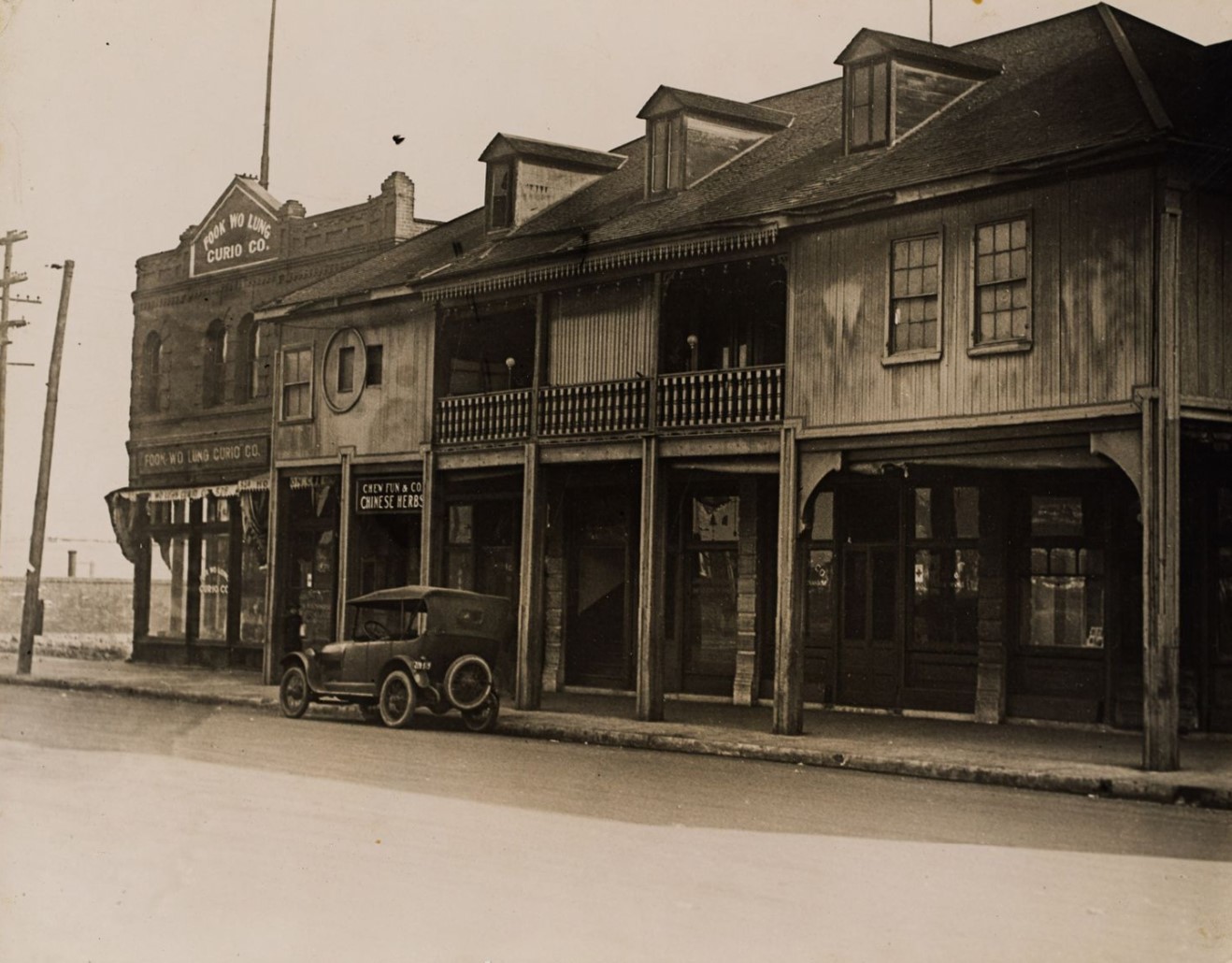 |
|
| (1915)* - View of a row of two-story buildings with balconies in the 500 block of North Los Angeles Street in Old Chinatown, Los Angeles, with signs for "Fook Wo Lung Curio Co." and "Chew Fun & Co. Chinese Herbs" visible and an automobile parked at the street curb. The buildings face the Los Angeles Plaza (not pictured) and the central building (with three dormer windows) was built for Don Vicente Lugo and known as the Lugo Adobe. |
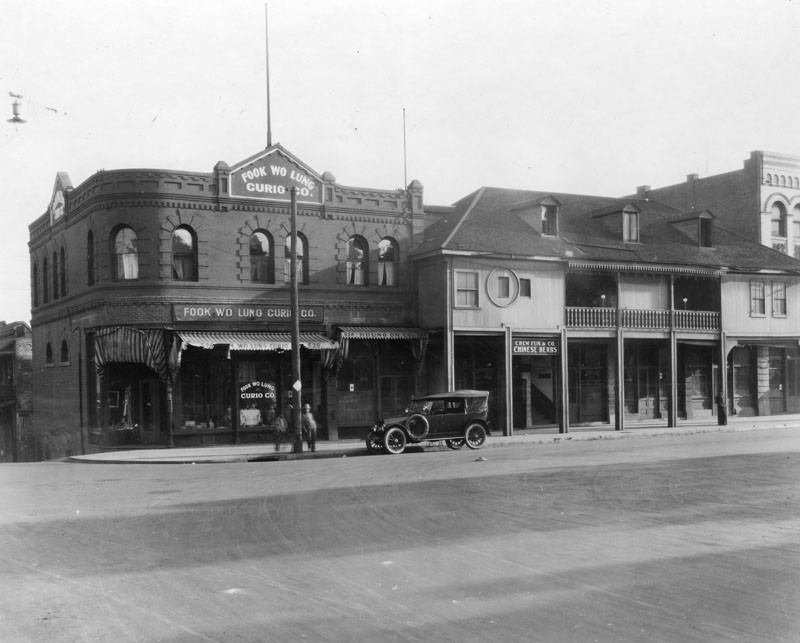 |
|
| (ca. 1920)* - Shops on Los Angeles Street at Marchessault. Shown are the Fook Wo Lung Curio Co., at 526-528, next to Houng On Company, at 524, and Chew Fun and Company, Chinese herbs in the old Vincent Lugo adobe at right. |
 |
|
| (ca. 1930)* - View showing the Old Lugo adobe residence as seen from the LA Plaza, across Los Angeles Street. Three early model cars are seen parked in front. |
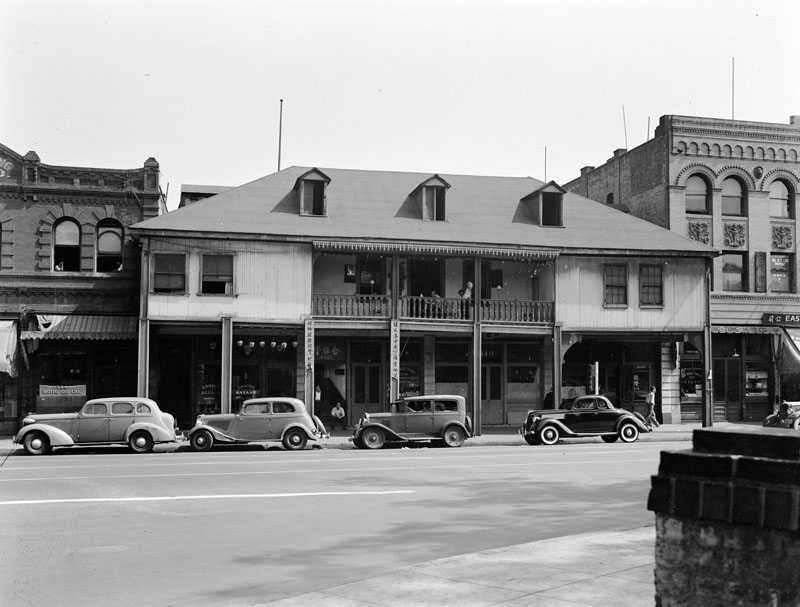 |
|
| (1939)* - View showing the two-story Vincent Lugo adobe house, located on Los Angeles Street and facing the Plaza. It is now flanked by brick buildings, with cars parked on the street in front. |
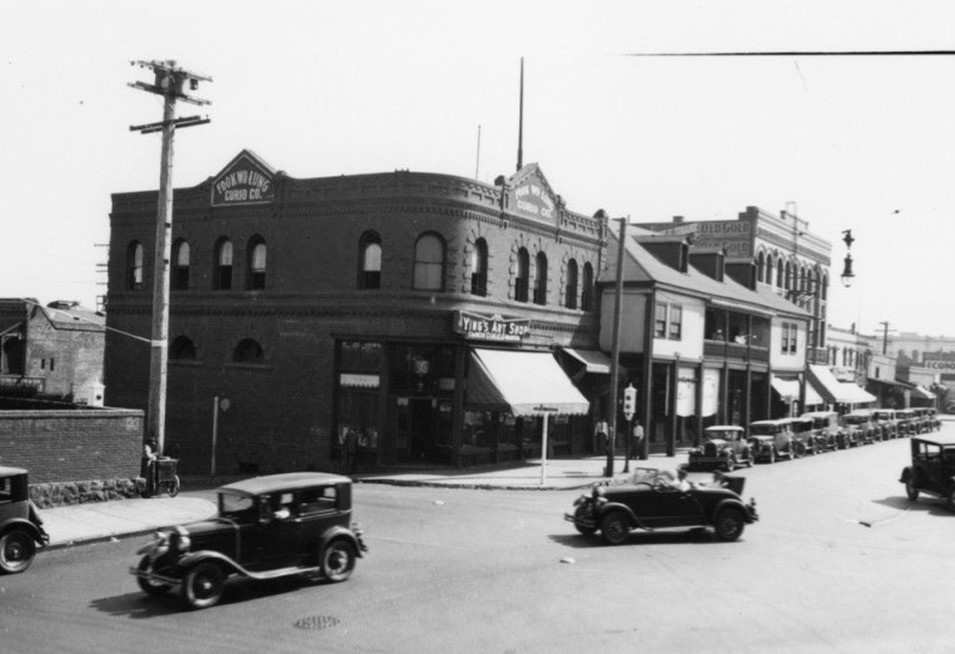 |
|
| (1930s)* – Looking at the SE corner of Los Angeles and Marchessault streets showing Ying's Art Shop located in Fook Wo Lung Curio Company building. To its right is the old Vincent Lugo Adobe house. |
Historical Notes Marchessault Street was located along the north side of the historic Los Angeles Plaza. It was named after Damien Marchessault, a French-born two-time mayor of the city who later died by suicide. |
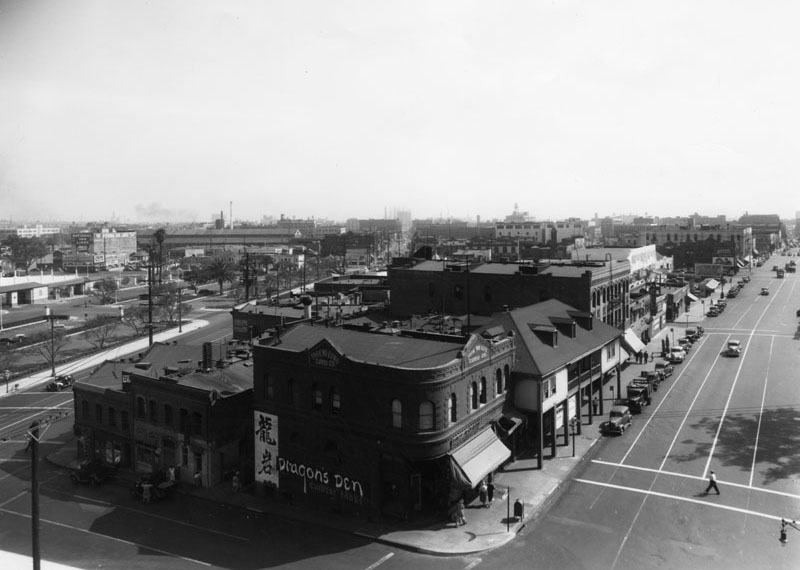 |
|
| (ca. 1939)* - View of Chinatown, looking south on Los Angeles and Marchessault streets. The Dragon's Den, a Chinese food restaurant, is in the Fook Wo Lung Curio Company building at the corner of the block with the Lugo Adobe next to it. |
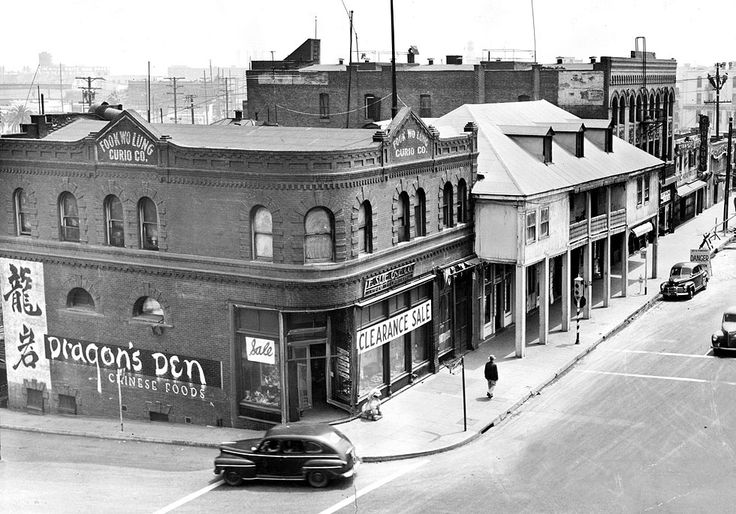 |
|
| (1949)* - View of the southeast corner of Marchessault and Los Angeles St. The old two-story Vincent Lugo Adobe house can be seen with its hipped roof and dormer window. It sits directly across the street from the LA Plaza. The brick building on the corner is the Fook Wo Lung Curio Company building. The painted sign on its side reads: Dragon's Den Chinese Food. |
Historical Notes In 1935, Eddy See opened the Dragon's Den Restaurant in the basement of the F. Suie One Company. On the exposed brick of the basement walls, Benji Okubo, Tyrus Wong and Marian Blanchard painted murals of the Eight Immortals and a dancing dragon. An arty crowd, including Walt Disney and the Marx Brothers, came to see the murals and sample the "authentic fare." In an era when Chinese restaurants were known as chop-suey joints, Dragon's Den served egg foo young, fried shrimp and almond duck. Non-Chinese diners during the Great Depression considered these "exotic" dishes. |
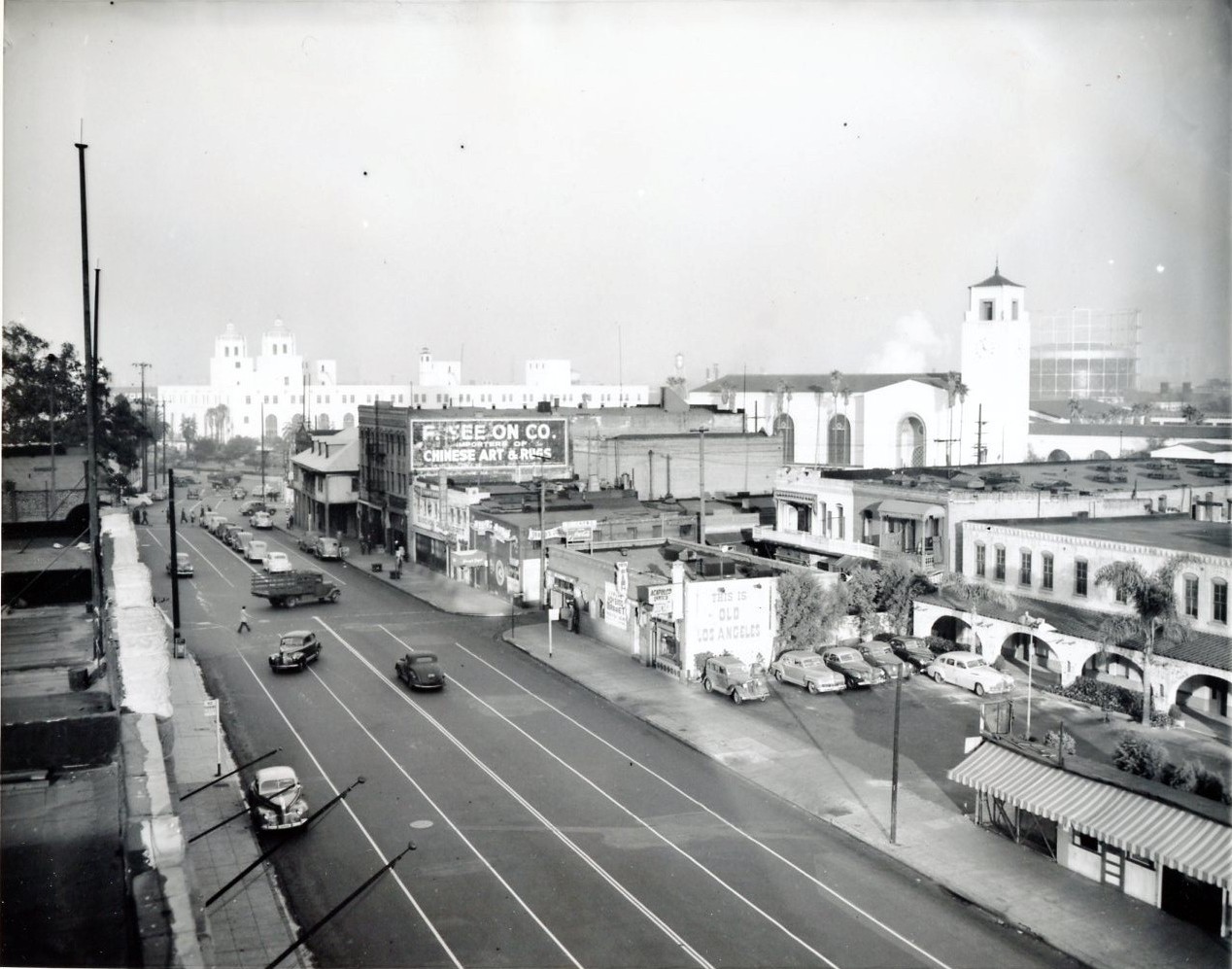 |
|
| (1947)* - View of Los Angeles Street looking north. The large trees in the upper left are in the LA Plaza and across the street is the Vincent Lugo Adobe with its distinctive hipped roof and dormer windows. In the background can be seen both the Terminal Annex Post Office and Union Staion. |
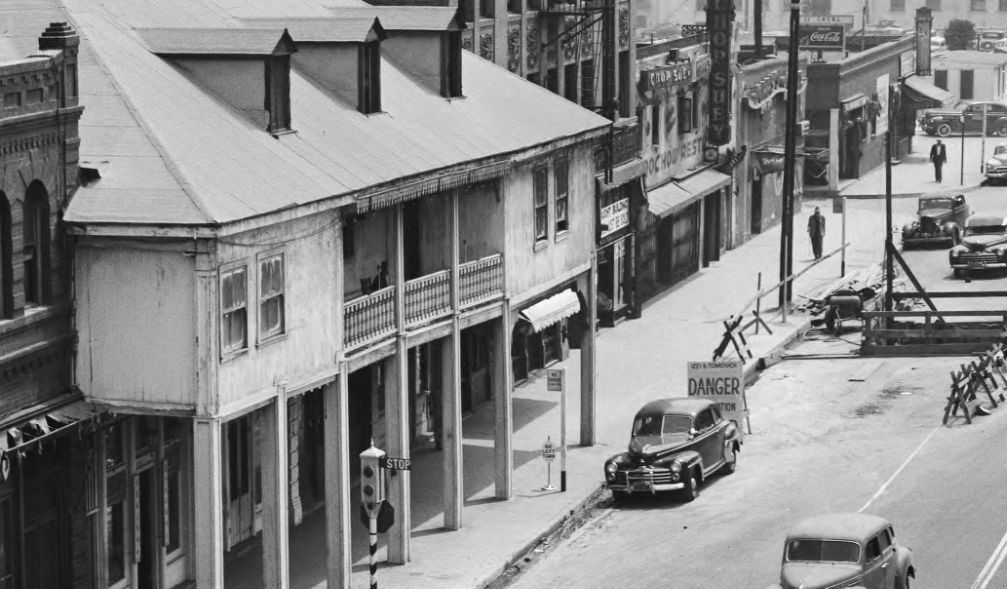 |
|
| (1949)* – Close-up view of the Vincent Lugo adobe in its last days of existence. |
Historical Notes The last vestige of Old Chinatown, a block of buildings between Sunset Boulevard and Los Angeles, Alameda and Aliso streets, was demolished in 1949 to make way for the Hollywood Freeway and a park. Included in that cluster of 22 razed buildings was the home of Vicente Lugo, the first two-story residence on the plaza. He donated the house to the parish priest in the 1850s. The house became the first home of St. Vincent's College (now Loyola Marymount University) in 1865, named for Lugo's patron saint, Vincent de Paul, a 17th century French priest who founded the Vincentian Fathers. |
.jpg) |
|
| (2010)* – Aerial view showing the site of the old Vincent Lugo Adobe. |
Historical Notes The Vincent Lugo Adobe was demolished in 1949 to make way for urban redevelopment, including the construction of the Hollywood Freeway, despite preservation efforts. The site, now part of Father Junípero Serra Park, is located on the east side of the Los Angeles Plaza, just west of Union Station and east of Olvera Street. This park serves as a green space and historical marker, commemorating the location of the former Lugo Adobe. A marker at the site acknowledges the significance of the adobe, detailing its construction in the 1840s, its donation to St. Vincent's School, and its role in the community before its demolition. |
* * * * * |
Avila Adobe (1818)
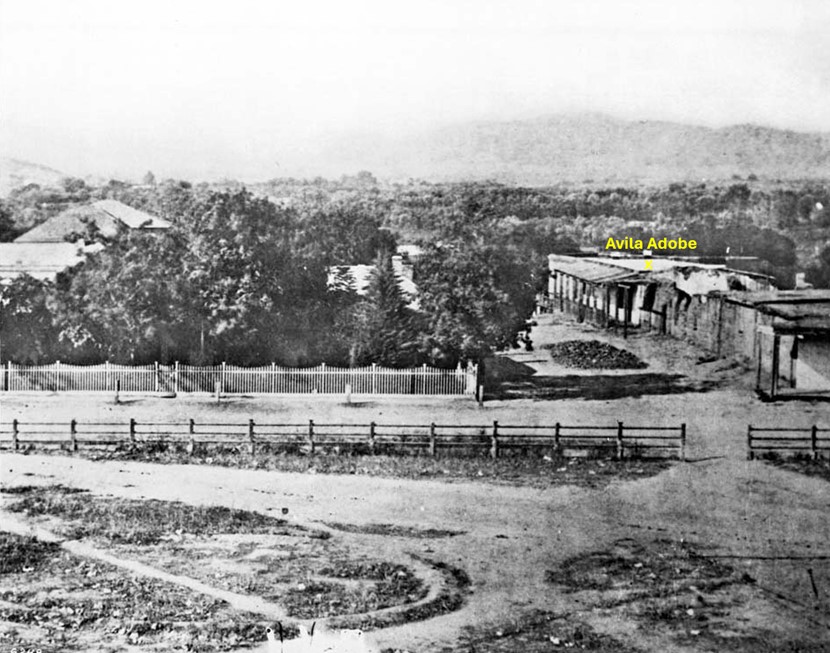 |
|
| (ca. 1869)* - View of the edge of the Los Angeles Plaza and the entrance to Wine Street (renamed Olvera Street in 1877) looking north from the Pico House. The Avila Adobe is visible at center-right on Wine Street. |
Historical Notes Don Francisco Avila, a wealthy cattle rancher and one-time Mayor of the pueblo of Los Angeles, built the Avila Adobe in 1818. The Avila Adobe, presently the oldest existing residence within the city limits, was one of the first town houses to share street frontage in the new Pueblo de Los Angeles. |
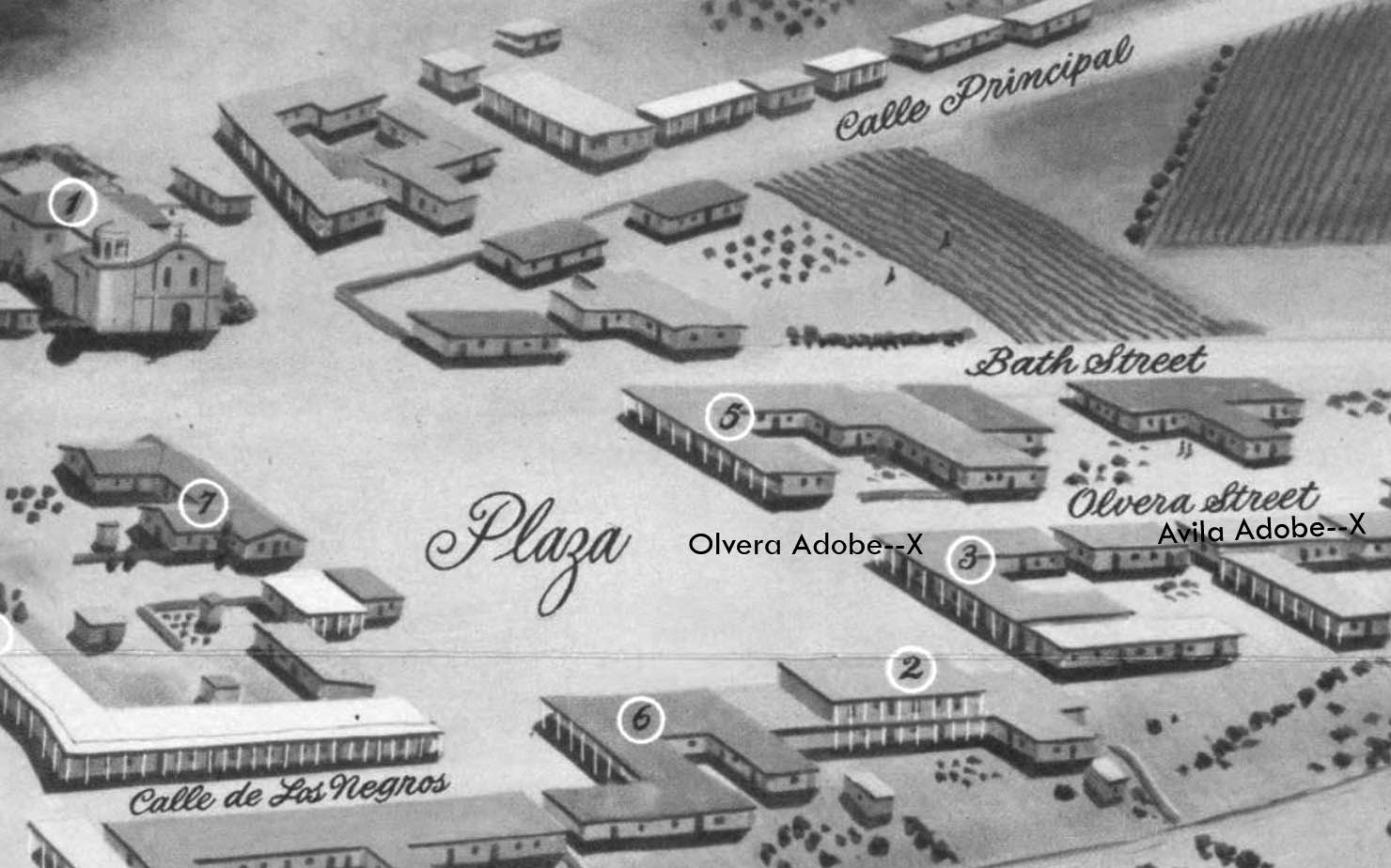 |
|
| (1850)* - Map view looking northwest showing the LA Plaza and surrounding area as it appeared in 1850. To the right can seen Olvera Street (Wine Street until 1877) at its intersection with the Plaza, with both the Olvera Adobe and Avila Adobe locations marked with an X. The Plaza Church is in the upper left corner. |
Historical Notes Francisco Ávila died in 1832, but his widow Encarnación continued to live in the adobe until her death in 1855. During the Mexican-American War in 1846, American forces briefly occupied the building. After the war, the Avila family reclaimed their home. |
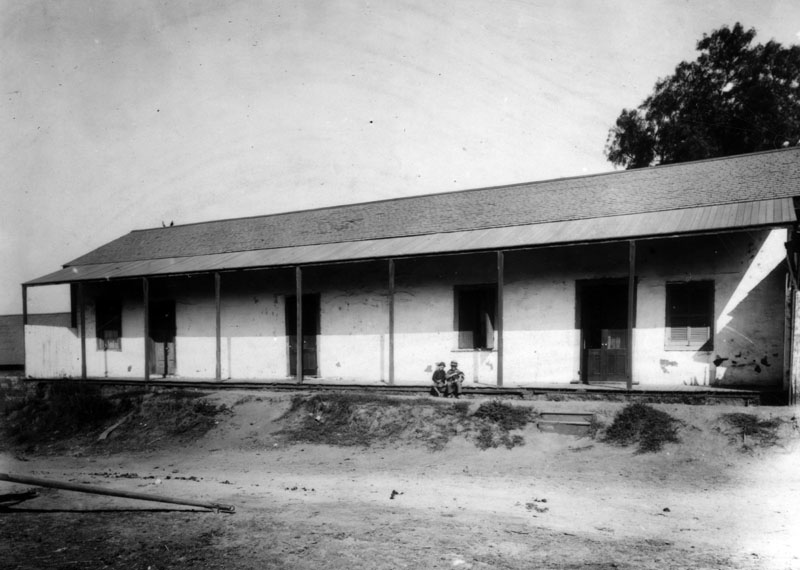 |
|
| (1890)* - Avila Adobe house on Olvera Street as it looked in 1890; two young boys sit on the porch. |
Historical Notes The adobe was built using traditional methods, with thick walls made from sun-dried mud and straw bricks, which provided natural insulation against the Californian climate. |
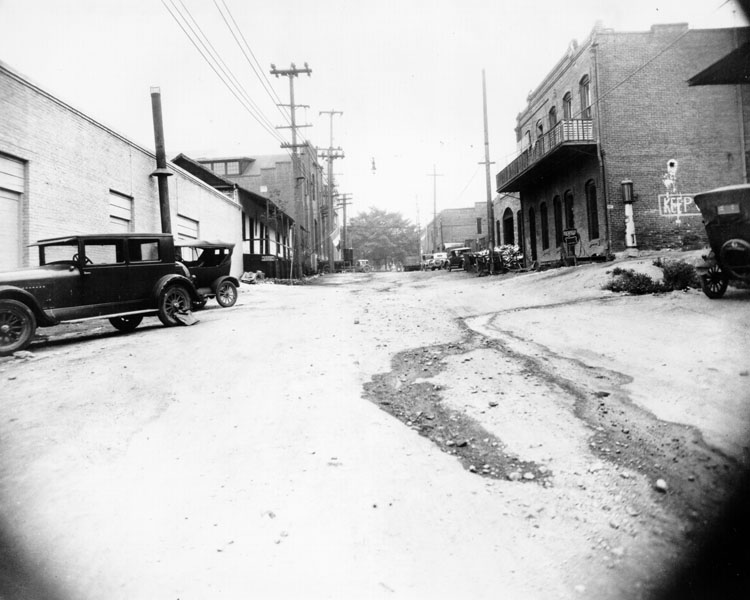 |
|
| (1920s)* - View looking south of Olvera Street before improvement and also before City Hall was built. On the left the Avila Adobe is seen. To the right is the Sepulveda House with a gas pump on by its side and at the end of the street is the Los Angeles Plaza. |
Historical Notes By 1926, the city of Los Angeles condemned the deteriorating structure, planning to demolish it for a gas station. However, Christine Sterling, a preservationist from San Francisco, intervened. She launched a campaign to save the adobe and transform the surrounding area into a cultural center. |
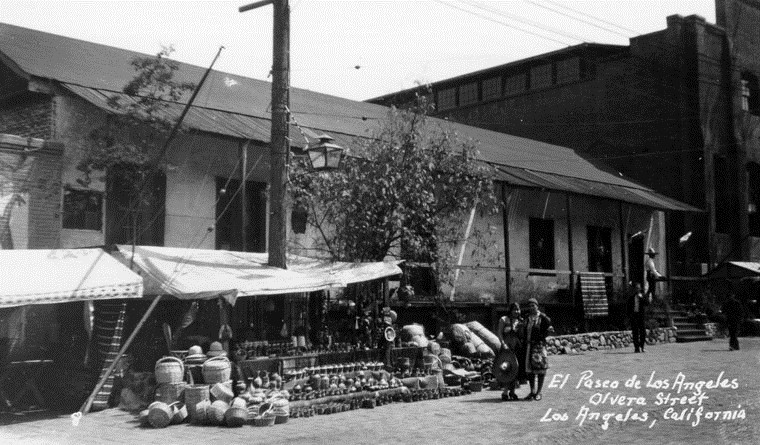 |
|
| (ca. 1930)* - A view of Olvera Street looking across at vending booths in front of the Avila Adobe with two pedestrians walking near. |
Historical Notes In 1930, through the efforts of activist Christine Sterling, the Plaza-Olvera area was revived with the opening of Paseo de Los Angeles (which later became popularly known by its official street name Olvera Street). |
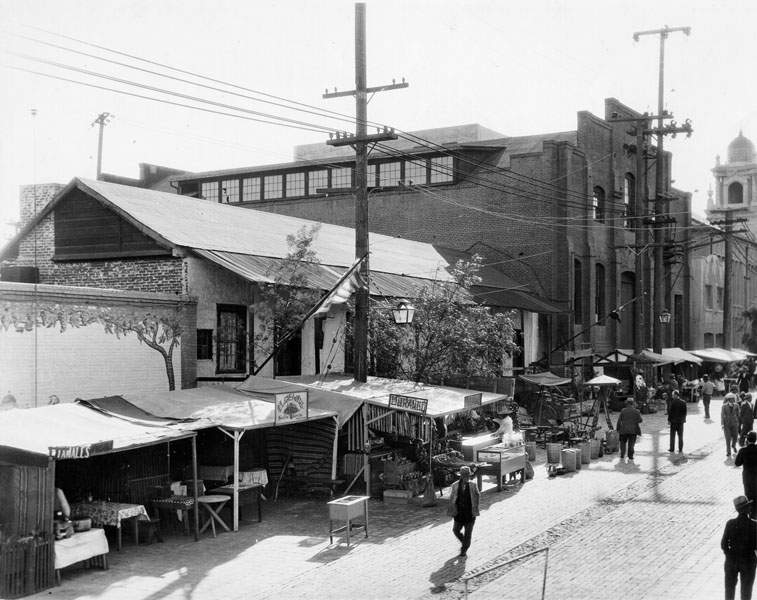 |
|
| (1932)* - View of the Avila Adobe house on Olvera Street, taken in 1932 - two years after Olvera Street was converted to a colorful Mexican marketplace - as made evident by the small vendor stands visible throughout. |
Historical Notes Thanks to Sterling's efforts and support from influential figures like Harry Chandler of the Los Angeles Times, the Avila Adobe was restored in 1929-30. This restoration coincided with the opening of Olvera Street as a Mexican marketplace, breathing new life into the area. |
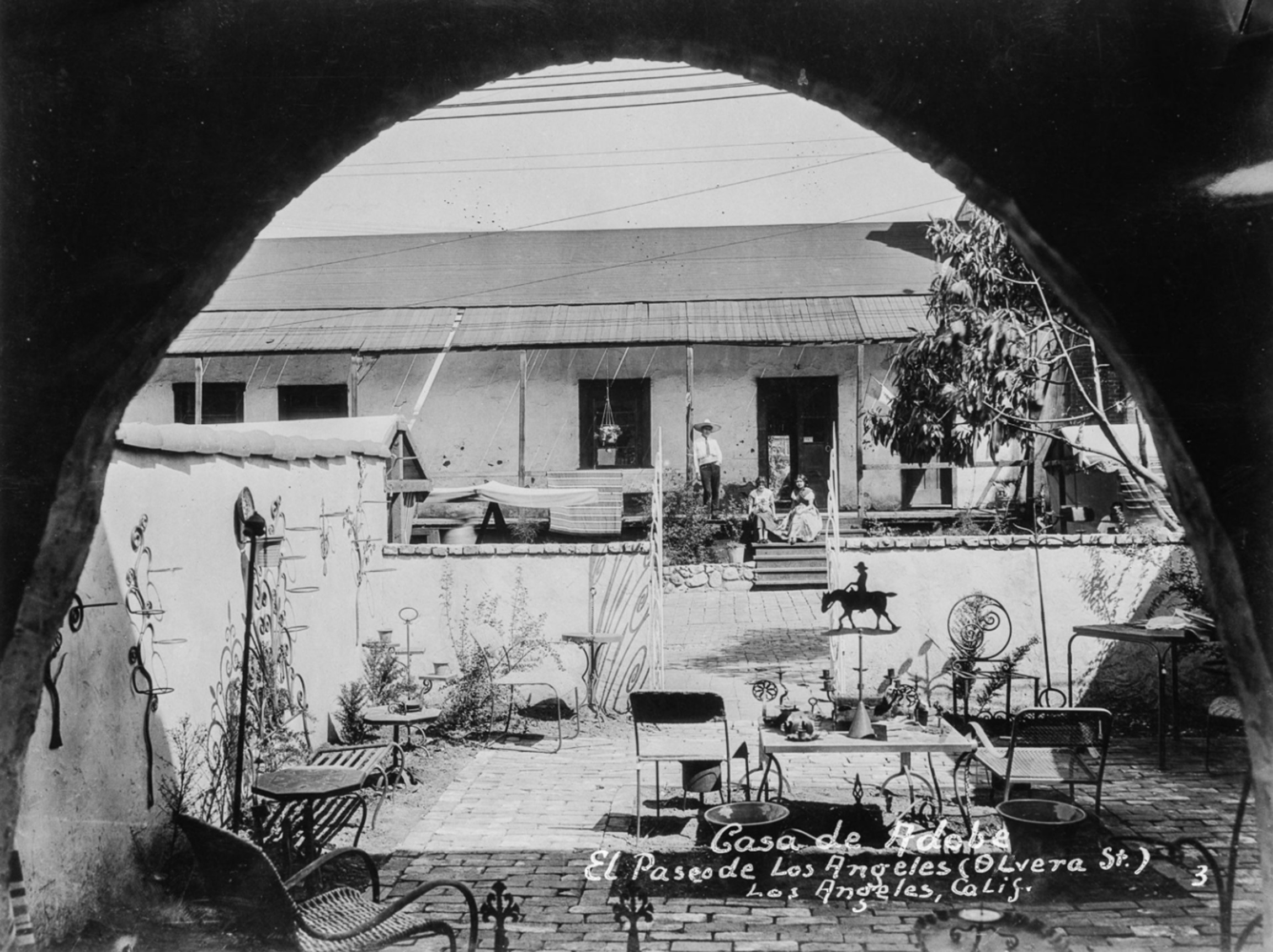 |
|
| (1930s)* – Looking through an archway across a courtyard showing a man and two women on the porch of the Avila Adobe on El Paseo de Los Angeles. Photo from the Ernest Marquez Collection. |
Historical Notes Located at 10 Olvera Street, the Avila Adobe was built in 1818 by Francisco Ávila, a prominent cattle rancher and early mayor of Los Angeles. It is recognized as the oldest standing adobe house in the city. |
 |
|
| (1930s)* – Postcard view showing the Avila Adobe on Olvera Street. |
Historical Notes In the 1930s, the Avila Adobe underwent a significant transformation, becoming a central feature of the revitalized Olvera Street area. The building’s restoration aimed to educate visitors about early Los Angeles history and Mexican-American heritage, positioning the adobe as a focal point of a newly imagined 'Mexican Marketplace of Yesterday.' Showcasing original architectural features and period furnishings, the presentation highlighted a romanticized view of the region's Spanish and Mexican past. This transformation not only preserved one of Los Angeles' oldest residences but also contributed to the cultural identity of the area, making it one of the city’s most visited tourist attractions. |
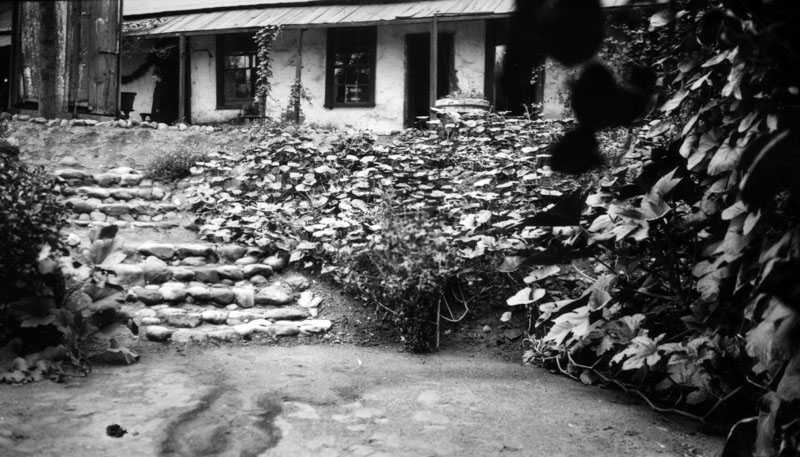 |
|
| (1930s)* - View of the Avila Adobe house on Olvera Street, showing the rear of the home. Several windows and doorways are visible under the long, covered "corredor" (or porch); steps lead down to a lower area of the courtyard. |
Historical Notes The Avila Adobe consisted of a generous courtyard with covered porches for each of the garaging areas, stables, workshops, etc., as well as a garden and vineyard, which Don Francisco tended to regularly. |
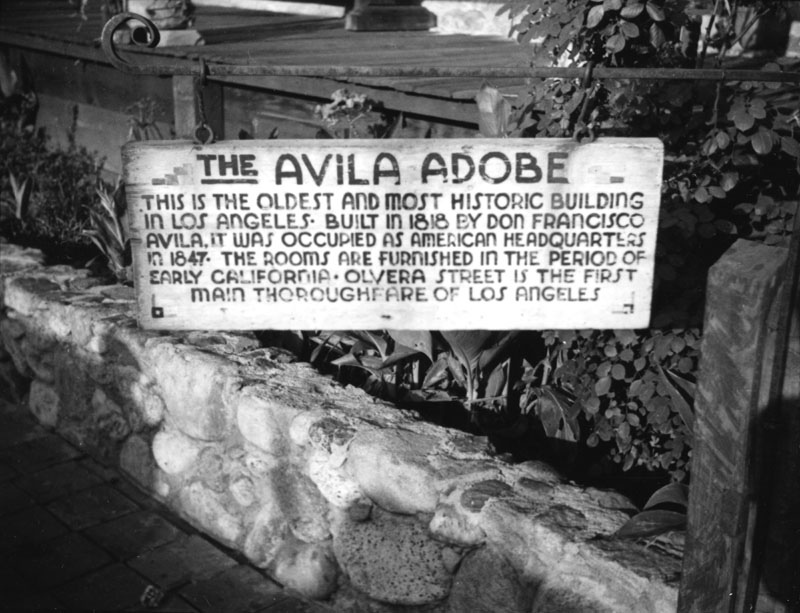 |
|
| (ca. 1935)* - View of the sign in front of the Avila Adobe, the oldest existing residence within the city limits. |
Historical Notes The sign for the Avila adobe reads "This is the oldest and most historic building in Los Angeles. Built in 1818 by Don Francisco Avila it was occupied as American headquarters in 1847. The rooms are furnished in the period of early California. Olvera Street is the first main thoroughfare of Los Angeles.” |
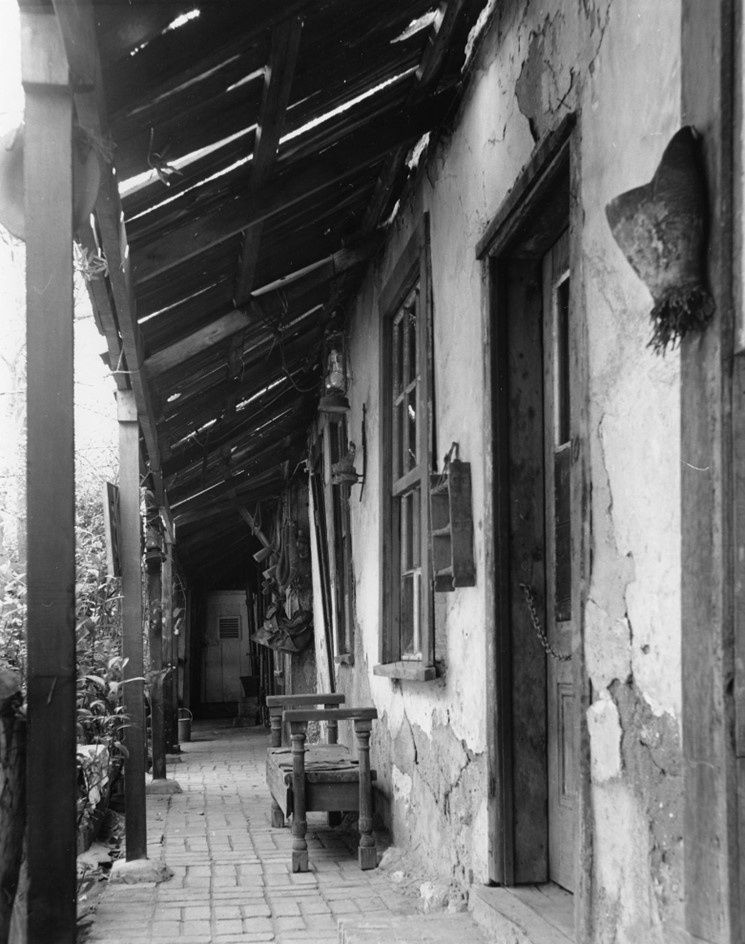 |
|
| (1945)* - View of patio of Avila Adobe showing bench and foliage. Photo by Arnold Hylen. |
Historical Notes The Avila Adobe's front entrance along Olvera Street showcases a distinctive architectural feature added by Francisco Avila: a wooden veranda with small staircases leading up to the porch. The entrance is characterized by an arched, gated alleyway on the southeast side of the pedestrian-only Olvera Street, serving as an inviting gateway to the historic property. This design not only enhances the adobe's aesthetic appeal but also provides visitors with a tangible connection to Los Angeles' past. The entrance offers a glimpse into the vibrant Mexican marketplace atmosphere of Olvera Street while leading to the oldest standing residence in the city. |
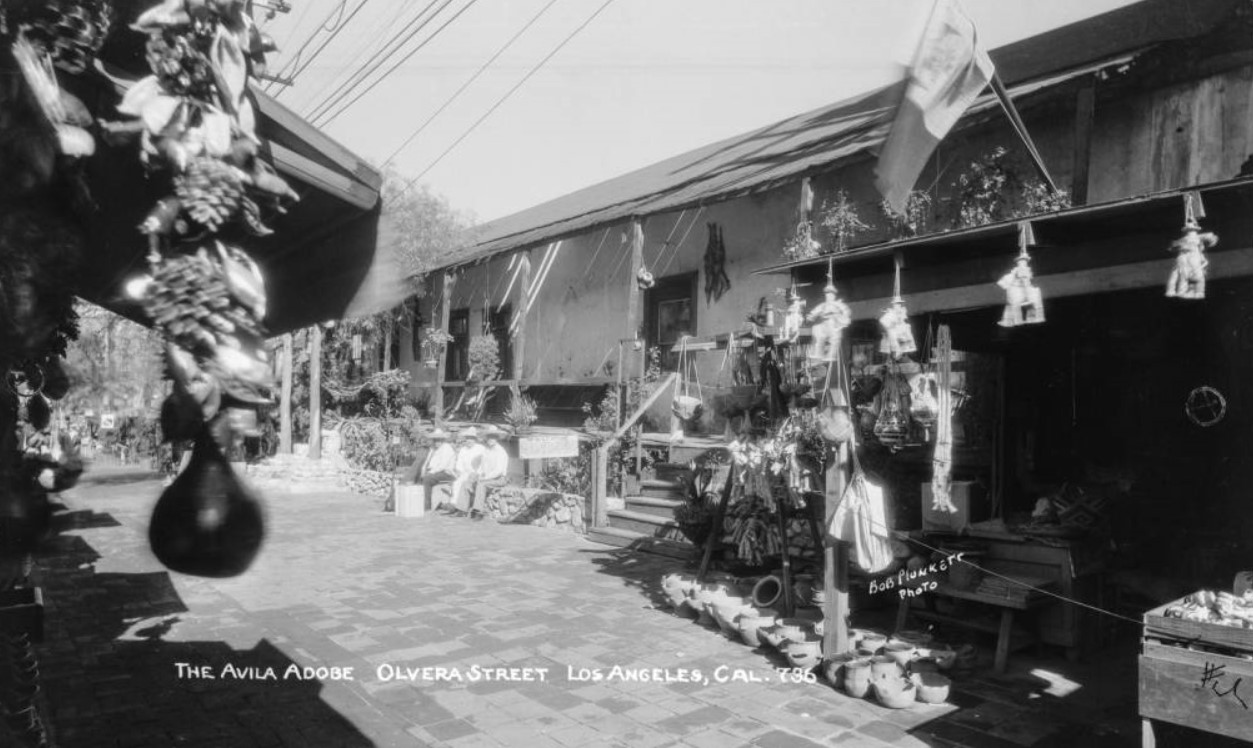 |
|
| (1948)* – Postcard view showing the Avila Adobe on Olvera Street. Built in 1818 by Don Francisco Avila it was occupied as American headquarters in 1847. |
Historical Notes In 1953, the State of California acquired the Avila Adobe as part of El Pueblo de Los Angeles State Historic Park, and has been opened to tours since 1976. The Avila Adobe is registered as California Historical Landmark #145, while the entire historic district is both listed on the National Register of Historic Places and as a Los Angeles Historic-Cultural Monument. |
Then and Now
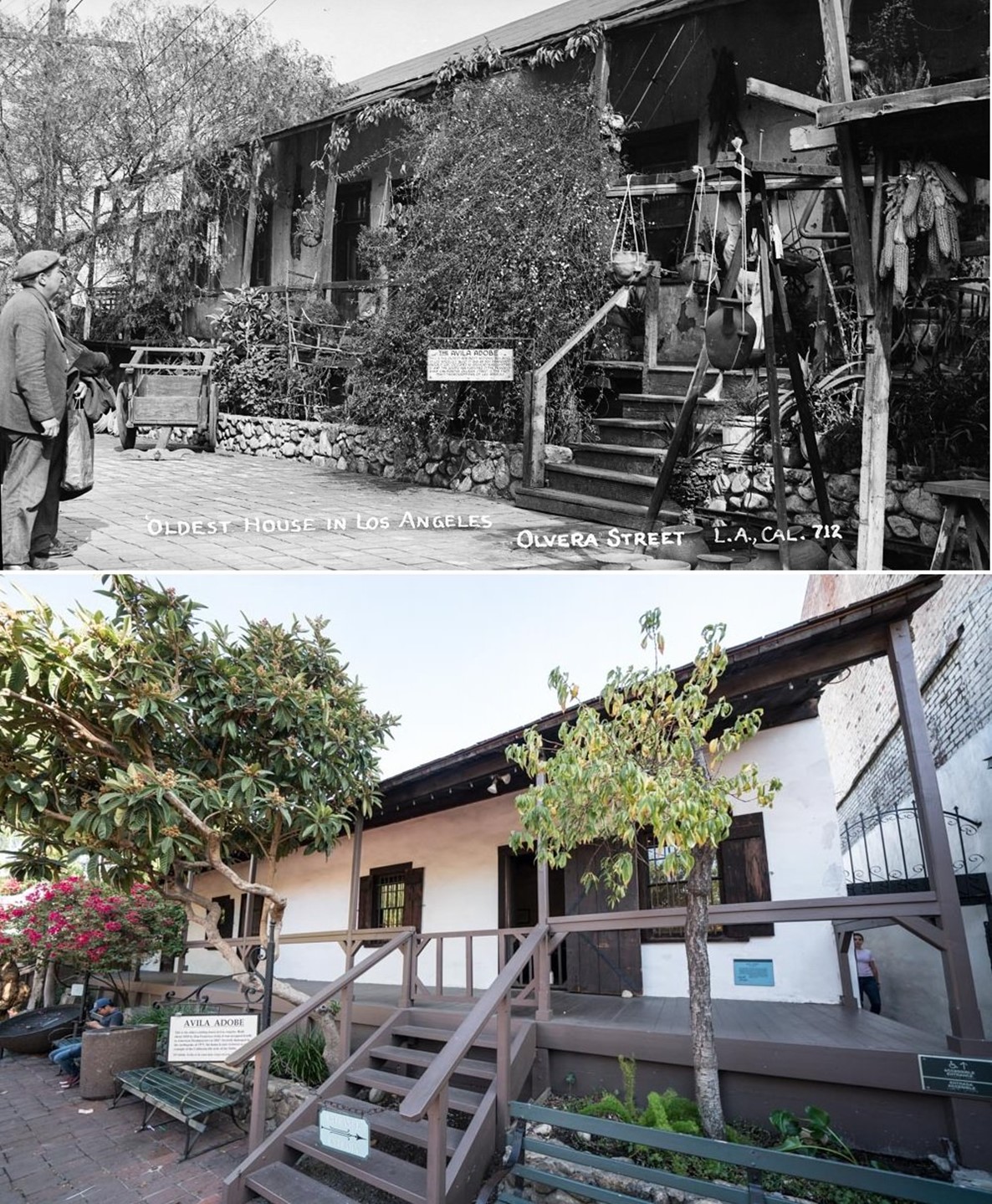 |
|
| (1948 vs. 2020)* - Avila Adobe, the oldest existing residence within the city limits. |
Historical Notes Avila adobe holds the record for being the oldest house in Los Angeles. It was built in 1818 by Francisco Avila. It's protected by the Los Angeles Plaza Historic District & California State Historic Park. The walls of the Avila Adobe are 2.5–3 feet thick and are built from sunbaked adobe bricks. |
* * * * * |
Vickrey-Brunswig Building
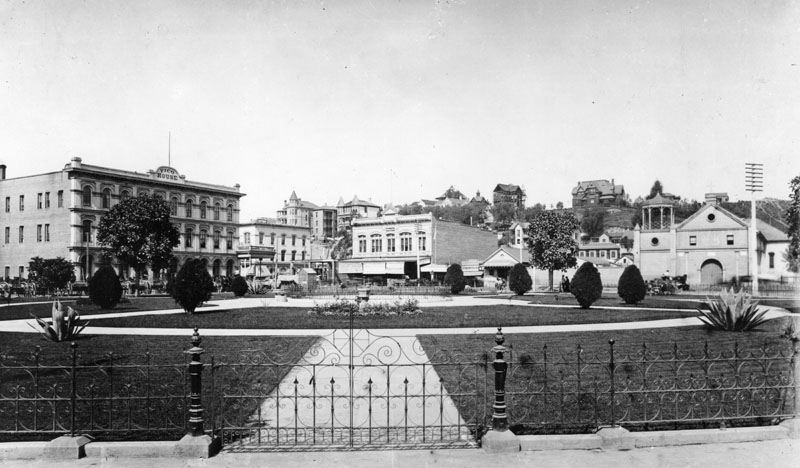 |
|
| (ca. 1887)* - A view of the Los Angeles Plaza looking southwest with the Pico House to the left and the Old Plaza Church on the right. The 2-story 'Plaza House' (built in 1883) sits directly across the Plaza on the west side of Main Street. The Vickrey-Brunswig Building, one of the City's first 5-story buildings, would be built within a year of this photo just to the left (south) of the Plaza Building. |
Historical Notes In 1887, during the height of the real estate boom, investor William Vickrey bought a parcel of land on North Main Street, on which he commissioned construction of the Vickrey-Brunswig Building. Originally the site of an adobe owned by Jesus Dominguez, the land was purchased by Vickrey from the City of Los Angeles for a total cost of $3,925. Los Angeles city directories from the mid-1880s list Vickrey's occupation as "capitalist." He established and served as president of the East Side Bank, which was located at 510 Downey Avenue in downtown Los Angeles.^^^^ |
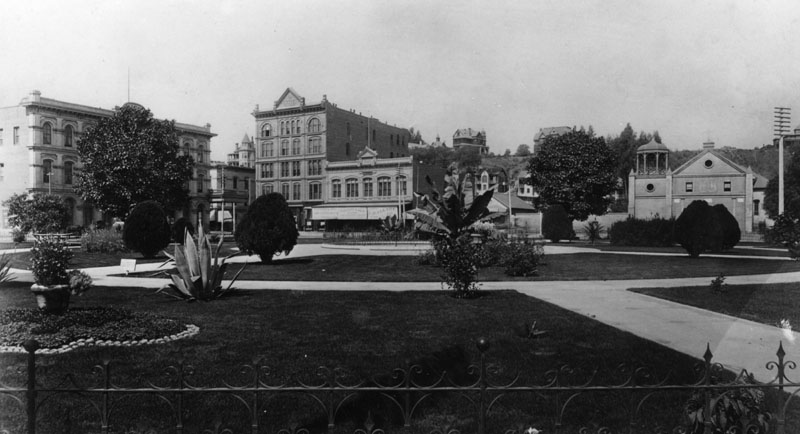 |
|
| (ca. 1890)* - Same view as previous photo but three years later. The new additon to the scene is the 5-story Vickrey-Brunswig Building built adjacent to the Plaza House. |
Historical Notes Construction of the Vickrey-Brunswig Building took place in 1888, the year marking the abrupt collapse of the real estate boom that had driven rapid construction and market speculation through the 1880s. Soon after completion of the building, Vickrey would be forced to declare insolvency and then lose the property to his lender.^^^ The Victorian-era brick Vickrey Building was among the earliest five-story buildings in Los Angeles. When it opened in 1888, the building housed ground floor retail with lodging on the upper floors. * The two-story Plaza House (built in 1883) was commissioned by Frenchman Philippe Garnier, whose name appears at the base of the decorative false gable parapet rising above the roofline. It was once the site of La Esperanza Bakery. |
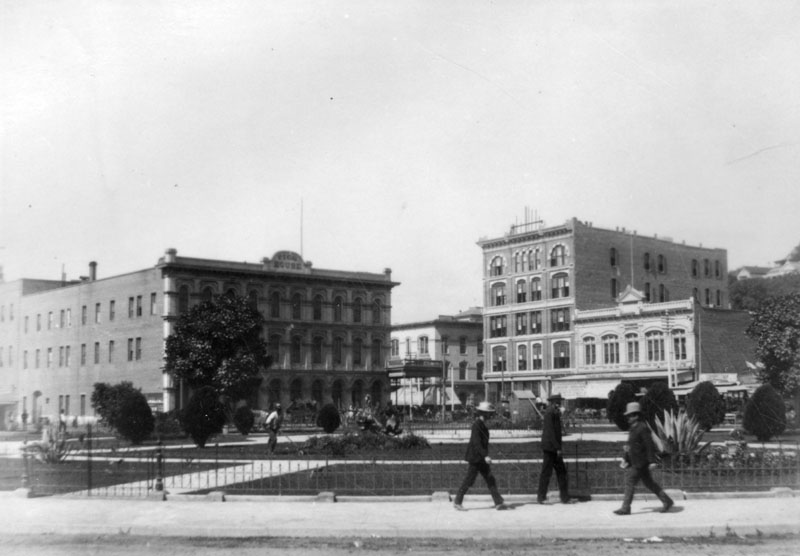 |
|
| (ca. 1890s)* - Closer view showing the new 5-story Vickrey-Brunswig Building located on N. Main Street across from the LA Plaza and also across the street from the Pico House. Men are seen strolling in front of the Plaza. |
Historical Notes In 1897, the Vickrey Building was purchased by F. W. Braun and Company, and for more than three decades was associated with the pharmaceutical industry. Reorganized as the Brunswig Drug Company in 1907 following its purchase by part owner and prominent Angeleno Lucien Brunswig, the company expanded dramatically and developed into the largest pharmaceutical manufacturing laboratories west of Chicago. * |
 |
|
| (ca. 1920)^^* - View of the Brunswig Building located on the northwest corner of N. Main and Republic streets. The name of the building appears on two signs, one over the doorway and one on top of the roof. |
Historical Notes Prominent architect Robert Brown Young designed the building in a transitional Italianate style, varying the treatment of each story of the facade for greater visual interest. The windows of the upper floor feature Romanesque arches, while those of the third floor are embellished with turned posts that serve as the mullions between the grouped sashes. Architect R. B. Young was the principal of one of Los Angeles's earliest architectural firms, R.B. Young & Son. Young's office garnered a number of prestigious hotel commissions, such as the Clifton (his first commission in Los Angeles, at the corner of Broadway and Temple Streets), Lankershim, Westminster, Lexington, Hollenbeck, and Occidental hotels. Young also designed the Lankershim office building, the Barker Brothers' block, the Wilson Block, and the California Furniture Company.^^^^ |
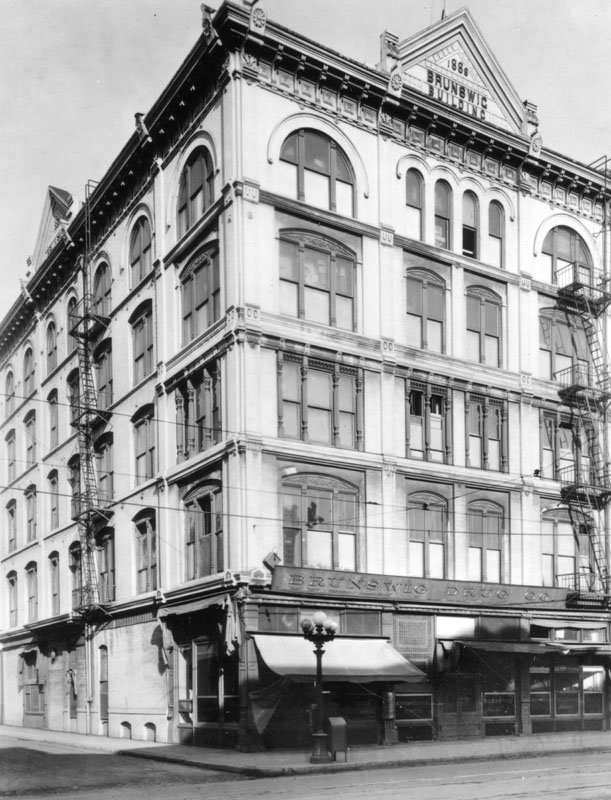 |
|
| (ca. 1921)* - Closer view of the Brunswig Building located at 501 N. Main Street. The roof sign reads: 1888 - Brunswig Building. The sign over the building entrance reads: Brunswig Drug Co. |
Historical Notes The Vickrey-Brunswig Building was constructed of brick on a trapezoidal plan and stands five stories with a full basement. It was constructed in the Italianate style commonly used for commercial architecture in the Iate-19th and early 20th centuries. Characteristic elements of the building include the decorative stringcourse located above the fifth floor windows and the segmental and rounded arched brick windows featured on the south and west elevations.^^^^ |
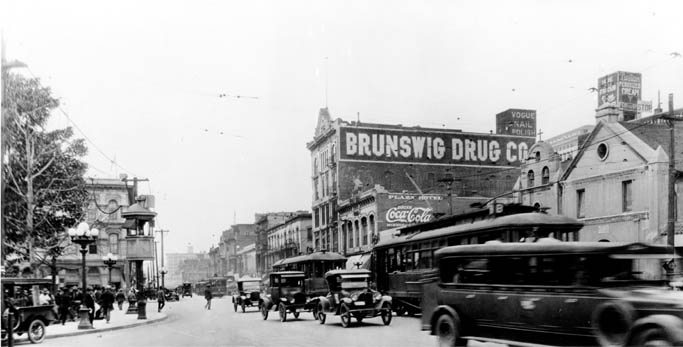 |
|
| (1920)**#^- View looking south on Main Street showing the Old Plaza Church and Brunswig Building (Brunswig Drug Company) on the right and the LA Plaza and Pico House on the left. The new City Hall which would stand two blocks south would not be built until 1928. Early model cars share the road with electric streetcars. |
Historical Notes Note the elevated kiosk on the edge of the plaza to the left ot the photo. Elevated booths like these were used by the Los Angeles Railway and the Yellow Cars as a switchman’s tower to control the flow and path of streetcars through the intersection. Many of these were still standing well into the 1920s. |
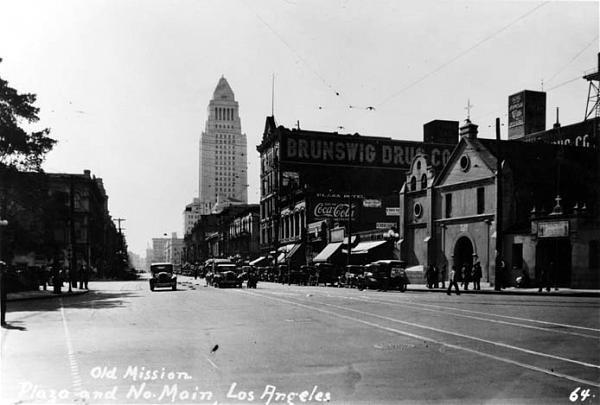 |
|
| (ca. 1928)^* - View looking south on Main Street showing the newly constructed City Hall standing in the background (corner of Temple and Main streets) with the Brunswig Building and Old Plaza Church at right. |
 |
|
| (n.d.)#*^ – View showing the Vickery-Brunswig Building located at 501 N. Main Street, across the street from the Pico House. Photo by Flora Chow |
Historical Notes The County of Los Angeles purchased the Vickrey-Brunswig Building and the adjacent Plaza House in 1948 and renovated them for use by the Los Angeles County Civil Service Commission, County Superior Courts, Police Crime Laboratories and the County Sherriff’s offices through the mid-1970s. * |
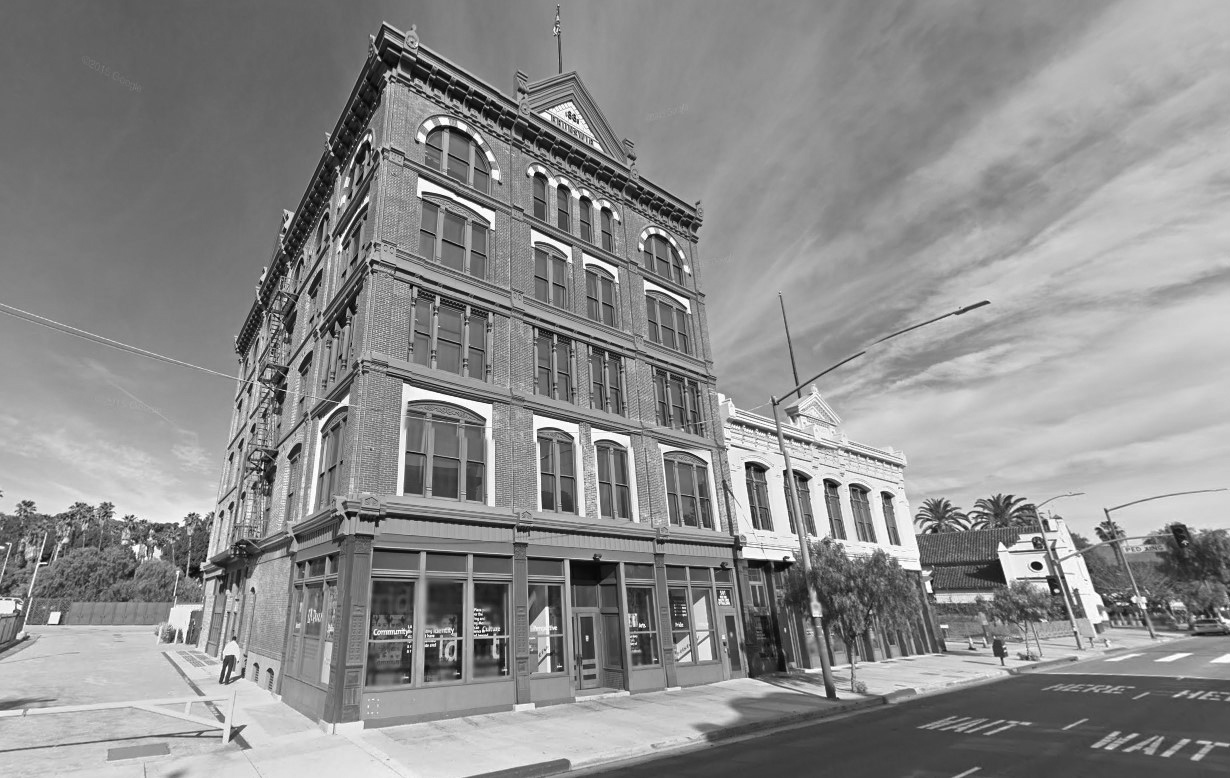 |
|
| (2015)#^**– Google street view looking northwest showing the 5-story Brunswig Building at 501 N. Main Street, adjacent to the Plaza House. The Old Plaza Church is at far right. |
Historical Notes After enduring three decades of vacancy and deterioration, the County rehabilitated both buildings to house LA Plaza de Cultura y Artes, a Mexican and Mexican-American cultural center which opened in 2011.* |
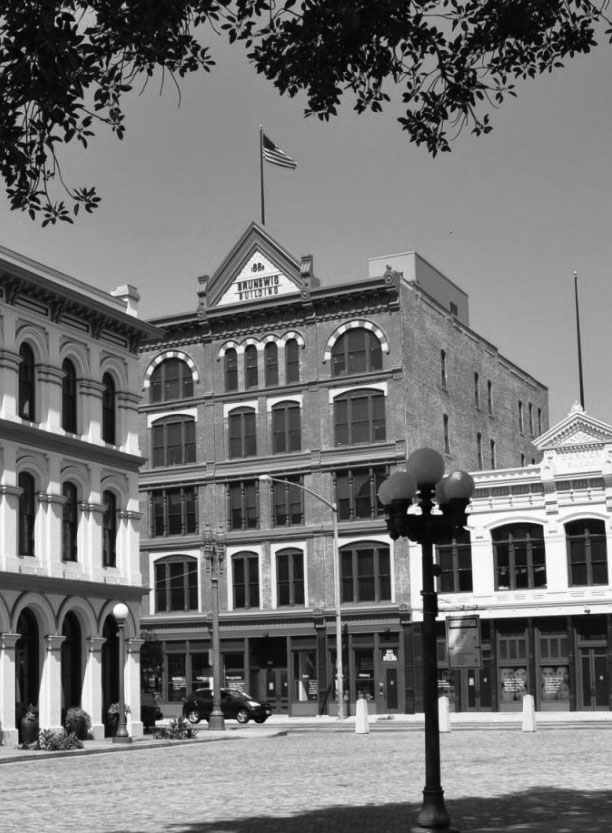 |
|
| (2014)^* - View of the Vickrey-Brunswig Building as seen from the LA Plaza with the Pico House on the left and the Plaza House on the right. |
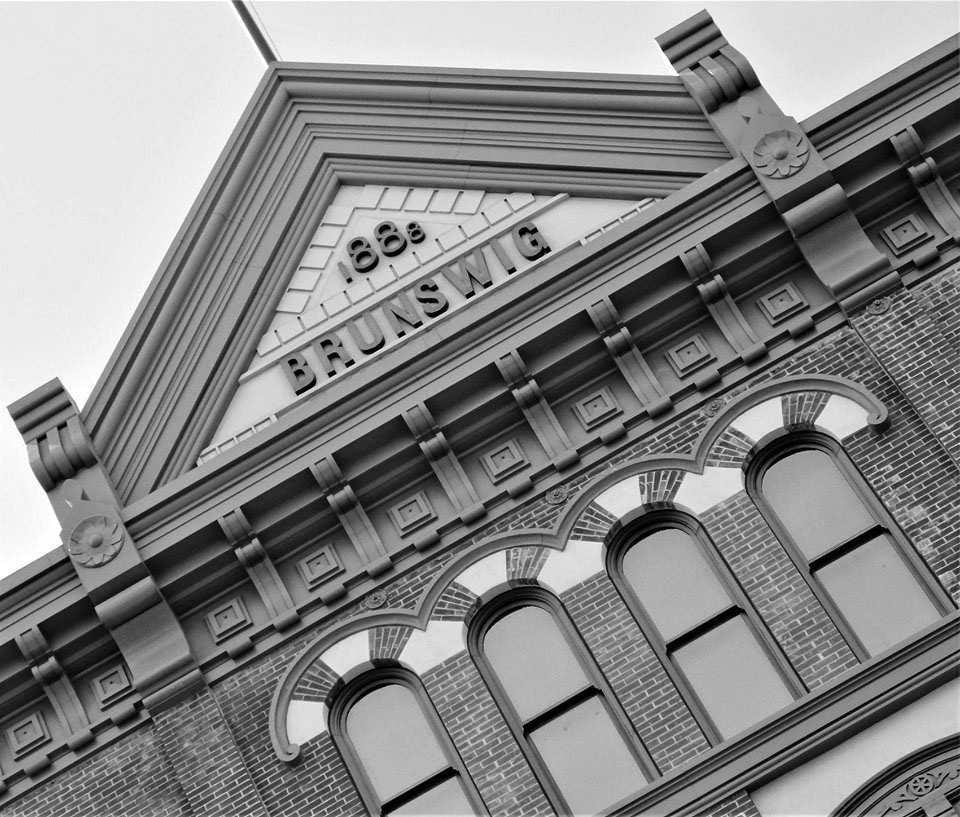 |
|
| (2019)^.^ - Vickrey-Brunswig Building, built in 1888. Photo by Howard Gray |
Click HERE to see more in Early Views of the LA Plaza |
* * * * * |
Phillips Block
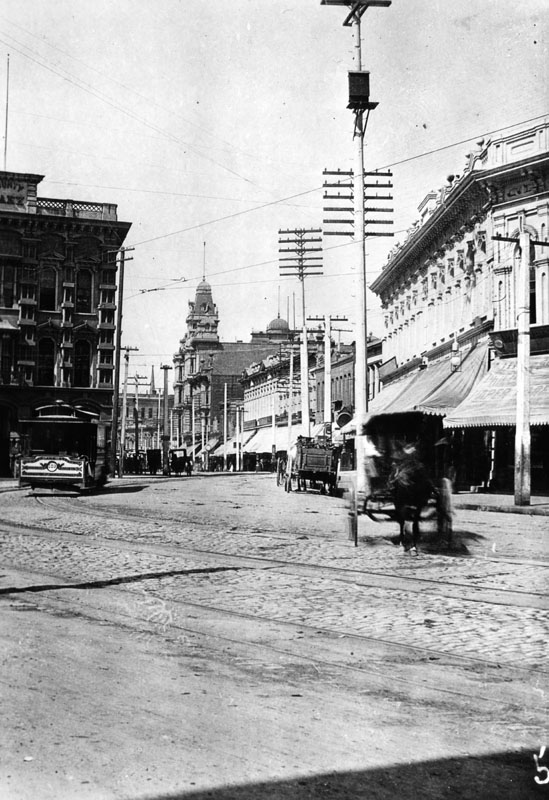 |
|
| (ca. 1887)^ - View looking south on Spring Street with Temple Block seen on the left and Downey Block on the right. The large 4-story building with the copula in the distance is the Phillips Block. The large, ornate four-story building housed one of the City's first department stores called Hamburger & Son's People's Store whch would evolve into May Company. A horse-drawn carriage crosses the tracks as a streetcar appears to be headed toward it. |
Historical Notes The Phillips Building was constructed in 1887 in the French Renaissance style popular at that time for secular buildings. It was the second four-story building erected in Los Angeles and was one of the most ornately decorated. |
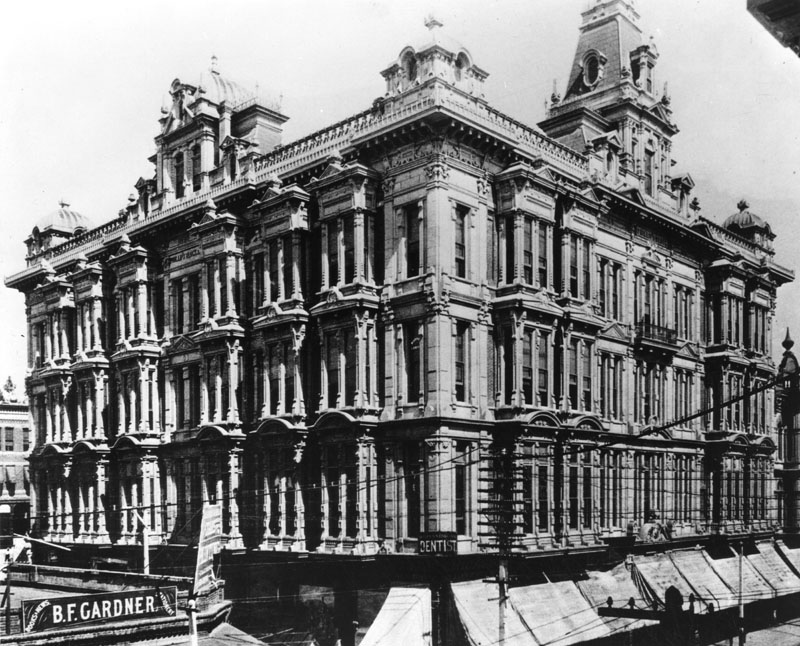 |
|
| (ca. 1890)* - View showing the Phillips Block, located at 25-37 N. Spring Street. The Hamburger's Peoples Store was in this building. |
Historical Notes The building was constructed in 1887 by Louis Phillips at a cost of about $200,000. Louis Phillips was born Louis Galefsky to a Jewish family in Prussia (now Kempen, Poland) and moved to California in the early 1850s, changing his name to Phillips. He moved to Spadra (now part of Pomona) in 1862 and began engaging in sheep herding and cattle raising. In 1864, Schlesinger and Tischler acquired the Rancho San Jose in a foreclosure. Phillips, who had previously been a manager on the ranch, bought 12,000 acres out of the foreclosure. In January 1874, the Southern Pacific Railroad completed a rail line from Los Angeles to Spadra, spurring interest in land development in the area. In 1875, Phillips built the Phillips Mansion (now operated by the Historical Society of Pomona Valley) and also sold most of his 12,000 acres for subdivision into the Pomona Tract, thus beginning the formation of Pomona. Phillips retained 2,241 acres surrounding his mansion, which he operated as a cattle and sheep ranch. Phillips acquired large land holdings in other parts of the county, including the Los Angeles business district where he owned the Phillips Block on Spring Street, a block on Los Angeles Street and another on Third Street. By 1892, the Los Angeles Times reported that Phillips, "who lives so quietly out at Spadra, near Pomona," was "the richest man in Los Angeles County." The Times noted that Phillips was worth "not a dollar less than $3,000,000" and stated that, in addition to his land holdings in Los Angeles, he had a ranch that produced wool, honey and wheat.*^ |
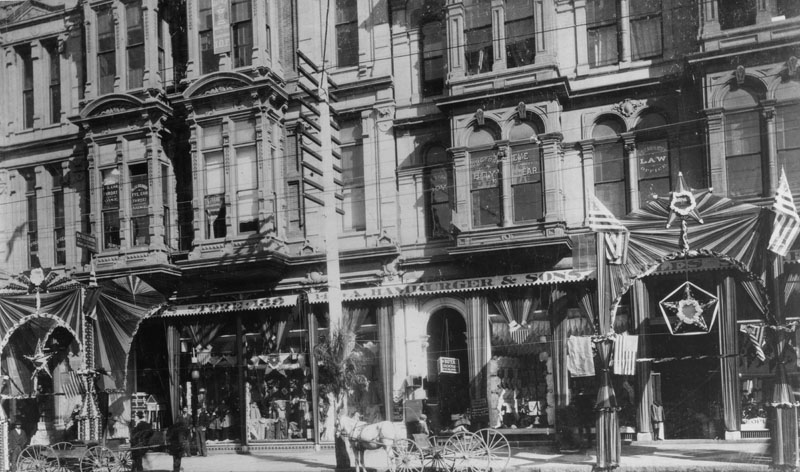 |
|
| (ca. 1890)* - The entrances to Hamburger's People's Store in the Phillips Block on Spring Street is decorated in patriotic themes. Horse and buggies wait by the curb. A sign for "Royal Rooms" hangs over an arched entrance. Mr. Carpenter's law office, Dr. Hoy's (Eye and Ear), and Dr. Solomon's (Eye, Ear and Throat) offices are on the second floor. |
Historical Notes A. Hamburger and Sons was one of the first department stores to operate in Los Angeles. Originally known as A. Hamburger & Son's People's Store, the name later changed to Hamburger's Store. In 1908 the company relocated their store from Spring Street to a newer building located at Broadway and Eighth Street. May Department Stores acquired Hamburger's in 1923 and renamed it the May Company. Much later in the century, the May Company and Robinsons chains of department stores would affiliate under the name Robinsons-May; and this entity would be bought out by Macy's in 2005.*^# |
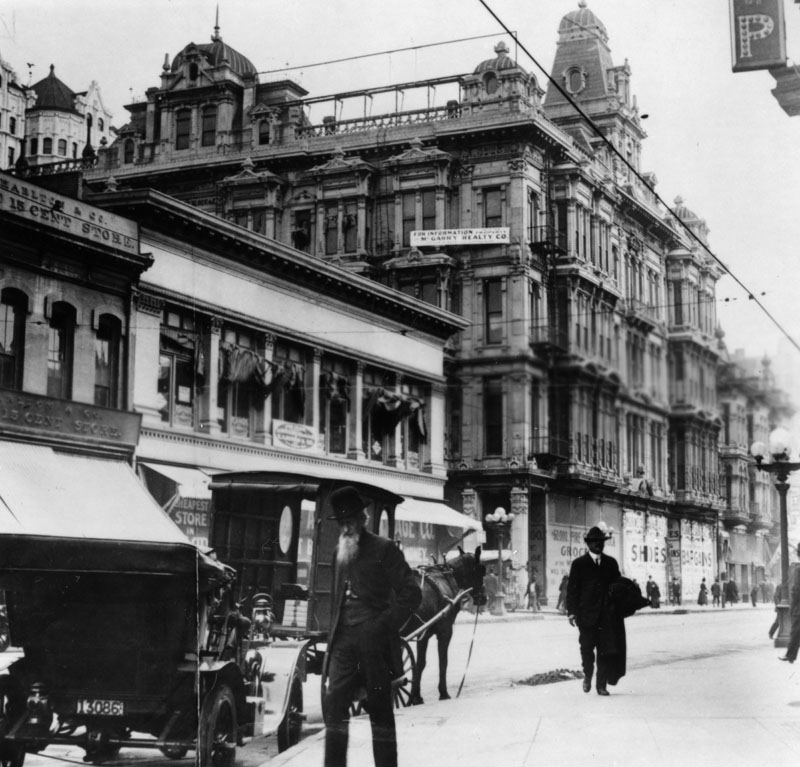 |
|
| (ca. 1900)* - A horse and buggy are parked in front of a vintage automobile on North Spring St. at Franklin. In the background stands the four-story Phillips Block building with a banner on the top floor for M. Garry Realty Co. advertising its availability. This is presumably after the Hamburger's Store moved to it's new location (SW corner of Broadway and 8th streets). |
* * * * * |
Simpson Methodist Episcopal Church
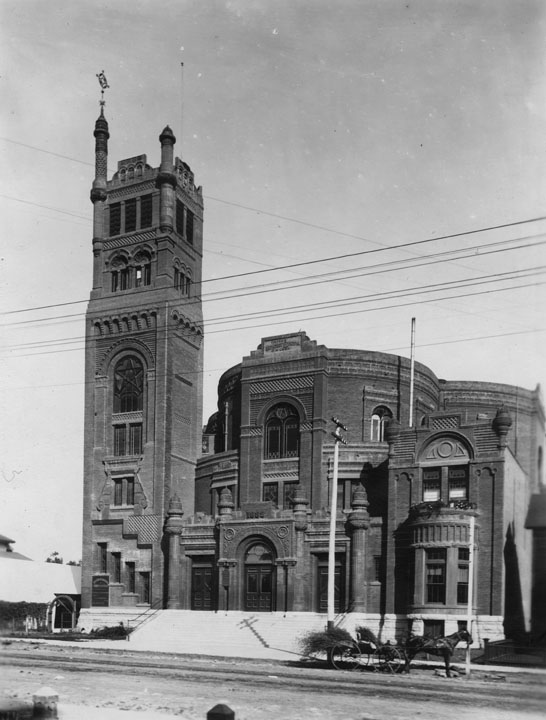 |
|
| (ca. 1890)* - Exterior view of Simpson Methodist Episcopal Church, located at 734 S. Hope Street, as seen from across the unpaved street. A horse-drawn carriage is parked outside the church at the curb. |
Historical Notes The Simpson Methodist Episcopal Church was constructed in the late 1880s. After serving as a Methodist church for years, it later became the Third Church of Christ, Scientist.* |
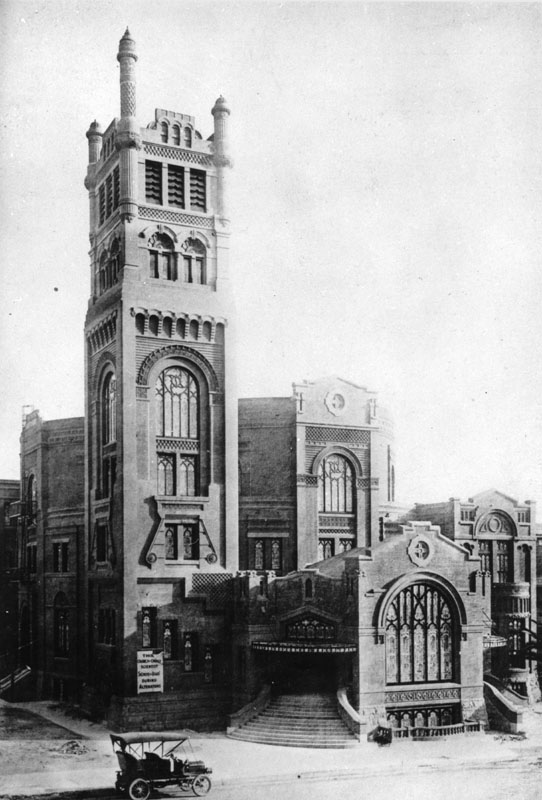 |
|
| (ca. 1911)* - Exterior view of Third Church of Christ, Scientist, located at 734 S. Hope Street, during an extensive remodeling project in 1911. |
Historical Notes After serving as Simpson Methodist Episcopal Church and Simpson Auditorium for years, it became the Third Church of Christ, Scientist in the early 1910s. A Christian Science Reading Room remains on the site, but the large church building was demolished after it suffered severe damage as a result of the 1971 San Fernando earthquake.* |
* * * * * |
Burbank Villa Hotel (later Santa Rosa Hotel)
 |
|
| (1887)* - View of the Burbank Villa Hotel on Olive Avenue. It was built by Dr. David Burbank and his son-in-law John W. Griffin. In the distance can be seen Burbank Block. |
Historical Notes At the time the American Civil War broke out Dr. David Burbank established his profession as a dentist in Pueblo de Los Angeles. In 1867, he purchased Rancho La Providencia from David W. Alexander and Francis Mellus, and he purchased the western portion of the Rancho San Rafael (4,603 acres) from Jonathan R. Scott. Dr. Burbank's property reached nearly 9,200 acres at a cost of $9,000. He eventually became known as one of the largest and most successful sheep raisers in southern California, resulting in him stopping his practice of dentistry and investing heavily in real estate in Los Angeles.^ |
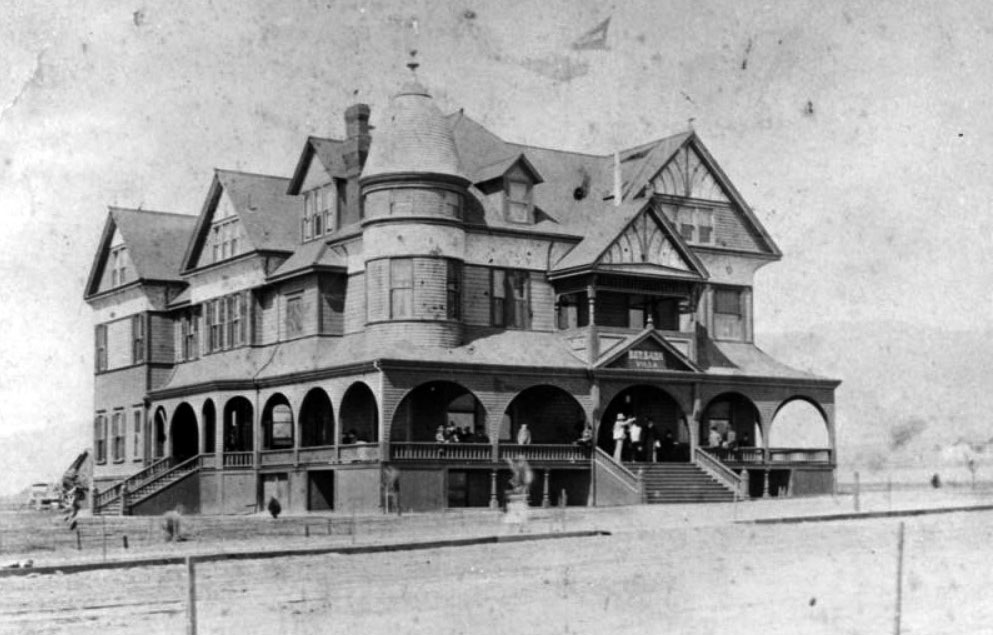 |
|
| (1887)^ – View looking across an unpaved Olive Avenue showing the Burbank Villa Hotel with several people standing on the porch and stairway. |
Historical Notes The Burbank Villa Hotel (with turret, gables, and verandas with arches) was built by Dr. Burbank and his son-in-law John W. Griffin in 1887 at a cost of $30,000.00. Later the hotel was renamed the Santa Rosa Hotel and was a popular place for weddings and parties. During the 1920s the hotel was remodeled into apartments and by 1927 it had been torn down and replaced by the post office. Today, this post office is known as the Burbank Downtown Station and is located at 135 E. Olive Ave, Burbank. |
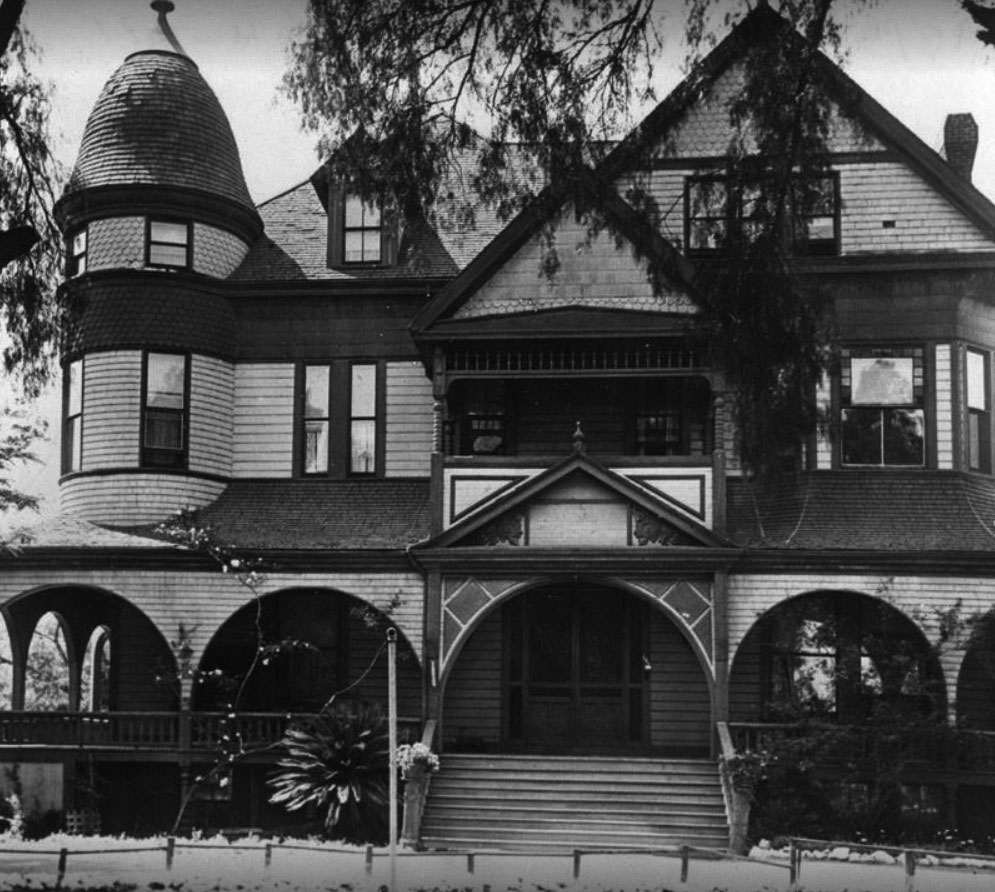 |
|
| (1924)* – Close-up view of the Victorian-style Burbank Villa Hotel about the time its name change to Santa Rosa Hotel. |
Historical Notes In 1924, the Burbank Villa Hotel was renamed Santa Rosa Hotel. |
 |
|
| (1920s)^^ – View showing the Santa Rosa Hotel (originally Burbank Villa Hotel) located at 135 E. Olive Avenue. |
Historical Notes During the 1920s the hotel was remodeled into apartments and by 1927 it had been torn down and replaced by the post office. Today, this post office is known as the Burbank Downtown Station and is located at 135 E. Olive Ave, Burbank.^ |
 |
|
| (1970s)^^ - Photo of the Downtown Burbank Post Office at 135 E. Olive Avenue taken from across the street. A convertible sports car drives past while a man mails an item at one of the two curbside collection boxes. The building inscription reads, "United States Post Office, Downtown Station, Burbank California 91503." |
Historical Notes The post office was built in 1938 on the former site of the Santa Rosa Hotel and, before that, the Burbank Villa. Constructed during the Depression, under the federal Works Progress Administration program, out-of-work skilled laborers were employed by Los Angeles architect, Gilbert Stanley Underwood, who also designed the Los Angeles Federal Court House. The Mediterranean style exterior features five large arches and a red tile roof. The inside lobby displays two 25-foot murals, by artist Barse Miller, celebrating Burbank's aviation and motion pictures industries. The post office served as the main branch and administrative offices until 1968 when increased mail volume required a larger facility. A new post office then opened on Hollywood Way while the Olive Avenue location continued to serve as the Downtown branch. In 1985, the building was listed in the National Register of Historic Places and, on November 11, 2003, the Downtown Burbank Post Office was named in honor of legendary entertainer, Bob Hope, who launched his career nearby with a weekly radio show at Burbank's NBC Studios.^ |
Phillips House
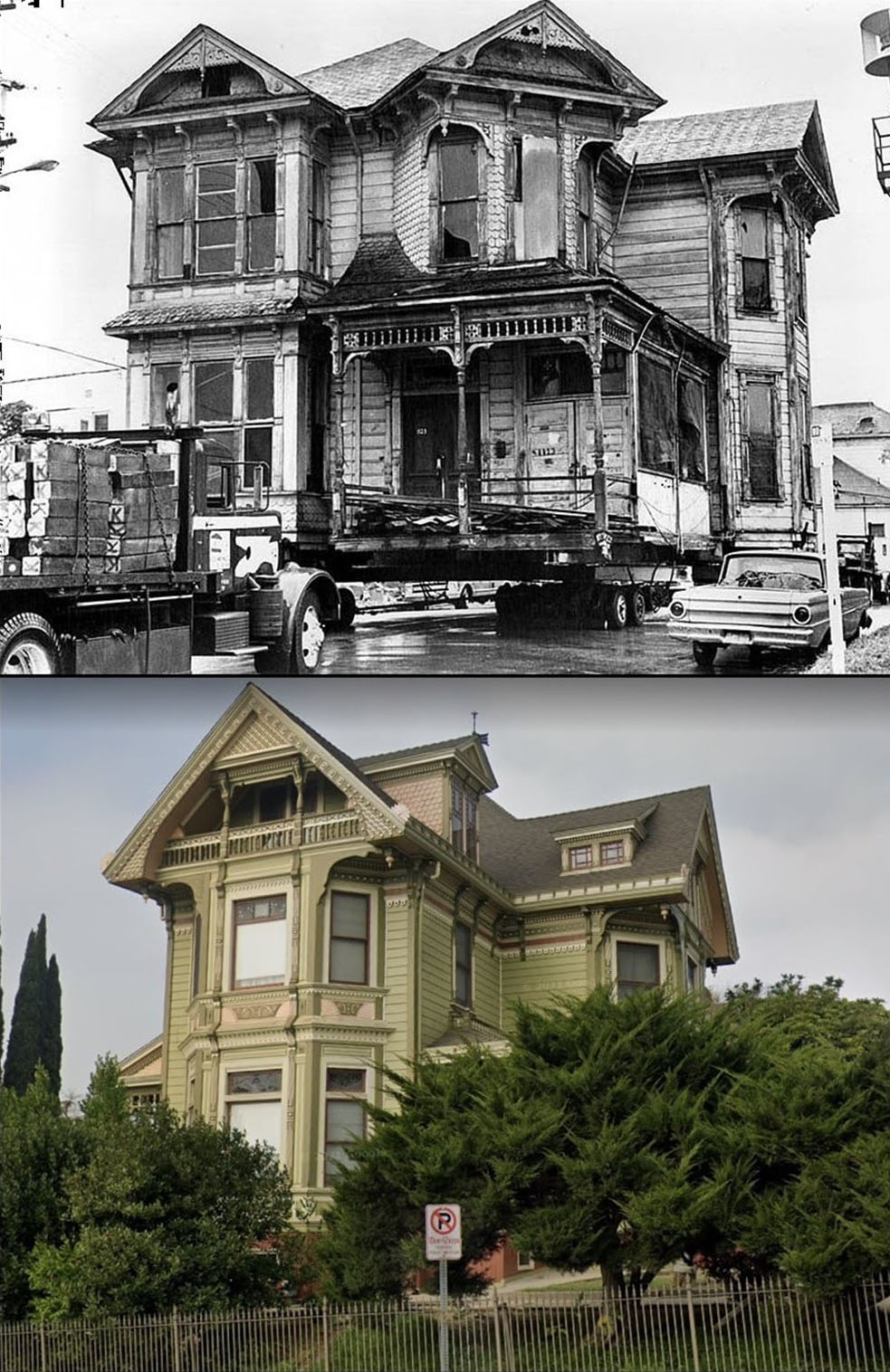 |
|
| (1970s vs Today)* - Phillips House then and now. The home was relocated from Court Street to Carroll Avenue. |
Historical Notes Built in 1887, the imposing Phillips House was likely a project of local real estate developers George O. Ford and James B. Myer, men also associated with the homes at 1316, 1320, and 1324 Carroll Avenue. Ford was an agent for the Richfield Land and Water Company, and Myer owned the Southern Pacific Transfer Truck Company.* |
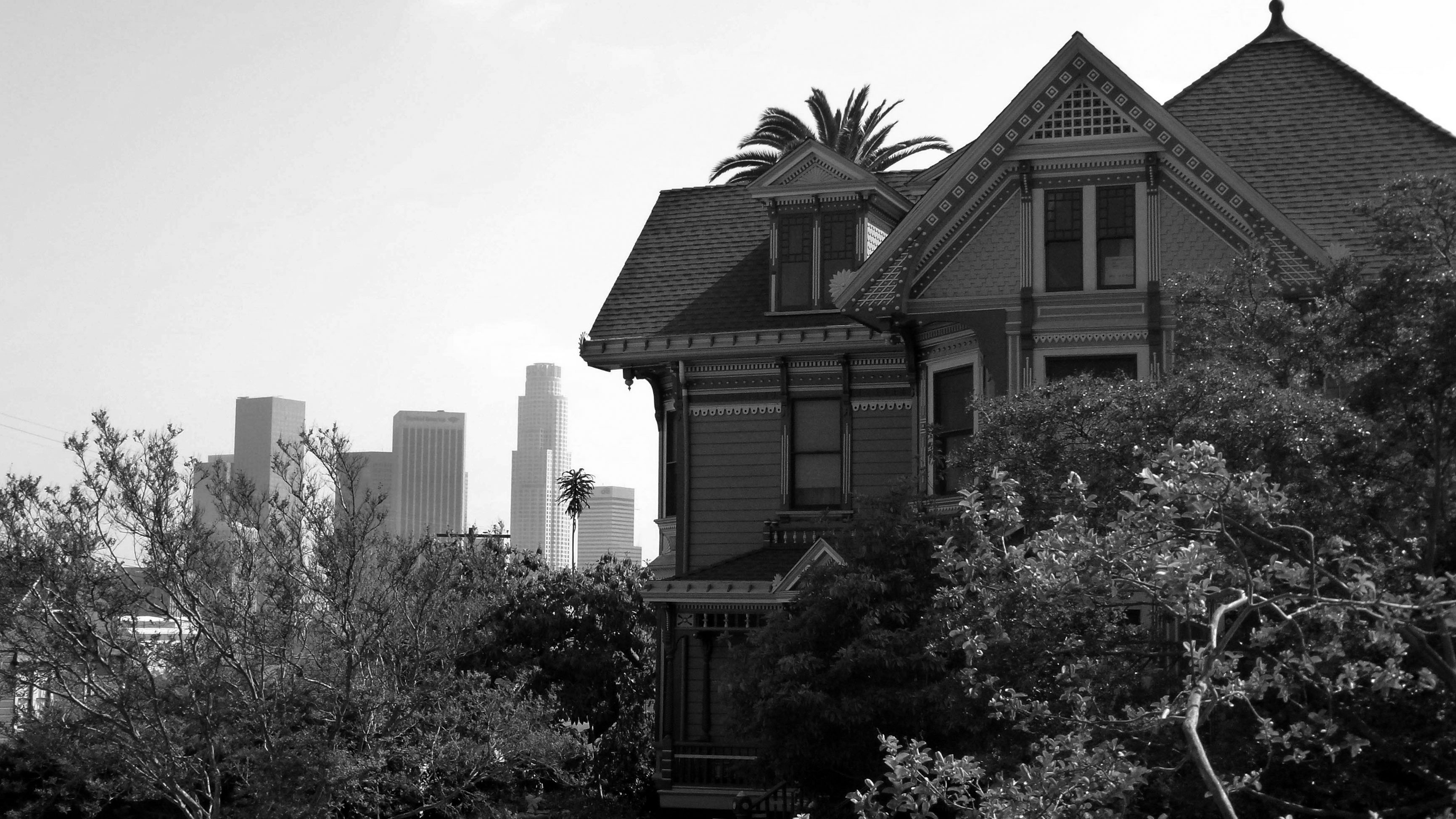 |
|
| (2012)^ – The Phillips House located at 1300 Carroll Avenue in Angelino Heights with the downtown skyline in the background. |
Historical Notes The first owner of the house was Aaron Phillips, who was from Iowa and had a wife, Maria, and daughter Grace. Grace lived in the house until 1942, when her heirs sold the property to the current owner’s family. The home was relocated from Court St to Carroll Avenue in the 1970s.* |
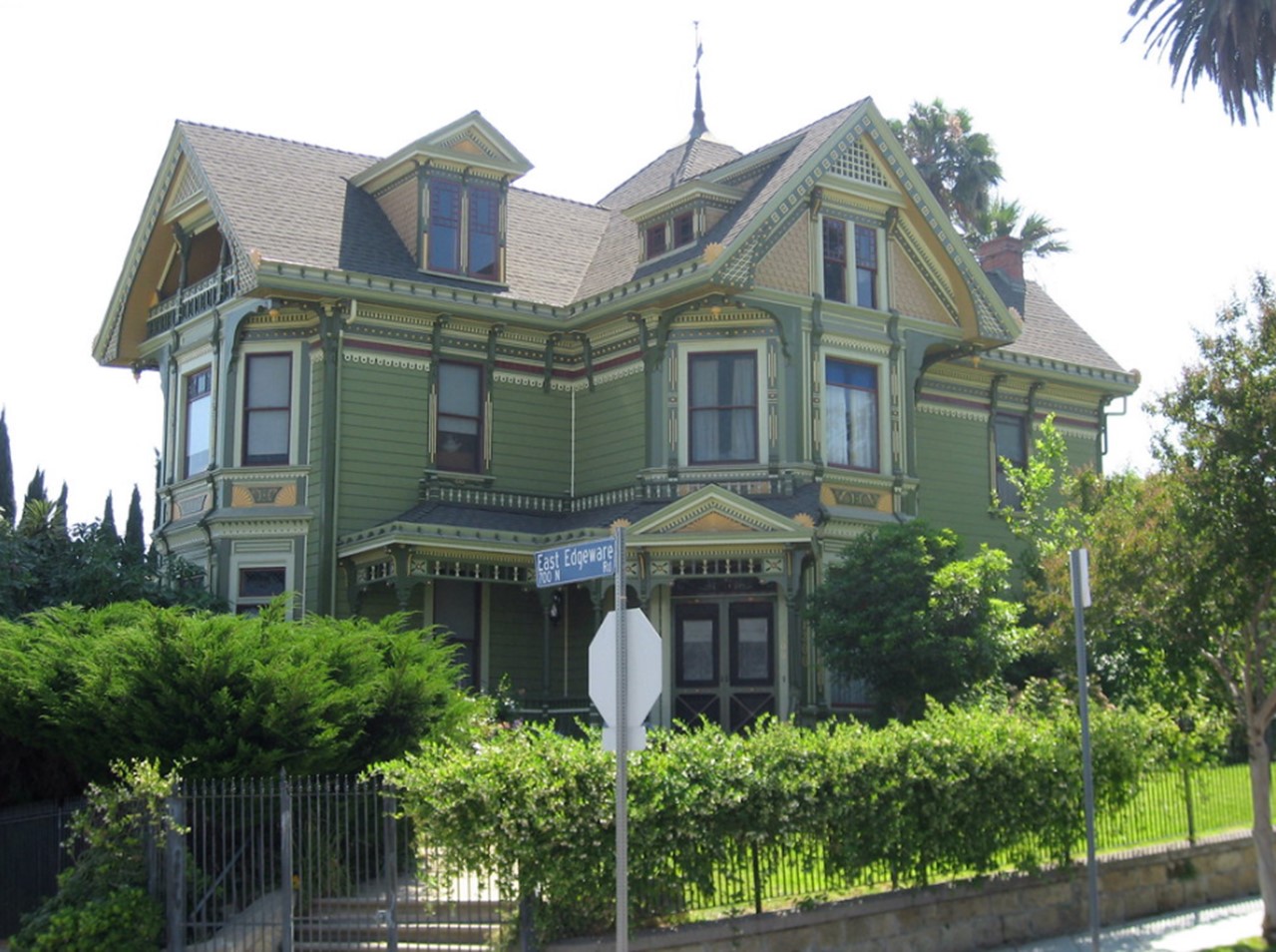 |
|
| (2007)* – The Phillips House located on the SW corner of Carroll Ave and East Edgeware Rd. |
Historical Notes One of the most ornate homes in Angelino Heights, the Phillips House blends two Victorian styles. The sharp angles, in both the shape of the house and its geometric decoration, typify the Eastlake style, while the overall decorative exuberance reflects the Queen Anne style.* This Victorian home was the first house on Carroll Avenue declared a Los Angeles landmark (No. 51). |
* * * * * |
Please Support Our CauseWater and Power Associates, Inc. is a non-profit, public service organization dedicated to preserving historical records and photos. We are of the belief that this information should be made available to everyone—for free, without restriction, without limitation and without advertisements. Your generosity allows us to continue to disseminate knowledge of the rich and diverse multicultural history of the greater Los Angeles area; to serve as a resource of historical information; and to assist in the preservation of the city's historic records.
|
For more Historical Los Angeles Views click one of the following:
For Other Historical Views click one of the following:
See Our Newest Sections:
To see how Water and Electricity shaped the history of Los Angeles click one of the following:
Water:
Power:
References and Credits
**DWP - LA Public Library Image Archive
* LA Public Library Image Archive
*# Mojave Desert.net: Remi Nadeau
#* Ancestory.com - Margarita Bandini Winston
#+Maviealosangeles.com Avila Adobe
+^Old Los Angeles and Environs blogspot
^# KCET - The Lost Hills of Downtown Los Angeles; A Vision for the Next Los Angeles: Transportation Equity and Just Growth
#^^theeastsiderla.com: Boyle Hotel
#*^LA Conservancy: Boyle Hotel; Vickrey-Brunswig Building
**^LA Fire Department Historical Archive
^^#The Museum of the San Fernando Valley
*^#CSULB - A Visit to Old LA: Hamburger Dept. Store; Figueroa Street
**#Tumblr.com - LA History: LA Times
*##Historic Los Angeles Theatres: Grand Opera House
^##California State Library Image Archive
^#*The Department Store Museum: J. W. Robinson's
#^*Early Downtown LA - Hollenbeck Hotel
***Los Angeles Historic - Cultural Monuments Listing
*^*California Historical Landmarks Listing (Los Angeles)
*^^*Los Angeles Past: City Hall (ca. 1895)
***^Historical Buildings - boyleheightsbeat.com
**^^Boyle Heights History Blog: Occidental College
**#^LAPL-El Pueblo de Los Angeles Historical Monument Photo Archive
^*^^San Fernando Valley Historical Society/Facebook.com: Burbank Villa Hotel; Hotel Cecil
^^^^US Department of the Interior: Vickrey-Brunswig Building
^*#*Panoramonview.org: Paorama of the Siege of Paris
^*##blogdowntown: Third Street Tunnel
*##*Pacific Coast Architecture Database (PCAD): Bryson-Bonebrake Block
*##^Pinterest.com: California Places of the Past
*#*#Flickr.com: Michael Ryerson
^#*^LA Times: Amestory Building; Newmark Fountain; Demolition of Old Times Bldg; Don Antonio Maria Lugo; Los Angeles Chinatown then and now
**## Mojave Desert.net: Remi Nadeau
#*^^Flickr.com: Views of Los Angeles
#^**Google Maps
#^#*Cinema Treasures: Childs' Opera House and Grand Theatre
#^#^St. Vincent's Medical Center: History
^*#Noirish Los Angeles - forum.skyscraperpage.com; Arcade Palm Tree; Angels Flight; Hotel Cecil; Wilson Block; LA City Hall; LA Times Building Bombing; Times Bldg Lit Up; North Los Angeles Street
^ On Bunker Hill: Crocker Mansion; Hershey Residence; Larronde Block and Residence; Brunson Mansion
^* Wikipedia: Abel Stearns; Pío Pico; Workman-Temple Family; Jonathan Temple; Los Angeles Herald-Examiner; Charles Maclay; Los Angeles High School; Cathedral of Saint Vibiana; John Edward Hollenbeck; Foy House; Isaias W. Hellman; Isaac Newton Van Nuys; Wells Fargo; Los Angeles Plaza Historic District; Harrison Gray Otis; Harris Newmark; Hazard's Paviolion; Fort Moore; Compton; Boyle Heights; Arcade Station; Avila Adobe; Los Angeles City Hall; Burbank; Angelino Heights; Boyle Hotel - Cummings Block; YMCA; Loyola Marymount University; Wikimapia: Vickrey-Brunswig Building
< Back
Menu
- Home
- Mission
- Museum
- Major Efforts
- Recent Newsletters
- Historical Op Ed Pieces
- Board Officers and Directors
- Mulholland/McCarthy Service Awards
- Positions on Owens Valley and the City of Los Angeles Issues
- Legislative Positions on
Water Issues
- Legislative Positions on
Energy Issues
- Membership
- Contact Us
- Search Index